

Gaumukh Trek from Gangotri – A Complete Travel Guide
In this post, I will provide a detailed description of Gaumukh Trek which is one of the biggest tourist attractions of Gangotri. In fact, it is this 18 kilometers long trail to Gaumukh that attracts 90% of the tourists here. There are majorly two kinds of people that visit Gangotri; either the devotees or the adventure enthusiasts. For both of them, walking to Gaumukh and tracing River Ganges back to its origin is one of the biggest parts of a trip to Gangotri.
Also Read: How to Plan a Trip to Gangotri – A Complete Travel Guide
For a brief introduction, Gaumukh, also known as “Gomukh” or “Gomukhi” is the source of the Bhagirathi River. It is the point where Bhagirathi originates out of the Gangotri glacier (picture below) and then flows downhill to be later called River Ganga. It is situated about 18 kilometers from Gangotri and at an altitude of 13,200 ft (4,023 meters).
The motorable road ends at Gangotri and the final distance to Gaumukh can only be covered by foot. Due to its religious importance, it is a popular Hindu pilgrimage site; and due to the trek being neither too difficult nor too easy, it is also a much sought-after trekking destination. The word “Gomukh/Gaumukh” literally means “Mouth of a Cow.”
It is said that the snout of the Gangotri glacier where Bhagirathi comes out from looked exactly like the “Mouth of a Cow” in old times and hence the name.
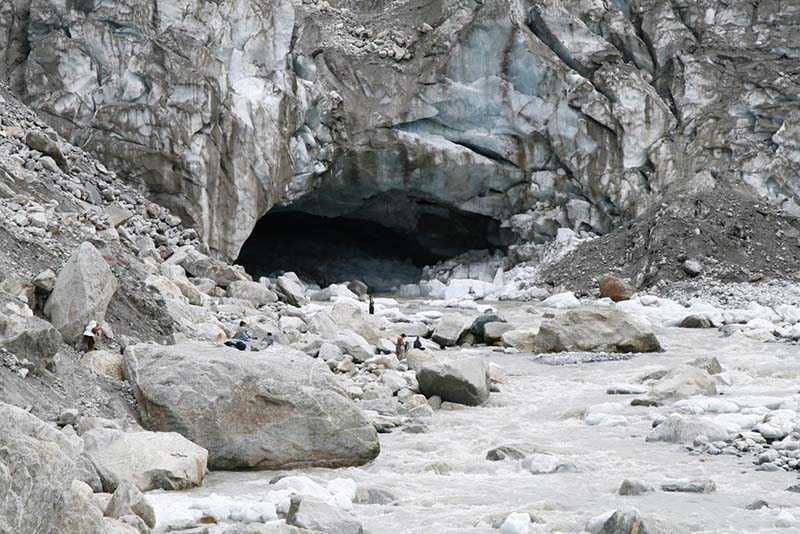
Quick Navigation
Gaumukh Trek
Please note that this article only covers the part about trekking to Gaumukh after you have arrived in Gangotri. The information below will tell you how you can plan your trek, what permits are needed and, some of the things you should keep in mind. If you, however, would also like to know the details on how to reach Gangotri then please read the previous part of this post, Gangotri Travel Guide .
Best time to visit Gaumukh
The best time to trek Gaumukh would be from Mid April to June and then again from September to early November. Gangotri remains closed from late November to March so a visit in these months is not possible at all.
The risk of rain would make the trek and journey tough to execute in July and August. This is also the time when it gets a little crowded in Gangotri with the ongoing Kanwar Yatra. Hence it only leaves the months of spring (April), summer (May and June), and autumn (October) to trek to Gaumukh.
Gaumukh Trek Permit
A permit is required for a person to be able to trek to Gaumukh. This permit can be obtained from either District Forest Officer in Uttarkashi or at the forest office in Gangotri. There is a daily limit of 150 permits per day and it is issued on a first-come-first-served basis.
Also Read: When is the Best time to visit Gangotri
How to get Gaumukh Trek Permit
The first place to get the permit would be at the DM office Uttarkashi. You will anyways cross Uttarkashi while going towards Gangotri so you can actually get the permit while on the way. The DFO office is located at the northern end of the road just ahead of the bus stand. It is a government office open on all working days during normal working hours.
Getting a permit from here is quite simple really. You just fill out your name and address on a form; attached your government-issued Identity proofs like Aadhar Card, PAN Card, or Voter’s ID; and pay a fee of Rs. 150 per person.
If you did not get the permit at Uttarkashi for some reason, you can obtain it in Gangotri as well. It is issued at the forest office which is located just as you enter Gangotri to your left. Charges and procedures will remain the same but the problem is that this office is only open from 8.00 am to 10.00 am, and then 5 pm to 7 pm.
On the brighter side, this office remains open on all days including Sundays as well which the office in Uttarkashi is not.
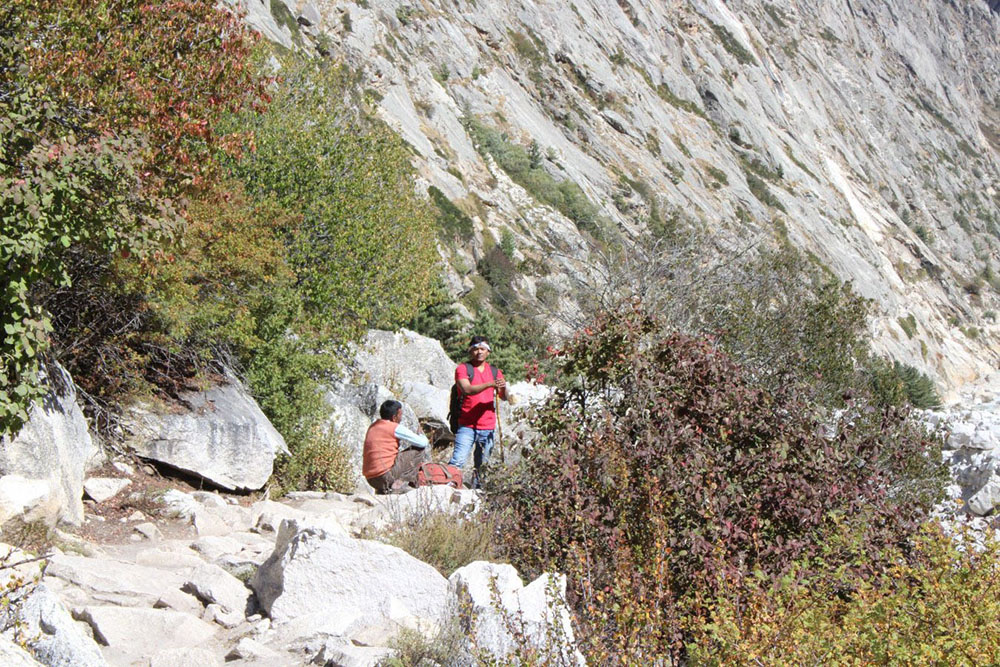
Gaumukh Trek Permit Cost
The cost of the permit is Rs. 150 per person for Indian citizens and Rs. 600 per person for foreign nationals.
Gaumukh Permit Duration
The permit for Gaumukh is valid only for 2 days. So, for example, if you started from Gangotri on Monday, you must return by Tuesday evening. The duration is extended if you plan to trek to Tapovan as well.
Gaumukh Trek Permit Online
Thankfully, permits for the Gaumukh trek can be obtained online. You will need to visit the official page for the Online application for Gangotri National Park permission and fill in your details. You will also be asked to upload required Identity proofs on this page. After you submit the application, you will receive an email confirming that your permit was approved, provided that you are able to produce original documents at the office.
Take a printout of this email and show it at either the DFO office in Uttarkashi or at the forest office in Gangotri along with your original documents to collect your permit. Payment for the permits can either be made while you were submitting the online application, or you can pay in cash when you show the permit later at either in Uttarkashi or Gangotri.
The DFO office in Uttarkashi remains closed on Saturday and Sunday so please plan your journey accordingly. On the online application form, it will ask you to select a Tour Operator towards the bottom of the page but that is not a mandatory field. If you are visiting between May to November, then you can leave this field blank.
If you were, however, visiting in April before the temple doors were open, then you would have to select a local tour operator on this page.
Also Read: What to See in Gangotri and Things to Do
Gaumukh Trek Details
Now that you have obtained the permit, let me provide a brief summary of how your trek is going to look like. There are four major points on the route; Gangotri, Chirbasa, Bhojbasa, and Gaumukh. The route will look something like this.
Gangotri – (9 kms) – Chirbasa – (5 kms) – Bhojbasa – (4 kms) – Gaumukh = 18 Kms
The difficulty level of the trek can be called moderate but it does get a bit challenging and steep at some points. The stretch between Gangotri to Chirbasa is a little easy but the challenging nature of the trek starts to come more into the picture as you proceed further.
Gangotri really is a small town and finding the starting point of the Gaumukh trek won’t be a difficult task. Ask any of the locals and anyone can point you in the right direction. But as a reference, the trek begins from around 100 meters behind the Gangotri temple. One has to climb a steep stairway in order to reach the starting point of the trek.
The first couple of kilometers is really an easy walk and you will arrive at the check post. Entry to trekkers and visitors is only allowed after 6 AM so my advice would be to start as early as possible from Gangotri. If you started by 5 in the morning, you will be at the check post by 6 and can be on your way to Gaumukh as soon as the entry opens.
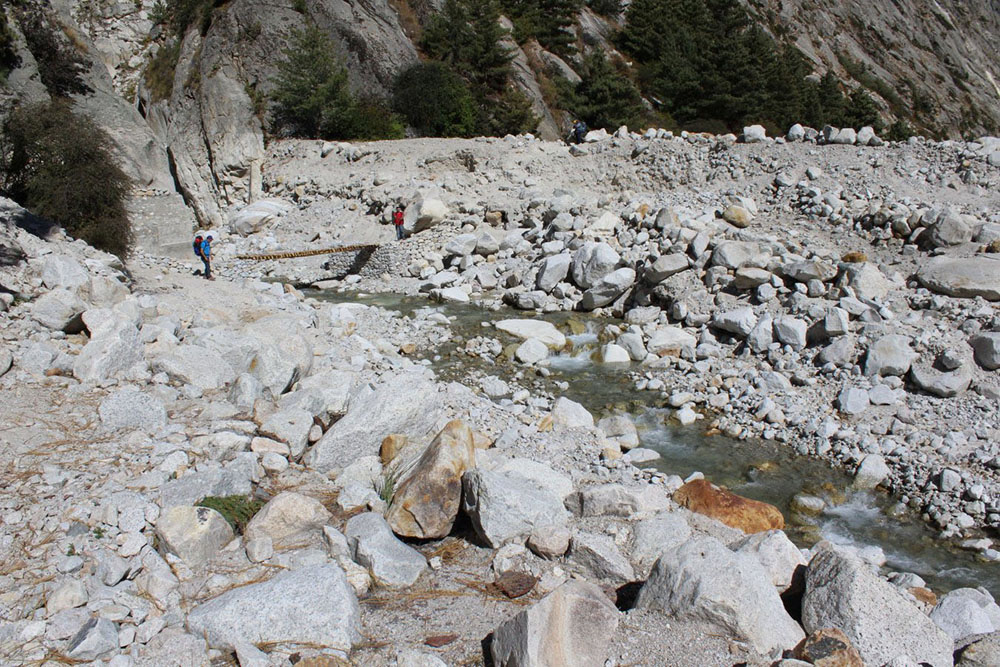
Plastic Covers Fee
At the check post before the start of the trek, you will be asked to show your permits as well as all the plastic bags that you were carrying. All your chips packets, chocolate covers, Biscuit packets, polythene bags will be counted and you will be asked to deposit a certain amount.
When you return, this fee will be refunded only if the count of plastic covers that you are carrying matched the one from the morning; meaning that you brought all the plastic covers back and did not leave anything behind. If the count did not match, this amount will be forfeited.
Also Read: Uttarakhand Roadways Bus Time Table
Gangotri to Chirbasa
You will be required to produce your permits at the checkpoint, as well as the original Identity proofs. You will make the payment if you did not already do so while procuring the permits online or at Uttarkashi. Your bags will then be checked for how many plastic items you were carrying and all of them will be counted. You will then make a deposit against your plastic items and will then be allowed to enter.
The entire trail is to Gaumukh is well marked and you will have no trouble navigating your way. It will continue to gradually increase its gradient but will not be too challenging to handle.
The name Chirbasa literally means “the abode of Pine trees” and it is named such because there are a lot of pine trees around here. In fact, you will be able to recognize the place by the huge cluster of pine trees. It is located at a distance of 9 kilometers from Gangotri and for this entire length; you will pretty much be on your own.
There will not be any Dhabas, shops, tea stalls, or anything of that sort in between. Hence it is extremely important that you bring something to munch on along the trek. Also, ensure that you are carrying a water bottle that you can fill in from any of the water streams en route.
Trekking from Gangotri to Chirbasa will take you about 4 to 5 hours. If you were at the check post by 6 and started as soon as the entry was allowed, you should be able to reach Chirbasa before 10 AM. There is a small Dhaba here where you can take a short break and restock your energy levels.
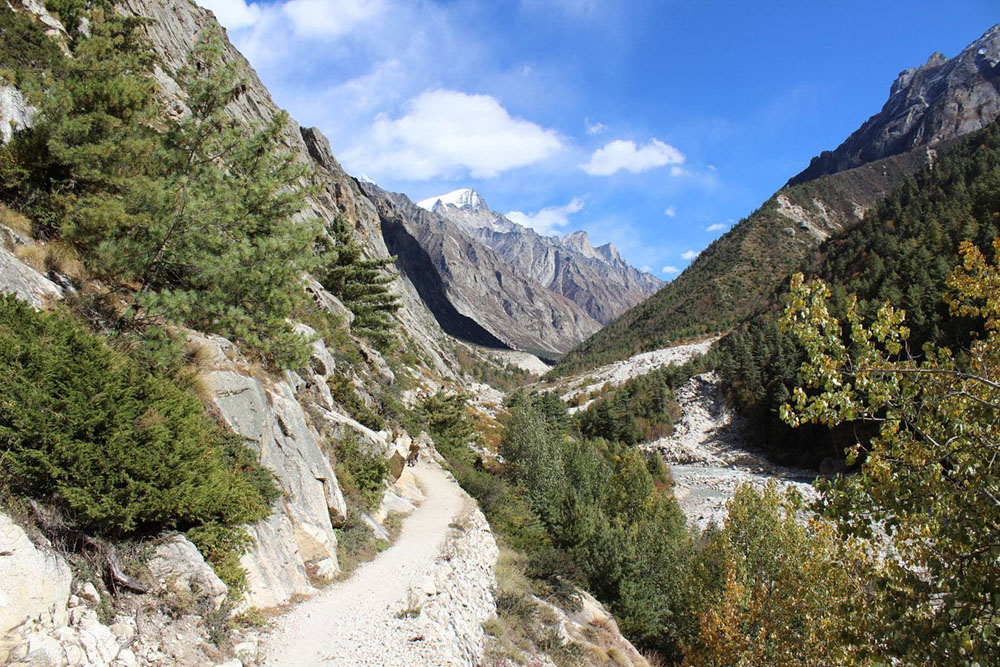
Chirbasa to Bhojbasa
Chirbasa is known to be the last place where you will see some vegetation on the trek. After this point, trees mostly just vanish and the landscape seems to look like a barren wasteland. The next stop on the trail will be Bhojbasa and until then, you will again be on your own. There will not be any dhabas or tea stalls anymore so do not forget to fill your water bottle and get something to eat on the way if you weren’t carrying anything.
Bhojbasa is located at a distance of about 5 kilometers from Chirbasa and it will easily take you 2 to 3 hours to complete. The ascent in the trail will be quite the same as between Gangotri and Chirbasa and it will be an easy to moderate walk. The vegetation too will continue to get lesser with each passing kilometer as you get closer to Gangotri Glacier.
Also Read: How to Plan a Trek to Tungnath and Chandrashila
Located at an altitude of 3800meters (12,450 feet), Bhojbasa serves as a stopover for people trekking to Gangotri or even further to Tapovan. It is really not much except for a huge ground-like area in the middle of nowhere and a couple of buildings in it.
By now, you would already have walked 14 kilometers since you started from Gangotri in the morning. Accommodation at Bhojbasa is available in form of Ashrams and a GMVN guest house , and both are very basic dormitory type accommodation.
Below is a picture of Bhojbasa.
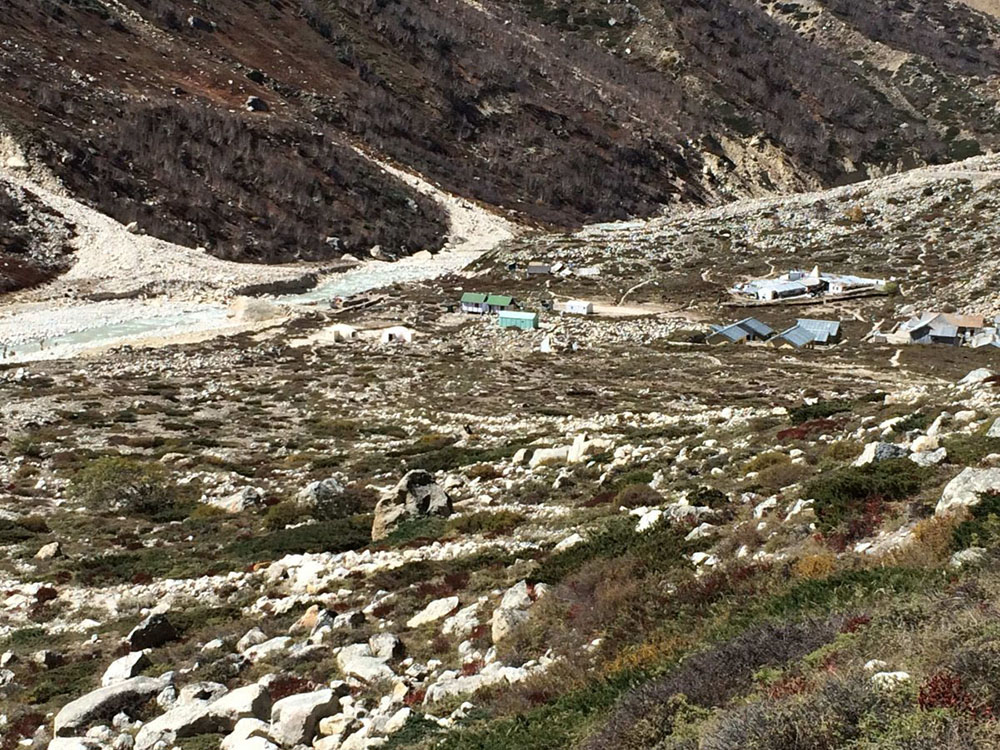
After you reach Bhojbasa, you have two options. You can either break the journey for the day and trek to Gaumukh the next morning. Or you can continue all the way to Gaumukh, come back and stay at Bhojbasa for the night and return to Gangotri the next day. Since the duration of the Gaumukh permit is only two days, you will have to return to Gangotri the next day anyway.
My recommendation is that you do not go to Gaumukh on the very first day and do it the next morning. The reason behind this is that Gaumukh is another 4 kilometers from Bhojbasa and this is where the trek becomes challenging as well. If you continue to Gaumukh, you will be in a hurry to reach and come back to Bhojbasa before dark. This will also not give you any time to spend at the glacier. Hence it would be better to stay at Bhojbasa for the night and start trekking to the glacier the next morning.
If you were carrying your own camping gear, then Bhojbasa is the place where you will pitch your tent for the night. Camping is not allowed by law anywhere after Bhojbasa.
Bhojbasa to Gaumukh
The trek will get a bit challenging after Bhojbasa. It will be steep and there will be boulders as well on the way that you will have to jump over. The trail starts from behind the GMVN rest house but you can ask anyone here if you weren’t able to spot it.
The path however will still remain well marked; and easy to spot and navigate. Make sure that you are filling your water bottle in the morning before you start and also are bringing in items to munch on. Finding drinkable water after Bhojbasa will be a tough task so bringing water along will be of utmost importance.
Up until now, Bhagirathi would have stayed on your right all along the trek. About a kilometer after Bhojbasa, you will get your clear view of Shivling peak, Bhagirathi group of peaks, and Gangotri Glacier. Take a moment, relax, and savor the view while relaxing.
The trek after this point will continue to get even more challenging with numerous boulders on the trek so please walk very carefully. One wrong step here can leave you with a twisted ankle or even tumbling down into the river.
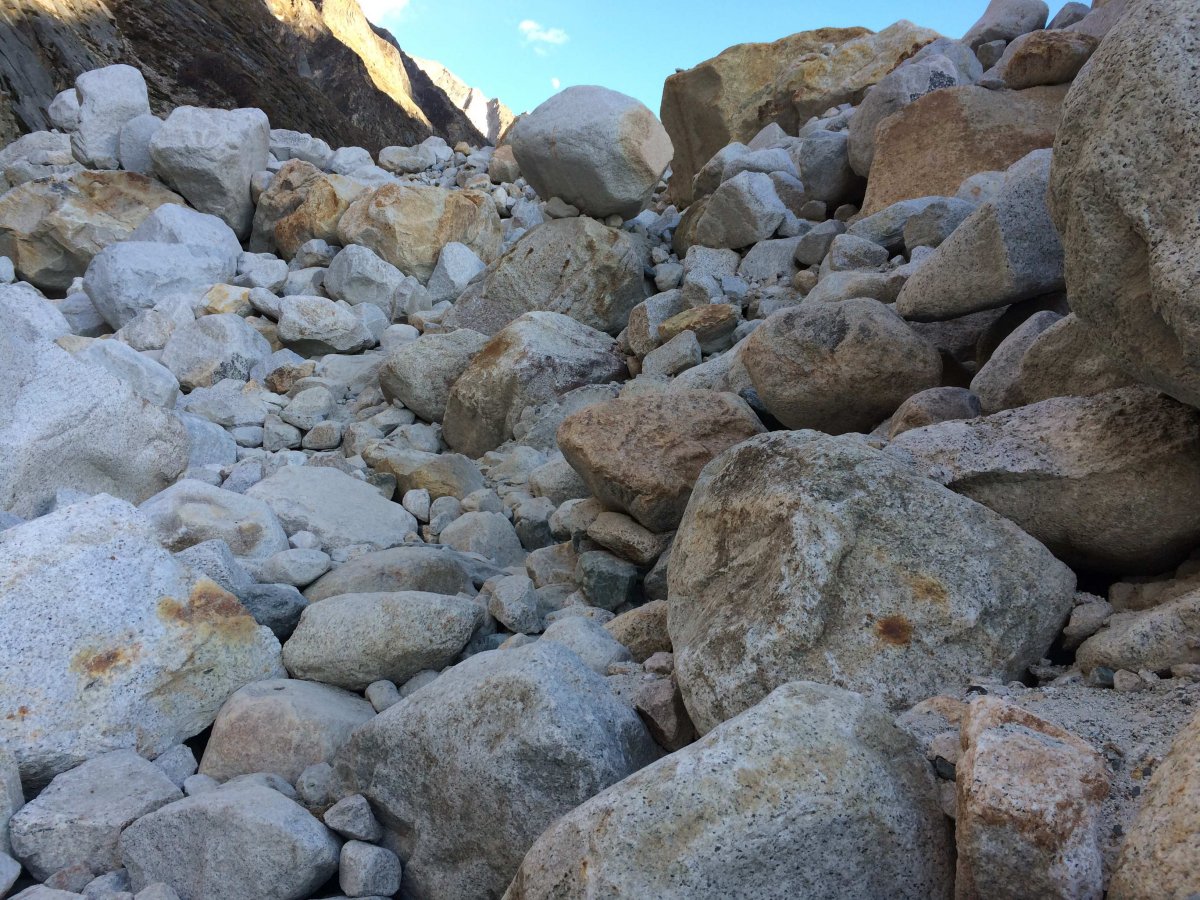
The trail on the other side of the river however is much easier but it would mean that you would have to cross the water stream. If you find a spot where you can, jump on the other side of the river (the river would then be on your left after crossing).
Make sure you do not get your shoes wet in the process because that will become a huge problem. Trekking in such cold weather with wet shoes will not be a pleasant experience.
Gangotri Glacier and Gaumukh
After a grueling final 4 kilometers of a trek, you will finally arrive at Gangotri Glacier and Gaumukh. From Bhojbasa, it will easily take about 3 hours to get here.
Spend some time, take pictures, and then head back to Bhojbasa for the night if you trekked all the way to the glacier on Day 1 itself. If you came here on Day 2 after a night’s stay at Bhojbasa, then it is time for you to head back to Gangotri.
Also Read: Easy Treks in Uttarakhand: The Top 5
Mobile Connectivity at Gaumukh
There is no mobile connectivity at all at Gaumukh. Airtel and BSNL will work fine in Gangotri but the signals will be all gone about a kilometer into the trek.
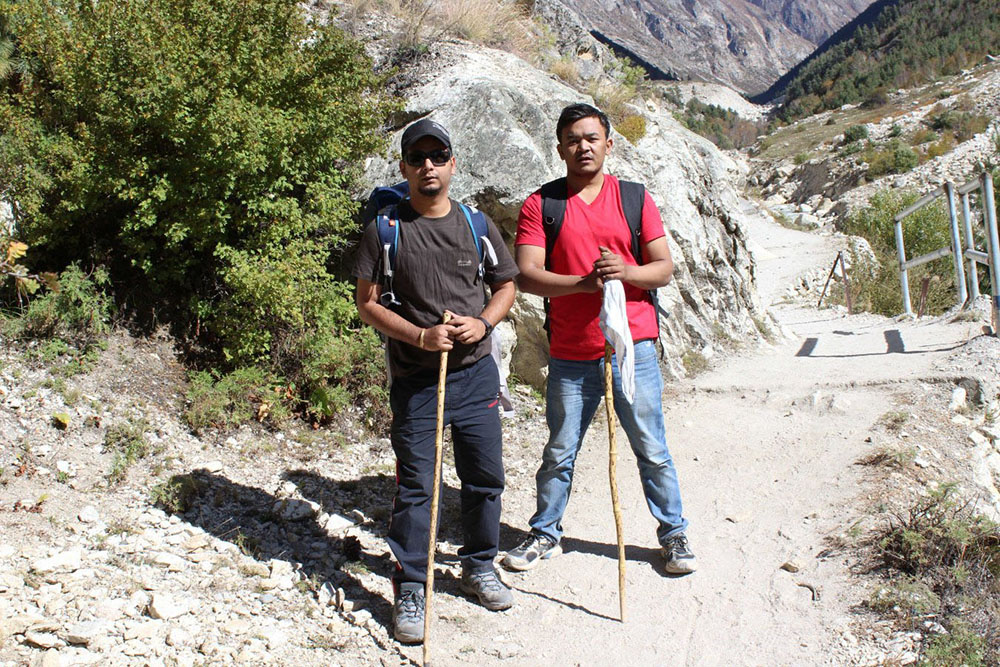
Accommodation on Gangotri Gaumukh Trek
The only accommodation on the trail is available at Bhojbasa and nowhere else. Depending on your own preference, you can either stay at the Ashram or GMVN rest house. These are both dormitory-type accommodations. Hot water will be provided and only vegetarian food is served here.
If you want to, you can even book the GMVN Guesthouse by calling 0135-2740896, 2749308, 2748478; or by emailing at [email protected] or [email protected] . You can also book it online at the GMVN Website . Just create a user ID on this site and book your stay. The two Ashrams at Bhojbasa are known as Ram Baba Ashram and Lal Baba Ashram.
Accommodation Cost at Bhojbasa
The Ashram here will charge you Rs. 300 per person and the GMVN Guest House will charge Rs. 350 per person.
Also Read: List of Necessary Items to Carry for Trekking
Acute Mountain Sickness
If you start to feel symptoms of altitude sickness anywhere on the trek, please do not climb up and further and return to Gangotri immediately. For example, if you start to feel feverish, have headaches, nausea, chest pain, having difficulty breathing, then it means you are suffering from AMS and any further gain in altitude will only make things worse. Stop and climb down immediately.
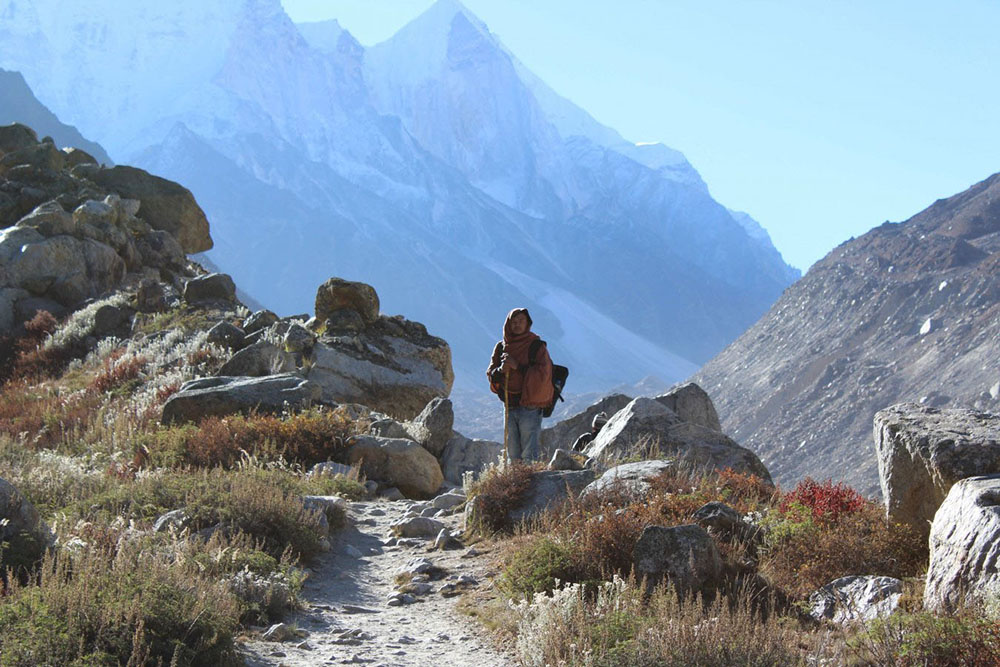
Mentioned below are a few other tips that can be of help while trekking to Gangotri.
- Any sports shoe will be fine for completing this trek but if possible, do bring a pair of trekking shoes with good grip and ankle length.
- You must bring a light jacket even if you were trekking in the months of May and June. The wind out here is a bit cold and the weather can change unpredictably.
- Permits for Gomukh can be procured via Fax as well.
- After 3 kilometers from Chirbasa, you will come across “Gila Pahar”, a place well known to be dangerous because of landslides.
- You will also come across Bharals, a type of mountain antelope while trekking to Gangotri.
- The route after Bhojbasa can be a little difficult for some people, and even more so after the 2013 floods.
- You should avoid trekking in the monsoon season. Rains can make the route slippery and this region is prone to landslides, cloudbursts, and roadblocks.
- Please do not attempt the trek alone. Be in a group of at least two people. Also inform, your folks before you start on the trek.
- Please carry ample dry fruits, chocolates, snacks, and drinking water.
- Do not consume alcohol or any other intoxicants during the trek.
- Do not attempt trekking at night.
- Before undertaking the trek, it would be better to consult your doctor.
- You should carry basic medications (for fever, headache, upset stomach, body-ache) and a first-aid kit during the trek.
- Please be a sensible tourist and do not litter. If you brought polythene bags along, please ensure that you are bringing those back and not throwing them carelessly.
Also Read: 7 Short & Easy Winter Treks in Uttarakhand
Things To Carry for the Trek
- Comfortable clothes. You do not want to go trekking in tight-fitting jeans.
- Good quality trekking shoes
- Sunscreen lotion of highest SPF that you can find
- Skin moisturizers
- Water bottles
- Energy bars/snacks/Dry Fruits
- Pair of sunglasses
- Personal toiletries and basic medication (if any)
- Flashlight (with spare batteries)
- Insect repellent and emergency medical kit
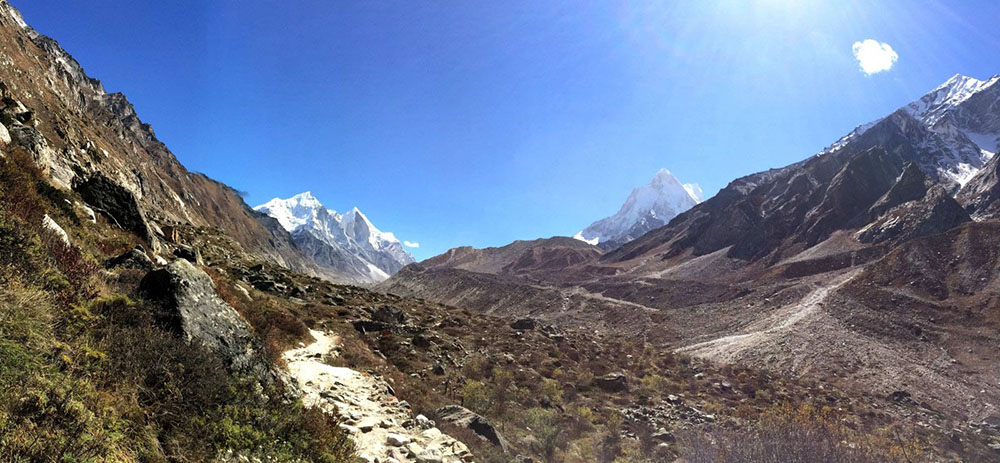
Gaumukh Temperature
The average temperature at Gomukh and on the trek remains around 15°C to 16°C during summer; and around 5°C to 6°C during the months of September, October, and November. It snows heavily in December, January, and March here with temperatures way below zero degrees making the area inaccessible.
Gaumukh Height
Gaumukh is located at an altitude of 13,200 ft.
Gangotri to Gaumukh Distance
The total distance between Gangotri to Gaumukh is 18 kilometers.
Gangotri to Gaumukh by Pony
Horses and ponies are not allowed on the Gaumukh trail and you must complete the journey on foot only
Also Read: 12 Scenic and Offbeat Places in Uttarakhand
Gaumukh Trek Difficulty
The difficulty level of the Gaumukh trek is moderate to difficult.
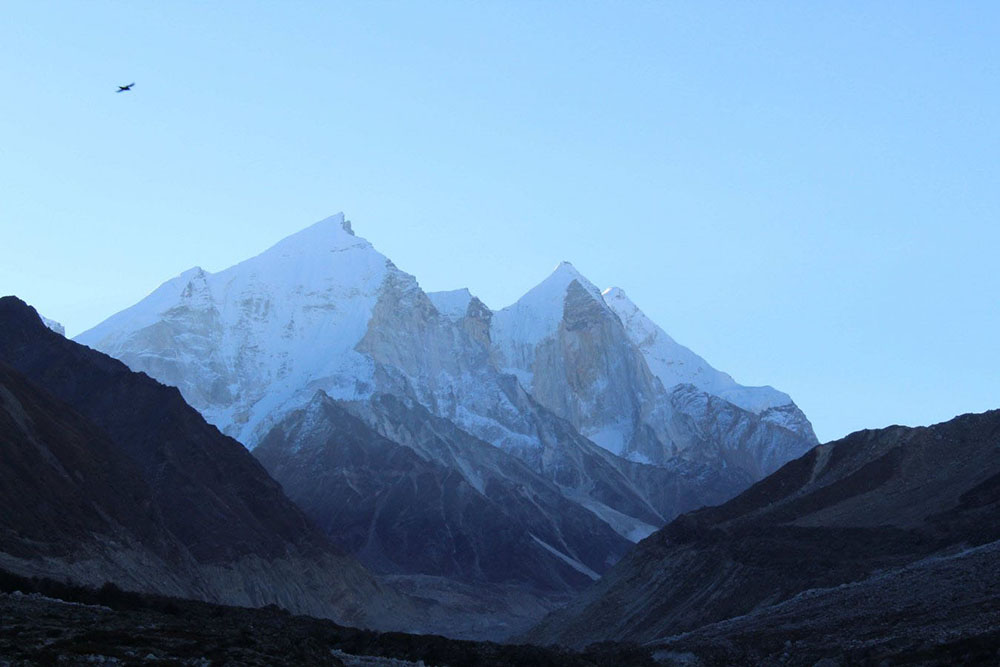
Gaumukh Trek Itinerary
Starting from Delhi, you can follow the following itinerary for a trip to Gangotri and Gaumukh. I am assuming Delhi as the starting point here but even if you were coming from a different city, only the journey to and from Delhi will be different. The trek details from Gangotri will still remain applicable.
- Delhi to Rishikesh / Chamba – Day 1
- Rishikesh Chamba to Gangotri – Day 2
- Gangotri to Chirbasa to Bhojbasa – Day 3
- Bhojbasa to Gomukh to Bhojbasa to Chirbasa to Gangotri – Day 4
- Gangotri to Rishikesh = Day 5
- Rishikesh to Delhi – Day 6
Gaumukh Tapovan Trek
If you had some more time in hand, then you can extend your trek further to Tapovan. Please note though that for Tapovan, you will need to hire a local guide and arrange for your permits accordingly. Tapovan trek cannot and must not be attempted on your own without proper guidance.
- Delhi to Rishikesh – Day 1
- Rishikesh to Gangotri – Day 2
- Gangotri to Bhojbasa – Day 3
- Bhojbasa to Gomukh to Tapovan – Day 4
- Tapovan to Bhojbasa – Day 5
- Bhojwassa to Gangotri – Day 6
- Gangotri to Rishikesh – Day 7
- Rishikesh to Delhi – Day 8
That pretty much is all that you need to know about trekking making a trip to Gangotri and then trekking to Gaumukh. I hope the information above was of help. If you have any questions; or need any other details; please feel free to ask in the comments section below, or at our Community Forum , and I will be glad to answer.
Vargis.Khan
Not much to write about me really except for that I love to travel around whenever I can and to wherever I can. This blog is just a small attempt to share my travel experiences with the world. Hope you like it !!!
Related Articles
Alpather lake trek – a complete travel guide, thajiwas glacier – sonamarg to thajiwas glacier trek..., sonamarg to thajiwas glacier – a beautiful trek, 66 comments.
Hi Vargis Bhai, thank you so much for this great info. I’m thinking about doing this trek at mid July (2023) – do you think it’s reasonable (regarding weather)? Thanks
It is not advised to attempt the trek in July due to the monsoon season bhai … May, June are better
Thanks Vargis for your reply. Do you have any other 5-7 day trek in India recommended for July? my starting point is Delhi (finishing a business trip there). Thanks!
Sorry Amichai … I am not intro trekking that much, have only done a handful
Hi I am AMAL, Planning to track in this month on 31st August, 2023 to Goumukh to Tapovan. How can I get a Guide. Please suggest me.
I want go Gomukh 24th to 28 th May . I am solo travelling. Please let me know is there any package for me.
I didn’t get permission without any travel agent to go Gomukh. How to get permission to go Gomukh? Please guide me
Hi Vargis Bhai,
If i hire a guide to go to tapovan, what do you think should be his charges per day. I plan to go solo with the guide. I am fit enough to reach bhojbasa on the first day and stay at tapovan the 2nd day and on third day back to gangotri. May be a day can be added if i go to nandanvan depending on weather.
Hi, we are planning to trek to gomukh in mid May 2023 with our 2 kids, aged 8 and 5 year olds. Are kids of this age permitted? Is it advisable to travel with kids of this age?
I will not advise bringing a 5 year old on the trek
I am 72 with no medical issues. Can I go for Gaumukh treking . Already have trek experience
Are horses available on this route for elderly or Palkis?
Hello Vargis,
First of all really appreciated for such a nice description. It’s really very much informative and helpful. I wish to go Gaumukh trek as a beginner. So for a beginner what would be your advise and how to prepare for this trek . Your valuable advise would be appreciable.
First of all really appreciated for such a nice description. It’s really very much informative and helpful. I wish to go Gaumukh trek as a beginner. I never trek before but would like t go in October 1st week. Your valuable advise would be appreciable.
Hi, we are planning for mid May 2023 with our 2 kids, aged 8 and 5 year olds. Are kids of this age permitted? Is it advisable to travel with kids of this age?
Hello Vargis bhai just loved your blog. I am planning for this trip and I want some guides contact number. Can you please provide me the contact number of the guides
Thank you Dibyendu Bhai. Sorry, I do not really have any contacts anymore.
Dear vargis really thanks for the detail writeup. It gives full information. Absolutely no quiry if you are a trekker.
Thank you Prasanna Bhai
Hi Varghis Bhai…Do you have any Idea if Solo trekkers are allowed this year in may?
Sunil Bhai too early to tell. It all depends on how the COVID story will unfold this year because of the recent increase in the cases
we are a group of 4.Is it okay to visit Gaumukh in 2 or 3rd week of November.Anything I should be aware of,other than that in your great blog
Hi Abhiram. I’m planning to visit Gaumukh as well around the 7th of Nov. I had some questions regarding the online permits. Apparently Gaumukh is categorised as a “Moderate Trek” although while registering I keep getting an error “Hiring an Agency is Mandatory for Moderate Treks”. Would it be possible if I could connect with you on this?
Hello Varghis, it is really an informative as well as wonderful write up. The links are really helpful. Could you just provide me one information? Will I be allowed to pitch tent at Tapovan? With best wishes, Krishnapriya [email protected]
Vargis Sir, First of all a huge thanks for such awesome, resourceful blog. I am planning to do a solo trek till Gomukh. Now my question is if I extend my plan till Tapovan, where I would get local guide?
Hi Subhadip Bhai – You can get guides for it from Uttarkashi.
Very friendly informative….sir…
Thanks Bhai
Highly informative blog. I am planning to trek un the month of May 2021. Do you know any local guide and his contact details who can guide us on the route? Please share the details at Shridhar Vaidya – Cell 9422048509 Thanks.
Dear Mr Varghis , I want to go gaumukh track may second week along with my wife and two other couple…but unfortunately website not open for gate permit….how can I do……when will this website open and how many days permit will given(maximum)
Dear vargis I read your blog nice information share…..thanks for it…
Hi Vargis, Thanks for the details. Could you please share that if I take Tapoban permit and take the route of right side of the river from Bhojbasa, is it possible to cover Bhojbasa-Gomukh-Bhojbasa-Gangotri on the same day? We are regular trekkers, want to go close to the Gomukh, but are time-bound. Adv thanks.
Bhai Gangotri to Gaumukh and back in a day will be extremely difficult. I really do not think it is doable. The second time I did this trek, we started at 6 AM from Gangotri and reached Gaumukh at around 3 after rushing through most of the way since we had already done it once before.
Very nicely described trail information. Almost all questions get answered while reading the blog on Gaumukh trek. Thanks a lot.
Wow.. really very informative and so well explained.i was finding information about this trek from many hours and finally came out to this. Your blog is awesome..i am planning this trip for next year. Recently i went to kedarnath trek and it was amazing. please give me your contact number or add me as if i need any help later (7053563370). Thank you so much
Hello vargis, If i visit rishikesh to gangotri then trekk gomaukh, then how i get permit from uttarkashi?
Dear Mr Varghis This is the first time I visited your blog. Excellent compilation of information, which will be very handy for any traveller. Thank you for putting this together which will help many travellers plan their journey. Regards Tagade
Thank you for taking the time to drop a note Mr. Tagade
What happens if one doesn’t not come back in 2 days as permit duration ? Also if one has applied for only upto gaumukh , can later at dfo office it may be extended upto tapovan .? Is it mandatory to take only tour operation whose list is available at permit website. Is night stay at tapovan allowed . Is tapovan worth visiting.
Great job of detailed info. Thanks and God bless you!
I want to go Gomukh ,Tapoban and nandanban next may 2020. Thanks for that information
You are welcome !!!
i am planning to start from delhi on 4th april 2020 and start gomukh trek on 6th april. Is this time right to trek to gomukh, if yes can i also add tapovan along with gomukh.
You can no but it is not the right time. If possible, delay it by a couple of weeks.
Hi Vargis, Is it possible to do this trek with wife and kids (8 and 10) with a stopover at Bhojbasa in Apr end? Kids are very active, wife is moderately active. My only worry is how is the route (boulders, narrow, etc).
Hi Vivek – To be very honest, I will not recommend it with kids that young.
Your blog had been very helpful during my several ladakh tours. And the high standard is maintained here too. It really comes handy in planning my trek to Tapoban.
Just a typo to mention in “Gaumukh Trek Details” section.
It reads, “…. The route will look something like this. Gangotri – (9 kms) – Chirbasa – (5 kms) – Bhojbasa – (4 kms) – Gangotri ( This should be GAUMUKH) = 18 Kms
Thank you for your kind words Bhai and for catching that error. I have corrected it now.
I want to go to gongotri,gomukh and tapovan solo in may 2020
Yes you can
We are a group of 5 people, we have planned in the month of May 2020
You can go, it will be open at that time
Sir, we are planing in this year May, i want to know the Guide charges for the entire Gomukh trek to complete ?
The Online Single Window website for Gaumukh Trek Pass isn’t working. Is the site closed?
The trek must be closed now for winter season
Sir I want to go gomukh October 19.10.19.I am alone please tell me about this trek route and how can I get a permit for gangotri national park.
Thanks for nice and detailed blog.
Thanks for taking the time to drop a note.
Thank you Vargis, very nice information
Thanks Abhimanyudu
Hi, Mr Khan,
I am SC Minocha, 66. I along with my nephew who is 24, are going to Gaumukh on 02 Oct. I have got the permit online. I have booked GMVN accn at Uttarkashi for 30 Sep and at Gangotri for 01 Oct and 04 Oct. Also at Bhojwasa for 02 Oct and 03 Oct.
I have planned in such a way that, if I don’t get Pony, I can manage. I have done Kailash Mansarovar Yatra, Kedarnath and Amarnath Yatra, partially on foot and partially on Pony.
Your valuable comments please.
Hi Mr. Minocha, may i know through which website did you manage to get the online permit. The following link doesnt seem to be working.
http://www.swsuttarkashi.com/Permission/GangotriNationalPark
thanks for the help.
Hi Vargis, is it possible to do Gangotri to Gaumukh and back in 1 day. We are experienced trekkers. Is the total trek 18 km one way or round trip ?
God bless you Sir. Wonderful description. I will ever remain grateful to you sir. Thanks.
Thank you for taking the time to drop a note Mr. Banerjee. I am glad that the information was of help.
I am planning for this trip I need some details could you please give me your contact no. so that it will be good for me my no. is 7503226176
And your blog is very awesome !!
Leave a Comment Cancel Reply
Save my name, email, and website in this browser for the next time I comment.
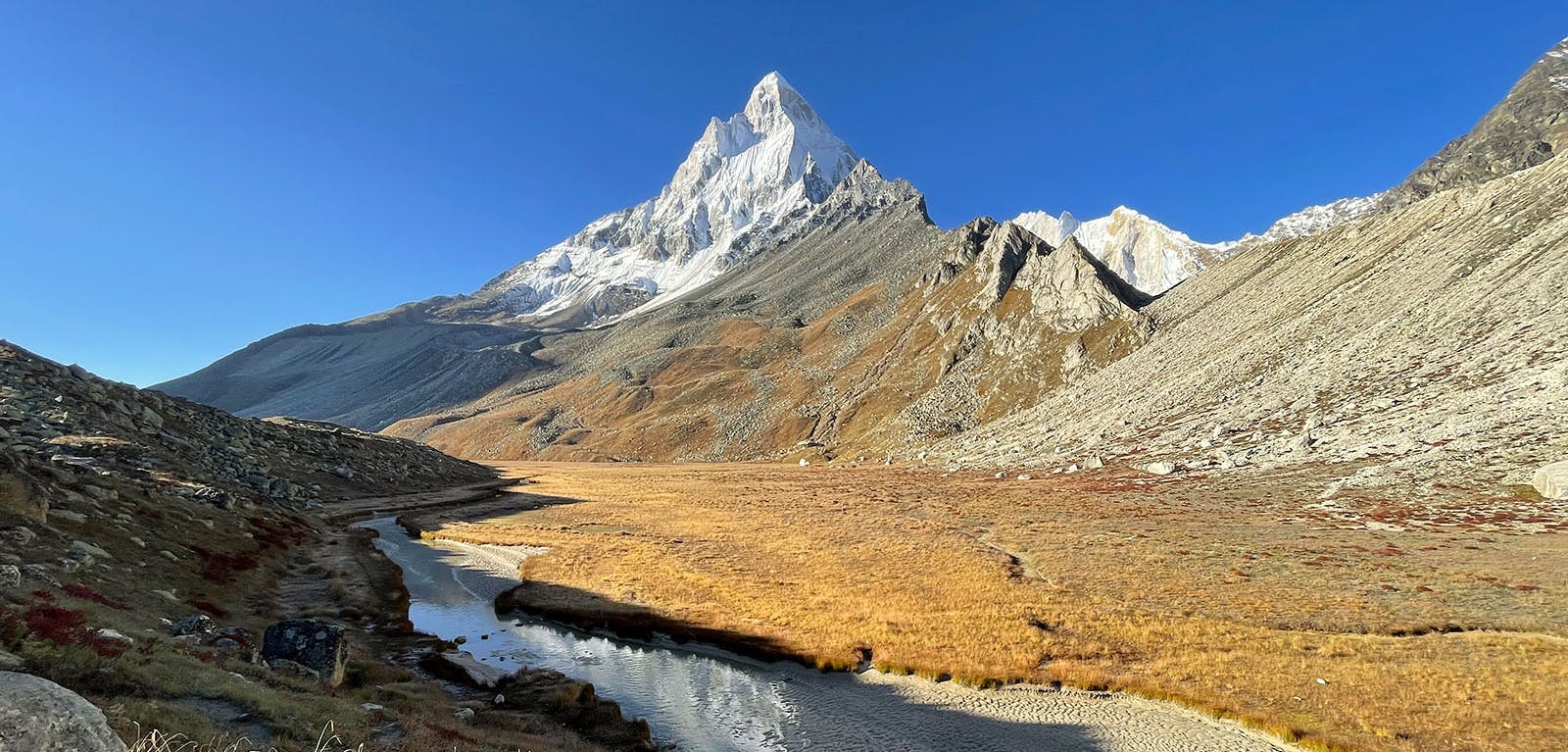
Gaumukh Tapovan Trek
A Journey to the Source of River Ganga
TREK DIFFICULTY
Moderate-Difficult
TREK DURATION
HIGHEST ALTITUDE
Gaumukh Tapovan is one of the most rewarding treks you will ever do.
There are summit views and there are ‘big’ summit views . On the Gaumukh Tapovan trek, you don’t just see the best views of Mt Shivling. You see Mt Shivling right from the base to its summit. And if you don’t know about Mt Shivling, it’s one of the most beautiful looking mountains in our country. No wonder the mountain has been featured in our gold calendar every year since it was published.
But wait. Not only Mt Shivling, you see the Bhagirathi sisters from top to bottom. Sometimes we feel the Bhagirathi sisters are even grander than Mt Shivling because the three of them form a massif, which dominates the landscape.
Then why do more people not do the trek you ask?
Unfortunately, the popularity of other treks brought the Gaumukh Tapovan trek down from its grace. It’s almost like a new generation movie star replaced an older star. It sounds silly, but that’s what happened to the Gaumukh Tapovan trek. Treks like Roopkund , Rupin Pass and the Hampta Pass gained popularity. And Gaumukh Tapovan fell in popularity.
As is the mentality of most trekkers, if they find one trek attractive, they just rush towards the new offering. It is a mistake.
Before we begin, here are some quick facts about the Gaumukh Tapovan trek:
Gaumukh Trek is a 46 km trek hiked over 6 days (8 days including the drive to and from the trek,) in the Greater Himalayas. It lies in the state of Uttarakhand and begins and ends at the pilgrim town of Gangotri.
The trail snakes through the Greater Himalayas within the confines of Gangotri National Park. It is a moderate-difficult trek ( more on this ahead on this page ) that can be attempted by beginners if you prepare well.
Gaumukh Tapovan - Complete Trek Information
We have always wanted trekkers to be well-informed before they go on a Himalayan trek . Knowledge is the difference between a safe trek and a dangerous one. It’s also the difference between a wholesome experience and a superficial experience.
Use this section to learn about the Gaumukh Tapovan trek. It has in-depth information about each day of the trek, what to expect, and how you need to prepare for it. Many years of expertise have gone into this content. Trekkers find that extremely useful.

Quick Itinerary
Get your trek plan

How Does Each Day Look
Complete Trek Guide with Photos

How Difficult Is Gaumukh Tapovan Trek
Use This to Set Your Fitness Goals

Best Time To Do Gaumukh Tapovan Trek
Schedule Your Trek Dates Based on the Best Season

Packing List
Things To Take

How To Reach The Base Camp of Gaumukh Tapovan
Plan Your Travel With This

Frequently Asked Questions
Get your questions answered here

How to get fit for Gaumukh Tapovan Trek
Fitness matters for the trek
Gaumukh Tapovan Videos
Watch these videos to prepare for your Gaumukh Tapovan trek.
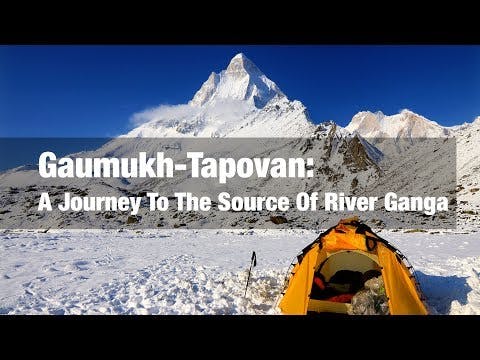
Photo Gallery
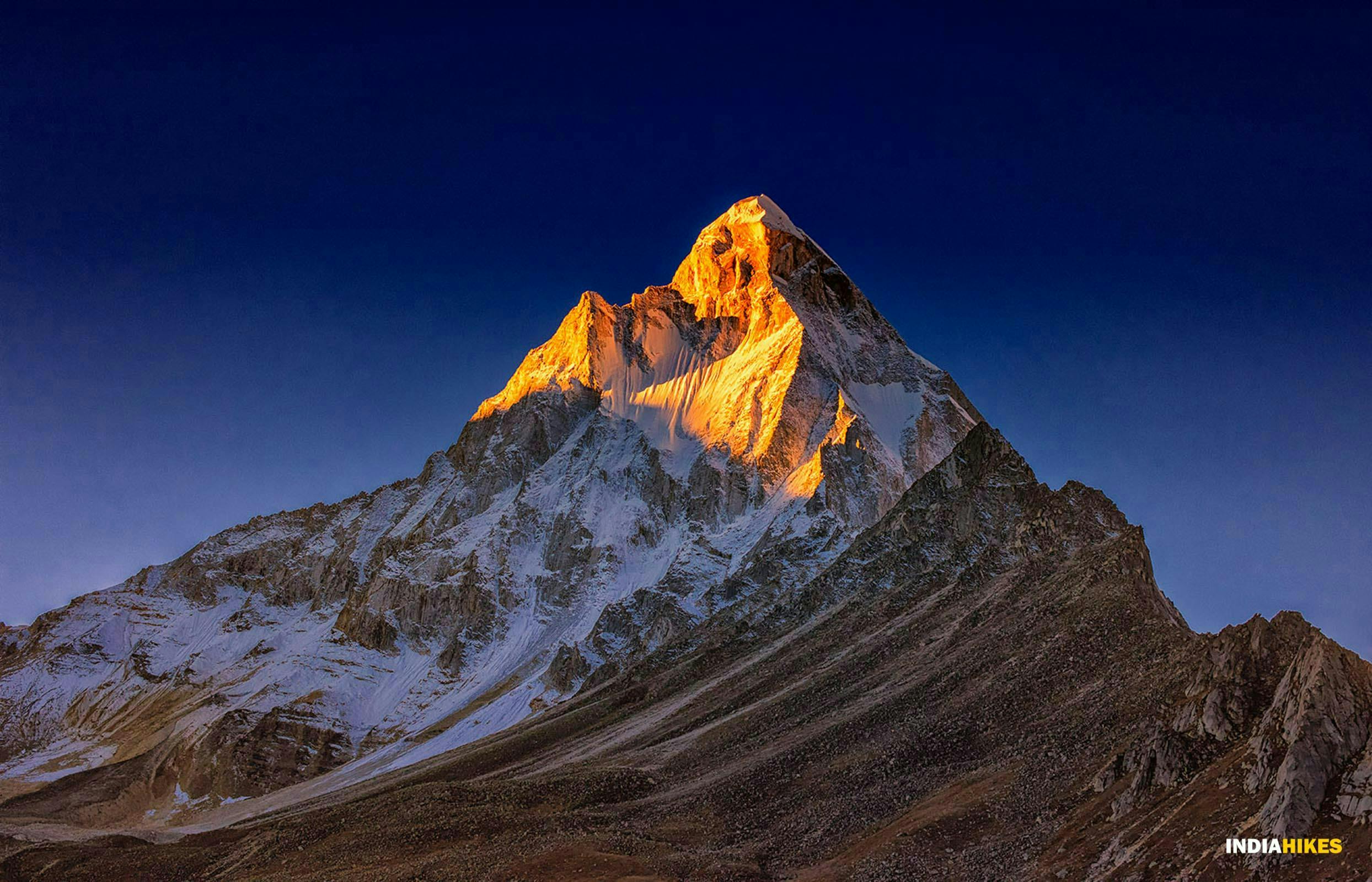
Expert Speak
Arjun Majumdar Founder, CEO

Arjun Majumdar, the Founder of Indiahikes, went on this trek in 2015. As one of the veterans of the trekking community in India, he’s an expert when it comes to Gaumukh Tapovan Trek. Here’s Arjun talking about one of the top treks in our country.
What I Like and Don't like About the Gaumukh Tapovan Trek
What I Like About the Gaumukh Tapovan Trek
1 . The Gaumukh glacier
I have not stood at the snout of such a gigantic glacier in my life. The Gaumukh glacier snout must be as high as a ten-storey building. Big chunks of ice, as big as cars, continuously fall with thunderous sounds from the mouth of the glacier. I remember the ground reverberating with every fall.
Below, the opening of the glacier was a big cavern, from which the Bhagirathi flowed. I have seen rivers forming from under a glacier. But I have never seen a river, in its full width, flow out from under a glacier, right at its source. It was stunning.
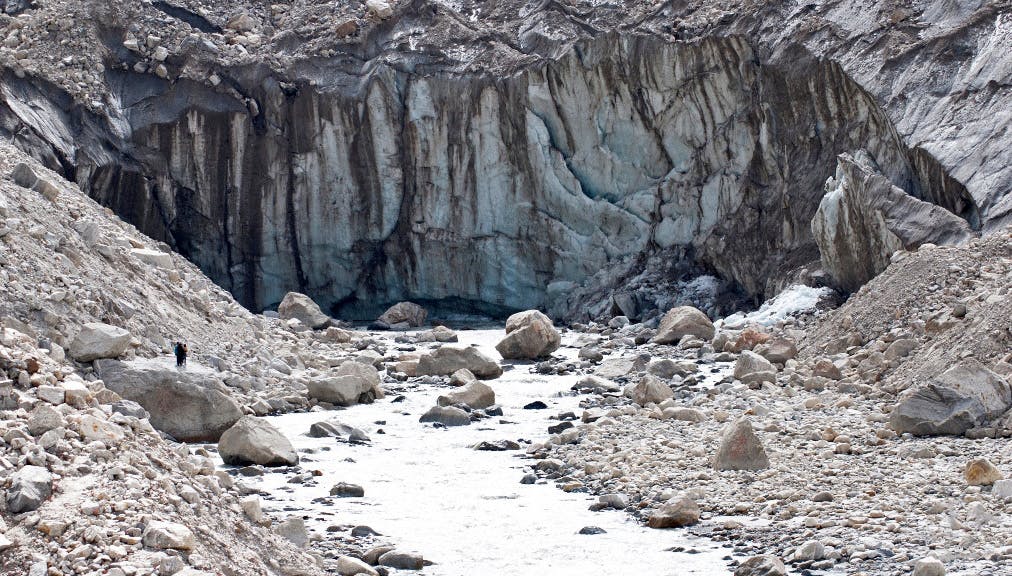
Minuscule trekkers standing before the mouth of the Gangotri glacier. Picture by Atul Rana
2 . The crevasses on the glacier
Traversing the glacier from one end to another was fantastically adventure-filled. The surface of the glacier was a maze of crevasses. Some so small that you hardly notice them, some big enough to swallow you whole.
Deep down in some of the big ones, the colour of the ice was green with a bluish tinge on their walls. Rivulets made a channel through them, sometimes disappearing into a dark abyss. It was fascinating seeing this spectacle.
Navigating these crevasses, literally tip-toeing over to the other side, ultimately clambering up to Tapovan, is an adventure that stays with me. It is fun, and frankly, quite adventurous. I admit I had my moments when my palms were sweaty.
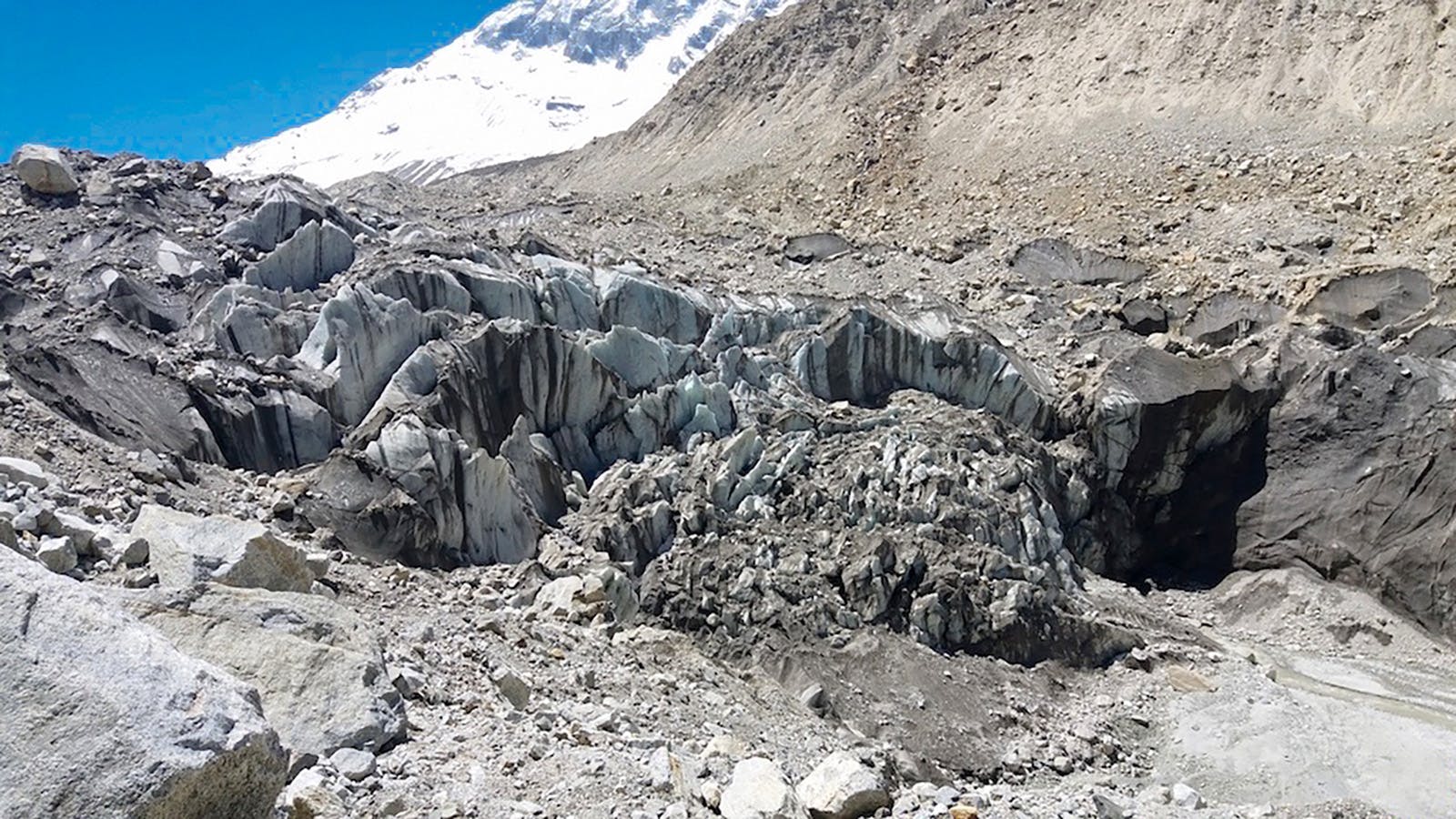
Crevasses on the Gaumukh glacier. Picture by Jude Rayen
3 . Mt Shivling and the Bhagirathi sisters from Tapovan
a. Mt Shivling I was expecting Tapovan to be a flat grassland. It wasn’t. It was a bit bouldery, a bit grassy but a very large open land. I remember the moment when we got to Tapovan. Just as we clambered into Tapovan, all my trek mates stood rooted to their spots.
They were witnessing something that they had never seen before. Right in front of them, almost less than a stone’s throw away was the entire Mt Shivling from its base to its summit.
Mt Shivling was no ordinary mountain. It was the most beautiful mountain my trek mates had set their eyes on. Like a beautiful young lady with her slender neck, and her head held high, Mt Shivling stood in front of them with grace and elegance.
I finally understood why photographers travelled from across the globe to take pictures of this majestic mountain.
b. The Bhagirathi sisters On the other side, right across the Gangotri glacier, we saw the Bhagirathi sisters. The three summits in one massif. I’ll be frank here. Even though Mt Shivling is the Greek God of beautiful mountains, it was the Bhagirathi sisters who held our attention longer.
The three sisters: Bhagirathi I, II and III. All of them nestled together in one isolated massif — and the entire massif standing tall from its base to the summit. You don’t see such mountain views in other parts of the world.
At that moment I understood what it meant to be at Tapovan. I was not witnessing spectacular mountains. I was seeing something utterly unique in mountain views. In trekking circles, if there is a list of grand scenes to see, I would put this view from Tapovan in my top 3.
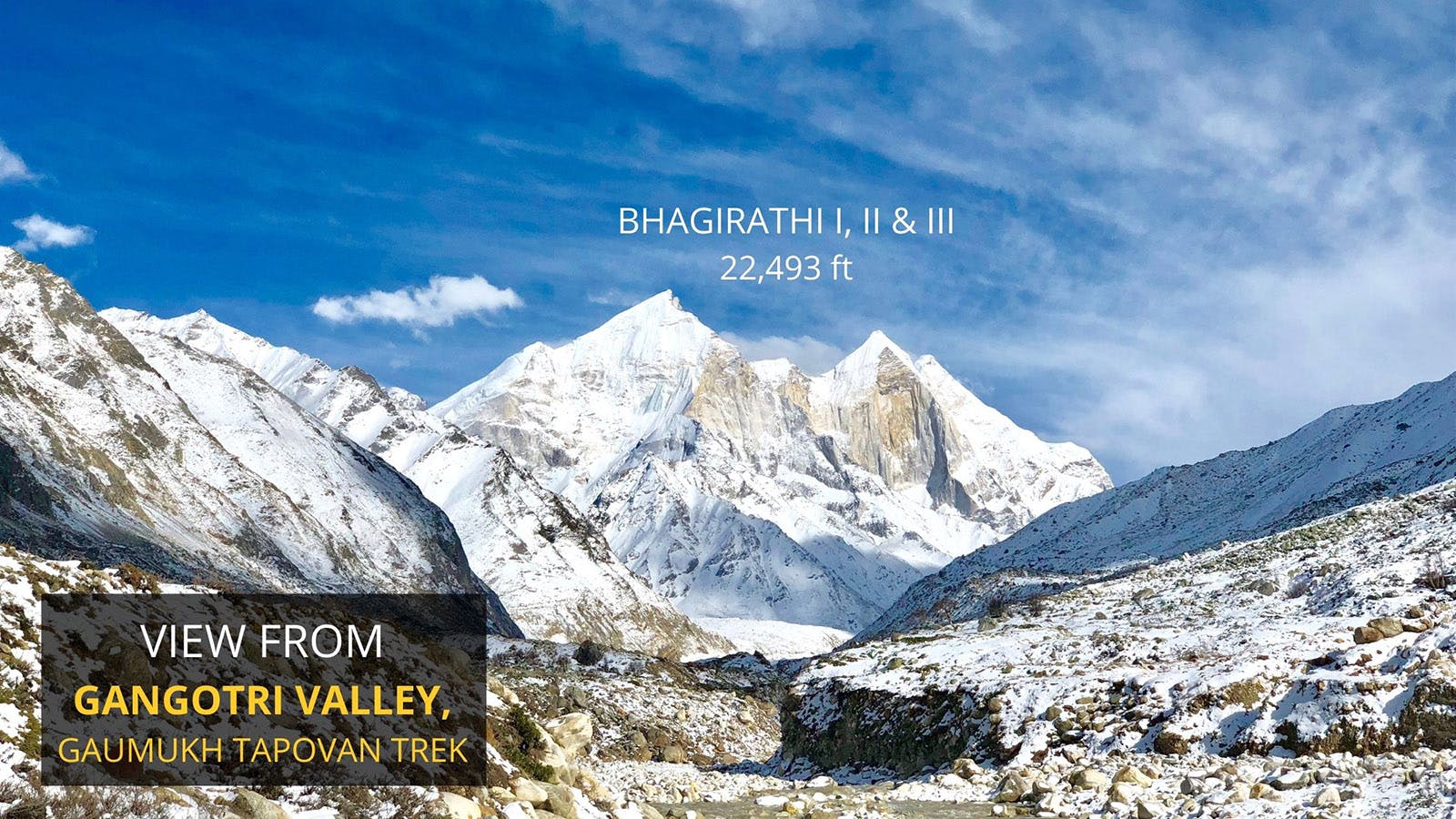
4 . The sunrise and sunset on the majestic mountains
I love sunrises and sunsets on mountains. Somehow it evokes deep emotions in me. Sometimes when I see a spectacular one, tears well up in my eyes.
So I keep a count of some of the best ones. This is why I mentioned earlier about photographers coming from far and wide to do this trek. Mt Shivling is at such an angle that you get a divine sunrise and sunset on it. They warm the summit in such fascinating colours that it not only lights up the mountain — it kind of makes an already beautiful mountain stunning in its grandness.
In the evening there’s a more spectacular show. With the sunset happening both, on the Bhagirathi sisters as well as Mt Shivling. You don’t know which one to watch! As a sunset lover, it was one of the best sunsets that I saw in my life.
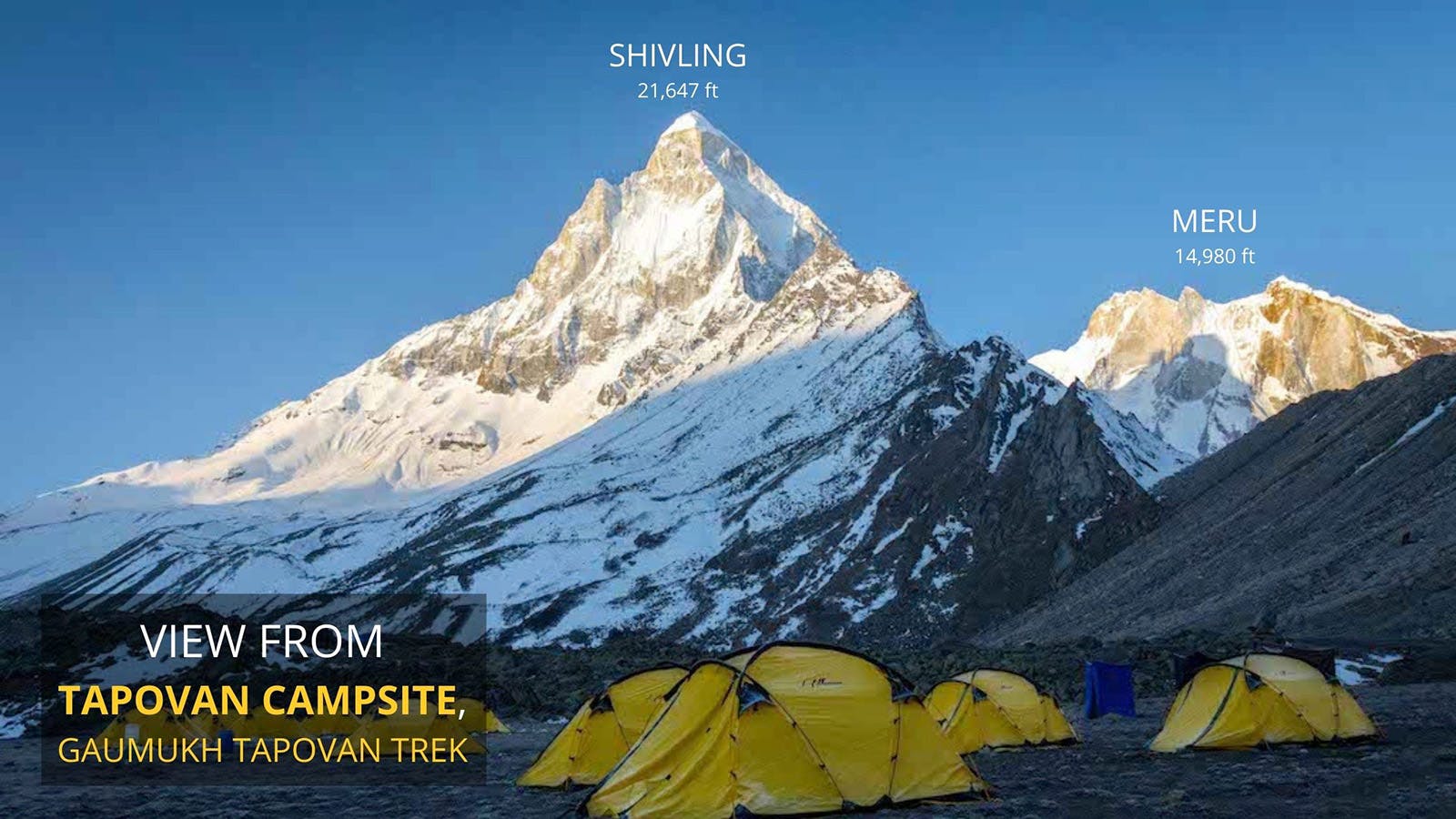
What I don’t like about Gaumukh Tapovan Trek
1 . Trek to Chirbasa
Frankly, I did not like the trek until we got to Chirbasa. I thought it was a bit monotonous with similar valley views. Too many pilgrims too. The Chirbasa campsite was a bit of a let down as well. It was small and crampy.
After Chirbasa, the trek changed completely though. There were superb colour changes, terrific rock formations, and I don’t have to say, right ahead, one of the greatest mountain views in our country.
Trek Trivia
Things Nobody Tells You About This Trek
- India's Oldest Trek?
Gaumukh-Tapovan is one of India's oldest trekking trails
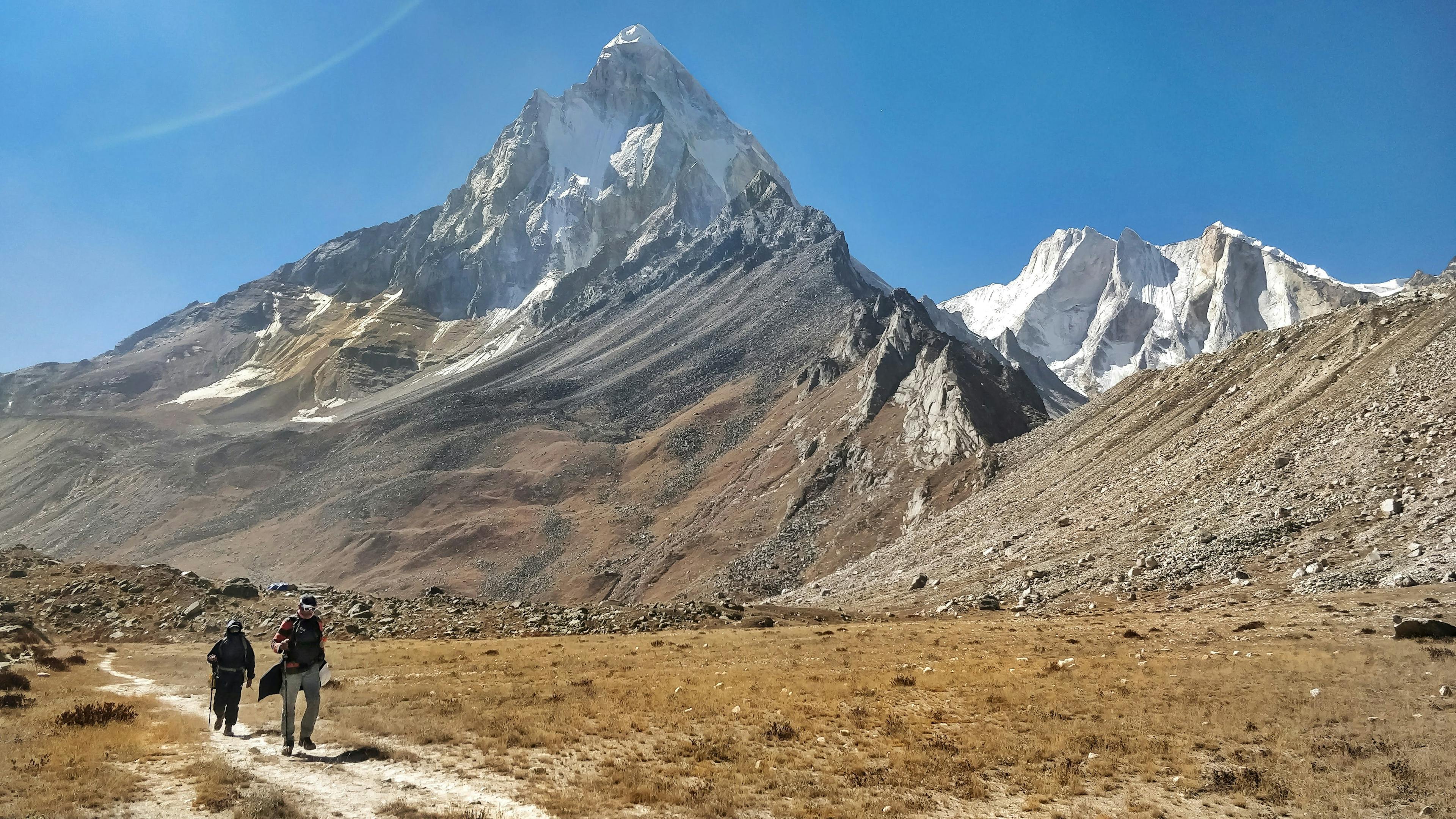
Trekkers walking towards Tapovan. Picture by Dhaval Jajal
Given that the Gaumukh-Tapovan trail has a large religious significance, it is one of the few trails that have been frequented by trekkers from across the country for centuries together.
It used to be one of the country's most visited treks until other treks started getting discovered.
Despite that, even today, you will see at least 150 trekkers on the trail every day, not limited to trekkers alone, but several religious devotees as well, who trek to offer their gratitude to River Ganga.
Leaving Mountains Better
Green Trails is our promise to leave the mountains better. We have removed over 1 lakh kilos of waste left behind by others on trekking trails. Yet this is a small percentage of what we do. Green Trails dives into reducing use of resources, reducing our carbon footprint and bringing about a change in the daily practices of our trekkers too.
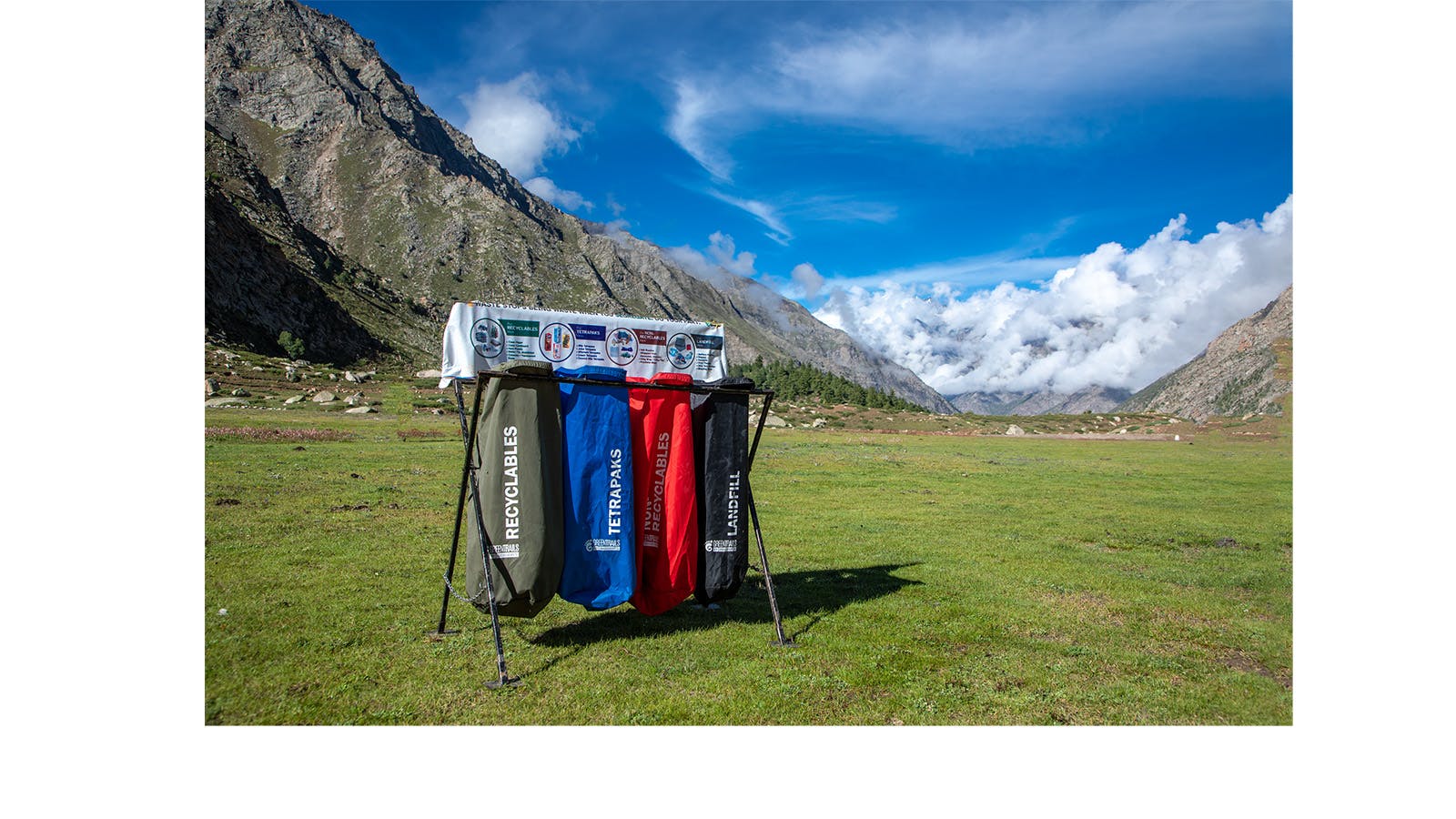
5 Reasons Why Indiahikes
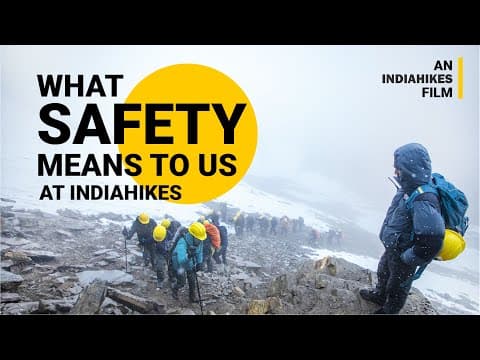
When we brought out new trails in Indian trekking, safety came with us. Back in 2012, we were the first to introduce microspikes, and two years later, pulse oximeters became standard thanks to us. Nobody does safe treks like Indiahikes. In the mountains, emergencies don't care who you're with – everyone knows that when trouble hits, you look for the yellow tents of Indiahikes.

We are pioneers in trekking. Since 2007, we have brought out treks that have become India's most famous treks: Roopkund, Rupin Pass, Buran Ghati, Kedarkantha, Kashmir Great Lakes, Tarsar Marsar, Brahmatal, Phulara Ridge—the list goes on. In 2023 alone, we brought out five new treks in Indian trekking. We know treks better than anyone . This comes directly from the reason why Indiahikes was born: to bring out trek information and enable trekkers to trek on their own.
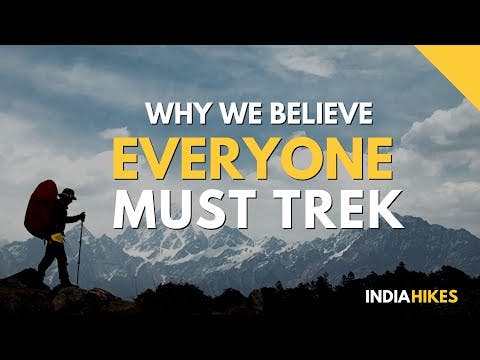
More than 25,000 people trek with us every year. We are the largest trekking organisation in India. 24% of our trekkers come back to trek with us every year. Over 4,000 students from the top educational institutions trek with us every year. Aside from this, families with children choose to trek with Indiahikes knowing that our treks are the safest. We have taken over 8000 children trekking so far, and the number continues to grow.
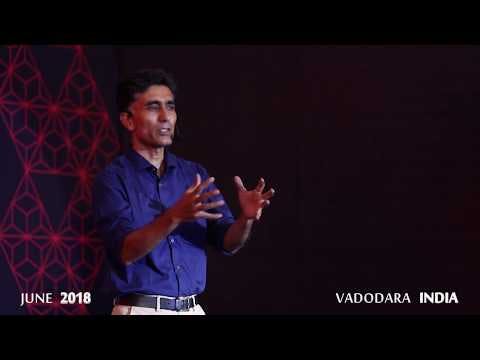
We focus on designing transformative experiences. Our trek leaders conduct thought-provoking exercises that help you reflect and contemplate. This impact stays with you for a long time. Trekkers return feeling energised, more confident, or developing abilities to deal with difficulties. Many have changed careers, rethought their core values, become more humble, shown gratitude to others, or started a new fitness journey.

Since 2012, we have pioneered sustainable practices that have become standard in trekking. Using eco-bags, our trekkers have cleared over 120 tonnes of litter from the mountains. We do not carry packaged foods; instead, we serve freshly made food. We do not light campfires; we carry coal to light angethis to keep you warm. Our bio-toilets not only keep our toilets odour-free but also enrich the soil. When you trek with us, you leave mountains better.
Indiahikes Features
You’re guarded with our trek again philosophy
If you are unable to complete a trek, or if you love a trek, you can repeat it with us anytime. You don’t have to pay us for it. See our thoughts behind this here .
Daily 3-time health checks keep you safe at any altitude
Our thrice-a-day oxi-metre checks keep altitude sickness at bay, never allowing you to reach a point where you need evacuation.
Join any group, they are all women-friendly groups
With around 30% of our trekkers being women, all women, including those travelling solo are comfortable to join any of our groups.
Request Jain/Vegan-friendly food
Our kitchen teams understand your needs as a vegan (or a Jain). We will take special care of your food, even in the remote Himalayas.
Be comfortable and sustainable with bio toilets
We have specially designed bio toilets to ensure you have no sight or smell in toilets, at the same time making sure the toilets cause no harm to the fragile ecosystem we trek in.
Fresh, nutritious food at every camp
We’ll admit it. Our love for food surpasses our love for minimalism. Expect freshly cooked, multi-cuisine food at all camps, designed to meet your nutritional requirements and keep your taste buds happy!
Special Treks with Indiahikes
At Indiahikes, we see treks beyond going from one place to another. It can offer much more. We see treks as a platform for learning and transformation. This is the thought behind our special treks.
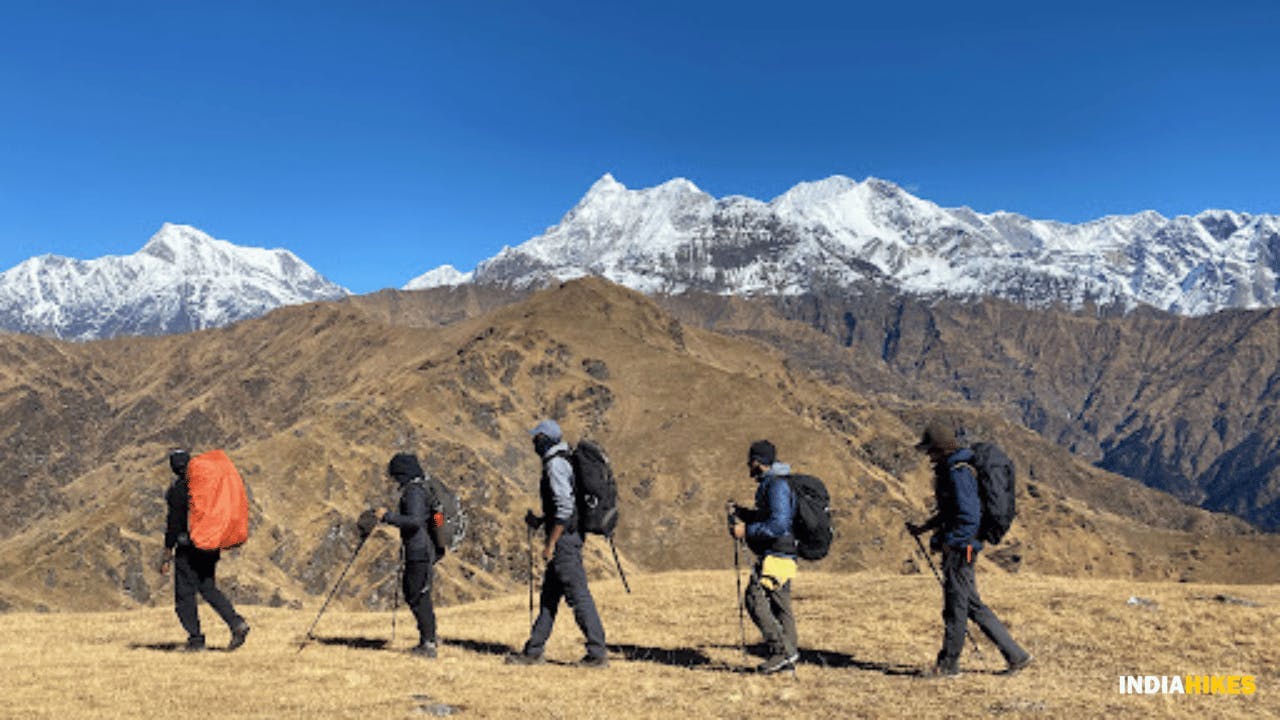
Assisted DIY Treks
Do-it-yourself treks with Trek Leader
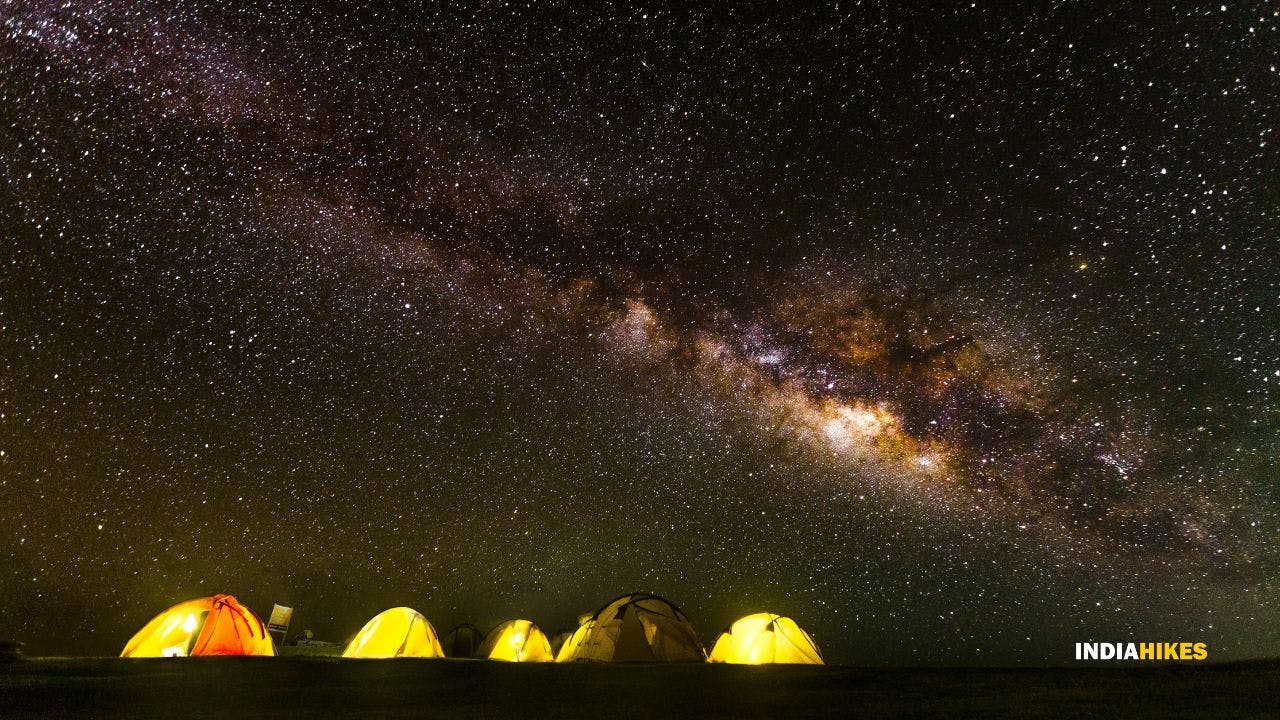
- Stargazing Treks
A special trek for stargazing enthusiasts
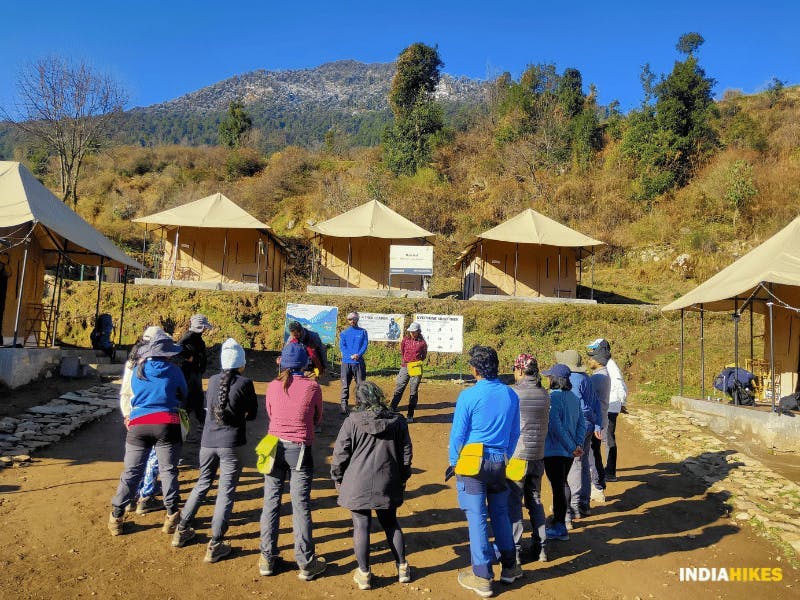
Adventure Therapy Treks
A specially designed and an expert facilitated outdoor therapy program
Other Treks Like Gaumukh Tapovan Trek
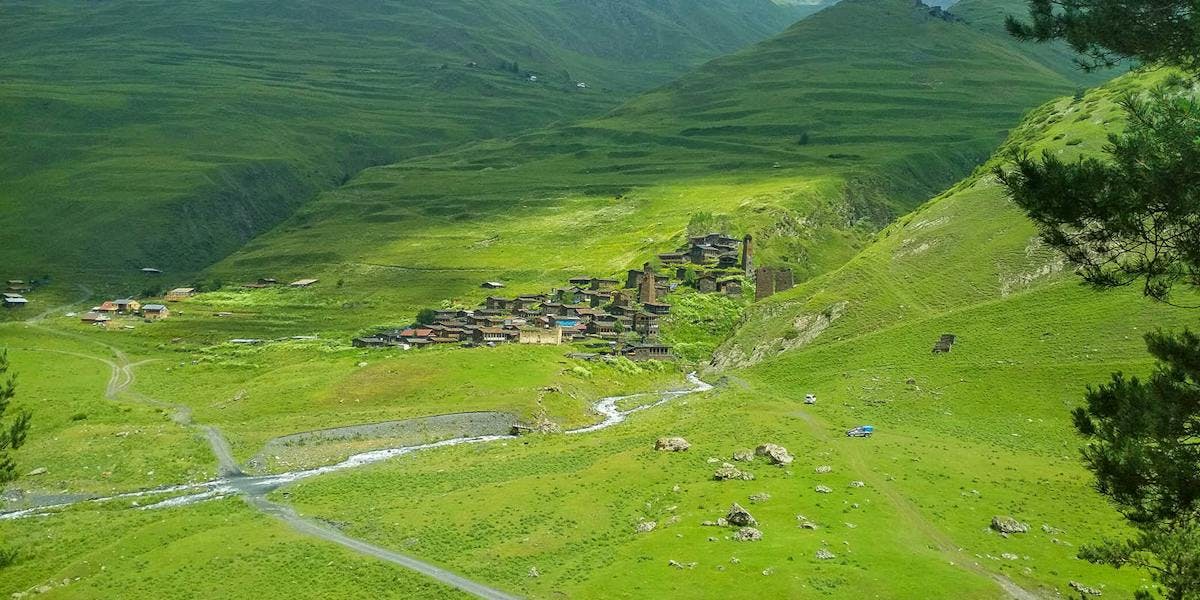
Georgia Atsunta Pass Trek
Get Trek Info
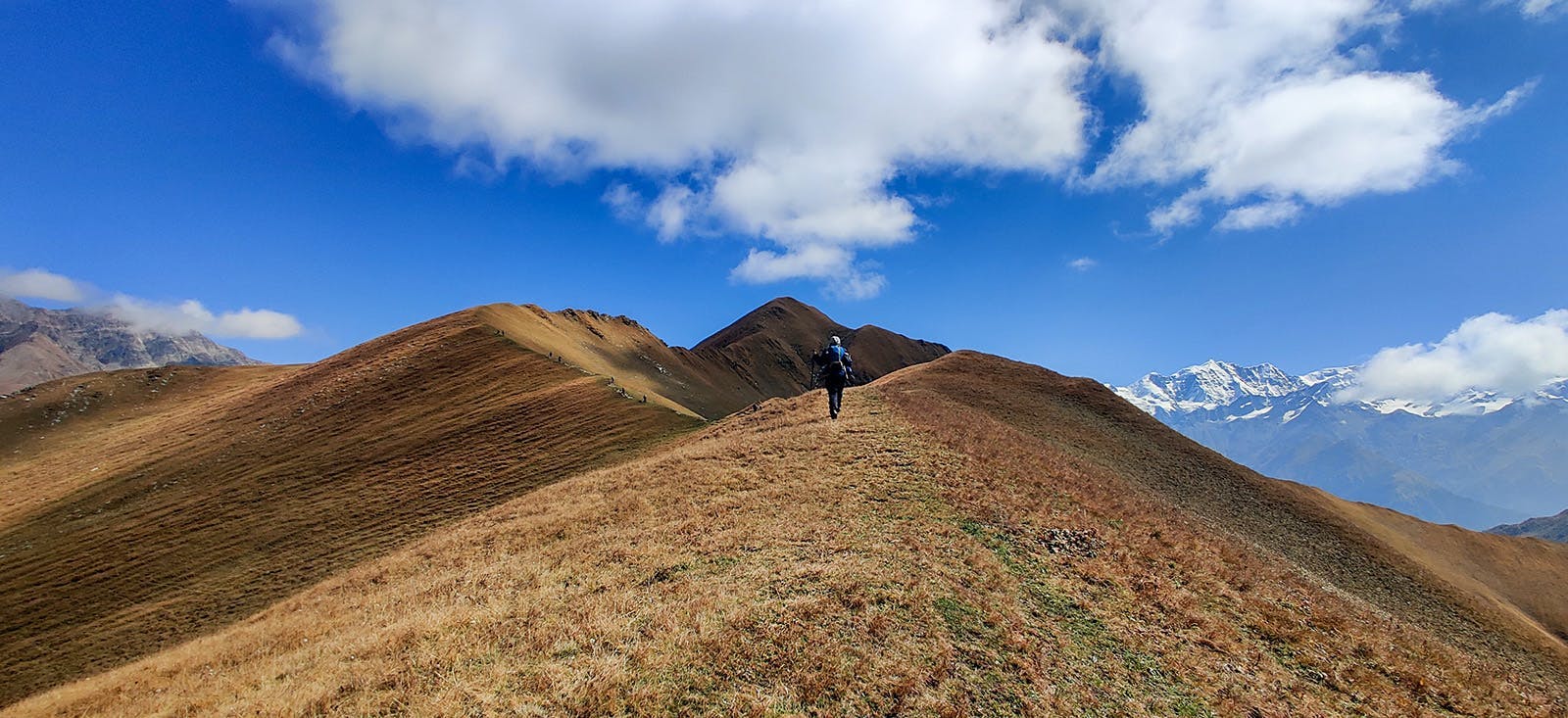
- Moderate - Difficult
Gidara Bugyal
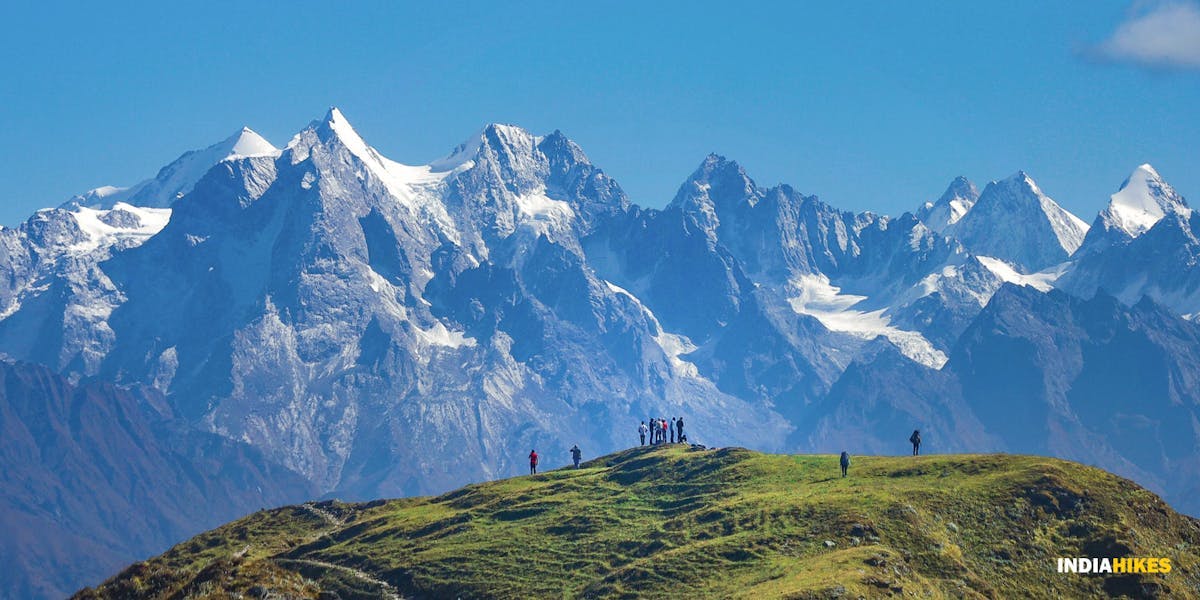
Phulara Ridge Trek
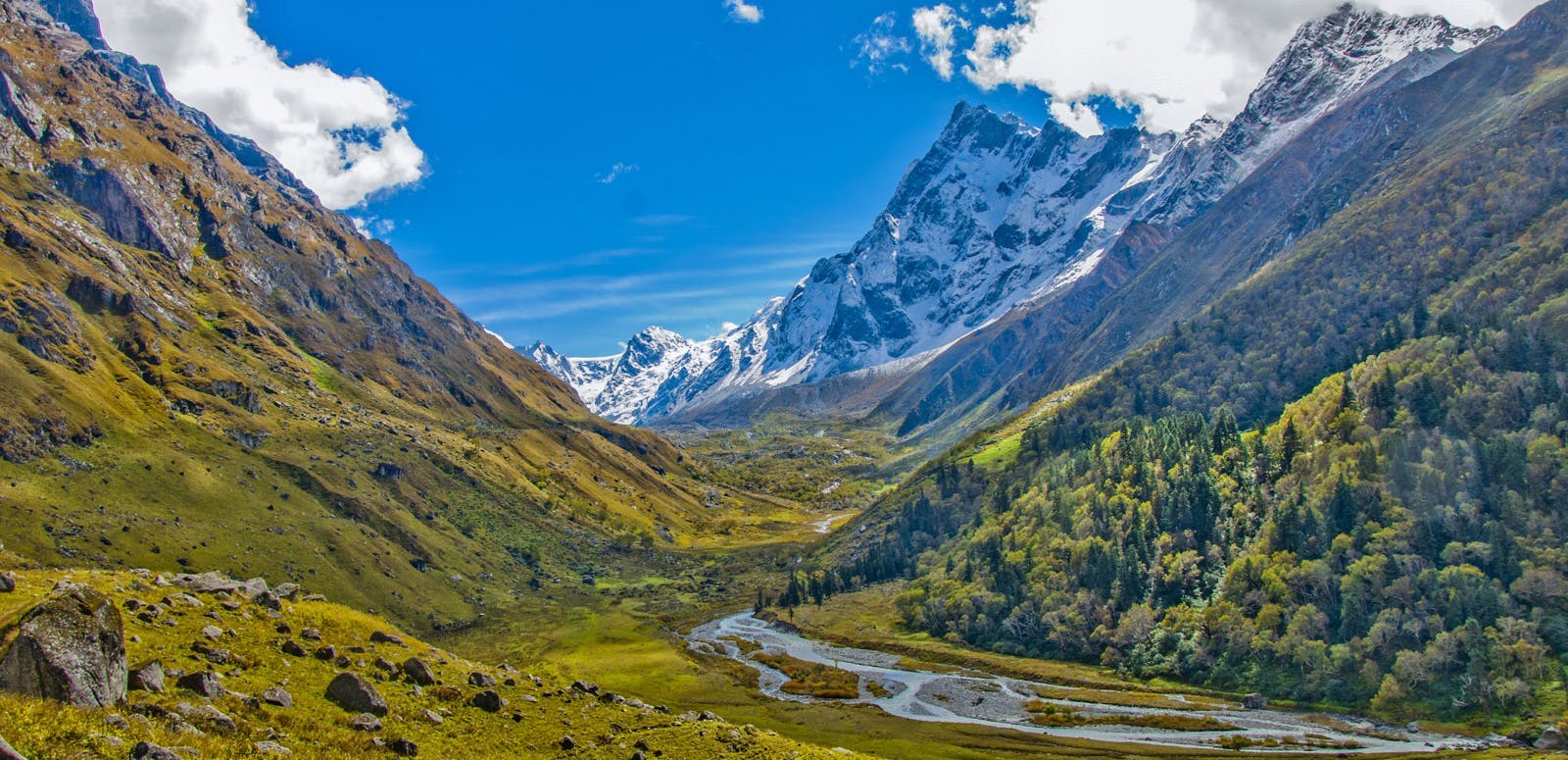
Georgia Atsunta Pass...
The flower bouquet trek of Georgia
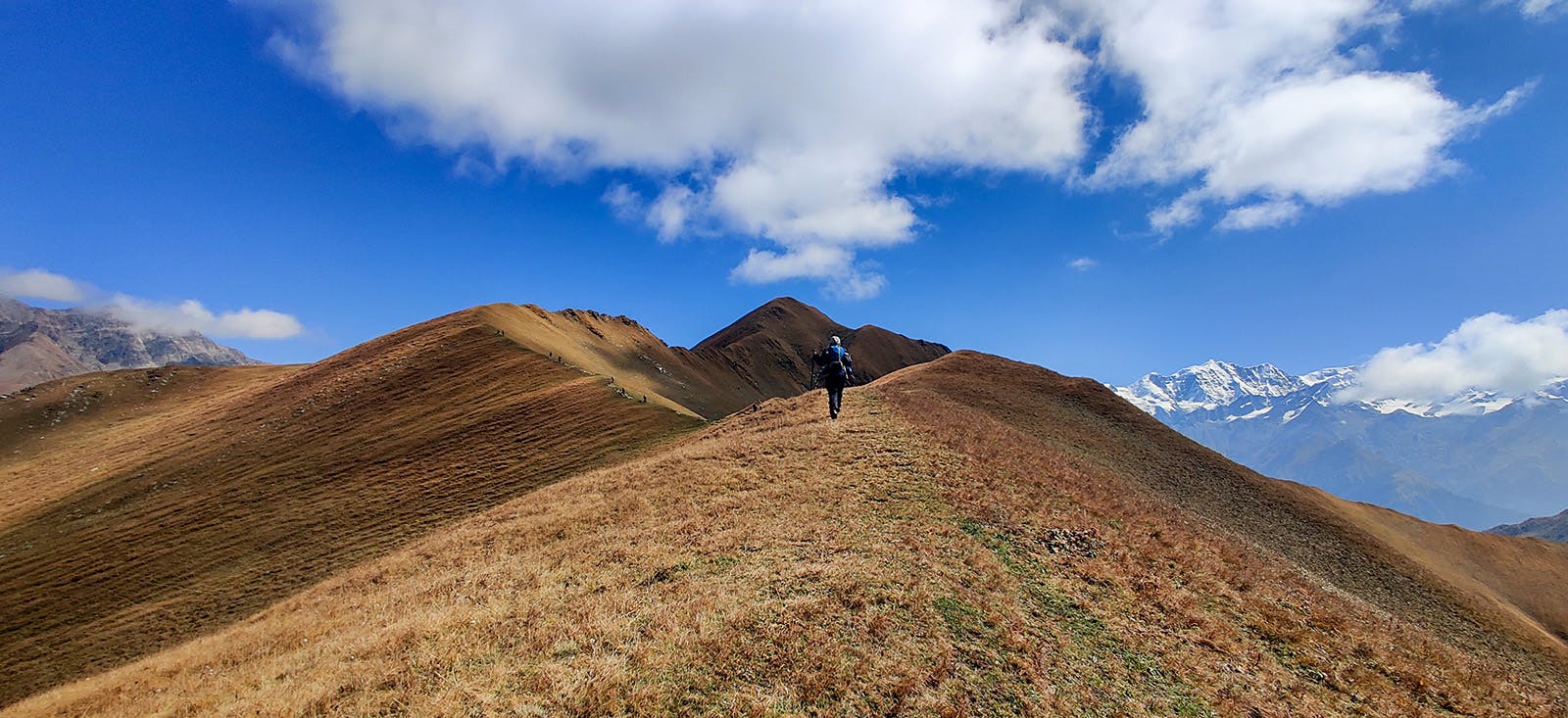
A trek to the grandest meadows in our bouquet

The Best Ridge Trek In India
Sign up for our much loved Weekly Mailer
We have terrific trekking tips, trek updates and trek talks to look forward to
Treks by Categories
Treks by season, treks by month, treks by duration, treks by difficulty.
- Easy - Moderate
Treks by Region
- Uttarakhand
- Himachal Pradesh
- Lahaul and Spiti
- Jammu & Kashmir
- West Bengal
- Chhattisgarh
Treks by Experience
- Family Treks
- Senior Treks
- Adventure Therapy
- Summer Camps
- Youth Camps
- Cancellation policy
- Work with us
- Our sustainability practices
- Privacy Policy
- Terms & Conditions
080 468 01269 Mon to Sat - 9.30 AM to 7.30 PM Sun - 9.30 AM to 6.30 PM
Bengaluru Office
139, Defence Colony Road, Defence Layout, Sahakar Nagar, Bengaluru, Karnataka 560092
Dehradun Office
No.85/10, Neshvilla Road, Dehradun - 248001
© 2024 Indiahikes Private Limited
All images are copyrighted by their respective authors.

Gaumukh Trek: A Journey to the Start of the Ganges
A pilgrim’s complete guide to embarking on the Gaumukh trek to the start of the Ganges River. Includes information on permits, how to get there, what to bring on the trek and where to stay in Gangotri.
Everyone from India knows what the Ganges is- the holy, sacred river of Hinduism that flows horizontally across several of India’s northern states, carrying with it ancient blessings and wisdom.
If you want to see the Ganges, your first thought might be to visit Haridwar, Varanasi or even Rishikesh, as all three are blessed by Ma Ganga’s flow and attract millions of visitors yearly.
And while you might have heard of the Valley of Flowers trek , heading to the source of the holy river might not be on your adventure’s itinerary.
But what about adding Gangotri… and the Gaumukh trek to your Uttarakhand trip ?

Gangotri is a holy village perched well over 11,000 feet above sea level, way up north in the state of Uttarakhand.
The holy Gangotri temple attracts droves of pilgrims of all ages and from all states, as it is considered to be one of the four temples that must be visited in a Hindu’s lifetime.
Gaumukh Trek: The Ultimate Guide

But what is the Gaumukh Trek?
The Gaumukh trek begins in the small town of Gangotri. While Gangotri is a beautiful (and spiritual) place to visit just by itself- it carries with it yet another place- a place surreal to both Hindus and non-Hindus alike.
Located within Gangotri National park, which starts along the outskirts of the village, the Gaumukh Glacier is believed to be the exact start of the Mother Ganga river.
Gaumukh is mostly frozen, yet has parts that are clean enough to drink from without worry- a true gift to any Hindu or non-Hindu alike!
But how to get to this remote, icy place? Read on for all you need to know about embarking on the Gaumukh trek- perhaps one of the holiest journeys in all of India!

The Best Time for the Gaumukh Trek
Due to its high elevation of over 11,000 feet, Gangotri sees extreme cold and snow much of the year. The town and temple, and therefore the trek, only opens to visitors once all the snow has melted, the timing of which can vary each season.
In 2019, after an especially harsh winter, Gangotri opened its doors on May 11 th , though in years past opening day had been in mid-April.

If you’re looking for the best Gangotri/Gaumukh weather, May and June will certainly deliver. But keep in mind that these months also commence Char Dham Yatra, a Hindu Pilgrimage that brings in tens of thousands of tourists.
Keep in mind that May and June also happen to be the peak of domestic mass tourism in general, as most schools are closed and many jobs give leave
We visited in May and while the trek wasn’t too crowded, the sardine feel of the town would have been better avoided.
If you’re looking to see Gangotri at its best, I’d recommend visiting around September-October- the weather should be clear, (perhaps a bit cold) and tourist numbers should be lowered- excellent!
Getting to Gangotri
To reach Gangotri you’ll first have to make your way to a town called Uttarkashi. While we did see some people heading straight to Gangotri from Rishikesh, because of its altitude, it’s best to stop for the night in Uttarkashi (the views there ain’t so bad either!) and then continue on the following morning.

How to get to Uttarkashi
Uttarkashi is a hill station around 4,000 feet above sea level. But how to reach? Your best bet is to take a government bus from Rishikesh’s government bus stand.
Why? Because direct government buses do not run from Haridwar.
As of May 2019, the only option from Haridwar appeared to be a private Volvo at 6am. So, better (and cheaper) to first make it to Rishikesh if possible.
From Rishikesh, government buses to Uttarkashi run every morning starting at 6am.
While no clear schedule was posted, but we were told that the last bus leaves around 11:30 am. Tickets cost 240 rupees each- try to arrive around an hour beforehand if you want a seat, as many people ended up having to stand for the 6-hour journey.
Where to stay in Uttarkashi
Uttarkashi is filled with many a guesthouse or hotel to choose from. We unintentionally visited during the highest of high seasons, and were still able to find a semi-decent room on the spot.
We stayed at Hotel Shiv Dev , where we paid 1000 rupees for a non-AC double.
It’s likely this would be less outside of high season. Most accommodations are located on or adjacent to Mall Road, which is Uttarkashi’s main bazaar- check out a few before deciding.
Click here to see all hotels in Uttarkashi- book ahead in high season!
Where to Eat in Uttarkashi
You definitely won’t go hungry here! Uttarkashi sure loves food, which is obvious from the gazillion shops, restaurants and food stalls all over town. I would definitely recommend the following for cheap, good eats for your stopover:
- TFH- The Food Habit- Looking for western style eats (and eggs!) but on a budget? TFH has your fave comfort foods for extremely affordable prices. Almost everything is under 100 rupees.
- Street food- incredible, cheap, and located right in the center of the main bazaar
- Ashoka Sweets- as a self-proclaimed Lassi fiend this was hands down the best one I’ve ever had. And they have all classic Indian sweets. Score!
- Unnamed Eatery to the left of Hotel Shiv Dev- Serving Biryani, Qorma and Naan for the cheap- this hole in the wall local eatery is filled with flavors from across the border.
How to Get to Gangotri From Uttarkashi
While one bus runs daily at 6am, the best way to get to Gangotri is by shared jeep. Shared jeeps leave starting early in the morning until around 1:30PM. During high season (May-June) a ride cost 230 rupees per person.
While we got lucky space-wise on the way up, jeeps can and will squeeze in way too many people (think 12 when the comfortable capacity is 8!)
Arrive early or wait for another jeep if you don’t want to be squished to death! Keep in mind that while the ride SHOULD take 4 hours, but can take up to 6 pending on traffic and other mountain road delays.
Where to Stay in Gangotri
Gangotri’s main (and only) road is filled with dozens of guesthouses to choose from. But where to stay? In high season, many places are known to overcharge, and booking online isn’t a thing- so check these out when you arrive:
- Hotel Bhagirathi – For 600 rupees, this was the best price we could find in May. Don’t expect luxury (or hot water), but for a night or two this will do!
- GVMN Tourist Resthouse- A government-sponsored guesthouse, GVMN will be a bit nicer than above but expect to pay 1000 rupees during high season
- Hotel Manisha- Close to the entrance of the village, Hotel Manisha is a good pick, but prices can fluctuate. Expect to pay between 800-1000 rupees depending on when you come

What to eat in Gangotri
Gangotri isn’t a foodie spot by any means- its filled with tons of dhaba type restaurants all serving up pretty much the same menu of Indian & Chinese dishes- but there is one that’s definitely worth a stop!
If you’re walking into the down, look for an unnamed hole in the wall style shop with aqua green paint. Always full, the price to quality ratio here is excellent.
Things to do in Gangotri
There’s actually quite a bit to see in Gangotri besides going to Gaumukh- the nature around the town is sweet and deserves to be checked out! Have a day or two to spare? Here’s what to do:
Visit the Gangotri Temple
The Mandir is believed to be one of four Hindu’s must visit if they want to attain Moksha. (eternal life/ end of reincarnation) It sits alongside the Bhagirathi/Ganges River and is no doubt a spiritual experience worth having!

Take a hike to Pondav Cave
This ancient cave also has spiritual significance to Hindus and is home to a specific baba- which we were told changes every 10 years! The path leading to it will hit you with views that are all kinds of epic AND provide some much needed solitude from the bustling town.
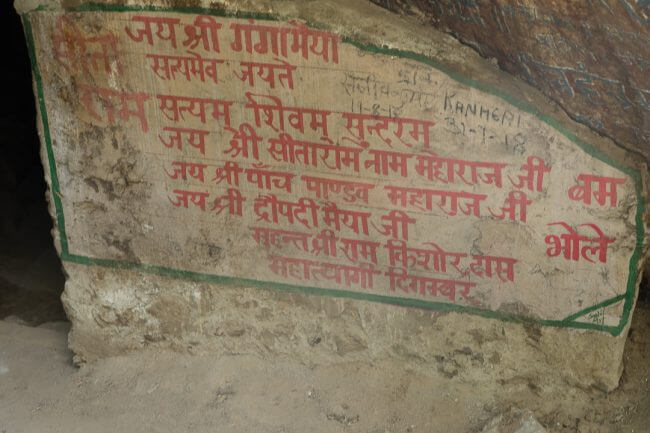
How to Get the Gaumukh Trek Permit
Both Indians and Foreigners alike need to get themselves a permit to enter Gangotri National park before starting the Gaumukh trek, and they can be obtained at the Forestry Department Office.
Keep in mind that only 150 people can be allowed in the park on a given day, so it’s best to get your permit the day before you want to start the trek.
For whatever reason, the office only grants them between the hours of 8:00AM- 10:00AM and 5:00PM-7:00PM , including Sundays.

Permits for the Gaumukh trek cost 150 rupees for Indian Citizens and 600 rupees for foreigners (gotta love dual pricing)— permits are valid for 2 days. If you wish to stay in the park longer, you definitely can, but expect to pay 250 rupee s per day for each one beyond those two.
What to bring on the Gaumukh Trek
This trek ain’t no joke- be sure to bring any of the best hiking gifts you may have received (or bought) with you!
Most guesthouses will allow you to keep your large backpacks with them. I’d definitely recommend doing so as the trek is much easier without added weight—a daypack will do.

When packing, don’t underestimate how cold it can get up there! While the days were quite hot from my experience in late May, nights got bitter cold real quick. Here’s what to bring:
Snacks on snacks on snacks. If you go all the way to Gaumukh it can be hours before you reach the rest stop. Load up before!
Altitude sickness/ breathing medication just in case
Water and something to purify water from rivers/ waterfalls
Warm jacket with a hood
Gloves (only needed at night in May)
Trekking poles
Sleeping bag liner if you have one
Portable charger
Sunscreen (deff learned the hard way on this one)
Gaumukh Trek In’s & Outs
The trek starts just after the Gangotri temple, up a (damned steep) stairwell. Walk for about 1 kilometer before you’ll come to another forest park office, where you’ll be asked to pay a 500 rupee plastic deposit if you’re carrying any.
This actually seems to be working- this trek was surprisingly trash free!

While the trek wasn’t a killer, it certainly wasn’t that easy for the average person. The Gangotri to Gaumukh trek distance is approximately 21 km/ 13 miles.
Though the path is well-marked, slippery rock-leaden footpaths and many a’ incline definitely make a trekking pole useful to have. It’s a major key to have enough water (or a way to make your own with a filter.)

The Gaumukh trek is usually done in 2 days, though it can take longer depending on your plans.
On day one, most people trek to Bhojbasa and stay the night before continuing on to Gaumukh the next morning and headin’ back to Gangotri thereafter.

It is also possible to stop for the night at Chirbasa (located near the snacks dhaba) and then continue on to Bhojbasa on day two, but keep in mind that this will push your time in the park past two days.
Although I had done some pre-trip hiking fitness preparation , the elevation was no joke— it took both of us a bit over 6 hours to reach Bhojbasa from Gangotri with numerous stops along the way.
So if you want to reach your “base camp” safely before dark make sure to leave Gangotri no later than 10 am. The total distance between Gangotri and Bhojbasa is 13 km (8 miles).

The Gaumukh Trek altitude doesn’t play around and you shouldn’t either! Bhojbasa sits at around 3800 m (12,450 feet). I would highly recommend having some altitude sickness medication handy.
Once you reach Bhojbasa, you have two options as far accommodation goes- either the Lal Baba Ashram or GVMN Resthouse . (or your own tent- but remember, it’s damned cold!)
Lal Baba costs 350 rupees per person for a very basic- but warm- room. There aren’t any showers or regular toilets here- but they make up for it by serving delicious free food every morning and evening. Dinner is served at 7 PM , and breakfast at 6:30 AM.

GVMN Resthouse has slightly nicer amenities and costs the same, but only has food for purchase. Your choice!
Note: If you’re not feeling such a long hike in one go, it’s also possible to break for the night (either on the way there, back or both) in Chirbasa which is only about 6.4 km (4 miles) from Gangotri. You can set up your own camp or rent a tent for the night right by the banks of the river.
Day 2 of the Gaumukh trek will be the longest and most challenging, totaling in at around 13 miles. To reach Gangotri by nightfall, make sure you head off from Bhojbasa no later than 6:00 AM.

The trail to Gaumukh starts behind the GVMN guesthouse and is marked on maps.me. Be prepared start out with a challenging (but short) up-hill climb.
The path to Gaumukh should stay to the left of the Bhagirathi River, but this can get challenging due to the amount of boulders. The path to Gaumukh is nowhere near as flat and easy as the rest of the Gaumukh trek is.

It is possible to cross over to the right side of the river, but only in early mornings when the flow is light. We did not attempt this, but have heard that others have.
Note that Gaumukh is around 4.8 km (3 miles) miles from Bhojbasa and can take anywhere from 2-3 hours depending on your level of fitness.
Despite some photos showing it to be white, keep in mind that the Gaumukh glacier itself might be brown or even tan colored.

The way back to Gangotri is exactly the same route you came on, just heading in the opposite direction. Expect the entire journey back to take at least 6 hours.
Gaumukh Trek: Prepare for the Unexpected
After we finally emerged from the mountain’s shadow after an early morning wake up call, and maps.me showed us Gaumukh was finally in our sights – nature showed us an entirely different plan.
Unbeknownst to us, a massive landslide had blocked the way the day prior, completely cutting off Gaumukh from its usual path.

We had scaled a landslide on the way to Malana in Parvati Valley last year, but this one was different. Dangerous, and impossible to pass- our Ganga dreams were crushed.
Was it worth it? Yes thanks to the views, but definitely check the status of things before you head out of Bhojbasa, and even on Day 1 before you even begin the Gaumukh trek.
Read Next: 102 Amazing Indian Street Food Dishes
Leaving Gangotri
Shared jeeps leave every morning for Uttarkashi. You can find them at the beginning of the town, where you were dropped off when you arrived. Jeeps will be stuffed- so try to get a seat in the back row if possible!
In May 2019 a return fare was 230 rupees per person.

From Uttarkashi you can easily find buses going to Rishikesh, Haridwar or even Dehradun. Get to the bus station at least an hour before if you don’t want to be stuck in the back row- or worse, standing!

And so ends the Gaumukh trek pilgrimage! Though challenging, (and disappointing, in our case) the trek was certainly a spiritual one, and definitely worth a go! Be sure to pop in the comments and chime in with your experiences, especially if anything happened to change!
Samantha is the founder of Intentional Detours. Originally from the USA, she’s been backpacking the world since 2017, and is passionate about slow, adventure travel that puts local communities first. She has visited 19 countries and has been living in the Karakoram Mountains of Asia’s Hunza Valley since 2021. She’s super passionate about helping people get off the beaten path anywhere (on a budget of course), and her travel writing has been published in the likes of BBC Travel, CNBC, Business Insider, and more.
Similar Posts

New Delhi Scams: Avoiding Misfortune in India’s Most Chaotic City

15 Things NOT to do on Your Spiti Valley Trip

10 Year Indian Visa for US Citizens: A Step-by-Step Guide With Pictures (2023)

11 Things You Should Know Before Traveling to India

How to Hike to Rakaposhi Base Camp in Pakistan (2024)

Backpacking Parvati Valley: The Ultimate Guide
Leave a reply cancel reply.
Your email address will not be published. Required fields are marked *

Gaumukh Trek
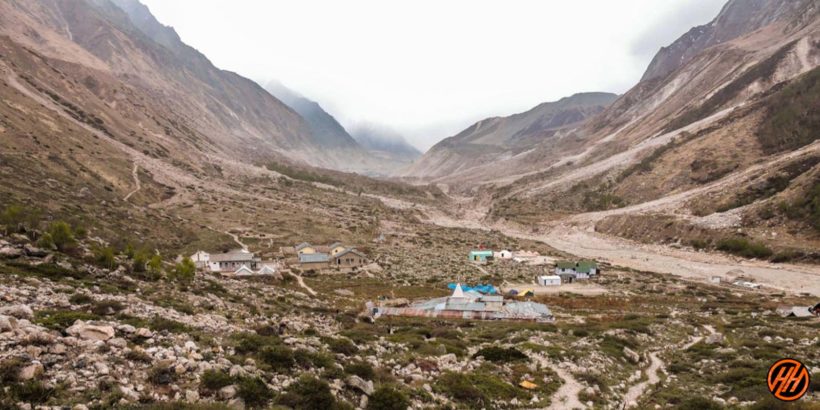
Description
Reviews (0), things to take, available dates, include / exclude, gaumukh trek : a journey to the source of river the holy river ganga in,”gaumukh” refers to the source of the river ganga, uttarakhand, himalayas, .
Gaumukh is a sacred site located in the Uttarkashi district of Uttarakhand, India, in the Garhwal Himalayas. The name “Gaumukh” translates to “cow’s mouth” in Hindi, and it is named so because the shape of the glacier’s terminus resembles the mouth of a cow.
Gaumukh Trek – The Holy River Ganges is the most sacred river in the Hindu religion and its source at Gaumukh at the Gangotri glacier.The glacier follows Westerly route located below Chaukhamba Mountain, the highest peak of the Group.This is the only Ganga valley from where one can see Bhagirathi peak – I, II, III, Shivling Peak and Matri Peak, Raktvan. , all together. One can also see the Tapovan and Nill Tal (4400 mt) peaks from here.
The Gaumukh Trek is one of the most revered and scenic treks in India, leading adventurers to the source of the sacred River Ganga in the Uttarakhand region of the Himalayas. Here’s an overview of what to expect on this incredible journey:
- Location : The trek begins from Gangotri, a small town in Uttarakhand, which serves as the base camp for the trek. Gangotri is easily accessible from major cities like Dehradun and Rishikesh.
- Route : The trek route takes you through breathtaking landscapes, including dense forests, meadows, and rugged terrain. You’ll pass through quaint villages and get glimpses of traditional Himalayan life.
- Scenery : Throughout the trek, you’ll be treated to stunning views of snow-capped peaks, including the towering Bhagirathi sisters. The trail offers panoramic vistas of the surrounding valleys and glaciers.
- Spiritual Significance : The Gaumukh Glacier is considered the source of the River Ganga, which holds immense spiritual significance for Hindus. Many pilgrims undertake this trek as a part of their religious journey to pay homage to the holy river.
- Moderate Terrain : While the trek is not extremely technical, it does involve some challenging sections, including steep ascents and descents, rocky paths, and moraines. It’s essential to be in good physical condition and acclimatize properly to the altitude.
- Duration : The trek usually takes around 06 days from Dehradun to Dehradun to complete, covering a distance of approximately 18-20 kilometers (one way). However, the duration can vary depending on factors like weather conditions and the fitness level of the trekkers.
- Permits and Regulations : Since the trek passes through the Gangotri National Park, trekkers need to obtain permits from the forest department. It’s essential to follow all rules and regulations to ensure the preservation of the fragile ecosystem.
- Best Time to Visit : The ideal time to undertake the Gaumukh Trek is during the summer months, from May to June, and post-monsoon season, from September to October. During these times, the weather is relatively stable, and the trails are accessible.
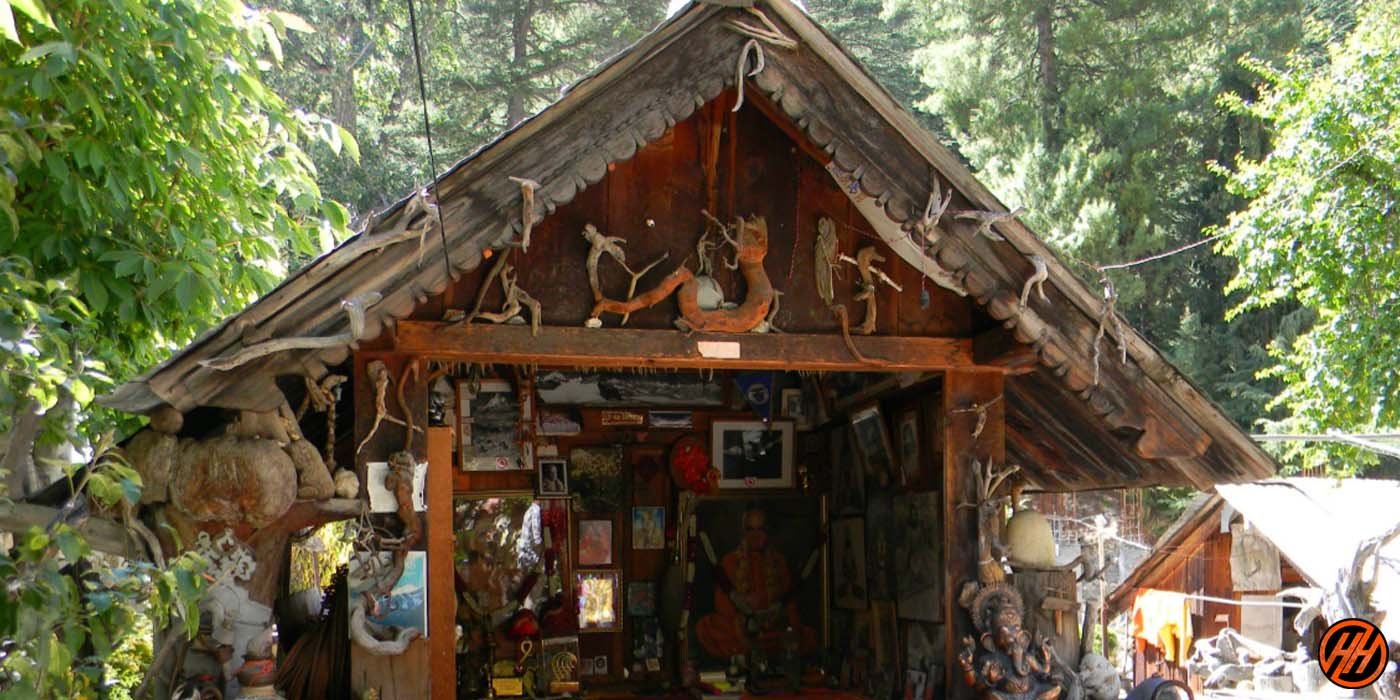
Gangotri – The shrine of Gangotri is situated at an elevation of 3200 m surrounded by Deodars (Cider) and Chir (pine).
Gangotri is indeed a significant pilgrimage site and a beautiful destination situated at an elevation of approximately 3200 meters (10,500 feet) in the Uttarkashi district of Uttarakhand, India. Here are some key points about Gangotri:
- Pilgrimage Destination : Gangotri is one of the Char Dham pilgrimage sites in Hinduism, along with Yamunotri, Kedarnath, and Badrinath. It holds immense religious significance as it is believed to be the place where the River Ganga descended to Earth from heaven.
- Elevation and Surroundings : As you mentioned, Gangotri is surrounded by lush forests primarily consisting of Deodar (Cedar) and Chir (Pine) trees. The pristine surroundings and the lofty Himalayan peaks contribute to the serene and tranquil atmosphere of the region.
- Shrine of Gangotri : The main attraction of Gangotri is the Gangotri Temple, dedicated to Goddess Ganga. The temple is constructed of white granite and is an architectural marvel. It opens every year on the auspicious day of Akshaya Tritiya (usually in April or May) and closes on the day of Diwali (usually in October or November), marking the end of the pilgrimage season.
- Ganga Aarti : One of the highlights of visiting Gangotri is witnessing the mesmerizing Ganga Aarti ceremony performed at the banks of the Bhagirathi River, which originates from the Gangotri Glacier. The aarti is a deeply spiritual ritual where lamps are lit, and prayers are offered to the river.
- Trekking and Adventure : Gangotri serves as the base camp for several treks, including the popular Gaumukh Trek, which leads to the source of the Ganges at the Gaumukh Glacier. Trekkers and adventure enthusiasts flock to Gangotri to explore the surrounding Himalayan terrain and glaciers.
- Natural Beauty : Apart from its religious significance, Gangotri is renowned for its natural beauty. The scenic vistas of snow-capped peaks, gushing rivers, and verdant valleys attract nature lovers and photographers from around the world.
Short Itinerary Gangotri Gaumukh Trek
Day 1- Pickup to you from Dehradun – Drive to Gangotri – 258 km) (0/10 Hours) (3415 Meter) Overnight stay Hotel
Mode of journey – By Tempo Traveller 13+D
Day 2 – Trek from Gangotri to Chirbasa camp (09 km) (5/6 Hours) (3580 Meter ) Overnight stay Camp
Mode of journey – On foot
Day 3 – Trek from Chirbasa camp to Bhojbasa camp (5 km) (3/4 Hours) (3775 Meter ) Overnight stay Camp
Day 4- Trek from Bhojbasa camp to Goumukh Glacier (08 km) (6/7 Hours) then back to Bhojbasa Camp Overnight stay Camp
Day 5- Trek from Bhojbasa camp to Gangotri (14 km) (6/7 Hours) (3415 Meter) Overnight stay Hotel
Day 6– Drive from Gangotri to Dehradun (258 km) (10/ 11 Hours)
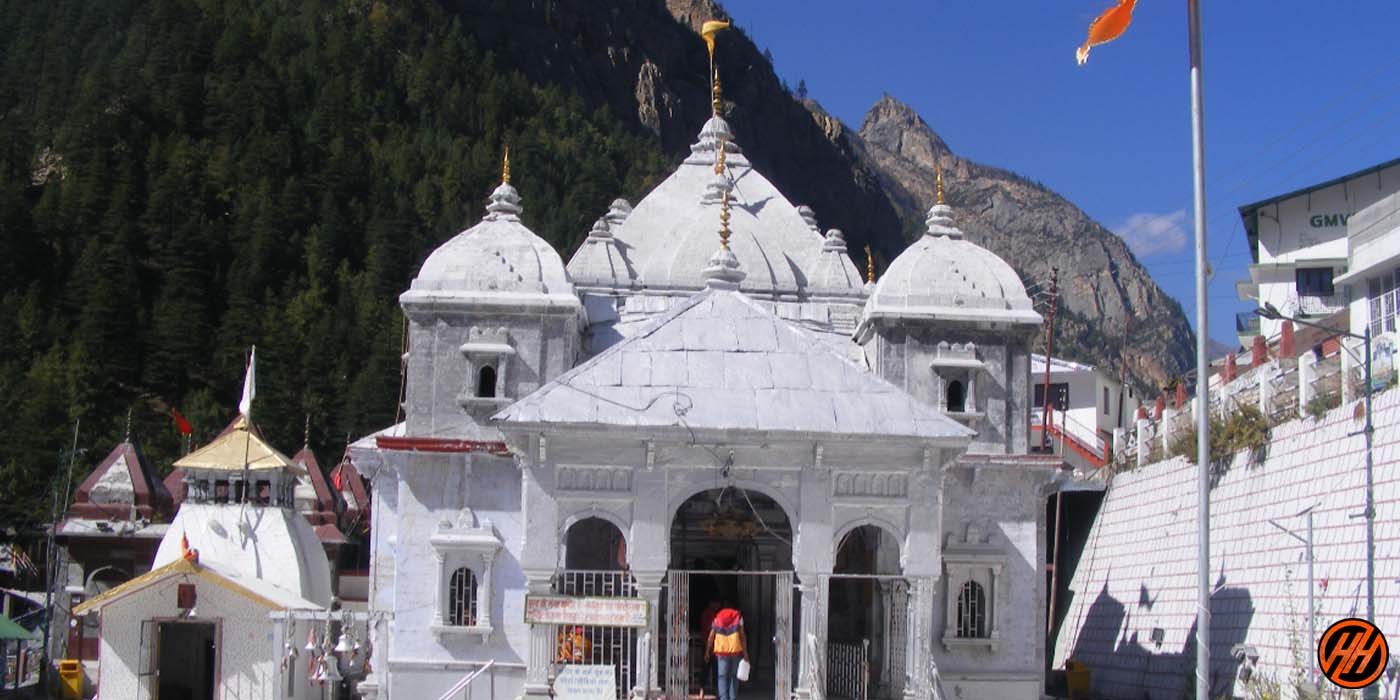
Sun setting on the greater beautiful Mountain range in Gaumukh Trek
Tapovan camp. Which is located on the confluence of the Ganga Valley River at Gangotri right The Holy River Ganges is the most sacred river in the Hindu religion and its source at Gaumukh at the Gangotri glacier.
During the Gaumukh Trek, witnessing the sunset over the majestic peaks of the Himalayas is truly a breathtaking experience. As the sun dips below the horizon, it casts a golden glow over the snow-capped summits, painting the sky in hues of orange, pink, and purple. Here’s a description of what it might be like to watch the sunset on the greater beautiful mountain range during the Gaumukh Trek:
As evening approaches and the sky begins to change colors, trekkers find themselves in awe of the natural spectacle unfolding before them. They may choose a vantage point, perhaps a high ridge or a rocky outcrop, where they can get an unobstructed view of the towering peaks that surround them.
As the sun descends lower in the sky, its warm rays illuminate the rugged contours of the mountains, casting long shadows across the landscape. The glaciers and snowfields glisten in the fading light, creating a magical ambiance that seems to transport observers to another world.
As the minutes pass, the colors intensify, with the sky turning into a canvas of vibrant hues. The jagged peaks stand silhouetted against the fiery backdrop, creating a dramatic contrast between light and dark.
As the last rays of sunlight disappear behind the mountains, the sky slowly transitions from gold to pink to indigo. The stars begin to emerge one by one, casting their twinkling light upon the tranquil landscape below.
For those fortunate enough to witness this spectacle, it’s a moment of pure awe and wonder—a reminder of the beauty and majesty of the natural world. As darkness settles in and the mountains fade into silhouette, trekkers carry the memory of the sunset with them, a cherished moment of serenity amid the rugged grandeur of the Himalayas.
Beautiful Campsite of Gaumukh Trek
During the Gaumukh Trek, there are several beautiful campsites where trekkers can rest and enjoy the stunning Himalayan scenery. One such picturesque campsite is known as Bhojbasa. Here’s why it’s considered a beautiful campsite along the Gaumukh Trek:
- Scenic Location : Bhojbasa is situated at an elevation of around 3,800 meters (12,500 feet) above sea level, offering trekkers breathtaking views of the surrounding Himalayan peaks. The campsite is nestled along the banks of the roaring Bhagirathi River, providing a serene and tranquil setting amidst the rugged wilderness.
- Close Proximity to Gaumukh Glacier : Bhojbasa serves as a midway point between Gangotri and Gaumukh, making it an ideal spot to rest and acclimatize before continuing the trek to the source of the Ganges. From Bhojbasa, trekkers can catch glimpses of the towering peaks and glaciers that lead up to Gaumukh.
- Natural Beauty : The campsite at Bhojbasa is surrounded by pristine alpine meadows dotted with colorful wildflowers during the summer months. The snow-capped peaks of Shivling, Bhagirathi, and Meru form a stunning backdrop, creating a postcard-perfect setting for camping and photography.
- Sunrise and Sunset Views : One of the highlights of camping at Bhojbasa is the opportunity to witness spectacular sunrise and sunset views over the Himalayas. As the first light of dawn illuminates the snow-covered peaks, and the last rays of sunlight paint the sky in hues of orange and pink, trekkers are treated to a mesmerizing display of nature’s beauty.
- Peaceful Atmosphere : Despite its popularity among trekkers, Bhojbasa retains a peaceful and serene atmosphere, allowing visitors to connect with nature and enjoy moments of solitude amidst the majestic mountains.
Best Time to visit Gaumukh Trek ?
The best time to visit the Gaumukh Trek depends on your preferences and what you aim to experience during your journey. However, there are a few key factors to consider when planning your trip:
- Weather : The weather in the Himalayas can be quite unpredictable, with harsh winters and monsoon rains making certain times of the year less favorable for trekking. The best time to visit Gaumukh Trek is typically during the summer months (May to June) and post-monsoon season (September to October). During these times, the weather is relatively stable, with clear skies and pleasant temperatures, making trekking more enjoyable and offering better views of the surrounding landscape.
- Accessibility : Gaumukh Trek involves traversing rugged terrain and crossing glacial streams, which can be challenging during the winter months when certain sections of the trail may be covered in snow or ice. Therefore, the trek is usually closed during the winter season (November to April) due to heavy snowfall and the risk of avalanches. It’s essential to check the current trail conditions and accessibility before planning your visit.
- Crowds : The summer months, especially May and June, tend to be the busiest times for trekking in the Himalayas, including Gaumukh Trek, as the weather is favorable and many people plan their trips during this time. If you prefer fewer crowds and quieter trails, consider visiting during the post-monsoon season in September and October when the weather is still pleasant, but the number of trekkers is relatively lower.
- Flora and Fauna : Another factor to consider is the opportunity to witness the rich biodiversity of the region. Spring (April to June) brings blooming rhododendrons and other wildflowers, while autumn (September to October) offers vibrant foliage colors as the leaves change. Wildlife sightings are also more common during these seasons, adding to the overall experience of the trek.
Ultimately, the best time to visit Gaumukh Trek is during the summer and post-monsoon months (May to June and September to October) when the weather is favorable, the trails are accessible, and you can fully appreciate the beauty of the Himalayas. However, it’s essential to plan and prepare accordingly, taking into account factors like weather conditions, trail accessibility, and personal preferences.
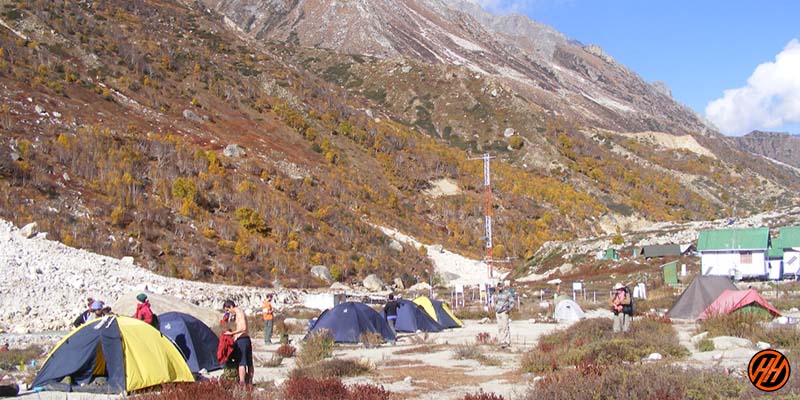
How Difficult is Gaumukh trek
The difficulty level of the Gaumukh Trek can vary depending on various factors such as altitude, terrain, weather conditions, and individual fitness levels. Here’s an overview of the difficulty level and altitude of key points along the Gaumukh Trek, including Chirbasa and Bhojbasa:
- Chirbasa : Chirbasa is the first campsite along the Gaumukh Trek, located at an altitude of approximately 3,550 meters (11,647 feet) above sea level. The trek from Gangotri to Chirbasa is relatively moderate, covering a distance of around 9 kilometers (approximately 5.6 miles). The trail gradually ascends through lush forests of pine and deodar trees, with occasional steep sections. Trekkers may experience a moderate level of difficulty due to the altitude gain, but it’s generally manageable for most people with proper acclimatization.
- Bhojbasa : Bhojbasa is the second campsite along the Gaumukh Trek, situated at an altitude of approximately 3,800 meters (12,500 feet) above sea level. The trek from Chirbasa to Bhojbasa is relatively short, covering a distance of around 5 kilometers (approximately 3.1 miles). However, the altitude gain and terrain become more challenging as trekkers ascend higher into the Himalayas. The trail follows the banks of the Bhagirathi River, with rocky terrain and occasional moraines. Trekkers may experience a moderate to strenuous level of difficulty due to the altitude and terrain, especially if they haven’t acclimatized properly.
Gaumukh trek safe for beginner trekkers ?
The Gaumukh Trek can be suitable for individuals within a wide age range, including children as young as 10 years old and adults up to the age of 60 and above, provided they are in good health, have a reasonable level of fitness, and take necessary precautions. Here’s some information about the safety considerations, route, and location of the Gaumukh Trek:
- Health and Fitness: It’s essential for all trekkers, regardless of age, to be in good health and have a reasonable level of fitness to undertake the Gaumukh Trek. The trek involves walking for several days at high altitudes, which can be physically demanding.
- Altitude Acclimatization: Proper acclimatization is crucial, especially for older adults and children, to prevent altitude-related illnesses such as altitude sickness. It’s recommended to ascend gradually, stay hydrated, and listen to your body’s signals.
- Weather Conditions: Weather in the Himalayas can be unpredictable, with sudden changes in temperature and the possibility of rain or snow. It’s essential to pack appropriate clothing and gear for varying weather conditions.
- Medical Considerations: Trekkers of all ages should consult with a healthcare professional before undertaking the trek, especially those with pre-existing medical conditions. It’s advisable to carry necessary medications and a basic first-aid kit.
- Starting Point: The Gaumukh Trek typically starts from Gangotri, a small town in Uttarakhand, India. Gangotri is accessible by road from major cities like Dehradun and Rishikesh.
- Trekking Route: From Gangotri, trekkers follow a well-defined trail that passes through scenic landscapes, including forests, meadows, and glacial moraines. The route takes trekkers to key waypoints such as Chirbasa, Bhojbasa, and ultimately Gaumukh, the source of the River Ganga.
- Duration: The trek usually takes around 6-7 days to complete, covering a distance of approximately 18-20 kilometers (one way). However, the duration can vary depending on factors like weather conditions, acclimatization, and the pace of the trekking group.
We are Per Day Climb Altitude for Gaumukh Trek
Note: – Level: The trek experience and moderate Gaumukh & Tapovan, Nandanvan Trek is classified Trek .We are going about. In altitude per day.
Gangotri -10,145 feet
Chirbasa camp – 11,761 feet
Bhojbasa camp – 12,450 feet
Gaumukh – 13,200 feet
Key Points of Gaumukh Trek
Duration: – 06 Days 5 Nights from Dehradun to Dehradun
Best Season : – April, May, June, September, October,
Level: – The trek experience, Moderate,
Trail of type : – Trek Start. Dehradun is the beautiful city near rail head and base camp .Gangotri base camp
Highest Points : – 13,215 feet
Trekking distance – 36 km.)
Gaumukh Trek Route Location: –Dehradun, Gangotri, Chirbasa, Bhojbasa, Gaumukh Glacier
It is located in the northeastern part of Uttarakhand starting from close to the Chaina border, heading east and then south
Started point: – Pick up to you Dehradun, .Railway Station and (I.S.B.T)
- You got to see so many heavenly bodies at one place like the panoramic view of the Himalayan ranges, you can see pine forests, different variety of flora and fauna surpassing through bona fide Garhwali culture.
- I think Do spare time in Interaction with our local’s team, and you will get to know about some of the ancient tales of Indian mythology and our local cultures, this is good ideas for trekkers
How to reach dehradun for Gaumukh trek ?
- Dehradun has its own airport called the Jolly Grant Airport (DED), which is located approximately 30 kilometers east of the city center.
- You can book a flight to Dehradun from major cities like Delhi, Mumbai, Bangalore, and Kolkata.
- From the airport, you can hire a taxi or use pre-paid taxi services to reach Dehradun city center or directly to Gangotri, the starting point of the Gaumukh Trek.
- Dehradun is well-connected by rail to various cities across India. The Dehradun Railway Station (DDN) is located in the city center.
- You can book train tickets to Dehradun from major cities like Delhi, Mumbai, Kolkata, Chennai, and Bangalore.
- From the railway station, you can hire a taxi or use public transportation to reach your accommodation in Dehradun or directly to Gangotri for the Gaumukh Trek.
- Dehradun is well-connected by road to major cities and towns in North India. You can either drive your own vehicle or use bus services.
- Several state-run and private buses operate from cities like Delhi, Chandigarh, Haridwar, and Rishikesh to Dehradun.
- If you’re traveling from Delhi, you can take a bus from the Inter-State Bus Terminal (ISBT) in Delhi to reach Dehradun.
- From Dehradun, you can hire a taxi or use public transportation to reach Gangotri, the starting point of the Gaumukh Trek. The journey from Dehradun to Gangotri takes approximately 10-12 hours by road.
For Himalayan Hikers or trekkers, it’s crucial to have some emergency medical support available, given the remote and rugged terrain they often traverse. Here are some essential medical supplies to consider carrying:
- First Aid Kit : Include bandages, antiseptic wipes, adhesive tape, gauze pads, scissors, tweezers, and a CPR mask.
- Oxygen cylinder- Oxygen can be beneficial in alleviating symptoms of altitude sickness, such as headache, dizziness, nausea, and shortness of breath. Administering oxygen can provide relief and help prevent the condition from worsening.
- Personal Medications : Any prescribed medications should be carried in sufficient quantities.
- Pain Relief : Ibuprofen or acetaminophen for pain relief in case of minor injuries or headaches.
- Antihistamines : For allergic reactions and insect bites.
- Anti-diarrheal Medication : Such as loperamide, in case of gastrointestinal issues.
- Water Purification Tablets : In areas where clean water may not be readily available.
- Blister Treatment : Moleskin or blister pads for foot care.
- Tweezers : For removing splinters or ticks.
- Emergency Blanket : To keep warm in case of exposure.
- Whistle and Signal Mirror : For attracting attention in emergencies.
- Flashlight or Headlamp : Essential for navigating in the dark or signaling for help.
- Emergency Communication Device : Such as a satellite phone, PLB (Personal Locator Beacon), or a two-way radio for calling for help if needed.
- Basic Wilderness First Aid Guide : To assist in treating common injuries or illnesses.
- Sun Protection : Sunscreen, sunglasses, and a wide-brimmed hat to protect against sunburn.
- Emergency Shelter : Lightweight emergency shelter or tarp for protection from the elements.
It’s also essential for hikers to have basic knowledge of first aid and wilderness survival skills. Additionally, informing someone of your hiking plans and expected return time can be crucial in case of emergencies. Always be prepared and stay safe while exploring the beautiful but challenging Himalayan terrain.
Himalayan Hikers – Provided food During the Gangotri Gaumukh Trek
– We serve five -05 times meals a day including- Breakfast, Lunch, Eevening Snakes, Soup, Dinner, A variety of delectable and healthy food is provided which includes; Indian, Chinese and other Western meals. They are nutritious and keep you fit and healthy on the trek.(Veg food) With our local food and Day Pack, for Summit Day like fresh fruits
Food Menu – Roti + Rice + Salad + Papad +Matter paneer +Daal +mix veg+ daily more vegetable +sweet+ Bread +Nutella + jam + butter +Muesli, Milk+Banana+ Allo parantha +Tea & coffee Cornflakes, Milk +Bread, Peanut Butter +Pancake +Plain parantha +Fruits+ Porridge Oats+ +Bread & cheese +Poha + Gulab Jamun+ Custard+ Jalebi+ Chilla +Honey+ Puri + Chole more
Note: – This is only list Himalayan Hikers Team or Cook provide you more healthy food and more items of per day menu
The type of food provided during a trek can vary depending on factors like the location, duration, and the trekking company or organization you’re with. However, there are some common types of food that are often included in trekking provisions:
- Carbohydrates : Foods high in carbohydrates provide energy for the trek. This includes items like rice, pasta, bread, and potatoes. More
- Proteins : Protein-rich foods help with muscle repair and recovery. Common protein sources include lentils, beans, tofu, meat (if available), eggs, and dairy products.
- Fruits and vegetables : These provide essential vitamins, minerals, and fiber. While fresh produce may not always be available, dried fruits and vegetables or canned options might be included.
- Snacks : Trekking often involves long hours of physical exertion, so snacks are important for quick energy boosts. Snacks like nuts, energy bars, trail mix, and chocolate are common choices.
- Local cuisine: Depending on the region you’re trekking in, you might also get the chance to sample local dishes. This can be a delightful way to experience the culture and flavors of the area.
Day 1: Pickup to you from Dehradun Railway Station – Drive to Gangotri overnight stay Hotel
Traveling from Dehradun Railway Station to Gangotri via Mussoorie, here’s a suggested route along with key locations:
- Dehradun Railway Station : Your journey starts at Dehradun Railway Station, which is located in the heart of the city.
- Drive through Dehradun to Mussoorie : From Dehradun Railway Station, you’ll head towards Mussoorie, a popular hill station in Uttarakhand. You’ll drive through the city of Dehradun, passing by landmarks such as Clock Tower and Rajpur Road before ascending towards Mussoorie.
- Mussoorie : You’ll reach Mussoorie, suwakholi , dhanolti route known for its scenic beauty and colonial charm. Take some time to explore Mussoorie’s suwakholi mountain range
- Drive from Mussoorie to Gangotri : After exploring Mussoorie, you’ll continue your journey towards Gangotri. The route from Mussoorie to Gangotri takes you through picturesque mountain roads, offering breathtaking views of the Himalayas and the surrounding valleys.
- Uttarkashi : En route to Gangotri, you’ll pass through the town of Uttarkashi, which serves as a major stopover for travelers heading to Gangotri. Uttarkashi is known for its temples, including the Vishwanath Temple and Shakti Temple.
- Gangotri : Finally, you’ll arrive at Gangotri, the holy town nestled in the Garhwal Himalayas. Gangotri is famous for its temple dedicated to Goddess Ganga and serves as the base camp for the Gaumukh Trek. You’ll check into your hotel in Gangotri for an overnight stay.
Please note that the journey from Dehradun to Gangotri via Mussoorie is approximately 270 kilometers and takes around 9//10 hours by road, depending on road conditions and traffic. It’s advisable to start early in the day to ensure you reach Gangotri before nightfall. Additionally, make sure to check weather conditions and road closures before embarking on your journey, especially during the monsoon and winter seasons.
Day 2: Trek from Gangotri to Chirbasa (11,761 feet); 6 hours, 9 km – overnight stay Camp
Day 2 of the Gaumukh Trek, you’ll be trekking from Gangotri to Chirbasa, covering a distance of approximately 9 kilometers. Here’s a detailed itinerary of the trekking route and what you can expect along the way:
- Your trek begins from Gangotri, a sacred town in the Uttarkashi district of Uttarakhand, which serves as the gateway to the Gaumukh Trek.
- Gangotri is known for its revered Gangotri Temple, dedicated to Goddess Ganga, and its stunning views of the surrounding Himalayan peaks.
- The trail from Gangotri to Chirbasa follows the banks of the Bhagirathi River, offering picturesque views of the river and the surrounding mountains.
- The trek starts with a gradual ascent through forests of pine and deodar trees, with occasional steep sections.
- As you gain altitude, you’ll pass through scenic meadows and rocky terrain, with views of the snow-capped peaks in the distance.
- Along the way, you may encounter small streams, waterfalls, and wildlife such as Himalayan birds and mountain goats.
- About halfway through the trek, you’ll come across a view check post where trekkers are required to register their details with the forest department.
- The view check post also serves as a resting point where you can take a break, enjoy the scenery, and refuel with snacks and water.
- Chirbasa is the campsite where you’ll be spending the night.
- The name “Chirbasa” translates to “birch forest,” and the campsite is surrounded by birch trees and alpine meadows.
- Chirbasa offers stunning views of the Bhagirathi peaks and is an excellent spot for stargazing on clear nights.
- The trek from Gangotri to Chirbasa is considered to be of moderate difficulty level.
- While the distance is not too long, the altitude gain and uneven terrain can make it challenging for some trekkers.
- It’s essential to pace yourself, stay hydrated, and take breaks as needed to acclimatize to the altitude.
Day 3: Trek from Chirbasa to Bhojbasa (12,761 fit); 3 hours, 5 km. overnight stay Camp
Day 3 of the Gaumukh Trek, you’ll be trekking from Chirbasa to Bhojbasa, covering a distance of approximately 5 kilometers. Here’s a detailed itinerary of the trekking route and what you can expect along the way:
- Your trek begins from Chirbasa, the campsite where you spent the previous night.
- Chirbasa is known for its scenic beauty, with views of the surrounding Himalayan peaks and alpine meadows.
- The trail from Chirbasa to Bhojbasa continues along the banks of the Bhagirathi River, gradually gaining altitude.
- The trek offers stunning views of the Bhagirathi peaks and the surrounding glaciers as you ascend higher into the Himalayas.
- The terrain consists of rocky paths, moraines, and occasional streams, with sparse vegetation at higher altitudes.
- The trek from Chirbasa to Bhojbasa is relatively short, covering a distance of approximately 5 kilometers.
- It typically takes around 3 hours to complete the trek, depending on the pace of the trekking group and trail conditions.
- Bhojbasa is the campsite where you’ll be spending the night.
- The campsite is located in a picturesque setting, surrounded by alpine meadows and with panoramic views of the Bhagirathi peaks.
- Bhojbasa serves as a midway point on the Gaumukh Trek and offers a peaceful atmosphere for trekkers to rest and acclimatize before continuing their journey.
- The trek from Chirbasa to Bhojbasa is considered to be of moderate difficulty level.
- While the distance is relatively short, the altitude gain and terrain can make it challenging for some trekkers.
- However, the trek offers breathtaking views of the Himalayan landscape, making it a rewarding experience for those who undertake it.
Day 4: Trek from – Bhojbasa to Gomukh .Glacier 04 km (2 hours) back to camp after take bath and come back Bhojbasa Camp overnight stay at Camp
Trekking from Bhojbasa to Gaumukh Glacier is one of the highlights of the Gaumukh Trek, offering trekkers the chance to witness the source of the sacred River Ganga. Here’s a detailed itinerary of the trekking route and what you can expect along the way:
- Your trek begins from Bhojbasa, the campsite where you spent the previous night.
- Bhojbasa offers panoramic views of the surrounding Himalayan peaks and serves as a midway point on the Gaumukh Trek.
- The trail from Bhojbasa to Gaumukh follows a well-defined path along the banks of the Bhagirathi River.
- The trek involves ascending gradually through rocky terrain and glacial moraines as you approach the Gaumukh Glacier.
- Along the way, you’ll pass through alpine meadows and may encounter wildlife such as Himalayan birds and mountain goats.
- The total distance from Bhojbasa to Gaumukh is approximately 4 kilometers, and it typically takes around 2 hours to reach Gaumukh, depending on the pace of the trekking group and trail conditions.
- Gaumukh, also known as Gomukh, is the terminus of the Gangotri Glacier and the source of the River Ganga.
- The name “Gaumukh” translates to “cow’s mouth” in Hindi, as the shape of the glacier’s terminus resembles the mouth of a cow.
- Gaumukh is a sacred site for Hindus and holds immense religious significance, attracting pilgrims and trekkers from around the world.
- The glacier itself is a vast expanse of ice and snow, with stunning views of the surrounding Himalayan peaks.
- Upon reaching Gaumukh, you’ll have time to explore the area, take photographs, and soak in the breathtaking scenery.
- After exploring Gaumukh and soaking in its beauty, you’ll trek back to Bhojbasa, retracing your steps along the same trail.
- The trek from Bhojbasa to Gaumukh is considered to be of moderate level.
- However, the trek offers breathtaking views of the Bhagirathi peaks, the glacier, and the surrounding Himalayan landscape, making it a rewarding experience for those who undertake it.
Day 5: Trek from Bhojbasa camp to Gangotri (10,145 feet); 7/8 hours, 14 km overnight stay Hotel at Gangotri
Trekking from Bhojbasa camp to Gangotri marks the final leg of the Gaumukh Trek, offering trekkers a chance to reflect on their journey through the stunning Himalayan landscape. Here’s a detailed itinerary of the trekking route and what you can expect along the way:
- Your trek begins from the campsite at Bhojbasa, where you spent the previous night.
- Bhojbasa offers panoramic views of the surrounding mountains and serves as a tranquil resting place for trekkers.
- The trail from Bhojbasa to Gangotri retraces your steps along the same route you took on your way to Gaumukh Glacier.
- You’ll descend gradually through rocky terrain and glacial moraines, following the path along the banks of the Bhagirathi River.
- The trek involves navigating through alpine meadows and forests of pine and deodar trees as you make your way back towards Gangotri.
- The total distance from Bhojbasa to Gangotri is approximately 14 kilometers, and it typically takes around 6 to 7 hours to complete the trek, depending on the pace of the trekking group and trail conditions.
- Upon reaching Gangotri, you’ll be greeted by the familiar sights of the sacred town nestled in the Garhwal Himalayas.
- Gangotri is known for its revered Gangotri Temple, dedicated to Goddess Ganga, and serves as the starting point of the Gaumukh Trek.
- After completing the trek, you’ll check into your hotel in Gangotri for an overnight stay, where you can rest and relax after your journey.
- The trek from Bhojbasa to Gangotri involves a significant descent in altitude, which can be taxing on the knees and joints.
- While the distance is longer than previous days, the descent makes it slightly easier in terms of physical exertion.
- However, trekking downhill can be modarate for some trekkers, so it’s essential to pace yourself and take breaks as needed.
Day 6: Depart for Same way Dehradun. You will reach Dehradun between 7.00 pm.
departing from Gangotri and heading back to Dehradun, here’s an approximate itinerary for your return journey:
- Start your day early in Gangotri and have breakfast at your hotel or a local eatery.
- Take some time to explore Gangotri and visit the Gangotri Temple if you haven’t already done so.
- Pack your belongings and check out from your hotel, ensuring you have everything you need for the journey back to Dehradun.
- Leave Gangotri by road early in the morning to allow ample time for the journey back to Dehradun.
- The drive from Gangotri to Dehradun takes approximately 10-12 hours, covering a distance of around 270 kilometers.
- The road from Gangotri to Dehradun passes through picturesque landscapes, including mountain valleys, rivers, and forests.
- Plan for occasional rest stops and meal breaks along the route to stretch your legs and refuel.
- You may consider stopping in Uttarkashi or other towns along the way for lunch or snacks.
- Depending on road conditions and traffic, you should aim to reach Dehradun between 7:00 pm to 8:00 pm in the evening.
- Once you arrive in Dehradun, check into your accommodation for the night and relax after a long day of travel.
- You can explore Dehradun in the evening, enjoy a delicious dinner at a local restaurant, or simply unwind and rest after your journey.
Mandatory Documents
Please carry the documents given below.
Original and photocopy of government photo identity card- (Aadhar Card, Driving License, Voters ID, etc, Passport and Visa important to foreigners Medical Certificate (First part should be filled by the Doctor and Second part by the Trekker) Declaration Certificates
Note: – Many trekkers commit the same mistake of carrying unnecessary items on a trek which only makes the backpack heavy. It is important to know the right items to carry. It differs from season to season if you are trekking in summers then carry less layers of warm clothing and if you are trekking in winters carry enough layers to protect yourself against chilly cold.
Necessary Items for trekkers

Backpack (50 to 60 liters) A strongly built backpack with good support is compulsory for a trek. (Rain cover is important)
Sturdy Trekking Shoes The shoes should be strong enough with good support. The people ask if sports shoes would be comfortable but it is good to bring the right trekking shoes.
The Clothes You Should Bring On a Trek Avoid keeping extra clothes because it only makes you backpack heavy.
Trek Pants – The jeans are never suitable for a trek so you need at least 2-3 trek pants for treks carry more for longer treks.
Jacket – Jackets are very important to carry on a trek it protects you against the chilly weather. So carry 2 jackets on a week long trek.
Layers of warm Clothing Carry warm woolen layers or fleece. Carry more layers during winter season (at least 2 to 3) and less during summer.
Thermals – The Temperature decreases at night so you might be need thermals for Night.
T- Shirts – Bring those t shirts which dry fast.
Poncho –They are needed if you are trekking on a Rainy day to keep you dry.
Hiking Pole
Water Bottle 2
Cap or Balaclava
Woolen and Waterproof Gloves
Socks (Woolen and Regular)
Torch head light
Personal Toiletry Items – (toothpaste, toothbrush, toilet paper, sanitizer etc.)
Carry Personal Medical Kit
Personal Medical Kit (Carry minimum 5 tablets and maximum 10)

Diamox – (Prevents altitude sickness)
Digene – (It cures discomfort in stomach, acidity)
Crocin Advance – (Cures fever and headache)
Aspirin/Combiflam – (Pain reliever)
Disprin – (Cures headache)
Avomine – (Prevents motion sickness)
Avil – (It treat allergies)
Norflox TZ & Lomofen – (Prevents Diarrhoea)
Ranitidine – (Reduces the amount of acid in stomach)
Volini/Moov spray – (For sprains)
Betadine/Savlon – (Antiseptic cream)
Stretchable/Elastic bandage
Note:- Use medicines only when prescribed by the doctor. In case you face any problem during your trek, discuss and take advice from the Professional guide.
Sorry! Here are no Available dates right now. For Any Queries you can Email us with [email protected] and Call Us +91 9756197558
What is Included In This Trek?
Transport from Dehradun to Dehradun Taxi or Tempo Travellers 13+D
Forest Permit and entrance fee
Accommodation in tents /Hotel on twin share basis
All meals: Breakfast, Lunch, Tea, Coffee, Snacks, Soup and Dinner
High quality Dome tents
Sleeping bags
Separate Toilet tents – Ladies and Gents
Dining Tent
Dining Table
Kitchen team
Radio Walkie Talkie for Communication
Good Experience Trek Leader guide and Technical guide
Medical Kit
Oxygen Cylinders
Crampons and Gaiters
What is Not Include In This Trek?
Personal Insurance
Medical Certificate
Personal toiletry Items and Personal Medicine kit
On first day En Route to base camp the Breakfast and Lunch are Not Included
Last Day En Route Lunch and Dinner are Not Included
Personal Porters
There are no reviews yet.
Your email address will not be published. Required fields are marked *
Name *
Email *
Save my name, email, and website in this browser for the next time I comment.
Related Tours
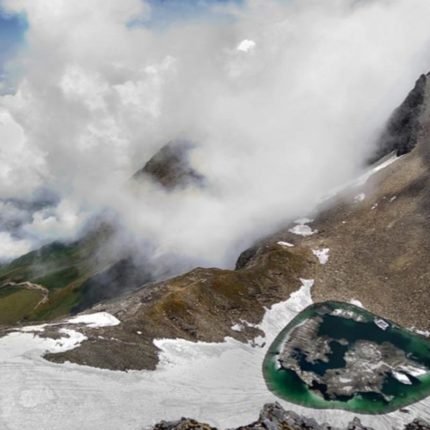
Roopkund Trek
Roopkund trek is the most popular trek in all over India
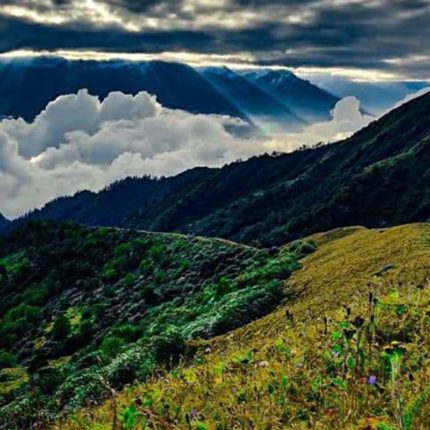
Gidara Bugyal Trek
Gidara Bugyal Trek The Secret Meadow in the Himalayas
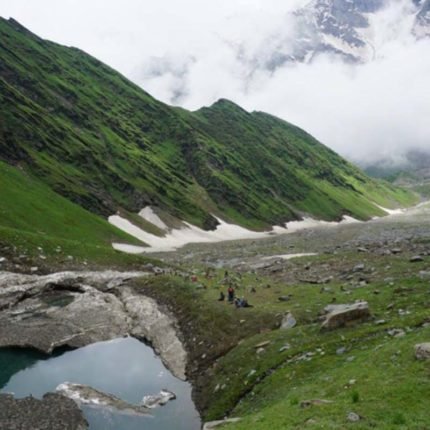
Beas Kund Trek
KUND BEAS TREK ALPINE LAKE IN HIMACHAL
Price: ₹ 18,000.00
Book the tour
Send a quick enquiry.
- Overview Itinerary Dates Include/Exclude
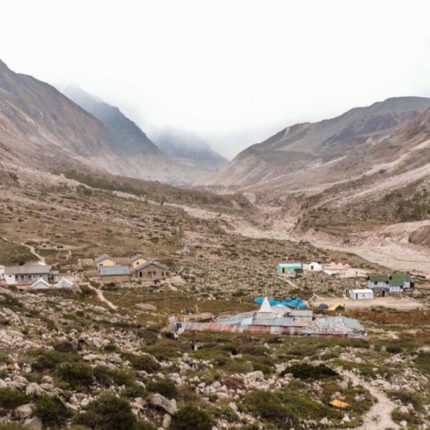
.webp)
Gaumukh Tapovan Trek
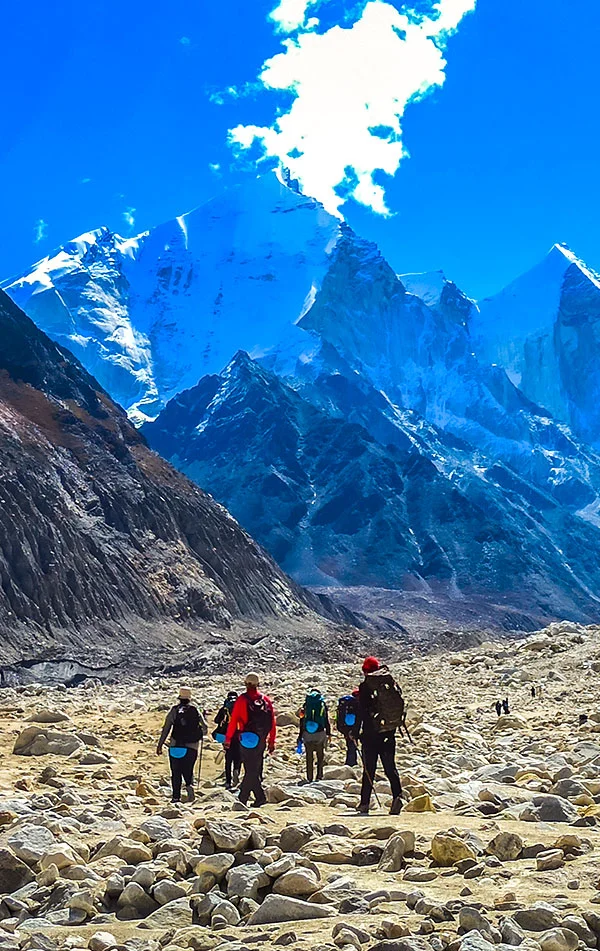
Uttarakhand |
Uttarakhand | India
Max Altitude
Trekking Km
Moderate to Difficult
Help & Support
16400 /person $ /person.
- September-2024
- October-2024
- +5% GST (goods and services tax)
- Services Gangotri to Gangotri
Insurance 280
Insurance is Mandatory.
Non-Indian rates are slightly higher. Trek coordinator will provide balance payment link post-booking.
- Get insurance through us or elsewhere. If not through us, email for a refund after booking.
Cancellation 4 or more days before the start of the trip results in a 100% cash refund.
Cancellation less than 4 days from the start of the trip results in no refund.
Transport 2500
Transportation Rishikesh to Gangotri & retun is optional
Choose add-ons during booking. If missed, log in and add them later
Book transportation at least 10 days before the trek.
Cancellation less than 4 days from the start of the trip results in a 50% cash refund.
Cancellation after the trip date does not qualify for a refund.
Offload 2100
Backpack offload is optional
Choose add-ons during booking. If missed, log in and add them later.
Book off-load at least 10 days before the trek.
For offline bookings at the base camp, a convenience fee of Rs. 2900 applies.
Cancellations made before the trip date will receive a full refund.
For more information. Please complete this form.
Help & Support
Trek Name: Gaumukh Tapovan Trek
Adventure Type: Trekking
Base Camp: Gangotri
Season: Summer | Autumn |
Month: May | June | September | October |
Country: India
Altitude: 14600 Ft.
Grade: Moderate to Difficult
Rail Head: Dehradun
Stay: Camping (Twin sharing) & Hotel/Guesthouse : triple, quad, dormitory (separate for male and female)
Food: Meals while on trek & at Hotel/Guesthouse (Veg)
Location: Uttarakhand
Distance: 46 Km.
Trail Type: Circle trail | Camping in various locations, starting and ending at the same point.
AirPort: Jolly Grant Airport, which is 28 km away from Dehradun
Why Gaumukh - Tapovan Is A Must-Do Trek
Gaumukh - The Origin of Bhagirathi River :
- Translating to the Mouth of a Cow, Gomukh marks the sacred source of the Bhagirathi River.
- Embark on a journey to the pristine landscapes where the Ganges begins its sacred flow.
Tapovan - Sanctuary of Sages and Saints:
- Tapovan, meaning a place used by sages and saints for meditation, offers a tranquil haven for spiritual seekers.
- Immerse yourself in the serene ambiance that has drawn yogis for centuries, seeking solace and enlightenment.
Spectacular Sights Along the Trek:
- Marvel at the majestic Shivling, Thalay Sagar, Bhagirathi twin peaks, and the awe-inspiring Mount Meru.
- Traverse alpine meadows adorned with a vibrant carpet of rhododendrons, orchids, and alpine flowers, creating a breathtaking floral spectacle.
Spiritual Essence at Gomukh and Tapovan:
- Experience the spiritual aura at Gomukh, the sacred source of the Ganges River.
- Tapovan, surrounded by divine energy, has been a retreat for yogis and sages seeking serenity for centuries.
Symbolism of Gomukh:
- Witness the symbolic purity and the cycle of life at Gomukh, where the Ganges River originates from the Gangotri Glacier.
Thrilling Adventure Amidst Natures Untouched Beauty:
- Find the perfect blend of adventure and thrill as you navigate challenging terrains, cross chilling streams, and revel in the untouched beauty of the Himalayas.
- Encounter diverse Himalayan fauna, including Himalayan blue sheep, marmots, and the elusive snow leopard, creating an enriching wildlife experience.
Panoramic Views and Visual Feasts:
- Enjoy panoramic views of the Bhagirathi peaks and the mighty Meru from the elevated meadows of Tapovan, providing a visual feast for nature enthusiasts.
Cultural Tapestry and Spiritual Heritage:
- Experience the rich cultural tapestry through rituals and ceremonies, connecting with the spiritual heritage of the region.
Photographers Dream Destination:
- Capture postcard-perfect moments at every step, from snow-capped peaks to the vivid hues of alpine flowers, making it a dream destination for photographers.
Gateway to Inner Peace and Self-Discovery:
- Whether seeking an adrenaline rush, spiritual introspection, or communion with nature, Gomukh Tapovan offers a gateway to inner peace and self-discovery.
An eight-day itinerary interspersing myth, spirituality, and sensational adventure, the Gaumukh Tapovan Trek takes you around the Gangotri glacier to the site traditionally believed to be the mouth of the holy river Ganga.
The Gangotri glacier expanse is nearly 24 km long and 6 to 8 km wide, beginning from Gaumukh and extending as far as the Chaukhamba massif around Badrinath. Courtesy of celebrated mountaineers Shipton and Tilman, we have a trek route traversing the entire stretch of this storied land. After feasting our senses in the fleeting glacial hues and the immense backdrop of Mount Shivling, present in its entirety from the base to the serrated peak, we descend through the meadows of Tapovan back to Gangotri. The trek is verily a raging visual thrillfest with rising mountain behemoths such as the Bhagirathi twin peaks, and Mount Meru, besides the ever-present Shivling.
The realization of the magnificence of watching the river that gave birth and nourished an entire civilization emerge fitfully out of the Gaumukh snout to flow 2,525 odd kilometers before meeting with the ocean, comes at a riveting spiritual moment. Trickling from Gangotri glacier through Gaumukh, meaning “cow’s mouth”, the river has a different name- Bhagirathi and becomes the Ganga, the life vein of the northern plains of India only after flowing in with another headstream, Alaknanda at Devaprayag- the key confluence point of Ganga before it pours into the plains. This illustrious geography has emerged from myths that imagine the river as intensely sacred. She was brought to earth from her celestial heights to renew the life of men by the rigorous dedication of a mortal, Bhagirath who gives the channel its name- Bhagirathi, and the river’s devastating energy was sustained by none other than Shiva himself.
The trek, in great parts, veers beyond the tree line and passes through larger-than-life mountainscapes. We camp at rugged heights from where the snow-transfused peaks are a stone’s throw away. Be it the surreal sight of the Bhagirathi peaks glistening in the moonlight, the mind-numbing sight of the Shivling from Tapovan campsite, rising from the base to its zenith right before you, or a glimpse of the formidable Mount Meru, the bravura of visual ecstasies never seems to run out on this journey.
This trek is classified as moderate-difficult for all the right reasons. You must come braced for an arduous hike along boulder-ridden paths and a ruthless climate. The holy men who are found living permanently in the meadows of Tapovan for sadhana under the gaze of Shivling can be the ones to draw your inspiration from!
About The Trek
Gaumukh Tapovan Trek is a magnificent trek that takes you along one of the most beautiful and mystical routes of India, all the way to the Gaumukh Glacier, the source of the holy river Ganges. This beautiful trek starts from Gangotri. On the first day, you will drive from Rishikesh to Gangotri and the following day you will have an acclimatization day to adjust your body to the higher altitudes. On day 3, our actual trekking begins where we will trek from Gangotri to Chirbasa. A beaten trail takes you from Gangotri to Chirbasa, Chirbasa is covered with tree lines, although not as dense.
The next day, you will trek up to Bhojwasa and as you move out of Chirbasa, the terrain becomes barren and desolate resembling the Arctic Tundra. The closer you get to Bhojwasa, the more vegetation you start to notice, and soon you are in a dense forest. Once you reach Bhojwasa, you are free to explore the area at your leisure in the evening and enjoy a startling sunset over the Bhagirathi group of peaks. The next day, we will head to the source of the Ganga River, the Gaumukh Glacier, and also trek up to Tapovan, a meadow where sages and ascetics go for meditation. Taking a rest day at Tapovan the next day, we will head back to Bhojbasa the following day, and from Bhojbasa we will head back to Gangotri on the 8th day, you will be driven back to Rishikesh, ending the wonderful adventure.
What Can You Expect At The Trek
Gaumukh Tapovan is a moderate to difficult trek and as such it requires you to be physically prepared for the trek. Even though it’s a difficult trek, with the right preparation, even a beginner can do the trek. The trek is great for mountain views. You get fantastic views of Mt. Shivling, from the base to the summit, and the Bhagirathi group of peaks.
If you are doing the trek in the summer months that is from mid-May to end-June, there may be traces of snow in mid-May and whatever vegetation the trail has become turning green, the melting snow also adds a swell to the Bhagirathi River and this is noticeable in Suryakund itself. In July, the monsoon begins, which adds makes the trail prone to rockfalls and landslides and it is extremely risky to go there during the monsoon season thus we recommend visiting Gangotri pre-monsoon or post-monsoon. The summer season is the most popular time to do the trek as a lot of pilgrims also happen to visit Gangotri. During summer, the daytime temperature is pleasant and remains around 15°C - 20°C during daytime while the nights are cold and the temperature can drop close to 0°C.
Another great time to do the trek is during autumn when you get to see amazing views of the valley and autumn also brings some color to the trail as the vegetation en route to Bhojwasa turns shades of brown, maroon, and yellow. The autumn season for Gaumukh Tapovan Trek is much shorter than the summer season and lasts for about only 4 to 5 weeks. This is because from mid-October it starts snowing and the higher campsites like Bhojwasa are completely covered in snow, making the trek impossible to do in winter. In autumn (mid-Sep to mid-Oct) the temperature is around 15°C during the day and at night it falls as low as -3°C to -5°C. So dress appropriately in layers to keep yourself warm.
- Who can Participate
- Important Links
- How to Reach
- Trek Essential
Who Can Participate
Age; 15 years.
Experience of any high altitude trek, at least 1 treks of 4,000m/13,100ft.
The climber must be fit and have sufficient stamina to cover 5 km of distance in 30 minutes without stress.
The climber should be able to carry a 12-16 kg backpack.
Pulse rate at rest must be in between (60 to 90 beats per minute)
Blood Pressure Reading must be in between (DIASTOLIC 70 – 90, SYSTOLIC 100 - 140 mm Hg)
Respiratory rate at rest must be in between (12 to 20 breaths per minute)
Should not have Liver and kidney issues
Should not have Diabetes Mellitus, Bronchial Asthma, Heart problems, Hypertension etc
No pacemaker implant
People with the Sinus issues, Epilepsy please contact to trek coordinator before booking the trek
If your BMI is not normal, Please contact our Trek coordinator before Trek booking.
Medical & Disclaimer Form (Mandatory Documents) Click here to download Medical & Disclaimer Form
- Government Employees can avail the benefit of Special Casual Leave (SCL) when you join us for a trekking expedition. As per the rules of the Pay Commission, Special Casual Leave can be availed for up to 30 days in a calendar year for trekking/mountaineering expeditions through a registered organization. Trek The Himalayas is a registered adventure tour operator by Indian Mountaineering Foundation (IMF) and Ministry Of Tourism (MOT)
- Trekkers have to apply for leave at least 20 days before trek departure date,
- This service is exclusive to Indian government employees and is applicable only for treks within India.
- Do mail at info@trekthehimalayas to apply and mention your booked trek date and trek name.
Junior trekkers (below 15 years) should have a company of parents/guardians.
Trekkers between 15 to 18 years can come solo with the disclaimer form signed by parent/guardian.
- Medical & Disclaimer Form (Mandatory Documents) Click here to download Medical & Disclaimer Form
Exercise For Moderate to Difficult
Fitness Regime For:
Calculate Your Bmi
Your BMI value is
Congratulations, your body is in good conditions!
Dehradun To Gangotri
Altitude: 3,100 m/ 10,200 ft
Pick-up time: Dehradun railway station 6 Am
Drive distance: 250 km (7-8 hrs)
The local market and network are available
Stay in guesthouse
Route: Dehradun - Mussorie - Dhanulti - Chamba - Uttarkashi - Harshil - Gangotri
Note: We will pick you up at 6 am from the Dehradun railway station for an 8-hour-long journey to Natin village.
Get all set to begin the journey from Dehradun in morning 6. The day will be longer as you will cover 250 km to Gangotri. It will be a wonderful 8-hour ride along the mighty mountains. We start early in the morning so that we can reach Gangotri by evening.
Located at only 35 km from Dehradun, the first major attraction will be Mussorie, the famous hill station. The Hill station offers majestic sights of the Shivalik Ranges. After a break for lunch and a bit of sightseeing through Dhanulti, Chamba, you will arrive at the land of Gods, Uttarkashi.
Uttarkashi, the ‘Kashi of the north’ lies on the banks of river Bhagirathi and is home to the renowned Kashi Vishwanath temple. It is a picturesque town where you will see all the temples and religious people around, making you believe that you truly are in the land of Gods. The river Bhagirathi takes you to the scenic Harshil village. Harshil is known for apple orchards everywhere giving a retreat to your eyes. Harshil is the best place to enjoy the serene evening amidst the mountains.
Even after a long ride to Gangotri, you would wish it wouldn’t end. Gangotri is on the banks of river Bhagirathi, pervaded by pilgrims. You can roam in the local market, interact with local people, and share amazing pictures with your friends, because of the good network availability. During the night have a great homemade dinner and rest in the guest house.
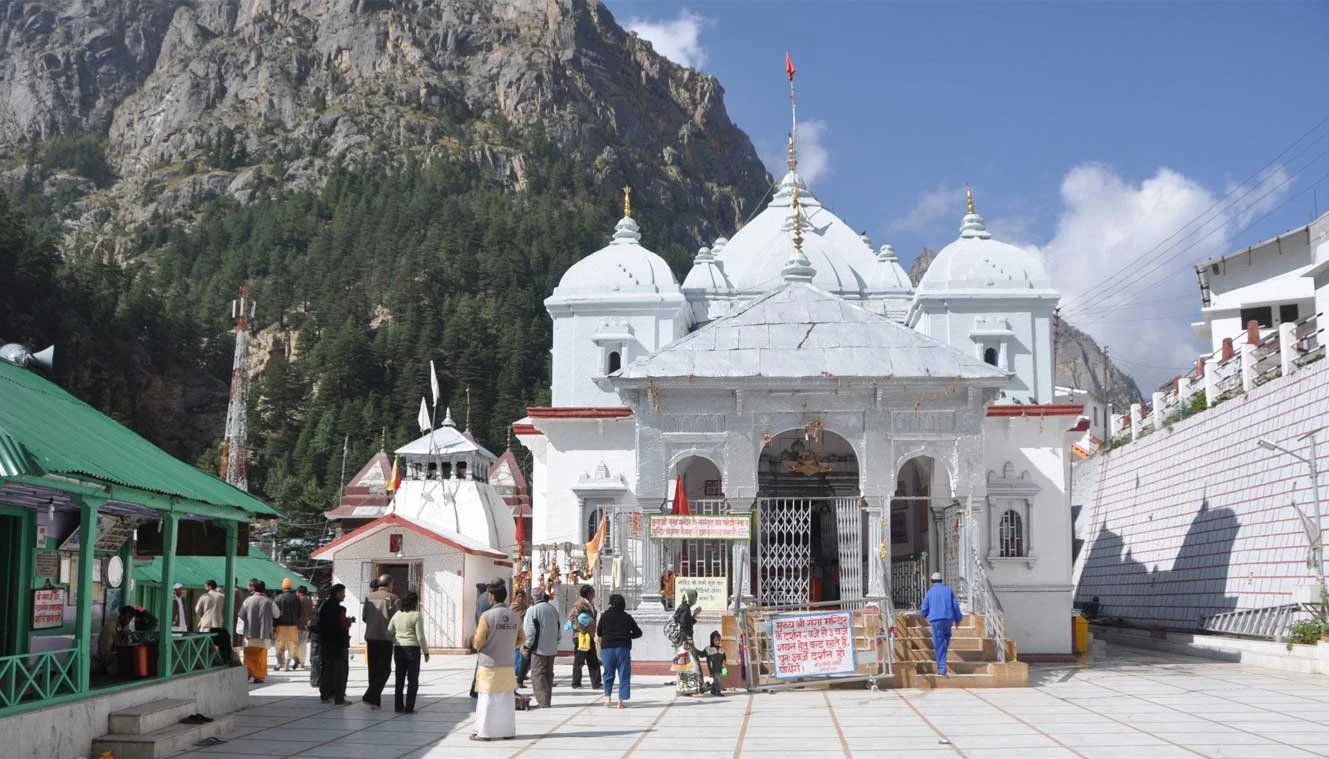
Acclimatization Day At Gangotri
Gangotri Temple - Gangotri is one of the Char Dhams of Uttarakhand
After breakfast visit Pandav Gufa, Bhagirath Shila, Surya, and Gauri Kund
Post lunch can visit Gangotri Temple or go shopping
Acclimatization walk around Gangotri town
Stay in the guesthouse
Good morning in the holy land of Gangotri!
Have breakfast and enjoy the entire day just being alive in the religious vibes. The entire region brims with spiritual fervour and Gangotri is a haven not just for spiritual seekers but also for adventure enthusiasts as well.
Now that you are at 10171 ft height, today is the day for acclimatization. Acclimatization is like a health supplement for your body to get used to the environment and low temperature. At TTH, we take acclimatization very seriously as it is one of the key contributors to the success of a trek. Take acclimatization walks around Gangotri in the evening and while doing that, you can take advantage of being in Gangotri, one of the four Char Dhams. The Gangotri temple is the biggest temple that was built in the 18th century. Apart from that, you can visit the BhagirathShila, a holy rock where King Bhagirath worshipped Lord Shiva and Pandava Gufa where Pandavas rested. Surya Kund and Gaurikund are two hot water springs that you can visit as well, Surya and Gauri Kund are both located on either side of an iron bridge near the temple.
You will see many foreigners meditating and roaming around. Spend the night in the guest house and get ready for the upcoming trek.
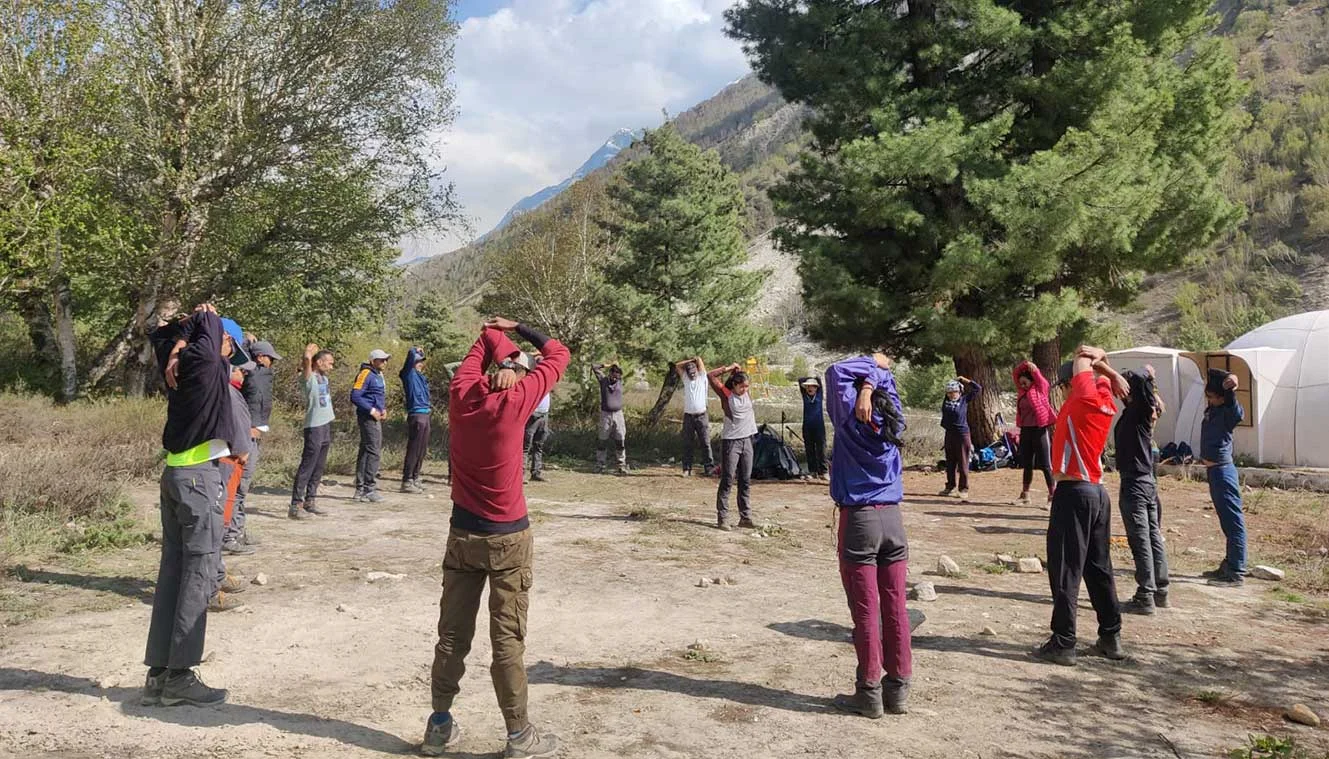
Gangotri To Chirbasa
Altitude: 3,550 m/ 11,700 ft
Trek Distance: 9 km | 5 to 6 hrs
Altitude Gain: 450 m/ 1,500 ft
Entire trek in Gangotri National Park
Accommodation in tent
Hot lunch is served at the campsite
Campsite under the pine forest
Moderate level of gradual ascent
Spring and manmade water points are available
Evening acclimatization walk
Have a full breakfast and take steps ahead to embark on the trek through the mountains. We start early from Gangotri and head towards the Chirbasa campsite. The trek starts from a forest check post and after getting your permits checked proceed on the trekking trail on the left side of the mountain. You will be walking through the pine forests alongside the gurgling Bhagirathi river. There will be gradual ascents but it will be an easy 4-5 hours trek. You will come across many waterfalls and natural streams where you can refill your bottles. Throughout the route beautiful Sudarshan Parbat (21,345ft) will accompany you. The entire walk will be in the Gangotri National Park. Once you cross the third ridge on your trek, you will be greeted with a mesmerizing view of the valley. The fragrance of the blue pine and fir trees is enough to soothe your senses.
Towards the end of the trek you will be welcomed by boulders of the Sudarshan peak, just cross them and you will reach the campsite.
This will be the most scenic campsite, with the Bhagirathi river gushing on the right, lying in between the mountains under the pine trees. The campsite offers the first views of the Bhagirathi Sister peaks, Bhagirathi I, II, and III ( 6856 m, 6512 m, & 6454 m respectively) sharing space with Manda Peak, Bhrigu Parbat, etc. Far away you can also make out the Gaumukh Glacier.
Revive yourself by having lunch. Enjoy the blissful evening by the side of the Bhagirathi river, you can also take an acclimatization walk to explore the area. To make the day more adventurous you will be spending the night in tents. Of course, besides the flowing river, between the mountain peaks, under the pine trees…!!!
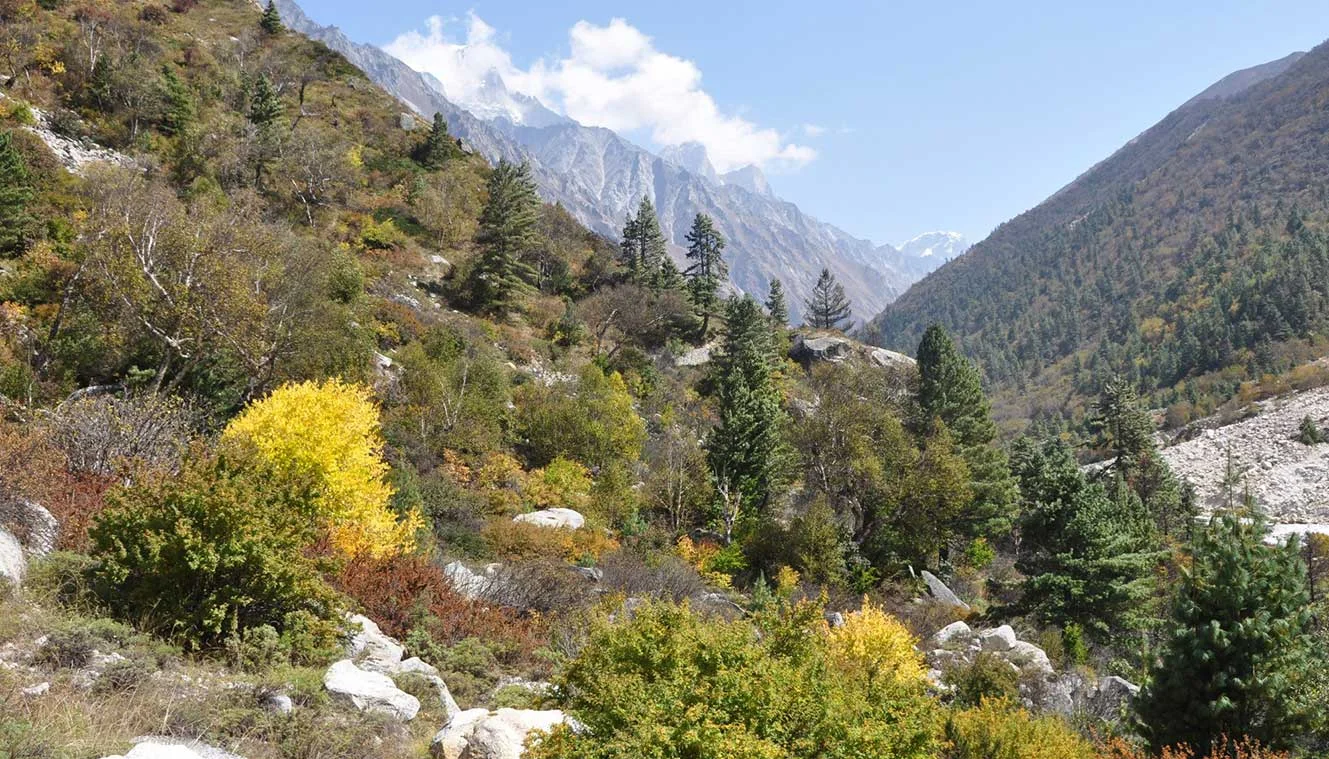
Chirbasa To Bhojwasa
Altitude: 3,800 m/ 12,500 ft
Trek Distance: 5 km | Duration: 2 to 3 hrs
Altitude Gain: 250 m/ 800 ft
Reach campsite for lunch
Easiest day of the trek
Moderate level gradual ascent
Birch (Bhojpatra) forests in the area
Ashram, police post (SRDF), and rest house available
Mt. Bhagirathi massif view from the camp area
After lunch, acclimatization walk in the surrounding areas.
Wake up with the stunning fluorescent views of sun rays on the mountain peaks, and get refreshed to trudge again. This will be the easiest 2-3 hours trek having a gradual ascent. The trail widens now with closer views of the Bhagirathi peaks. You will cross some landslide sections easier to walk upon. About 45 minutes into the walk you will reach the first ridge section and as you keep walking, the Bhagirathi group of peaks comes closer and closer. Soon you will reach a landslide-prone area filled with boulders and a stream running across your path. There will be another ridge after this point with about 8 to 9 landslide-prone bends, be mindful of falling rocks in this area. After the trek, you will see a bridge over a stream and a plain terrain where tents will be laid for you, this is Bhojwassa.
The name Bhojwasa came from Bhopatra trees or the Birch trees, which are in abundance there. This is the widest part of the valley serving you the first view of Mount Shivling. You will find an ashram, police post, and a rest house, as well as some igloo-like houses. You can opt to stay in those houses but that requires permission.
Chill around in the noon after having lunch at the campsite. You can capture the splendid camping area, or you can walk 300 m above the Bhojwasa campsite from where you can get a striking view of the valley. Spend the cozy cold night in the tents.
Bhojwasa To Tapovan
Altitude: Tapovan - 4,450 m/ 14,600 ft
Trek Distance: 9 km| Duration: hr
Altitude Gain: 650 m/ 2,100 ft
Hot lunch/ packed lunch
No water points, it is advisable to carry at least 2 litres of water
A challenging day on the trek
Carry energy bars, ors, and water
Trek begins over rocky boulders and becomes noticeably steep gradually over the rocky terrain
Cross the river by means of a trolley.
You might see mountain goat/ Ibex near your campsite
Tapovan camp is surrounded by giants - Mt. Shivling, Meru, Manda, the Bhagirathi group, Kedar Dome, Kharchakund, and many more.
Today we will trek from Bhojwasa to Tapovan. It is a 9 km long trek so eat full, get packed lunch, fill water bottles (there are no water sources on the route), carry energy bars, and lots of excitement.
We will set off early in the morning and after walking for bout half a kilometre, we will arrive at the Bhagirathi River. To reach the Tapovan, we need to cross the river by means of a manually pulled trolley over the bridge. It is a unique experience and this method is often used as a method of river crossing in the mountains where there are no bridges in place. It takes about an hour for the entire batch to cross the river via a trolley so don’t be impatient.
After crossing the river, you will walk for about 2 km with rocks and stones on either side, this is also a potential rockfall-prone zone, so we will try to cross the area before lunchtime to avoid any potential rockfalls. After crossing this zone, you have to cross the Akash Ganga River. Look for spots from where you can cross the river and if the water flow is high then you will have to take your shoes off to cross the stream.
We will have lunch after crossing the river. Tapovan is a steep climb from here. After lunch, we will set out for the Tapovan campsite. It takes about 1.5 hr to reach Tapovan from this point. Once we reach the Tapovan meadows, we will find a suitable spot to pitch our camp for an overnight stay.
Tapovan is famous for the Sadhus who come here for meditation. It is also the base camp for the expeditions going to Mt. Shivling. It offers the direct, bigger sight of Mt. Shivling which is considered one of the most sacred and beautiful mountains. Do not miss the sight of Mt. Meru and Bhagirathi peaks. Pilgrims are not allowed to camp in Tapovan unless they have a permit.
After a gruelling trek, Tapovan serves as the perfect place for solitude. Here you will find mountain goats roaming around, just as you are, and a great view of the Gaumukh Glacier. End your strained yet memorable day by resting peacefully in tents.
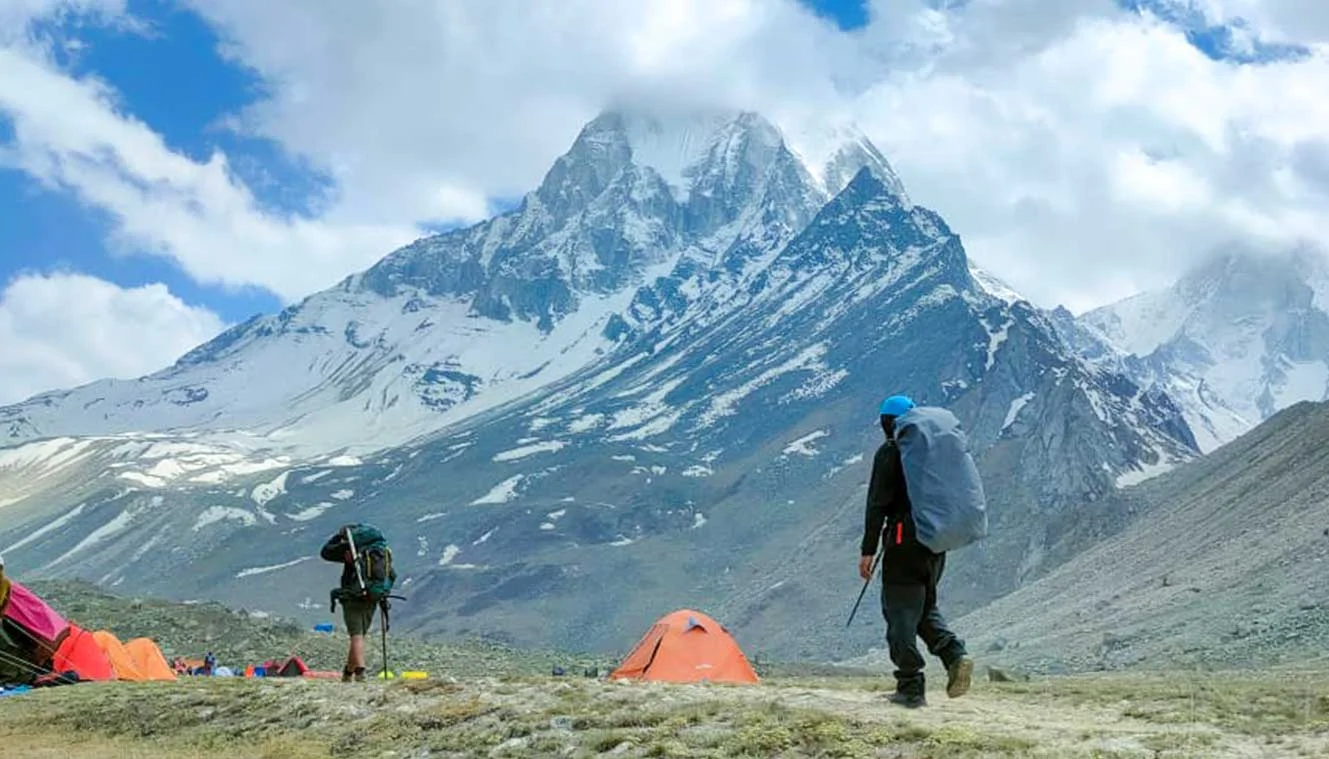
Tapovan To Bhojwasa via Gaumukh
Altitude: Bhojwasa - 3,800 m/ 12, 500 ft
Trek Distance: 10 km | Duration: 5 to 6 hrs
Descend through moraine and glacier till Gaumukh
Packed lunch
Rise early to cherish the few last moments in front of legendary mountains that are shining in the bright sun's rays and get ready to visit the Gaumukh Glacier. Mt. Shivling looks prettier than ever before, passing its beauty to the adjacent peaks. Together they all make a spectacular sight. It is time to take these memories back after having breakfast. Carry a packed lunch and enough water as you did earlier because there are no water sources.
Yes, again you have to cross the rocky terrain and moraines of the glacier. Descending is more difficult than ascending they say, you will realize this now as you make your way around the boulders. Watch your steps and move gradually. Try to relive the moments while you retrace the steps. Enjoy the forested sections of Bhojwasa once again with its flora and fauna.
It is quite a steep descent to Gaumkuh and today you will get to see the behemoth glacier from up close. Gaumukh is the end of the Gangotri glacier and hence the source of the divine Ganges river. Gaumukh means cow’s mouth, it is believed the snout looked like a cow's mouth in past. Most religious people consider it a blessing to visit the Ganges. Even if you are not religious you will be astonished to see how huge the snout is and how small you are in front of it.
The legend has it that once there was a powerful king named Sagar, who wished to perform the Ashwamedh Yajna with a ceremonial sacrifice horse. Fearing that Sagar will complete the Yajna, Lord Indra took the horse and tied it to the ashram of Lord Kapila where he used to meditate. Sagar sent out 60,000 of his sons to bring back the horse and when they were creating chaos in Kapila Muni’s ashram, his meditation got disrupted and he turned all of the 60000 sons to ashes and cursed that they will attain Moksha only if their ashes are washed in the water of the holy River Ganga, who then resided in heaven. All of Sagar's ancestors failed to please Brahma to bring Ganga on Earth, however, King Bhagirath was able to please Brahma and he ordered Ganga to flow down Earth. Goddess Ganga was not pleased with this and flowed with such intensity that she was about to drown the entire world. Bhagirath then prayed to Lord Shiva and Shiva agreed to capture Ganga in his locks to control the force and this is how Ganga arrived on Earth. To date, it is believed that a dip in the Ganga is enough to resolve all sins of an individual.
After a steep descent to Gaumukh, walk down the terrain alongside the Bhagirathi river. It will be a 5 to 6 hrs trek to Bhojwasa and you will be back to the same pine forests. Tonight we will camp here again before returning to Gangotri the following day.
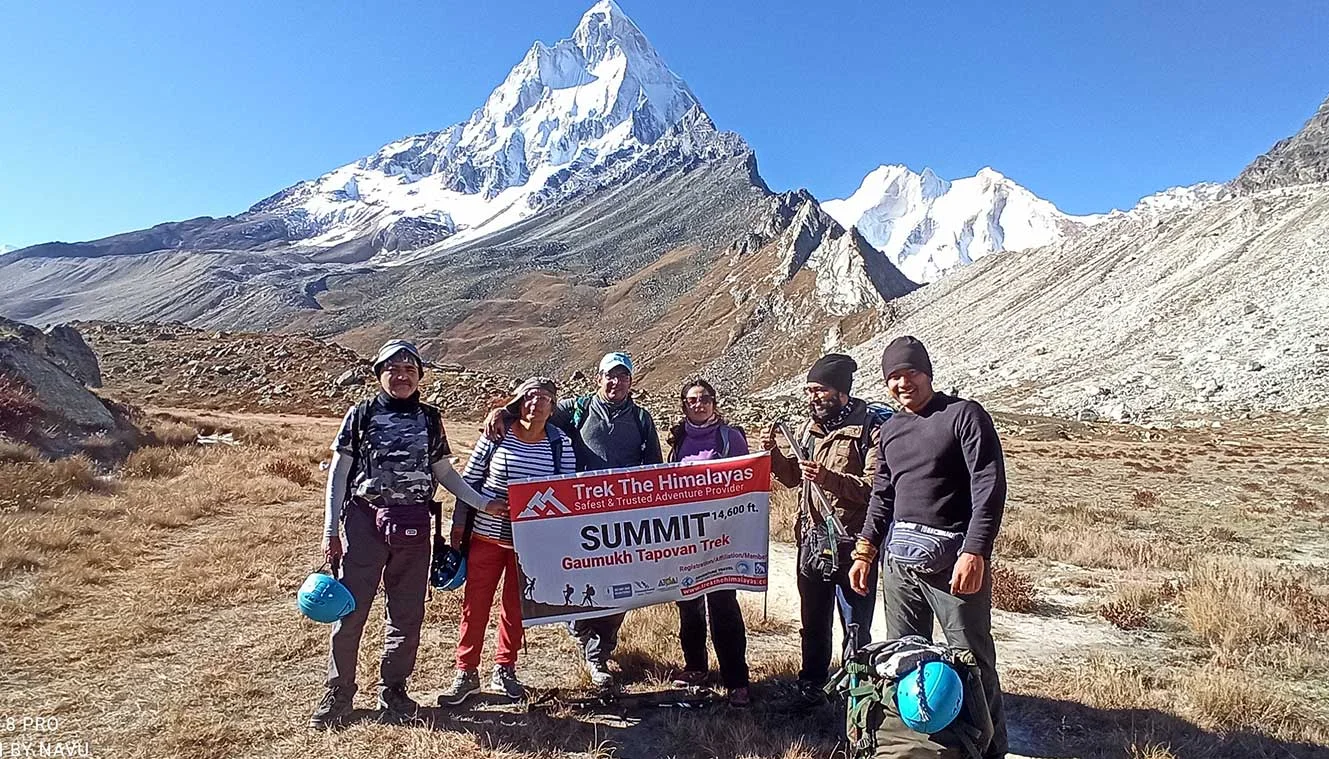
Bhojwasa To Gangotri
Altitude: 3,200 m/ 10,200 ft
Trek Distance: 14 km | Duration: 6 to 7 hr
Altitude Loss: 600 m/ 1,968 ft
Accommodation in the guest house
Moderate level of gradual descent
Wake up to realize that this will be the last day of the trek. Trek for around 6 to 7 hours covering 14 km to reach Gangotri. You will enter again in the Gangotri National Park, with the valley slowly closing behind you. Watch out for the rockfall section once again and you can catch upstreams and waterfalls to refill your water bottle. Say goodbye to the Bhagirathi and other mountain peaks as their sight now disappears.
Have a hot lunch and dinner in the guest house. Pack to return to Dehradun and thereby to your lovely homes.
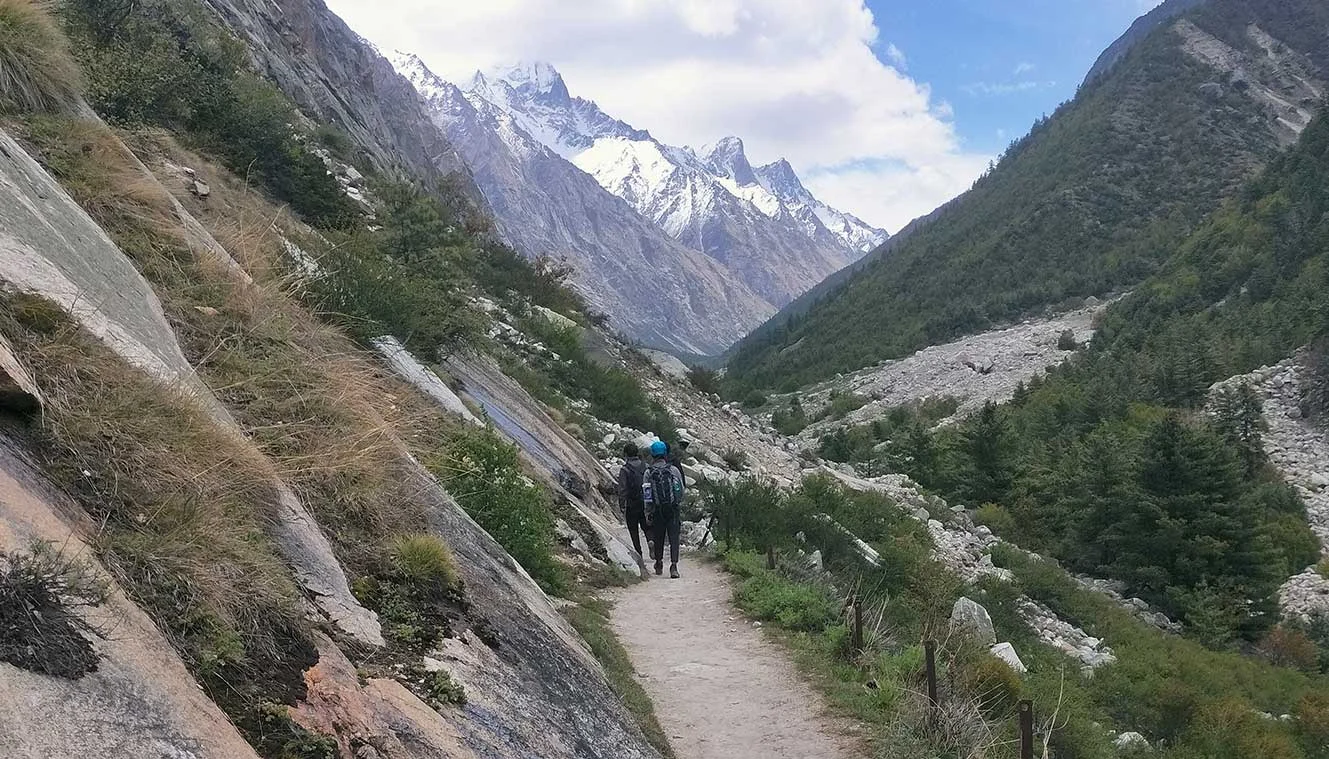
Depart For Dehradun
Have a final cup of morning tea in the mighty land of Gangotri. Say a final goodbye to your fellow trekkers and take back lots of memories. Take a wonderful group picture and get into the cab that will ride you back to Dehradun. This will be an 8-hour ride, between the mountains, valleys, and Bhagirathi river. The river guided us throughout the trek.
You will reach Dehradun by 5 PM, and from here you can lead your return journey as you have planned. We hope you take back loads of adventure-filled memories and take a pledge to come back to the mountains.
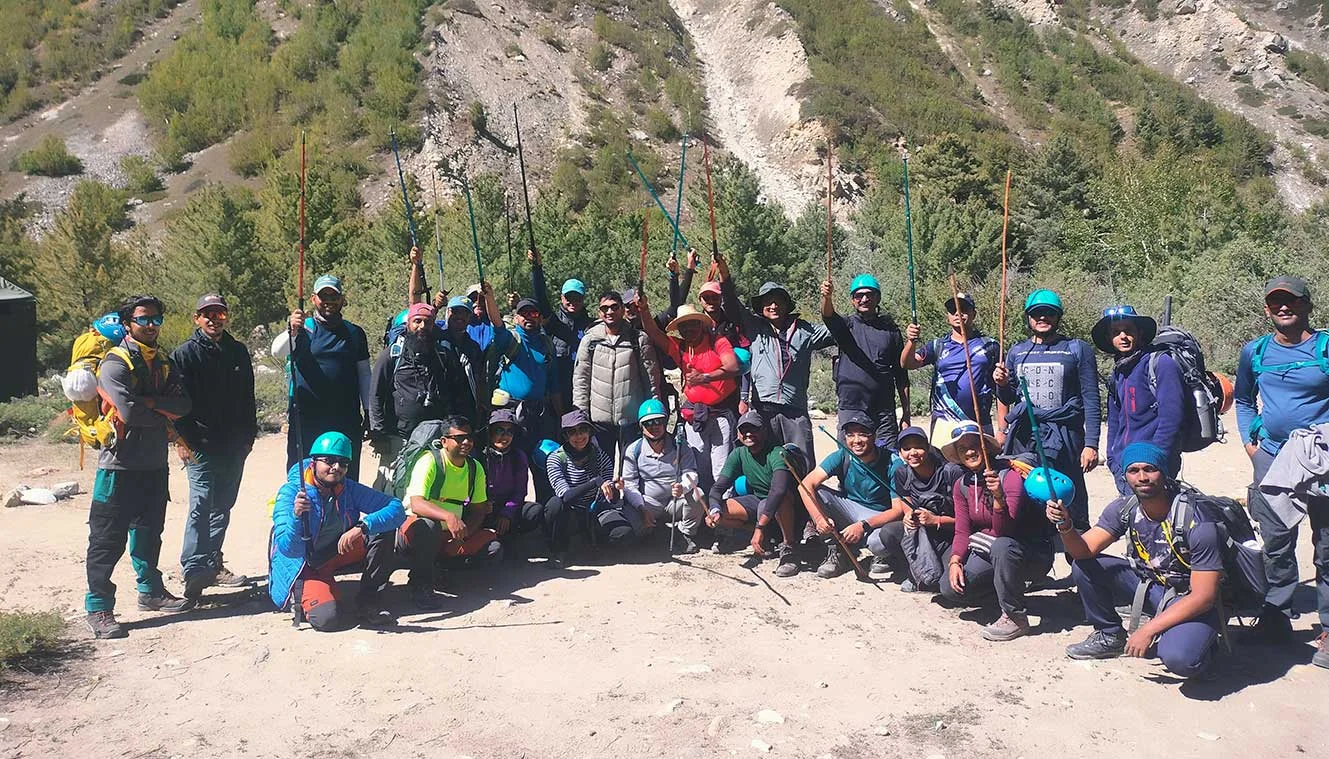
Day-1: Dehradun To Gangotri
Note: We will pick you up at 6 am from the the Dehradun railway station for an 8 Hrs long journey to Natin village.
Day-2: Acclimatization Day At Gangotri
Day-3: gangotri to chirbasa, day-4: chirbasa to bhojwasa, day-5: bhojwasa to tapovan, day-6: tapovan to bhojwasa via gaumukh, day-7: bhojwasa to gangotri, day-8: depart for dehradun.
- Gangotri to Dehradun Drive distance: 250 km (7-8 hrs)
- After morning tea towards Dehradun.
- Reach Dehradun by 5 to 6 Pm.
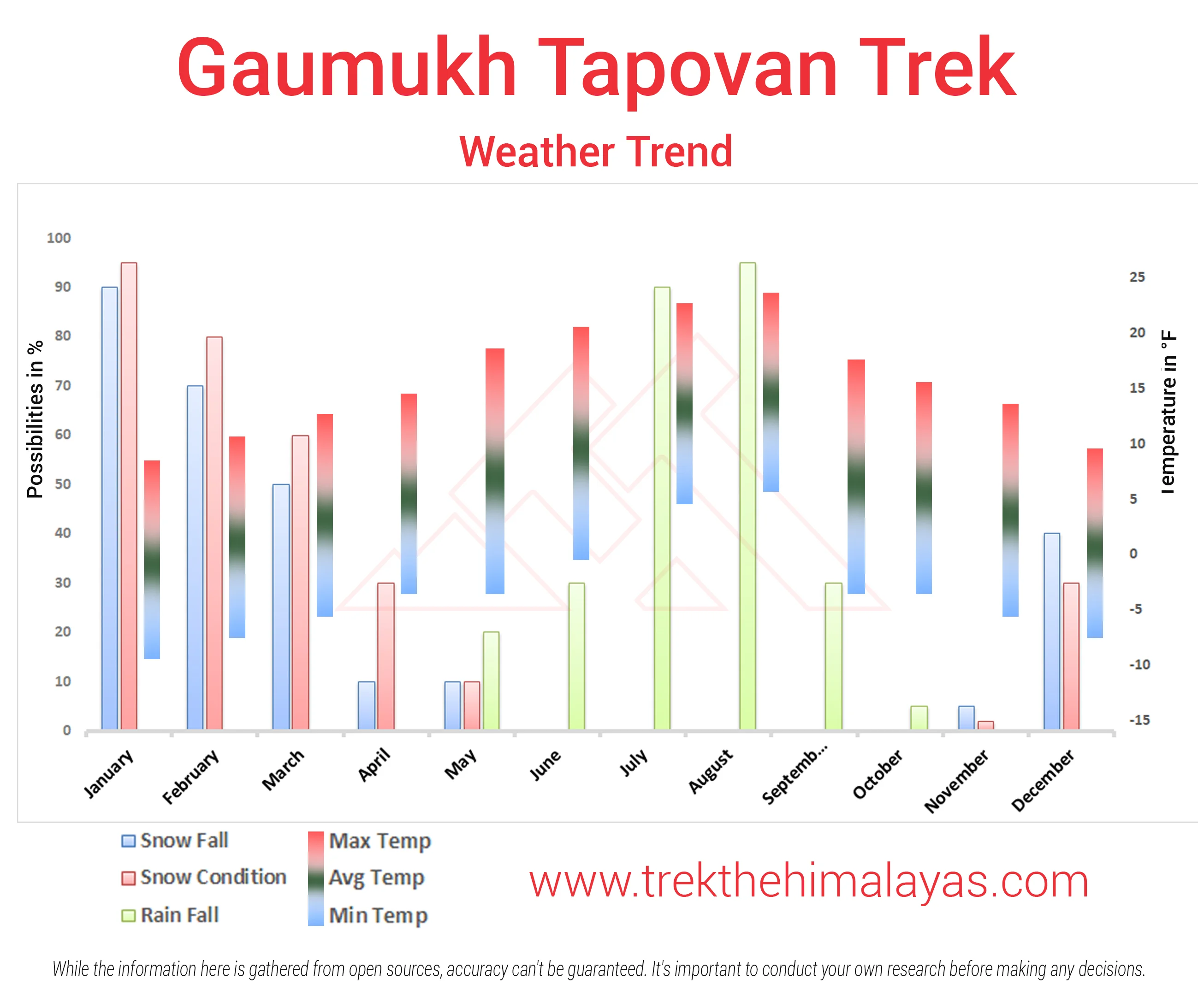
Medical & Disclaimer Form (Mandatory Documents) Click Here.
How To Reach
It is essential for everyone to arrive at Dehradun (06:00 am).
Our pick-up location is Dehradun Railway Station at 06:00 AM
Once you have reached Dehradun, TTH will manage the rest of your travel arrangements, if you have opted for TTH's pick-up service, you can select this option during the booking process by adding it as an add-on.
The distance from the Dehradun Bus Stand (ISBT) to the Railway Station is 6 km, without traffic, it will take 15 minutes.
- Transportation Amount is not included in the trek cost.
- Pick-up is excluded from the cost of the trek.
- TTH’s Tata Sumo, Tempo Traveller or similar vehicles will pick-up you.
- If you wish to upgrade the transport service, please contact the Trek Coordinator.
Options to reach Dehradun
1. Take an overnight train/bus to Dehradun, and then take a cab to the pickup point.
We always recommend to go for the govt. Buses over the private ones outside the bus station as based on the experience we have found that there are very high chances of delay involved with private buses. Also, govt. Buses are always more reliable. Whichever bus you choose, just make sure to reach Dehradun at least by 05:30 am positively.
2. Take flight to Dehradun airport (Jolly Grant Airport) (25 km, 50 min), if coming by flight then come one day early.
If you prefer to travel independently, you can either take a government bus or book a private cab. Your trek coordinator will provide guidance on how to arrange for the bus or cab booking.
Arrive in Dehradun Railway Station by 6:00 pm.
The designated drop-off point is Dehradun Railway station.
Please consider planning your subsequent travel arrangements after 8:00 pm.
The distance from Railway Station to Dehradun Bus Stand (ISBT) is 6 km, it will take approx 25 minutes.
The distance from Railway Station to Dehradun Airport is 28km, it will take approx 45min to 1hr.
TTH offers comfortable transportation through Tempo Traveler, Bolero, or equivalent vehicles. If you wish to upgrade your mode of transportation, please contact your trek coordinator for further assistance.
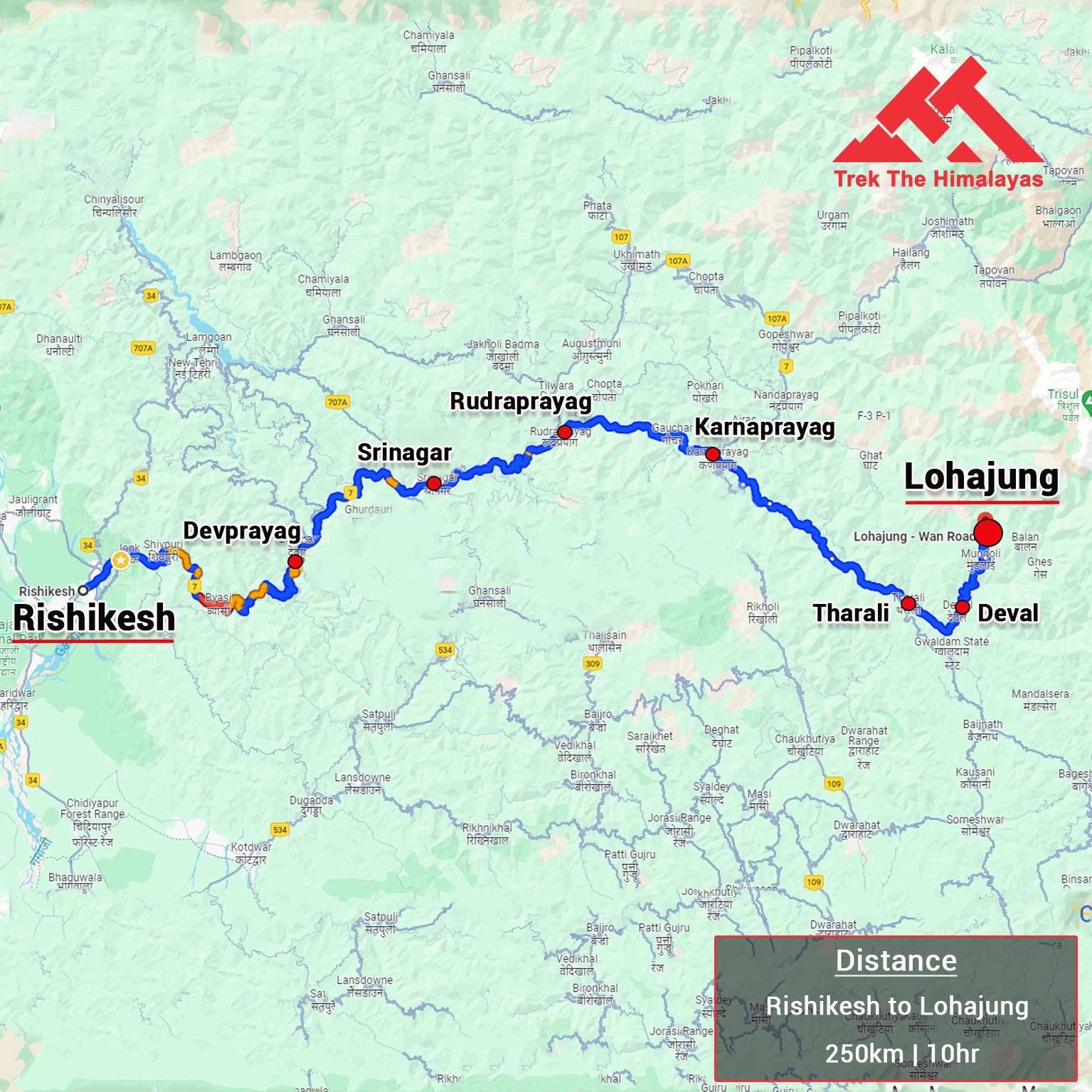
1. Insurance is Mandatory.
2. Accommodation (as per the itinerary):
- Guest house stay, Type : triple, quad, dormitory (separate for male and female).
- Camping : Twin sharing basis.
3. Meals (Veg + Egg):
- Day 1 Dinner to Day 7 Dinner as per the itinerary.
4. Support:
- 1 Versatile base camp manager: handles communication and deploys extra manpower in emergencies.
- 1 Mountaineering & First aid qualified professional trek Leader.
- 1 Experienced high altitude chef.
- Local experienced guides (Number of guides depending on the group size).
- Enough support staff.
5. Trek equipment:
- Sleeping bag, Sleeping liners (if required), Mattress, Utensils.
- 3 men all season trekker tent (twin sharing), Kitchen & Dining tent, Toilet tent.
- Camping stool, Walkie talkie.
- Ropes, Helmet, Ice axe, Harness, Gaiters & Crampon (if required).
6. First aid:
- Medical kit, Stretcher, Oxygen cylinder, Blood pressure monitor, Oximeter, Stethoscope.
7. Transportation (as per the itinerary):
- Transport from Rishikesh to Gangotri and return to Rishikesh.
8. Mules/porters to carry the central luggage.
9. Clock room facility available at the base camp for additional luggage.
10. All necessary permits and entry fees, Upto the amount charged for Indian.
11. Services from Gangotri to Gangotri .
1. Food during the transit.
2. Any kind of personal expenses.
3. Mule or porter to carry personal luggage.
4. Emergency evacuation, hospitalization charge or etc.
5. Anything not specifically mentioned under the head Inclusion.
6. Transport cost.
Things can be provided on demand and availability (participant has to pay extra for these things).
1- Satellite phone/set phone - is a type of mobile phone that connects via radio links via satellites orbiting the Earth instead of terrestrial cell sites like cellphones. Therefore, they can operate in most geographic locations on the Earth's surface.
2- Gamow/PAC HAPO Bag (Portable Hyperbaric Bag) - is a unique, portable hyperbaric chamber for the treatment of acute mountain sickness (AMS), also known as altitude sickness.
3- AEDs (Automated External Defibrillators) - are portable life-saving devices designed to treat people experiencing sudden cardiac arrest, a medical condition in which the heart stops beating suddenly and unexpectedly.
Cancellation terms:
Cancellations prior to 25 days from the start of the Trip
Refund options
- 5% deduction of trek fee
- 100% cash voucher for any trip till one year
- Transfer your trek (any trek, any date) to your friend
Cancellation between 24 days and 15 days to the start of the Trip
- 30% deduction of trek fee
- 100% cash voucher for same trip till one year
- 85% cash voucher for any trip till one year
- Transfer your trek (same trek, any date) to your friend
Cancellation between 14 days and 10 days to the start of the Trip
- 50% deduction of trek fee
- 80% cash voucher for same trip till one year
- 70% cash voucher for any trip till one year
- Book the same trek, in the same season, with any other batch
Cancellation less than 9 days to the start of the trek
- No cash refund
- 20% cash voucher for the same trip till one year
- 10% cash voucher for any trip till one year
- Transfer your trek (same trek, same date) to your friend
Note- If a booking is made using a voucher or discount code, the policies related to vouchers and discounts cannot be modified.
In the unlikely event that TTH cancels a trek prior to the scheduled departure date:
While it is extremely rare for TTH to cancel a trek, we understand that unforeseen circumstances or natural disasters may occasionally require us to do so before the scheduled departure. These circumstances could include continuous rain or snow, thunderstorms, snowstorms, landslides, floods, earthquakes, or any other natural calamity that poses a risk to the safety of our trekkers. Additionally, unforeseeable events such as local riots, curfews, pandemics, lockdowns, government orders, or any similar situations that compromise the safety of the trekking experience may also necessitate a cancellation.
In the event of such a cancellation, TTH will provide you with a voucher equivalent to the amount you paid for the trek. This voucher can be redeemed for any of our treks within the next year, allowing you to still enjoy an adventure with us at a later date.
The issuance of a voucher is not applicable in situations where you are required to descend from the trek for any reason. The trek leader may make the decision to send you down from the trek due to factors such as insufficient fitness level, symptoms of Acute Mountain Sickness (AMS), high blood pressure, exceeding the designated turn-around-time, health concerns, or if you are found smoking, drinking, or violating the rules set for the trek. In such cases, the provision of a voucher does not apply.
In the rare event that TTH shifts a trek:
We would like to emphasize that weather conditions in high-altitude areas are highly unpredictable and can undergo sudden changes at any time, irrespective of the day. Additionally, circumstances beyond our control, such as natural disasters, political unrest, pandemics, and lockdowns, may impact the feasibility of conducting a trek. In cases where we are unable to proceed with an event due to such circumstances that are beyond our direct control, we will make every effort to provide you with an alternative trek that is safer and more suitable.
In such situations, we will issue a voucher to offset the cost difference between the originally scheduled trek and the alternative trek. This voucher can be redeemed at any time within one year from the date of issue. Please note that a refund fee or reimbursement of the cost difference is not applicable in these cases.
- Change of trek batch is dependent on the availability of seats in the batch
- In case of transferring a trek to a friend, he/she should satisfy all the mandatory requirements put forward by TTH
- TTH holds the right to change/cancel the policies, without prior notice
- Cash refund is applicable only in case of bookings made without using any promotional offer code or vouchers
Cash Voucher Terms:
- This is a non-transferable voucher
- The voucher cannot be merged with any other offer of Trek The Himalayas
- The voucher is valid for Trek booked directly with Trek The Himalayas in India
- To avail the voucher please use your register phone number or e-mail id
- All the other Terms of booking a trek with Trek The Himalayas are applicable to the voucher
- Trek The Himalayas holds rights to add/remove any of the Terms and Conditions without prior notice
Itineraries are based on information available at the time of planning and are subject to change. "Trek The Himalayas" reserves the right to change expedition dates, people or itineraries as conditions warrant. If a trip must be delayed or the itinerary changed due to bad weather, road conditions, transportation delays, government intervention, airline schedules, sickness, or other contingency for which TTH or its agents cannot make provision, the cost of delays and/or other changes are the responsibility of the participant. TTH reserves the right to decline, or accept, any individual as a trip member for any reason whatsoever.
Trek Essentials
PDF Of Trek Essential Download
Frequently Asked Questions(FAQ)
How to register/create an account with tth.
To register with TTH, visit our website - www.trekthehimalayas.com and create your account. To create your account you will need to use your email address and fill in all the details, set your unique password and your account is ready to use.
How to book a trek?
- To book a trek with TTH, you first need to register with us and create an account.
- Choose the trek that you want to do and click on available dates.
- You will land at the login page, fill in the required details.
- Add Participants, choose add-on services click on the Pay now button, choose your preferred payment method, and make the payment. TTH accepts multiple payment options, including credit/debit cards, net banking, and UPI.
- You will receive a confirmation email from TTH with all the necessary details about the trek, including the meeting point, transportation, accommodation, and other important instructions.
Made a payment but did not receive any confirmation.
please send an email to us at [email protected] or reach out to the numbers provided in the Help and Support section of your Trek Page. We will ensure that your issue is promptly resolved.
How to book off-load luggage and transportation?
To book services such as off-load luggage and transportation, you can find them listed as add-ons. These additional services can be booked at the time of your initial booking. If you miss booking add-ons during the initial reservation, you can log in anytime and easily book 4 days before the departure date add-ons through the platform.
If I have booked the wrong trek or date, how can I make changes?
In such a situation, please log in to your account and transfer your trek or date to the desired one within 12 hours or drop us an email at [email protected] 10 days before the departure date of the trek. After the initial 12-hour period, any changes will be processed according to the cancellation policy.
I am a beginner and confused which trek to book.
We recommend visiting our "Suggest Me a Trek" page. By filling out the form, our experts will contact you with the best possible trek options based on your preferences and experience level. Alternatively, you can reach out to us via email at [email protected] or give us a call using the numbers provided on our website for personalized assistance and recommendations.
How is family trek different from regular trek?
Family treks differ from regular treks by focusing on ease of difficulty, offering shorter durations for younger participants, Kid-friendly and easily digestible foods, child-friendly activities, maintaining a higher guide ratio for diverse age groups, and implementing additional safety measures for families.
Ideal treks for children.
Family Trek with Kids recommendation Only Dayara Bugyal and Chopta Chandrashila Trek.
Minimum age for children to trek with TTH.
Minimum age for TTH treks is typically 7 years, though this may vary depending on the specific trek.
Can we take children to high altitudes with their guardian?
Yes, you can take a kids to a high-altitude trek with a parent. Discuss with a trek expert before booking a trek.
Can we send kids without Parents/guardian?
Medical & Disclaimer Form (Mandatory Documents) Click here to download medical and disclaimer form
How to prepare a child for a high altitude trek?
Physical Fitness: Ensure your child is physically fit. Engage them in regular exercise, outdoor activities, and hikes to build stamina and endurance. Hydration: Emphasize the importance of staying hydrated at high altitudes. Encourage your child to drink water regularly, even if they don't feel thirsty. Proper Nutrition: Provide a well-balanced diet with sufficient carbohydrates for energy and foods rich in iron to prevent altitude sickness. Adequate Sleep: Ensure your child gets enough sleep in the days leading up to the trek. Quality rest is crucial for altitude adaptation. Educate on Altitude Sickness: Teach your child about the symptoms of altitude sickness, such as headache, nausea, and dizziness. Encourage them to communicate any discomfort immediately. Appropriate Clothing and Gear: Dress your child in layers to adjust to changing temperatures. Ensure they have appropriate trekking gear, including sturdy footwear. Positive Mindset: Foster a positive mindset. Encourage your child, and let them know it's okay to take breaks when needed. Medical Check-Up: Schedule a medical check-up before the trek to ensure your child is fit for high-altitude activities. Consult with a healthcare professional about any potential health concerns.
Kind of food will be served during the trek for children.
TTH takes special care to provide wholesome and nutritious food for children on treks. Here are some of the foods that are typically served for children: Breakfast: For breakfast, TTH serves a variety of options like porridge, cornflakes, bread, butter, jam, honey, boiled eggs, omelettes, and pancakes. Children can choose from these options to fuel themselves for the day's trek. Lunch: For lunch, TTH serves lunch which includes rotis, vegetables, rice, dal, and salad. The rotis are usually made fresh on the trek and are a good source of carbohydrates. The dal and vegetables provide protein and other essential nutrients. Snacks: TTH provides healthy snacks like fresh fruits, dry fruits, energy bars, cookies, and biscuits to keep the children energized throughout the day. Dinner: For dinner, TTH serves a hot and wholesome meal which includes soup, rice, dal, vegetables, and a non-vegetarian dish (if requested in advance). Children can also choose from a variety of desserts like custard, jelly, and fruit salad. Dietary requirements: If a child has any special dietary requirements, TTH can cater to those needs as well. For example, if a child is lactose intolerant or allergic to nuts, the kitchen staff can make arrangements to accommodate those requirements.
How to choose the right trek?
Choosing the right trek for a beginner can be a bit overwhelming as there are many factors to consider such as distance, elevation gain, terrain difficulty, weather, and time of year. Here are some tips that can help you choose the right trek for a beginner:
1. Determine fitness level: Assess the fitness level of the beginner to understand their physical capabilities. This will help you select a trek that is challenging but not too difficult.
2. Choose a well-traveled trail: A well-traveled trail will have more amenities such as signposts, water stations, and shelter. It is also safer as there will be other hikers on the trail.
3. Consider the length of the trek: For beginners, it is recommended to start with a shorter trek that can be completed in a day or two. This will help them get acclimatized to trekking and build their confidence.
4. Look for gradual elevation gain: Choose a trek with a gradual elevation gain rather than steep ascents. This will make the trek easier and more enjoyable.
5. Check the weather: Check the weather forecast before selecting a trek. Avoid treks during the monsoon season or winter when the trails can be slippery or dangerous.
6. Research the trail: Read about the trail to get an idea of the terrain, altitude, and difficulty level. This will help you select a trek that is suitable for the beginner.
7. Consult with an expert: If you are unsure about which trek to choose, consult our trek expert Mr. Nitin (+91 70600 59773) between 10 AM to 6 PM (Tuesday - Friday). Mr. Nitin will provide you valuable advice and guidance.
Overall, it is important to choose a trek that is enjoyable, challenging but not too difficult, and suitable for the beginner's fitness level and experience.
Can a beginner choose a tough trek?
It is not recommended for a beginner to choose a difficult Himalayan trek. Trekking in the Himalayas can be physically and mentally challenging, especially if you are not used to the high altitude, steep slopes, and rugged terrain. Choosing a difficult trek without the proper experience, fitness level, and preparation can be dangerous and put you at risk of altitude sickness, injury, and other hazards.
If you are a beginner, it is recommended to start with an easier trek and gradually build up your skills and experience. This will help you understand the challenges of trekking in the Himalayas, and also prepare you physically and mentally for a more difficult trek in the future. It is also important to choose a trek that matches your fitness level, experience, and interest.
What is the age limit for a beginner trekker?
There is no specific age limit for a beginner trekker. However, it is important to consider your physical fitness, health condition, and personal interests before embarking on a trek. Trekking in the Himalayas can be physically and mentally demanding, and requires a certain level of physical fitness and endurance.
If you have any pre-existing medical conditions or are above a certain age, it is recommended to consult with a doctor before embarking on a trek. It is also important to listen to your body and take breaks as needed during the trek to prevent exhaustion or injury.
If I am solo, can I join the trek in a group?
Yes, you can join the trek. We have fixed departure groups where you can simply book your trek and we will take care of curating a group.
How does my family get updated about my Trek?
Before you start the trek, it is recommended that you make all the necessary phone calls as during the trek you may or may not receive network coverage, once you come back to the Base Camp, you can reconnect with your family via phone once again. You can share your trek coordinator contact detail with your family members to get the latest updates about your trek batch.
What food can I expect?
At TTH, we provide wholesome and nutritious meals during the trek. The food is vegetarian and includes a variety of dishes such as rice, dal, vegetables, chapati, paratha, pasta, noodles, and soup. We also offer snacks such as biscuits, and salty, and dry fruits during the trek. Special dietary requirements such as vegan, gluten-free, or Jain food can also be arranged if informed in advance.
I am allergic to some foods.
If you are allergic to some foods, you need to let us know in advance so that we can make arrangements accordingly.
How safe is trekking with TTH?
TTH is a trekking company that prioritizes the safety of all its participants, including women trekkers. They have a comprehensive safety system in place, which includes a dedicated team of experienced and trained trek leaders and support staff who are equipped to handle emergency situations and provide first aid.
TTH also takes specific measures to ensure the safety and comfort of women trekkers. They have a separate tent accommodation for women trekkers, female trek leaders, and support staff. They also provide separate toilet facilities for women and encourage a safe and respectful environment for all trekkers.
Moreover, TTH has a strict policy against any kind of harassment and has a zero-tolerance policy towards such incidents. They have a designated Internal Complaints Committee (ICC) to investigate and address any complaints related to harassment or misconduct. Overall, TTH has a good reputation for safety and responsible trekking practices, and women can feel comfortable and safe while trekking with them.
How TTH will manage if I am the only woman in the group?
In case you are the only women in the group, we provide a single sleeping arrangement. Also, during the trek, the trek leader will always remain by your side to provide optimum safety and reassurance.
How can I know that other women are in the batch?
You can reach out to the trek coordinator to inquire about the number of female trekkers and their respective states who have booked the trek. Please note that the trek coordinator cannot disclose personal details of any trekker. Once you've confirmed your booking, a WhatsApp Group will be created for all the trekkers in your batch. This allows you to connect with fellow trekkers before the trek begins.
Can I know in advance, which trek is led by a women Trek Leader?
While many of our treks are led by female trek leaders, however, it is not possible to know which trek leader is assigned to which group. But nonetheless, whether the trek leader is male or female you can be completely assured of your safety and security with us.
Can I trek with periods? If yes, then where can I dispose of the sanitary pad?
Yes, it is possible to trek with periods. However, it is important to take some extra precautions and preparations to ensure a comfortable and safe trekking experience.
Here are some tips that can help you trek during your period:
1. Use menstrual hygiene products that you are comfortable with, such as tampons, pads, or menstrual cups. It is recommended to carry enough supplies for the entire duration of the trek.
2. Pack wet wipes, hand sanitizer, and plastic bags to dispose of used hygiene products.
3. Wear comfortable and breathable clothing that allows for easy movement and reduces friction. Avoid wearing tight or restrictive clothing that can cause discomfort.
4. Carry pain relief medication, such as ibuprofen or acetaminophen, in case of menstrual cramps.
5. Stay hydrated and maintain a balanced diet to support your energy levels and overall health.
6. Take breaks as needed and listen to your body. If you feel uncomfortable or experience any unusual symptoms, seek medical attention immediately.
It is also recommended to consult with a doctor before going on a trek during your period, especially if you have a pre-existing medical condition or are taking medication. By taking necessary precautions and being prepared, you can have a safe and comfortable trekking experience even during your period.
We provide proper disposal facilities for sanitary pad disposal during the trek.
How will the accommodation be during the trek?
We offer three person tents with twin-sharing for optimum comfort. A woman trekker will share a tent with another woman trekker and if you are the only woman in the group, you will be given a single accommodation for your comfort and privacy.
Are trek poles, Jackets and other equipment available for rent from Trek The Himalayas?
Yes, we do provide gears on rent. You can book it using you TTH account directly.
Who will be with us on the trek from Trek The Himalayas?
Mountaineering qualified Experienced and first aid certified Trek Leader, First Aid Certify local guide, Cook, helpers and supporting staff.
Who can not join the trek?
People suffering from Bronchitis, Asthma, High blood pressure, Epilepsy (got faints), TB , Heart problem or on higher BMI side are strictly not allowed to go on any Himalayan trek. Apart from this if you had any medical history, please let us know.
When it gets really cold can I consume alcohol?
No. Alcohol and smocking isn’t allowed while on trek. It is totally misconception that it will keep you warm. Your body need to acclimatize properly and for that eat properly and drink enough water; these things will keep you warm.
What type of toilet facility is TTH providing at the trek?
Toilet tents provide a convenient solution for answering nature's call in the great outdoors. Dry toilets, in particular, offer a highly sanitary approach. By digging a pit and utilizing mud and a shovel, you can easily cover up your waste. This method ensures cleanliness and hygiene while camping or exploring in the forest.
Remember to pack essential toiletries to complete your outdoor bathroom kit and maintain proper personal hygiene during your adventures. With these practices in place, you can enjoy nature while also respecting it.
How do I manage the negative temperatures on the trek at higher camps? Do I need special jackets?
Layer Up From Head To Toe Eat Full Meals, never sleep empty stomach You can keep warmee (if you’re more susceptible to cold). Use sleeping bag in right way and don’t leave free space in sleeping bag.
For upper body – Thermal layer – T-shirt (full-sleeves) – Fleece T-shirt (for extreme colds) – Fleece layer – Thick Jacket/Down Jacket – Waterproof or Windproof layer (outermost layer, when it is snowing or raining) - For Lower Body – Thermal layer – Hiking pants (normal) or Winter hiking pants
Based on how warm you feel you can skip any of the above layers. Your outer later should be windproof since it is windy at high altitude. The idea behind layering is that the more insulation you have the less cold you feel, and instead of wearing a very thick jacket if you wear multiple layers, your body will be better insulated against the cold.
Do you provide crampon/micro spikes and gaiters?
Yes, we provide micro spikes and gaiters, if required.
What documents need to carry on trek?
Mandatory documents: 2 xerox of ID having address (addhar card/driving license), 2 Passport size photographs, hard copy Medical form signed & sealed by doctor, disclaimer form sign by trekker and high altitude insurance.
If we come prior the trek date, Do you provide accommodation?
No. We don’t but we can suggest you good hotel/Stay nearby pick up location.
Do we get enough water for drinking?
Yes, trekker must carry 2 water bottles 1 litre each so they can refill it at campsite for drinking and keep themselves hydrate.
What kind of shoes we should buy for the trek?
You should buy shoes which has these three features –Good grip, Ankle Support and additional water resistant layers. Generally, we advise Quechua Trek 100, MH 500 and MH 100.
How do we get back after the trek?
Your return transport is also included in trek fee if you're opting for service Dehradun to Dehradun ; we use Tempo Traveller/ Tata Sumo/Max/Boloero kind of vehicle.
What happens if some members of the team need to turn back before the summit?
No one is forced to go on. There is always enough staff to split the party according to need and regroup later at the camp. Most people have no trouble reaching the highest campsite. If some members decide not to climb the final distance they can wait for the climbers to come back down the same way or take a lateral path to the descent route.
What kind of help is available in case of emergency?
We always have a first aid kit close at hand. Serious injuries are rare. Porters will assist injured climbers to the base of the mountain and onward to a clinic or hospital. Kilimanjaro International Airport is very near Marangu Gate if evacuation to the US or Europe is advisable.
What is the Gaumukh Tapovan Trek?
The Gaumukh Tapovan Trek is a trekking expedition in the Garhwal region of Uttarakhand, India, which takes you to the source of the Ganges river and the scenic alpine meadow of Tapovan.
How long does the Gaumukh Tapovan Trek take?
The Gaumukh Tapovan Trek typically takes around 6-7 days to complete, depending on the route and weather conditions.
What is the best time to do the Gaumukh Tapovan Trek?
The best time to do the Gaumukh Tapovan Trek is from May to June and September to November when the weather is relatively stable and the snow has melted, making the trek less difficult.
Is previous trekking experience necessary for the Gaumukh Tapovan Trek?
No, previous trekking experience is not necessary for the Gaumukh Tapovan Trek , but a good level of fitness is required due to the steep and rocky terrain.
What is the level of physical fitness required for the Gaumukh Tapovan Trek?
The Gaumukh Tapovan Trek requires a good level of physical fitness as the trek involves steep ascents, rocky terrain, and potential altitude sickness. It is recommended to undergo physical training and preparation before attempting the trek.
What permits and paperwork are required for the Gaumukh Tapovan Trek?
To undertake the Gaumukh Tapovan Trek, you will need to obtain the necessary permits and paperwork from the Forest Department and the local authorities. These may include a trekking permit, a medical certificate, and a travel visa. It is recommended to research the specific requirements and apply for the permits well in advance to avoid any delays or issues.
What is the altitude of the Gaumukh Tapovan Trek?
The highest point of the Gaumukh Tapovan Trek is the Tapovan meadow, which stands at an altitude of 4,463 meters (14,640 feet) .
Is it safe to do the Gaumukh Tapovan Trek?
Yes, the Gaumukh Tapovan Trek is generally considered safe, but with any trek, there are inherent risks involved. It is important to follow safety guidelines, such as staying hydrated, wearing appropriate clothing and footwear, and avoiding overexertion.
What is the accommodation like on the Gaumukh Tapovan Trek?
Accommodation on the Gaumukh Tapovan Trek typically includes camping in tents (twin sharing) or basic lodges (triple & quad sharing) male female seprate.
What is the level of difficulty of the Gaumukh Tapovan Trek?
The Gaumukh Tapovan Trek is considered to be a moderate to difficult trek due to the steep and rocky terrain, high altitude, and potential for altitude sickness.
Can I do the Gaumukh Tapovan Trek solo?
It is recommended to do the Gaumukh Tapovan Trek with a certified guide or trekking agency for safety reasons, but it is possible to do it solo if you have previous trekking experience and the necessary equipment and permits.
What is the distance covered on the Gaumukh Tapovan Trek?
The distance covered on the Gaumukh Tapovan Trek is approximately <strong>45-50 kilometres (28-31 miles)</strong>, depending on the route taken.
What is the level of altitude sickness risk on the Gaumukh Tapovan Trek?
The Gaumukh Tapovan Trek involves significant altitude gain, with the highest point being at an altitude of 4,463 meters (14,640 feet). As a result, there is a risk of altitude sickness for those who are not acclimatized or do not take the necessary precautions. It is recommended to properly acclimatize, stay hydrated, and consult with a doctor before attempting the trek. It is also recommended to have a guide or trekking agency with experience in dealing with altitude sickness.
- Date and Price
Rent A Gear
Trek Articles
Trek Stories
Quick Links
Trekking & Hiking
Mountaineering
Multi Sports
Himalayan Pilgrimage
Website Privacy
Terms & Condition
Contact Info
Get in touch with us. E-mail us Monday-Saturday (10 AM to 6 PM)
Address: Trek The Himalayas, Kaintura Plaza, Badrinath Road Tapovan, Rishikesh - 249201 Uttarakhand
Phone: 8191004846
Email: [email protected]
2010 Trek The Himalayas. All rights reserved

Home » Categories » Treks » GAUMUKH TAPOVAN TREK – A COMPLETE GUIDE!
GAUMUKH TAPOVAN TREK – A COMPLETE GUIDE!
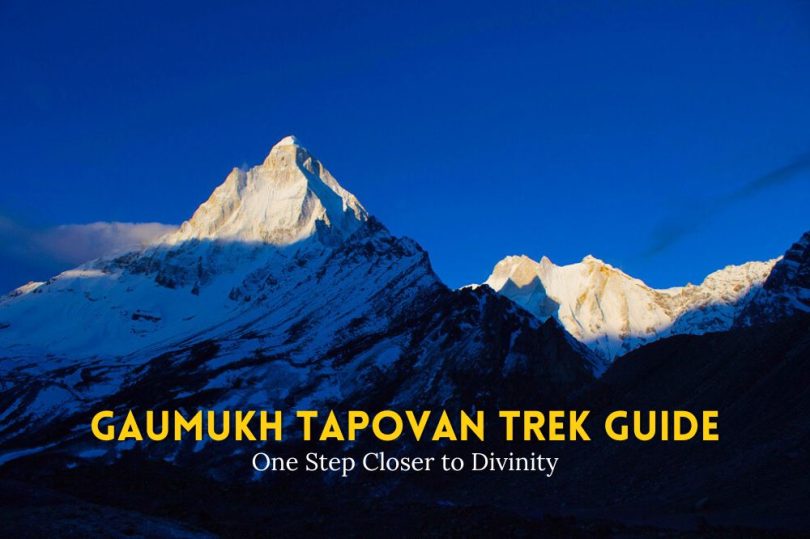
Gaumukh Tapovan is not just a trek, it is a journey of belief, perseverance and dedication . It is a place where spirituality, adventure and peace entwine together to form the trails that lead to the origin of the Ganges.
Perched at 14, 600 ft in the Garhwal Region of Uttarkashi , Gaumukh Tapovan is considered to be the holy grail for trekking enthusiasts and a revered pilgrimage site for those who dare to embark on this arduous yet gifting adventure.
For hundreds of years, millions of devotees have embarked on a day’s journey to Gangotri which is considered as the starting point of the river Ganga, however the actual origin lies at the base of the Gangotri Glacier.
In this travel guide, we have listed down all about why this trek takes you one step closer to divinity and how you can conquer it easily. Read Away!!
The Ganga is not just a River, it is the Soul of India.
Table of Contents
The Ancient Story of Gaumukh Tapovan
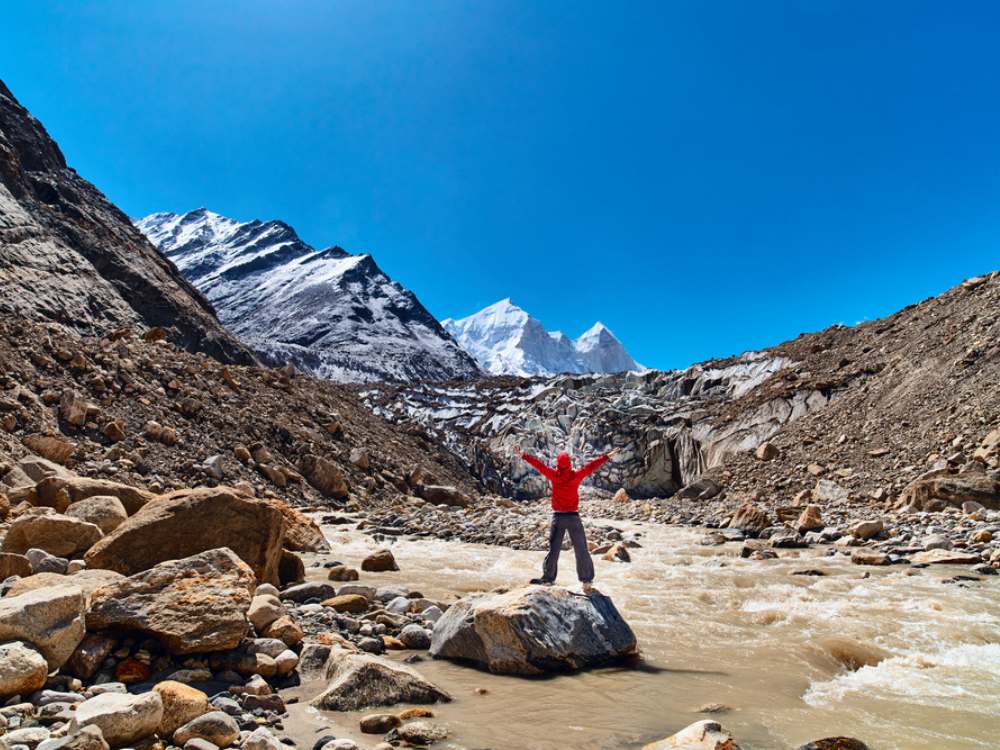
Thousands of years ago the land of Kosala faced the wrath of Sage Kapila whose curse brought upon severe drought and famine, killing thousands. In an attempt to save his kingdom and bring salvation to his ancestors, King Bhagirath , descendent of King Sagara embarked on a quest to bring the celestial Goddess Ganga from heaven to Earth.
He knew that the sacred flow of River Ganges would restore back his kingdom and wash its people of all humanly sins. For years, he prayed to Lord Brahma, the creator of the Universe who directed him to seek guidance from Lord Shiva. Lord Shiva who is known for his benevolence, upon seeing Bhagiratha’s unwavering devotion and dedication agreed to help him by locking the Ganga in his matted locks.
However, it was known that Ganga’s ferocious power could not be contained and would bring massive destruction on Earth, so Bhagiratha prayed wholeheartedly to the Goddess to descend gently.
Pleased with his devotion, the Goddess descended from the heavens and landed on the mortal land at Gaumukh, the glacier-shaped like a cow’s mouth , which is the origin of the Bhagirathi River.
From here, she flowed through the rugged terrains of the Himalayas, blessing people for thousands of years. Till today, it continues to be a symbol of purity, divinity, and a source of life for countless people across the country.
Let this guide give you a virtual tour of what awaits you. Keep Reading!
What is the Gaumukh Tapovan Trek?
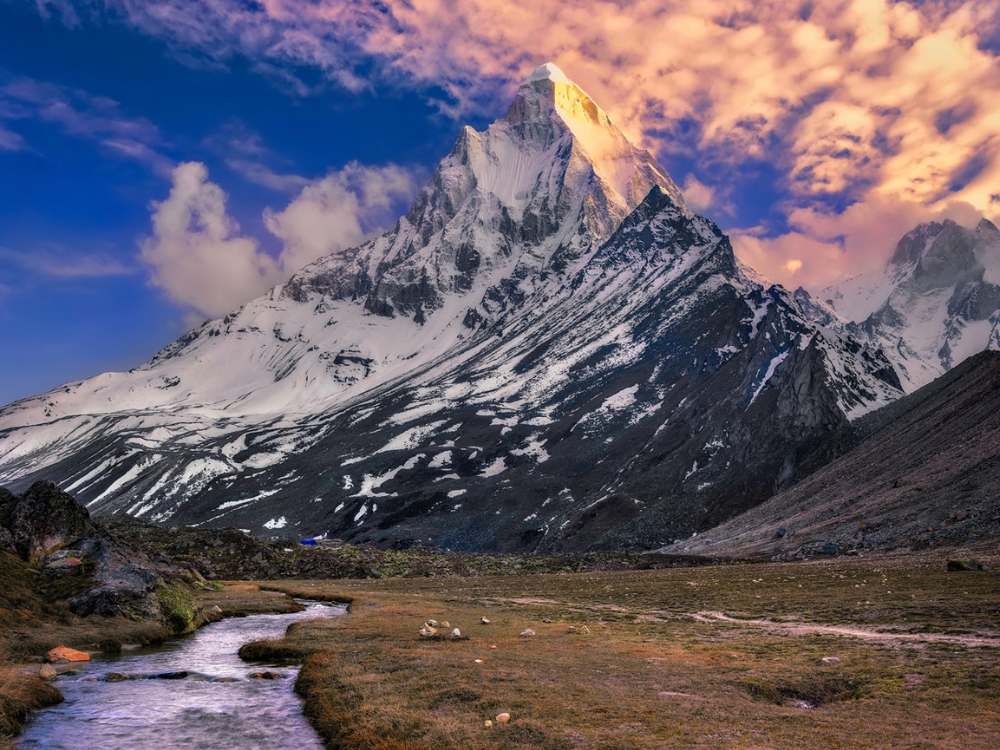
The Gaumukh Tapovan Trek is an all encompassing voyage set in the Gangotri National Park with Mt. Shivling and Bhagirathi Peaks being the most prominent mountains that keep you company throughout. The trail snakes through lush green valleys, stunning landscapes, steep ascents and finally lands you at the terminus of The Gangotri Glacier – Gaumukh.
It is where the Bhagirathi River comes to life which is the primary source of River Ganga that bestows life upon the entire nation with its sacred energy and unwavering raw power.
This is a trek for the brave hearts, nature enthusiasts and spiritual seekers who seek the extraordinary in life. The trails are a mix of steep ascents, long meadow walks, boulder crossing and tough climbs that reward you with not just beguiling views all along the way but also a sense of satisfaction and achievement.
- Difficulty Level : Moderate
- Altitude :14,600ft
- Trek Length : 46 km
- Duration : 8 Days
READ MORE ABOUT THE ITINERARY : HERE
Gaumukh Tapovan Trek Route Map
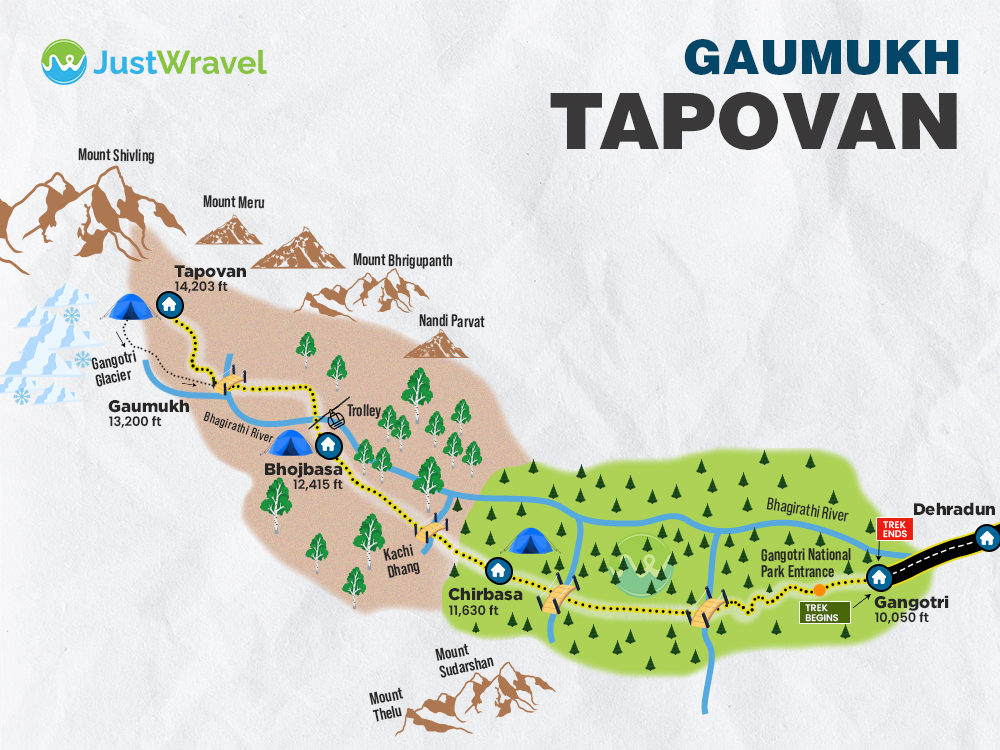
Short Itinerary of Gaumukh Tapovan
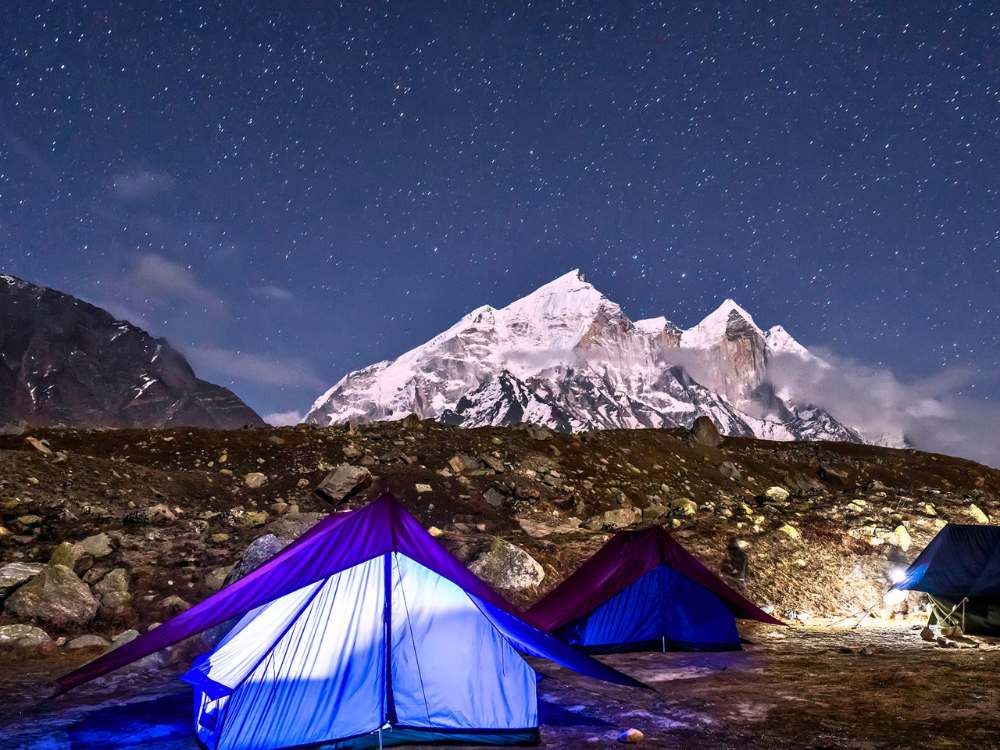
Gaumukh Tapovan is a 8 Day trek that starts from Gangotri Village and takes you through a cluster of quaint villages, dense jungles and slowly rocky terrains around the Gangotri Glacier.
The trek is an amalgamation of easy walks and climbs gradually ascending up with parts where you would need to climb boulders , cross rivulets and finally reach at the base of Mt. Shivling and Bhagirathi Peaks. For a long stretch, the Bhagirathi River flowing ferociously keeps you company, the sound of gurgling water and each step beckoning you closer to the Great Himalayan Peaks motivates you to keep going.
When you reach, you are bestowed with an ultimate level of bliss and satisfaction as in a place as sacred as Gaumukh, tranquility is bound to prevail.
Here is a brief Itinerary of the Gaumukh Tapovan Trek –
Day 1 : Dehradun to Gangotri Village (241 kms, 8 hours)
The journey begins from Dehradun Railway Station where the group assembles early in the morning and takes their time getting to know each other. At around 8am we set out on a road journey to Gangotri traversing the surreal sceneries Garhwal Uttarakhand has to offer.
On the way we will be crossing many known towns of Uttarakhand like Mussoorie, Tehri and the gorgeous Harsil Valley . The 8 hour drive is soul satisfying and mingles up your excitement for the upcoming days of adventure.
Day 2 : Acclimatization Day in Gangotri
Gangotri is one of the char dhams and has been a popular Hindu pilgrimage site for hundreds of years. It is a town settled by the Banks of Bhagirathi river that meets Alaknanda in Dev Prayag to form the Ganges. Perched at an altitude of 11000 ft and cradled by snow clad Himalayas, glaciers and lush forests, the place’s divinity can be felt as soon as you set feet here.
Today, you take some time to wander around this sacred place, visit the Ganga Mata Temple right in the heart of the town and other significant places like Bhagirath Shila and Pandava Gufa. Atleast 20+ hours is needed to get acclimatize to the weather for a safe and comfortable trekking experience.
Day 3 : Gangotri to Chirbasa Trek ( 9kms, 6 hours)
Today you start your first day of trek from Gangotri and head towards Chirbasa , the first and most bewitching campsite. The walk is easy at first with slight inclines and takes you through the Gangotri National Park, unraveling an abundance of rare flora and fauna that adds a splash of color to your trip.
As you keep walking, the Sudarshan Peak comes into full view and tiny streams and the sound of water keep you company throughout.
Day 4 : Chirbasa to Bojhbasa Trek ( 5kms, 3 hours )
The next morning we start our trek to the 2nd campsite, Bhojbasa . Today’s trek is comparatively easier as the valley opens up and there’s wide stretch of land to walk upon, run and just overall enjoy the trekking experience. The scenery now looks absolutely stunning as you can see the canopies fading in the background and the Snow Clad peaks becoming clearer as you keep walking.
The silver birch trees, glimmering river and clear blue skies make the entire scenery look like a carefully stroked painting. Upon reaching, you get to witness a truly beautiful sunset and spend the night resting and preparing for the next day.
Day 5 : Bojhbasa to Tapovan ( 9kms, 7 hours )
Today you trek to Tapovan – a wide stretched almost barren meadow that holds a great significance in the Hindu Mythology.
Interesting Fact Tapovan is known to be the place where Lord Ram and Laxman meditated for many months. It is also where sadhus and rishis head for spiritual awakening by diving into deep meditation.
The trek to Tapovan is slightly more difficult than the last day but the views of the peaks and the very aura of the place makes you forget about the arduous journey as your mind gets calmer with every passing step.
Tapovan allows you to capture panoramic views of vast stretches of land, rivers flowing right through them and Mt. Shivling hanging in the backdrop as every step gets you a little closer to divinity.
Day 6 : Trek to Gaumukh ( 9kms, 6 hours )
Waking up to azure sunrises with Mt. Shivling glowing in bright golden is a moment that will be etched in your heart forever. As we begin the trek to the Glacier, the trails become harder to climb as there are huge boulders and rocks that need to be crossed to reach the origin of the river.
After a few hours of arduous climb you can feel the freezing cold wind hit your face, giant peaks visible from toe to head and a sense of nirvana taking over you. The glacier walk is slightly tricky and difficult, however, with teamwork and dedication, you can easily cross it.
As you approach Gaumukh, you can actually see the gigantic Glacier shaped like a cow’s snout from under which the river gurgles its way to the lands. Witnessing this miracle with your naked eyes and just soaking in the entire scenery is undeniably the greatest feeling.
You can sit and meditate here for a few minutes but it is recommended that you do not stay for too long to avoid health issues. This day, you experience the true power of the Himalayas and how sacred some places are, the energy here is bound to heal parts of you and make you feel just so invincible.
Day 7 : Bojhbasa to Gangotri Trek
After spending a glorious night under a starry sky and to have witnessed the origin of Ganges is an incredible feeling. With that feeling in our hearts, we begin our descent down to Gangotri trekking through similar routes and stopping every now and then for a few minutes to look around and feel truly humbled to have experienced the extraordinary.
The trek can get tricky at many points as you have to climb down boulders and cross narrow paths, but having felt what you did at Gaumukh, you know it is all worth it in the end.
The river keeps you company throughout the 8 hours of trek down, find some time to dip your face in the holy water and just sit and meditate for a few minutes. Later at night once you have reached, treat yourself to a soulful dinner and take rest.
Day 8 – Gangotri to Dehradun
Today marks the end of a beautiful journey. Waking up in the bustling town of Gangotri you reminiscence about the moments spent trekking in wilderness and with a heavy heart yet loads of memories start your drive back to Dehradun.
The drive is without a doubt a scenic one, watching rivers flow through valleys, countless small waterfalls, quaint villages and the holy confluence of Alaknanda and Bhagirathi at DevPrayag.
Interesting Fact It is said that ages back, in a small village near Gangotri lived a boy who had great devotion towards Lord Shiva. He was a shepherd and took great care of his sheeps and cows. One fine day, he noticed that one of his cows had gone missing and worried about its safety, he ventured into the Great Himalayas. After a long and arduous journey, he found his beloved cow at the pout of the glacier that resembled a Cow’s Mouth, encapsulated by the view in front of him, he decided to name the place ‘Gomukh’ Having felt a divine energy there, he believed that the place was an abode of Lord Shiva himself. The story continues to be a famous folklore in the region till date but what’s undeniable, is the energy that you feel at Gaumukh that is truly sacred and divine.
SUGGESTED RAED: BEST POST-MONSOON TREKS
WHO CAN DO THE GAUMUKH TAPOVAN TREK?
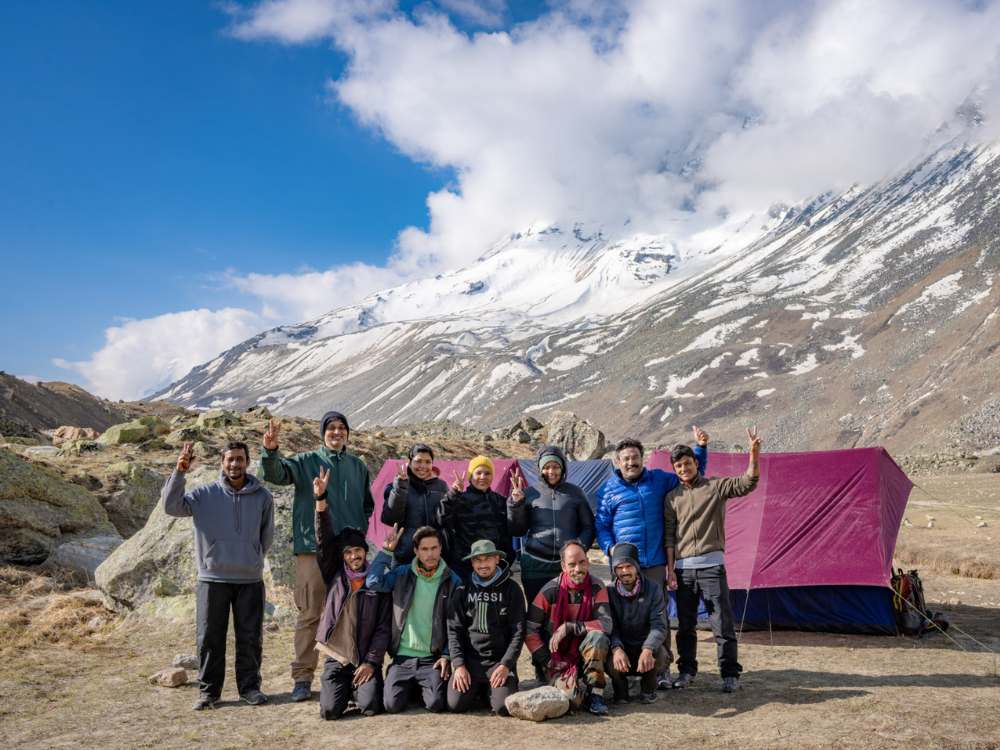
The Gaumukh Tapovan Trek is of Moderate – Difficult level because of the altitude, long climbs and tricky glacier walk as you approach Gaumukh. One must have prior experience in Trekking to do this trek with ease. However, if you are a novice trekker, you can still complete this trek with dedication, motivation and under the guidance of an experienced trek lead. There are hundreds of people who experience the Ganges at its source and these people are not travelers but rather devotees. It is the zeal that burns inside them that keeps them going regardless of the difficulty.
- The trek is at an elevation of 14,600 ft and the temperatures drop to 1-2 degrees at night. If you have trekked at similar altitudes before, the weather will not be too uncomfortable for you.
- For beginners, it is recommended that you train for at least 3 months to conquer this trail with ease and comfort. Some of the very basic preparations you can do is –
- Stamina Training
- Running around 4 kms per day
- Building Strength Core
This trek also requires you to carry a backpack that consists of all your necessary items and thus, you need to be physically fit to complete this trek.
It is essential that you understand the trails that you are going to walk upon for a safe and rewarding trekking experience. Places as sacred as this one requires one to be aware of the fact that this is not just a trek you do for fun but one that elevates your overall perspective on life. One shall be physically fit enough to not just have a surreal experience but also help other members of the team to have the same.
HOW TO REACH GAUMUKH TAPOVAN?
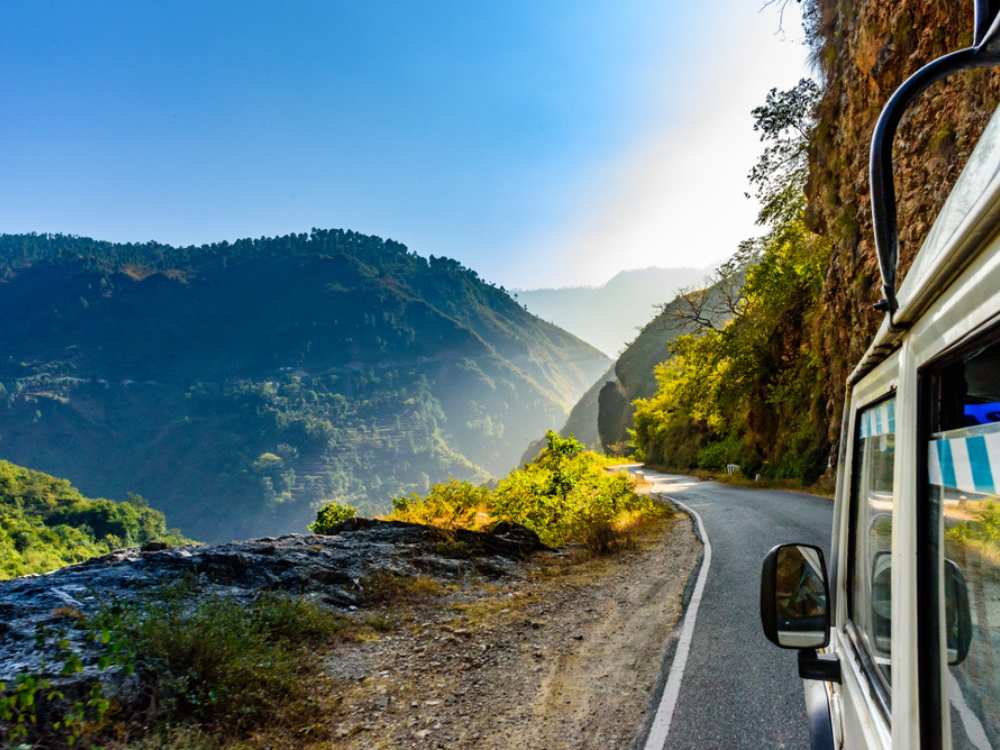
The Gaumukh Tapovan trek starts from Gangotri, a small town in the heart of Garhwal Uttarakhand and is easily accessible via road. If you are traveling from North India, you can reach here by road and if you are traveling from other states of India you’ll need to take a train or flight to Delhi / Dehradun first.
By Road – Dehradun is around 250 kms from Delhi and can easily be reached within 6 hours. Best way is to travel overnight via Car or Bus and reach Dehradun early in the morning from where you can take yet another bus or taxi to Gangotri.
- Delhi – Dehradun – 241 kms, 6 hours
- Dehradun to Gangotri – 236 kms, 8-9 hours
By Flight – The nearest airport to Gangotri is the Jolly Grant Airport in Dehradun. One can find consecutive flights flying from Delhi – Dehradun. Further which, you can take a bus or cab to Gangotri.
By Train – The nearest railway station is again the Dehradun railway station . There are a handful of trains that run from all over India and drop you here from where you can easily find local buses and taxis for Gangotri.
To have a hassle free trip, it is recommended that you plan at least 2 months ahead and book all the necessary tickets to avoid any last minute worry and have an amazing trip.
THE BEST TIME TO DO THE GAUMUKH TAPOVAN TREK?
August – October
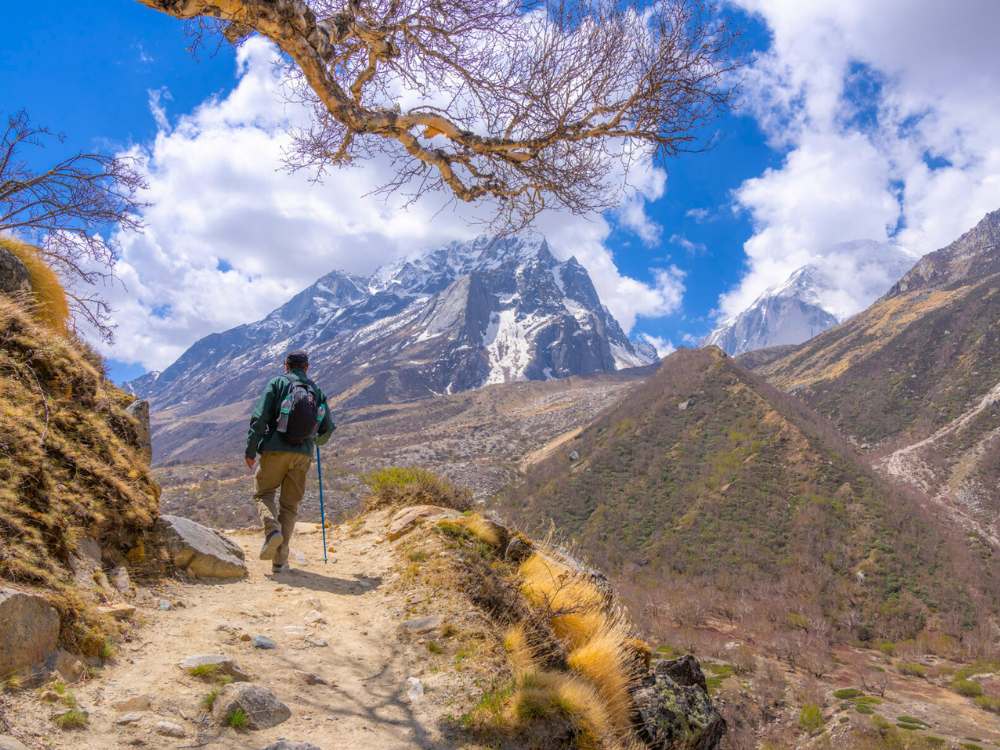
The Gaumukh Tapovan Trek looks the most colorful during the post-monsoon months, making it the best time to visit. Once the rain has settled and the roads are safe to travel, you can witness a mix of greenery and amber shades that paints the valley in a cascade of colors.
During these months, the skies are mostly clear, giving you the chance to stargaze almost every night from the camps. The best part is not just that but also the fact that the Bhagirathi River looks clear blue during these months making the overall scenery look stunning!
The temperature during this time stays around 12-15 degrees in the afternoon and falls as low as 0 degree at night which is pretty normal for such a high altitude trek.
Note : The Post-Monsoon Season for this trek lasts barely 4-6 weeks and by mid October, the first snow falls covering the region in a blanket of snow.
April – June
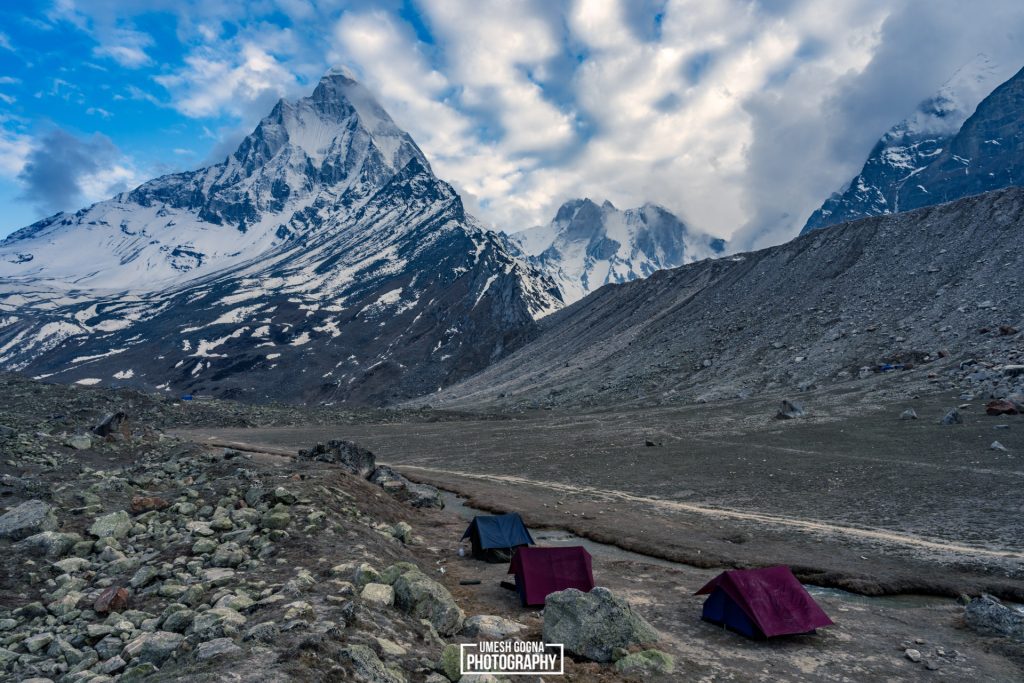
For those who are drawn to snow, Summer is a good time to do the Trek when the entire valley is blanketed in a thick layer of snow making it look nothing short of a winter paradise! There are also patches of the river and streams that stay entirely frozen and you get to cross over them.
This is also a popular time for devotees to embark on this trek as a part of the Char Dham Yatra. As July approaches, the trails become rather difficult to traverse upon and even risky as the melting snow adds huge force to the flow of Bhagirathi River.
Overall, it is recommended that you do this trek right at the onset of Summers or the best, in Autumn when it’s the safest and the weather is pleasant.
RECOMMENDED : Valley of Flowers Trek Guide
HIGHLIGHTS OF THE GAUMUKH TAPOVAN TREK
Bhagirathi river.
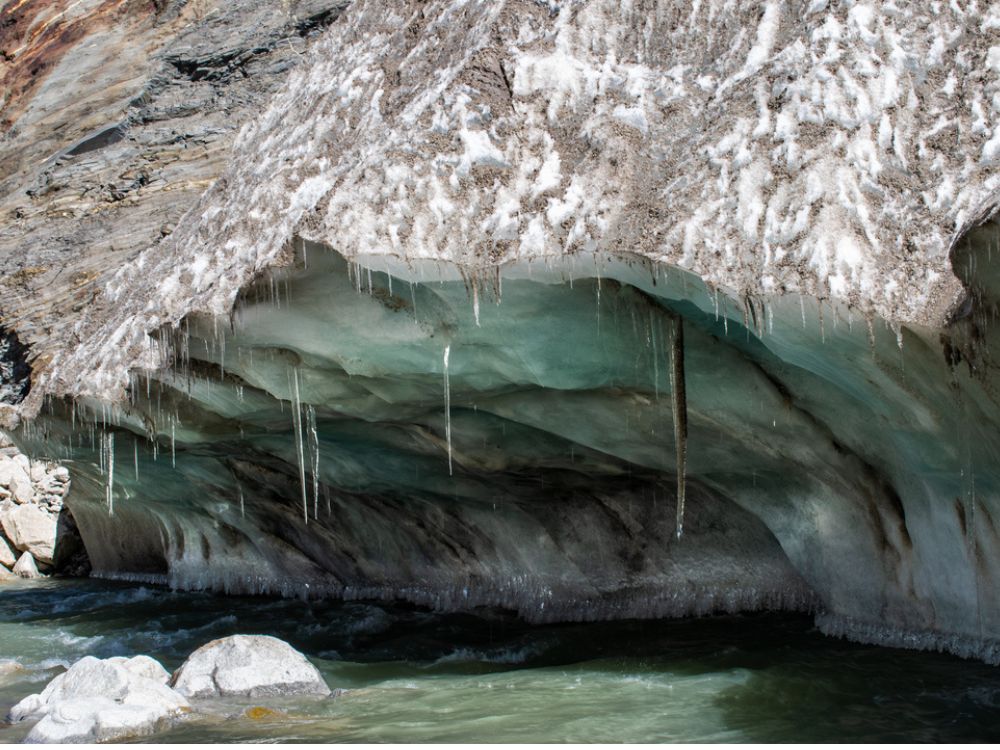
The origin of this River from Gaumukh, the terminus of Gangotri Glacier is considered to be one of the holiest spots for Hindus. It holds a massive significance in the Hindu Mythology as it is believed Shiva unlocked the Ganges from his hair and she landed on Earth at this very spot.
A dip in Ganga is considered to be sacred and it is believed one’s sins are washed away in its waters and to take that dip right where the river originates, is nothing short of an extraordinary experience.
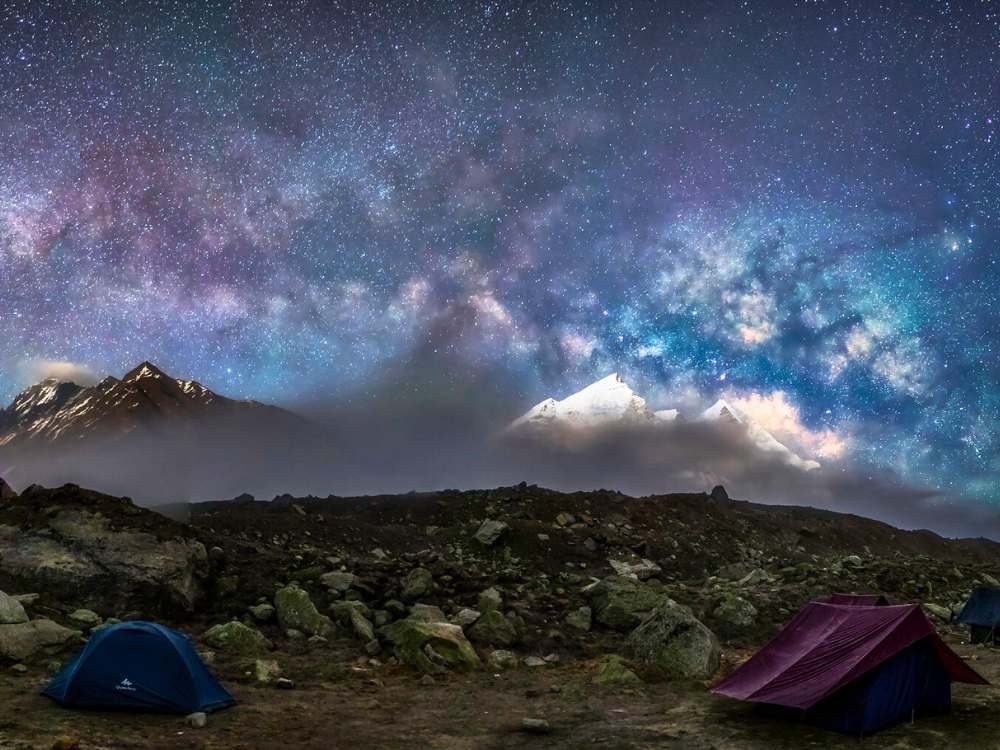
When translated, Tapovan means ‘ Forest of Mediation’ as tapas means ‘meditation’ and van means ‘forest.’.The Gaumukh Tapovan holds a major significance in Hindu mythology and exudes a magic of its own. Perched at the base of Mt. Shivling Tapovan’s vast and barren lands till today remain a sacred place for meditation, penance and spiritual awakening for many sages and yogis.
When wandering around Tapovan, you will sense a different kind of calm that seeps into your mind and soul. Tapovan is a place of timeless beauty, where spirituality flows with the wind and mountains like the Shivling, Bhagirathi Massif, Mt. Meru protects this magical land.
Mt. Shivling
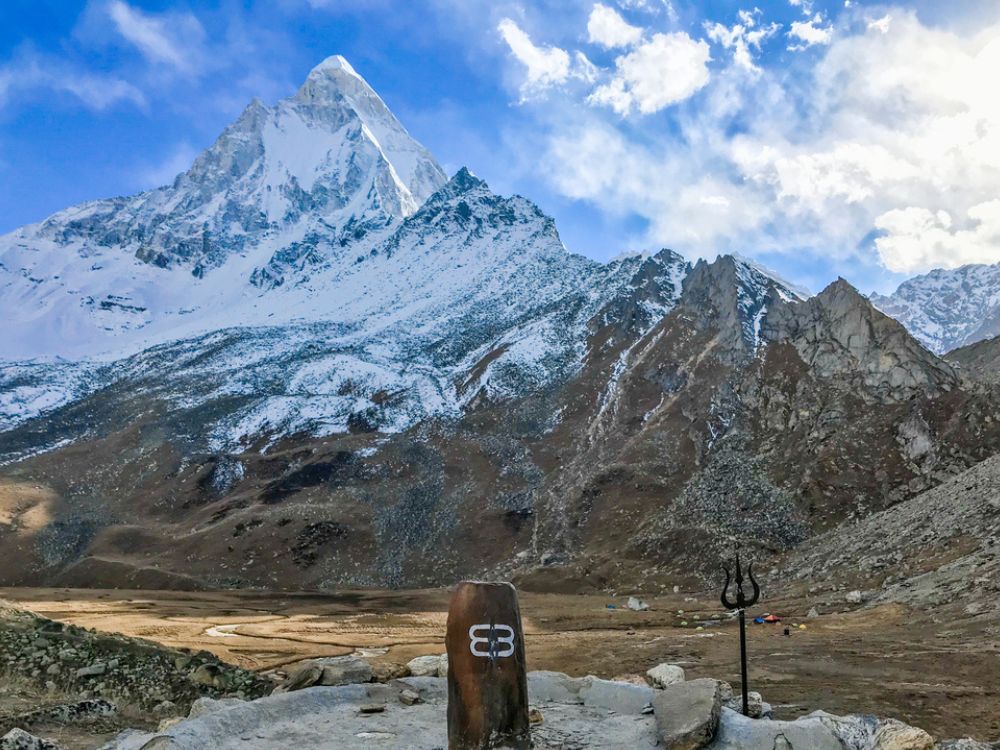
The Great Himalayas are indeed a blessing to this earth and Mt. Shivling is a living example that the beauty of the Himlayas are truly unmatched. Considered to be one of the most beautiful mountains in India, the might of Mt. Shivling is best witnessed from the Gaumukh Tapovan trek.
On this trek, you do not just catch glimpses of the summit but watch it rise right in front of your eyes from toe to head, looking absolutely magical to say the least. As you gaze up, eyes beaming with what is laid in front of you, you feel like a tiny speck in the universe yet your heart is filled with so much fulfillment and gratitude.
Bhagirathi Peaks
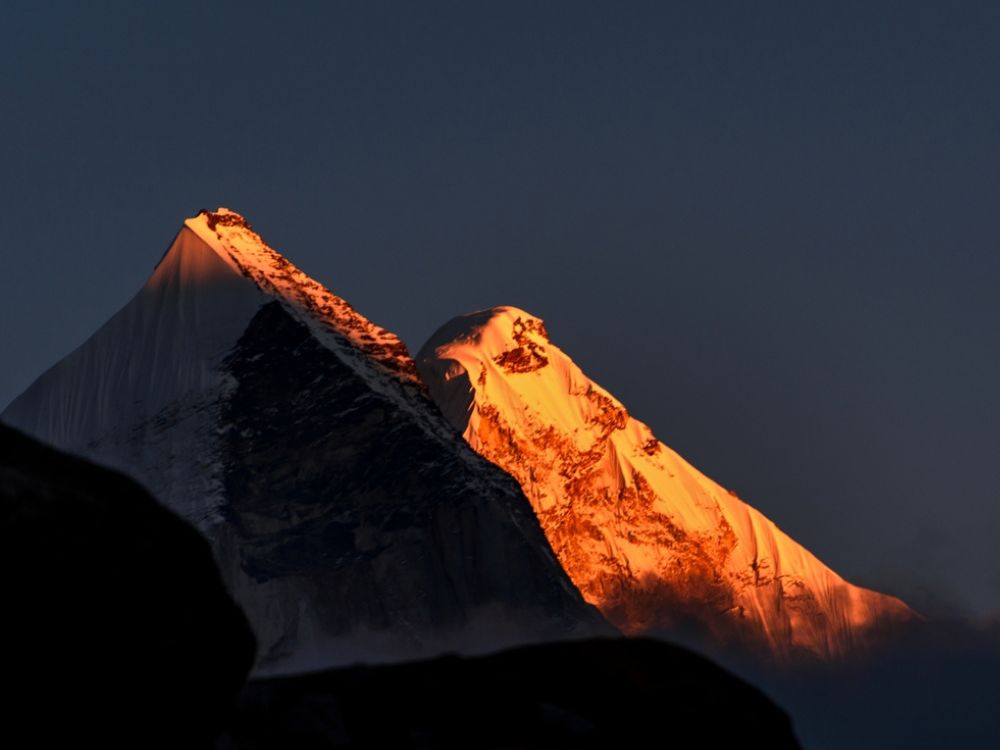
You cannot compare the beauty of one mountain to another, they are unique and hold their very own special significance. Three gigantic peaks together forming a massif, risen right in front of you with the snow laden peaks shining like diamonds, you will be left absolutely awe-struck as every step brings you closer to this massive mountain peak.
Gangotri National Park
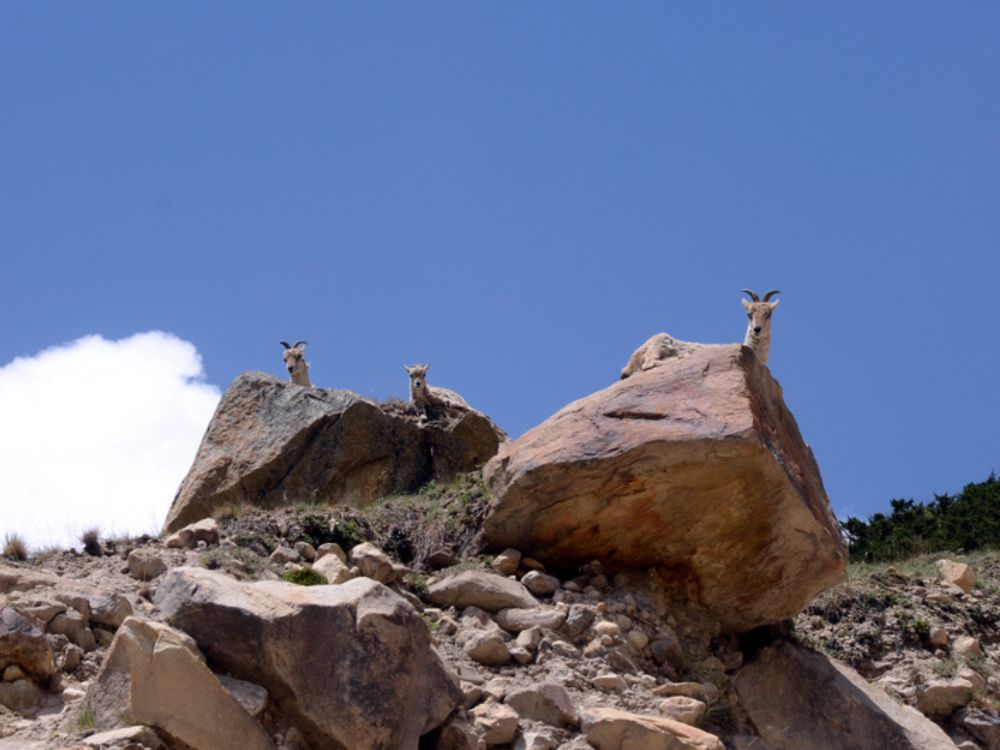
The trail is enclosed by the Gangotri National Park which is one of the highest Wildlife Sanctuaries spread lavishly over 2390 square kms in the Uttarkashi district of Uttarakhand. When walking through the park, you can feel every inch teeming with life as sounds of birds, insects and gurgling water keep you company throughout.
The landscape is speckled with coniferous, deodar, pine and oak trees and snow laden Himalayan Peaks hang high above in the background throughout. It is also home to the rarest species of Wildlife like the elusive Snow Leopard, Bharal, Black Bear, Musk Deers and around 150 species of Birds.
The entire trail that snakes through the National Park lets you witness an abundance of flora and fauna, refreshing and reviving your senses as you go along.
EXPLORE NOW : BEST HIMALAYAN TREKS
LEARN WITH JW!!

Hello dear readers/adventurers/future explorers,
Remember we started a session called Learn with JW in the previous blog! This is the 2nd episode of the same and we are here to tell you all about how to conquer a trail with ease and confidence! Our aim here is not explaining something complicated or difficult but reminding you of some of the stuff you already knew.
This session is to remember your old school friend who explained to you the whole syllabus just before the exam day. We all remember that information till day. Let JustWravel be that friend…
A lot of people have this misconception that walking faster and taking long steps would help them finish the trek sooner. However, the real trick is taking micro-steps that helps one tremendously in conquering an uphill climb without getting completely exhausted.
Here’s how it works –
Control and Stability: When climbing uphill, the terrain can be uneven, and the slope may vary. Taking shorter, controlled steps allows you to have better stability and balance. It helps you find secure footholds and maintain your center of gravity over your feet, reducing the risk of slipping or stumbling.
Conserves Energy: Uphill climbs require more effort and can be exhausting. By taking small steps you reduce the amount of energy required for each step, which helps you conserve energy over the course of a long ascent. This energy conservation is especially crucial for multi-day treks or hikes with significant elevation gain.
Reduces Strain: Larger steps or strides during uphill climbing can put excessive stress on your knees and leg muscles. Micro steps distribute the workload more evenly across your muscles, reducing strain and the risk of injuries such as knee pain or muscle cramps.
Better Breathing: Smaller steps can help you regulate your breathing more effectively. By coordinating each breath with the step, inhaling and exhaling in sync with the movement, you can improve your stamina and endurance during the uphill climb.
Mental Advantage: Taking micro steps allows you to focus on small, achievable goals rather than the overwhelming challenge of a steep incline. Mentally breaking the ascent into smaller steps can make the climb feel more manageable and less daunting.
Safer Descent: Additionally, when climbing uphill, you have to consider the descent later on. Taking smaller steps helps condition your muscles and joints for the downhill journey, reducing the risk of impact-related injuries on the way back.
In the end, just remember that Trekking is not a task but a fun experience..so come what may, enjoy every bit of the trek because it is the journey that matters, not the destination. Happy Trekking!
WHICH IS ANOTHER POST-MONSOON TREK THAT YOU CAN DO?
If you are a trekking enthusiast and love the idea of conquering difficult peaks and summits, then Friendship Peak Trek in Himachal is an ideal trek for you!

Post-Monsoon landscapes of Himalayas are truly a blessing as nature’s thriving and skies are clear. The Friendship Peak Expedition is a difficult yet rewarding summit trek in the Pir Panjal Range that challenges your endurance and stamina. But when you finally go ahead to reach the top, you see the entire world unravel below you and that is a feeling that leaves an indelible mark on your soul.
Here’s ALL you need to know about The Friendship Peak Expedition.
FAQ’S for Gaumukh Tapovan
Q1. i have done easy treks before, will i be able to do the gaumukh tapovan trek.
The Gaumukh Tapovan trek is a Moderate level 5 Day Trek that takes you through the Gangotri National Park and lands you at the origin of the Ganga River, at Gaumukh. The trek includes long steep climbs, boulder crossing and at points just hiking on steep ascents. So if you have done other treks before, you can easily do this trek with some practice and prior training as it requires one to be physically fit. Remember, that every difficult journey is possible with dedication and if you truly want to embark on this trek, you’d be able to do it!
Q2. How do I pack for Gaumukh Tapovan Trek?
The Gaumukh Tapovan Trek is perched at an altitude of 14, 600 ft which makes it a high-altitude trek. So one is required to carry enough warm clothes along with other necessary items of daily use as you will not be finding any shops once you have started on the trek. Every trekker will be carrying their backpacks that consist of clothes, medicines, toiletries and other basic necessities. Here’s a list of all the things you need to pack!
Q3. Can I do the Gaumukh Tapovan Trek with my parents?
Devotees of all age from around the world consider Gaumukh Tapovan as pilgrimage and not just trek and venture into this journey to witness the source of Ganga. So if your parents are physically fit, can train for a few months before the trek and do not have any major underlying health conditions, they can surely do this trek with proper guidance. The best way is to choose a trustable trekking community with a guide who can help them each step of the way and make sure you have a good trekking experience without any hassles.
Q4. Is Gaumukh Tapovan Trek safe?
The Gaumukh Trek is an absolutely safe one whose trails have existed for decades. Earlier, people only used to visit Gangotri but with an increase of trekking enthusiasts in India, many people now visit Gaumukh. The only recommendation here would be to trek with an expert travel guide who is well aware of the region and to travel during Summers or Autumn. It is also necessary that you acclimatize yourself for a day to avoid any symptoms of AMS. One must be fully aware of what AMS is and how can you avoid it. Read about it here.
Being here, feeling the divine presence of the Creator, watching the Highest Mountain Peaks beckon you closer and dipping in the freezing cold water..is the only way to know the true meaning of Peace.
Leave a Comment X
Save my name, email, and website in this browser for the next time I comment.
12 Comments
Thanks Raima Raj for providing such detailed information about this trek. This will help me in planning my travel.
Hello Ma’am, it is my pleasure to share this story with you! Hoping you will also allow us the chance to take you here someday. Keep supporting 😀
Excellent work. Informative and attractive.
Hello Sir! This means a lot to me. Will surely keep getting better at it, your support is highly apericiated 😀
Elaborate and very informative picturesque divine place to visit
Hello Sir, thankyou so much for reading. Really grateful for this feedback, do keep supporting! 😀
Such an interesting story to read ❤️
Hi Puja, this means a lot! Thankyou for reading <3
Really helpful blog
Thanks Justwravel
Thanks Ankur! This Blog will surely help you when you are planning this trek. Keep reading and supporting 😀
Very well Described. Loved it !!
Means a lot Ojaswa! Thankyou so much <3
About the author
You may also like

Things to know before planning Sikkim Trip
Kedarkantha trek winter’s paradise.

7 reasons to do Sar Pass Trek

Best Places To Visit In Bali | Bali Tourism
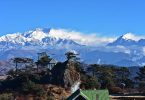
Sandakphu Trek – A captivating journey through...

The Life Of a Solo Woman Traveler

Gaumukh Tapovan Trek
The trail passing over the origin of holy ganga river to the base camp of shivling, gaumukh tapovan trek overview.
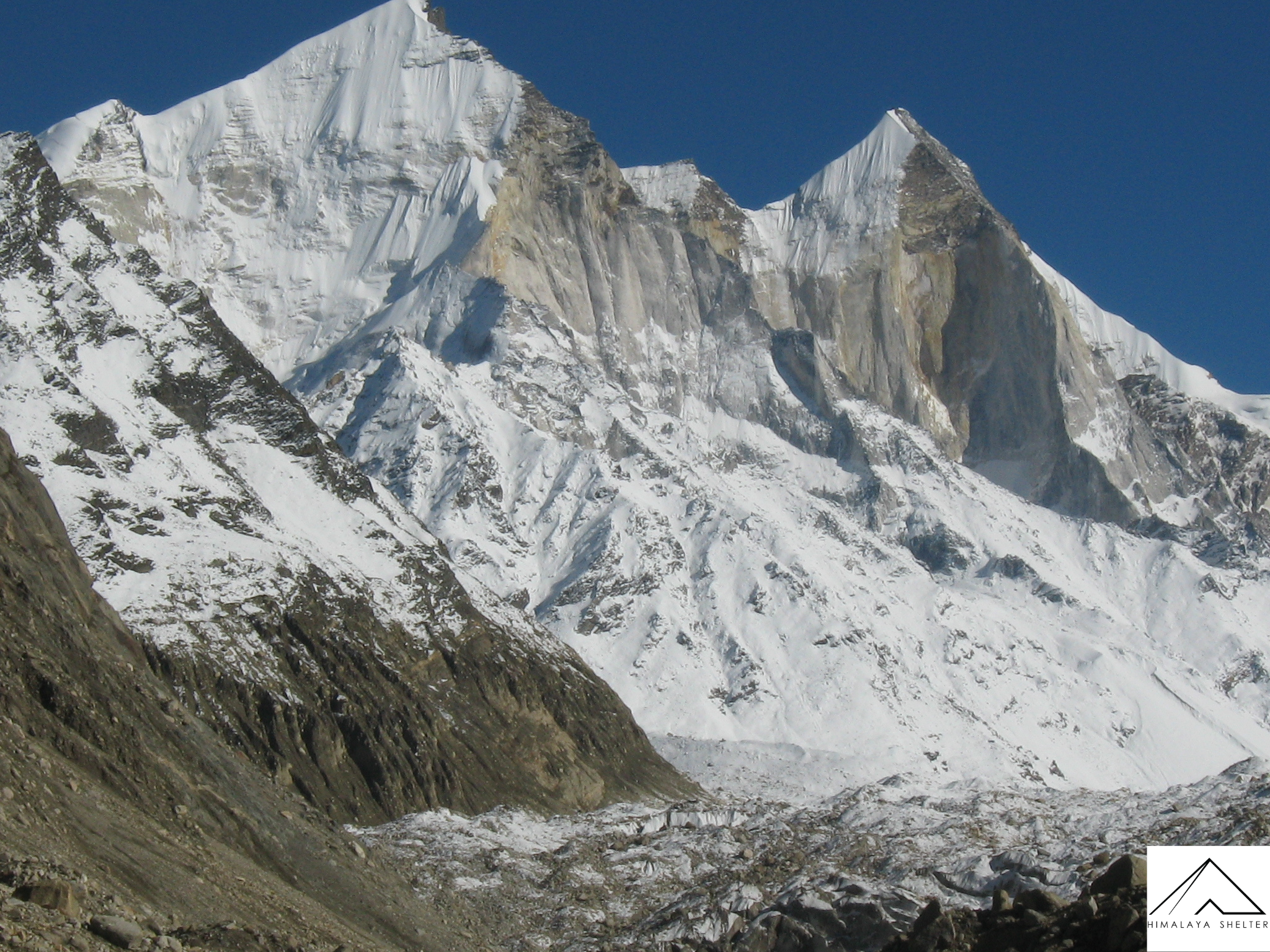
Gaumukh Tapovan Trek Route
Things that need to be carried:.
- Backpack: A sturdy and comfortable backpack is essential for carrying all the necessary gear and supplies for the trek. Look for a backpack with good support, padding, and ventilation.
- Trekking shoes: A good pair of trekking shoes is essential for the rugged terrain and high altitudes. Look for shoes with good ankle support, waterproofing, and sturdy soles that can handle rough terrain.
- Warm clothes: The temperature drops significantly at high altitudes, and it's important to carry warm clothes like fleece jackets, thermal innerwear, and gloves to stay warm.
- Rain gear: The weather in the Himalayas can be unpredictable, and it's important to carry rain gear like a waterproof jacket and pants to stay dry in case of rain.
- Sunscreen and sunglasses: The sun can be intense at high altitudes, and it's important to carry sunscreen with high SPF and sunglasses to protect the skin and eyes from the harsh UV rays.
- Water bottles : Staying hydrated is essential for trekking at high altitudes, and it's important to carry at least two water bottles and a water purification system like a water filter or tablets.
- Snacks: Trekking at high altitudes can be physically demanding, and it's essential to carry high-energy snacks like energy bars, nuts, and dried fruits for quick energy boosts.
- First aid kit: A well-stocked first aid kit with essential medicines, bandages, antiseptics, and pain relievers is crucial in case of any injury or illness on the trek.
- Headlamp or torch: Trekking at high altitudes involves early morning and late-night hikes, and it's important to carry a headlamp or torch for navigating in the dark.
- Personal toiletries: Carry personal toiletries like toothbrushes, toothpaste, hand sanitiser, and wet wipes for personal hygiene.
How to make the most out of your trek:
- Fitness: The Gaumukh Tapovan Trek is a challenging trek that requires a good level of fitness. It is important to prepare by doing regular exercise and building up your stamina. You may want to do some hiking or trekking in your local area to help prepare.
- Altitude: The trek reaches high altitudes, with the maximum elevation at Tapovan being over 4,500 meters. It is important to acclimatize properly and take the necessary precautions to avoid altitude sickness. It is recommended to spend a few days in Gangotri or nearby areas to acclimatize before starting the trek.
- Weather: The weather in the Himalayas can be unpredictable, with sudden changes in temperature and weather patterns. It is important to pack warm clothes, a raincoat, and a good quality sleeping bag. It is also recommended to check the weather forecast before starting the trek and to listen to the advice of your guide.
- Gear: You will need a good-quality backpack, trekking shoes, a walking stick, sunglasses, sunscreen, and a hat. It is also recommended to bring a water bottle, a first aid kit, and some snacks to keep you energized along the way.
- Guide and permits: The Gaumukh Tapovan Trek is a protected area, and you will need to obtain a permit from the Forest Department to enter. It is also recommended to hire a local guide to help you navigate the trail and provide you with valuable information about the area and the culture.
Best Time to Visit Gaumukh Tapovan Trek:
Gaumukh tapovan trek cost:.
- Permit fees: To enter the protected area of the Gaumukh Tapovan Trek, you will need to obtain a permit from the Forest Department. The permit fees are typically around INR 1500 per person.
- Guide fees: While it is possible to trek the Gaumukh Tapovan Trek independently, it is recommended to hire a local guide for safety and navigation purposes. Guide fees can range from INR 1500-2500 per day, depending on the level of experience and expertise.
- Accommodation: The trek offers various accommodation options, ranging from basic guesthouses and homestays to more luxurious hotels and lodges. The cost of accommodation can vary from INR 500-3000 per night, depending on the type of accommodation and the amenities provided.
- Transportation: The cost of transportation will depend on your starting point and mode of transportation. If you are starting the trek from Gangotri, you can reach there by road or by air from Delhi. The cost of a one-way bus ticket from Delhi to Gangotri can range from INR 500-1500, while a one-way flight can cost around INR 5000-8000.
- Food and supplies: The cost of food and supplies will depend on your preferences and dietary requirements. It is recommended to bring some snacks and energy bars for the trek. The cost of meals at local restaurants can range from INR 200-500 per meal.
Fitness preparations for the trek:
- Cardiovascular exercises: Build your endurance by engaging in cardiovascular exercises such as running, cycling, swimming, or brisk walking. Start with moderate intensity and gradually increase the intensity and duration of your workout.
- Strength training: Build your leg muscles and core strength with exercises like lunges, squats, step-ups, and planks. Strengthening your upper body with exercises such as push-ups, pull-ups, and shoulder presses can also help you carry your backpack and trekking gear comfortably.
- Flexibility training: Improve your flexibility with yoga, stretching, and mobility exercises. This will help you avoid injuries and maintain proper posture during the trek.
- Altitude training: As Tapovan Nandanvan Trek involves high altitudes, acclimatization is crucial. Try to acclimatize yourself by spending time at high altitudes before the trek, or consider taking medication to aid in altitude sickness.
- Mental preparation: The trek is not only physically demanding but also mentally challenging. Try to build mental toughness by setting realistic goals, visualizing the trek, and staying positive.
- Proper nutrition: Proper nutrition and hydration are crucial for building and maintaining stamina during the trek. Include a balanced diet that provides enough protein, carbohydrates, and healthy fats to fuel your body.
Gaumukh Tapovan Trek Itinerary
Day 1 drive from dehradun to gangotri via uttarkashi.
Drive: 240 km, 8-9 hrs
Altitude: 2,100 ft (640 m) – 10,000 ft (3,048 m)
Accommodation: Guest House / Hotel
Meals: Dinner
On the first day of the trek, trekkers arrive in Gangotri, which is situated at an altitude of 3,100 meters. Gangotri is a small town that is known for its religious significance as the starting point of the Ganges river. The town is also the gateway to several trekking routes in the region, including the Gaumukh Tapovan Trek. Trekkers spend the day exploring the town, visiting the Gangotri Temple, and acclimatizing to the high altitude. The day is spent resting and getting to know fellow trekkers, who come from all over the world to experience the natural beauty and spiritual significance of the trek.
Day 2 Trek from Gangotri to Chirbasa
Trek: 9 km, 4-5 hrs
Altitude: 10,000 ft (3,048 m) – 11,811 ft (3,600 m)
Accommodation: Camping (Alpine Tents)
Meals: Breakfast + Lunch + Evening Snacks + Dinner
On the second day of the trek, trekkers start their journey from Gangotri and follow the Bhagirathi River upstream. The trail is mostly flat and passes through dense forests of pine and deodar. Trekkers can hear the sound of the river in the background and catch glimpses of the surrounding mountains through the trees. The first campsite is at Chirbasa, which is named after the abundance of trees in the area. The campsite offers stunning views of the surrounding mountains, and trekkers can spend the evening relaxing and acclimatizing to the higher altitude.
Day 3 Trek from Chirbasa to Bhojbasa
Trek: 5 km, 3 hrs
Altitude: 11,811 ft (3,600 m) – 12,467 ft (3,800 m)
The third day of the trek involves a relatively short but steep ascent to Bhojbasa, which is situated at an altitude of 3,800 meters. The trail continues along the Bhagirathi River. The views along the trail are stunning, with towering mountains in the background and the sound of the river in the foreground. The campsite at Bhojbasa is situated at the foot of the Gangotri glacier, and trekkers can see the glacier in the distance. The campsite offers a stunning view of the Bhagirathi peaks, which are bathed in golden light during sunrise and sunset.
Day 4 Trek from Bhojbasa to Gaumukh to Tapovan
Trek: 6 km, 7 hrs
Altitude: 12,467 ft (3,800 m) – 12,795 ft (3,900 m) – 14,222 ft (4,335 m)
The fourth day of the trek is the highlight of the journey, as trekkers visit the source of the Ganges river at Gaumukh. The trail from Bhojbasa to Gaumukh is steep and rocky, and the last stretch involves crossing the Gangotri glacier. The glacier is a surreal landscape of ice and rocks, and trekkers need to be careful while walking on it. After reaching Gaumukh, trekkers can take a dip in the icy-cold water and offer prayers at the temple. We then proceed to Tapovan from Gaumukh. The route from Gaumukh to Tapovan is a steep and short climb. It takes about 2-2.5 hrs to reach there. Set up your camps at Tapovan and enjoy the the majestic views of Meru peak, Bhagirathi I,II,III peaks. Tapovan also acts as the base camp for Shivling and Meru offers grand majestic views of Shivling peak.
Day 5 Rest day Tapovan
Altitude: 14,222 ft (4,335 m)
Rise early in the morning to enjoy the spectacular sunrise that turn the towering peaks of Shivling, Bhagirathi I,II,III and Meru on fire.
The area around Tapovan is known for its stunning natural beauty and spiritual significance, and trekkers can spend the day taking in the sights and sounds of the surrounding mountains. The Shivling peak is a highlight of the area, and many trekkers spend the day exploring its base or meditating in its shadow.
Day 6 Trek from Tapovan to Chirbasa
Trek: 11 km, 6 hrs
Altitude: 14,222 ft (4,335 m) – 11,811 ft (3,600 m)
This is a long walk from Tapovan to Chirbasa is over 10-11 km but since you will be going downhill, you would not take as much time as it took to climb up. You will have a packed lunch en route and reach Chirbasa by late afternoon. Camp the night under the starry skies at Chirbasa.
Day 7 Trek from Chirbasa to Gangotri
Trek: 9 km, 5-6 hrs
Altitude: 11,811 ft (3,600 m) – 10,000 ft (3,048 m)
Retrace the trail up to Gangotri and follow the Bhagirathi River all the way up to Gangotri.
Check in to your hotel rooms here at Gangotri take a hot shower and rest up for the night.
Day 8 Drive from Gangotri to Dehradun
Altitude: 10,000 ft (3,048 m) – 2,100 ft (640 m)
Meals: Breakfast
Post breakfast, start your drive to Dehradun. It is a long drive of about 10 hrs. About 1-1.5 hrs prior to reaching Uttarkashi, we reach a quaint place called Gangnani where you may take a dip in the natural hot water Sulphur Springs here.
You will reach Dehradun by 7-8 PM. The trip ends here.
Day 2 How difficult is the trek & what are the challenges?
Gaumukh tapovan trek images.
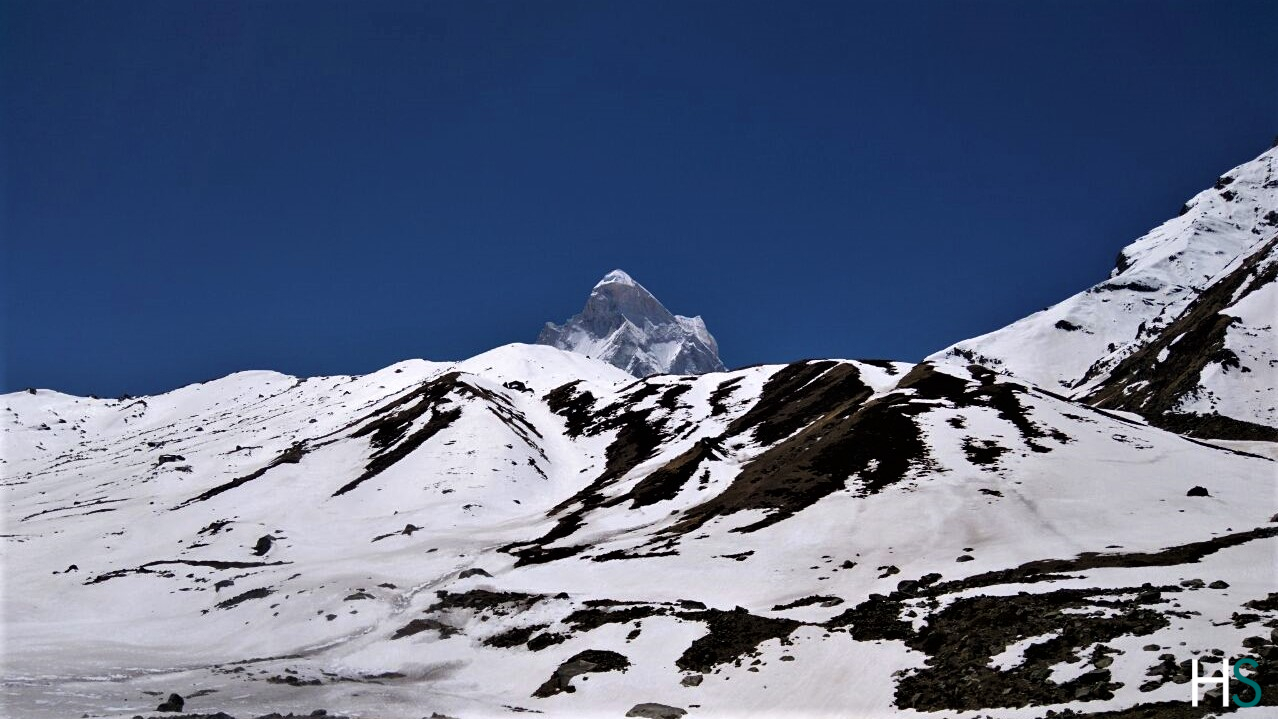
Upcoming Treks
- May 18, 2024 open
- June 24, 2024 open
- September 28, 2024 open
- October 1, 2024 open
FAQ's about Gaumukh Tapovan Trek
What is the best time to undertake this trek.
The best time for the Gaumukh Tapovan Trek is during the summer months, from May to June, and post-monsoon season from September to October.
What are the major highlights of the Gaumukh Tapovan Trek?
The trek offers stunning views of peaks like Shivling, Bhagirathi, and Meru, the spiritual experience of reaching Gaumukh, and the serene Tapovan meadows.
How long is the Gaumukh Tapovan Trek?
The trek typically takes around 6-7 days to complete, covering a distance of approximately 45 kilometers round trip.
How is the accommodation during the trek?
Accommodation on the trek is in tents or basic lodges, offering a rustic and immersive experience amidst nature.
What is Gaumukh Trek distance from Gangotri?
The distance from Gangotri to Gaumukh is approximately 18 kilometers (11.2 miles) one way.
How to get fit for this trek?
Running or Jogging : Start with a comfortable distance and gradually increase your pace and distance over time. Aim for at least 3-4 days a week of cardio workouts.
Hiking Practice : If possible, try to find local trails or hills to practice hiking. Start with shorter hikes and gradually increase the difficulty.
Strength Training :
- Legs : Focus on exercises that target your quadriceps, hamstrings, and calves. Squats, lunges, leg presses, and calf raises are beneficial.
- Core : A strong core will help with balance and stability on uneven terrain. Include exercises like planks, Russian twists, and bicycle crunches.
- Upper Body : Don’t neglect your upper body strength, especially if you’re carrying a backpack. Incorporate push-ups, pull-ups, and shoulder presses.
Flexibility and Mobility :
- Stretching : Regular stretching helps improve flexibility and prevents muscle tightness. Focus on stretching your legs, back, and shoulders.
- Yoga or Pilates : These practices can help improve flexibility, balance, and overall body strength.
Why trek with Himalaya Shelter?
“I have been doing treks with Himalaya Shelter for the last two years and they are awesome people with pure humbleness.“
Writes Priyesh.
We at Himalaya Shelter consider our trekkers part of our community, a family of sorts and really understand the efforts that you put into taking that much-needed break and setting off to the mountains. Some of you may wait for months and even a year to plan out that perfect excursion. That’s why we want it to be “a perfect excursion” for you.
Our testimonials (read below) are a testament to our service-oriented mindset.
We take safety into great consideration and ensure our team is trained to handle emergency situations.
For a better experience, we provide accommodation on Twin Sharing throughout the trek. With most trekking operators you would get triple or even quad sharing accommodation.
Our Accommodation will have attached washrooms
Furthermore, we provide the essential safety gear for your trek –
Without any additional charges.
We pamper you with great food which keeps you going on the trek. (On our google maps out of 300 reviews over 80 Trekkers mention great food😋)
We do not outsource services to ensure topmost quality throughout your journey. We use our own fleet of Vehicles to ferry you to the base camp and return.
What is Gaumukh Tapovan?
Gaumukh Tapovan is a high-altitude trek in the Garhwal Himalayas that takes you to the source of the Ganges River, the Gangotri glacier. It offers breathtaking views of the glacier, Bhagirathi peaks, and other surrounding mountains.
How long is the Gaumukh Tapovan trek?
The trek is typically a 6 to 8-day round trip, covering a distance of approximately 48 to 50 kilometers, depending on the specific route taken.
Is it a difficult trek?
The Gaumukh Tapovan trek is considered moderately challenging. It involves trekking at high altitudes, and participants should have a good level of fitness and stamina.
Are there any permits required for the trek?
Yes, a permit is required to enter the Gangotri National Park, which is part of the trekking route. The permit can be obtained at the Gangotri checkpoint.
What should I pack for the Gaumukh Tapovan trek?
Some essential items to pack include trekking clothing, a good pair of trekking shoes, a backpack, water bottles, snacks, a first aid kit, a rain jacket, a hat, sunglasses, a headlamp or flashlight, and any personal medications.
Is there mobile network coverage along the trek?
Mobile network coverage is limited along the trek. It’s advisable to inform someone about your itinerary and carry a satellite phone or a communication device for emergencies.
What is the altitude of Gaumukh and Tapovan?
Gaumukh is situated at an altitude of approximately 4,200 meters (13,780 feet), while Tapovan is located at around 4,463 meters (14,640 feet) above sea level.
which peaks are visible from the gaumukh tapovan trek?
Shivling (6,543 meters) : Shivling is one of the most famous peaks in the Garhwal region. It’s known for its distinctive pyramid shape and is clearly visible from Tapovan.
Meru Peak (6,310 meters) : Meru Peak is another prominent peak in the Garhwal Himalayas. It’s known for its challenging climbing routes.
Bhagirathi Group of Peaks : This includes peaks like Bhagirathi I, Bhagirathi II, Bhagirathi III, and Bhagirathi IV. They are named after the River Bhagirathi, one of the main tributaries of the Ganges.
Sudarshan Parbat (6,507 meters) : Also known as Thalay Sagar, this peak is part of the Gangotri Group of peaks.
Manda Parbat (6,273 meters) : Manda Parbat is part of the Bhagirathi Group and adds to the breathtaking scenery of the trek.
Sumeru Parbat (6,315 meters) : Also known as Matri, this peak is part of the Bhagirathi Group
Where is the Nearest ATM?
The nearest ATM to Gangotri, which is the starting point for the Gaumukh Tapovan trek, is located in the town of Uttarkashi.
How do i reach the starting point of gaumukh tapovan trek
The nearest airport to Gangotri is the Jolly Grant Airport in Dehradun, which is approximately 250 kilometers (155 miles) away. From the airport, you can hire a taxi or take a bus to Gangotri. The journey by road can take around 7-8 hours.
The nearest railway station is the Dehradun Railway Station, which is about 240 kilometers (149 miles) from Gangotri. From the railway station, you can hire a taxi or take a bus to Gangotri. The journey by road can take around 7-8 hours.
Gangotri is well-connected by road to various cities and towns in Uttarakhand. You can take a bus or hire a taxi from major cities like Dehradun, Rishikesh, Haridwar, or Uttarkashi to reach Gangotri.
What are the Nearby Attraction of this trek?
Gangotri Temple :
Located in the town of Gangotri, this ancient temple is dedicated to Goddess Ganga. It is one of the Char Dham pilgrimage sites and an important religious center for Hindus.
Gangotri National Park :
Encompassing the entire trekking route, this national park is home to a diverse range of flora and fauna. It’s a great place for nature enthusiasts and wildlife lovers.
Bhagirathi Shila :
This rock, located near Gangotri Temple, is believed to be the place where King Bhagirath meditated to bring the River Ganga to the earth.
Bhairon Ghati :
Located about 10 kilometers from Gangotri, this scenic spot offers picturesque views of the Bhagirathi River.
Bhoj Kharak :
This beautiful meadow is en route to the Gaumukh Glacier and is known for its stunning views of the surrounding peaks.
Surya Kund :
This hot water spring, located near the Gangotri Temple, is believed to have medicinal properties. Pilgrims often take a dip here before visiting the temple.
Pandava Gufa :
It is believed to be the cave where the Pandava brothers sought refuge during their exile. It’s located about 1.5 kilometers from Gangotri.
A high-altitude lake surrounded by dense forests, Dodi Tal is a beautiful trekking destination located about 60 kilometers from Uttarkashi.
Uttarkashi Town :
Uttarkashi, the district headquarters, is a charming town situated on the banks of the Bhagirathi River. It’s known for its temples, ashrams, and natural beauty.
Nachiketa Tal :
A serene lake located about 30 kilometers from Uttarkashi, it’s named after the legendary sage Nachiketa.
What is the Qualification of the trek leader?
The minimum requirement to join our team, Trek Leaders should have done the Basic Mountaineer Course
Trek leaders in Himalaya Shelter have extensive experience in trekking and mountaineering. They are familiar with the specific terrain, weather conditions, and challenges of the region where the trek is taking place.
What is the best time to do the trek and how is the weather?
What are the top highlights of the trek, 2 reviews for gaumukh tapovan trek.
K R Venkat – September 26, 2022
I just completed the GAUMUKH Tapovan trek with the team from Himalaya Shelters (18-Sep-2022 to 24-Sep-2022).
Saurabh was the trek leader and he was supported by Suresh, Kamal and Kuldeep. The entire trek was organized flawlessly. We were welcomed in Dehradun punctually and treated as guests for all the eight days. Saurabh showed great ownership as the trek leader and drove his team with a sense of purpose. He took care to see that each team member did his bit to ensure that we stayed on time and on course during the trek. Suresh – whom we fondly called mountain goat – was chirpy, nimble footed on tough terrain and was always willing to lend a helping hand. Kamal was a great cook – he dished out fantastic and nutritious meals at 14640 ft, not repeating a dish once over the entire trek. Kuldeep, the newbie in the team, always had a smile on his face and was eager to help and learn.
The trek as such, in my opinion, was light to moderate. The two stretches from Gangotri to Bojwasa is light. Bojwasa to Gaumukh was moderate, largely due to rough terrain. On both stretches the ascent is gradual. The stretch from Gaumukh to Tapovan is moderate owing to the terrain and steep climb. This section sees us gain 2000 Ft in one day and is the toughest part of the trek. This is a high altitude trek. It is better to work on your cardiovascular fitness before doing this. At the very least, you should be able to walk 10Km without being stressed. Those with either poor fitness or any prior history of AMS may want to consider trekking only till Gaumukh and returning back to Bojwasa. This is a runtime decision you can make on the trek.
Overall, it was a great experience for the small group of 5 that undertook this trek. We return with great experience, fond memories and a deep desire to trek the Himalayas again. We will certainly choose Himalaya shelters again. I would highly recommend them !
graliontorile – June 6, 2023
Hi, Neat post. There is an issue along with your site in internet explorer, may check thisK IE nonetheless is the market leader and a large element of other people will leave out your magnificent writing because of this problem.
Your email address will not be published. Required fields are marked *
Your review *
Name *
Email *
Save my name, email, and website in this browser for the next time I comment.
- Transport support from Dehradun to Dehradun
- Pick-up location: Prince Chowk, near Dehradun Railway Station Pick-up Time: Around 7:30 am
- All vegetarian meals starting from dinner on day 1 to breakfast on the last day
- Professional Guide, Cook and Support staff
- First-Aid kit with Oximeter and Portable Oxygen Cylinder
- Kitchen tents, common tents, toilet tents with portable toilet seats
- Rent for camping equipment like Clean sleeping bags and foam mattresses, Good quality ‘A’ shaped or dome tents, Camping stools, Table and Crampons and gaiters if required
- Forest entry charges for Indian nationals (Additional charges will be applicable for international tourists)
- Porter and mule support to carry camping equipment and NOT personal luggage
- Accommodation throughout the trek on a triple-sharing basis
- Guesthouse accommodation on the first and second last day on a triple-sharing basis
- All applicable taxes
- Your designated hotels may not reopen by the time you reach there. While we are making alternate arrangements, do understand that things may not be as “tip-top” as our designated hotels.
- The gurudwara, Hemkund Sahib may not be open. While we are trying to take permission to go to Hemkund Sahib, if it does not happen, then do understand that the pandemic has put restrictions beyond our control.
- Personal expenses like tips, personal medicines, phone calls etc.
- Any transport support during the trek apart from what is included above
- Any cost or services not mentioned in the Inclusions
- Accommodation in Dehradun
- Adventure Insurance
- Cost arising due to unforeseen incidents like bad weather, medical evacuation, roadblocks etc
- Porter and mule support to carry personal Luggage can be arranged at an additional cost of INR 500 per bag per day (weighing up to 12 kg)
- Please carry a lunch box for packed lunch/breakfast to avoid using polythenes and Aluminium foils. Keeping the Himalayas clean is our own responsibility. Reduce the use of Plastic when you are in the abode of the Sacred Himalaya. 🌱
- 17-07-2021 to 23-07-2021 open
- 17-07-2021 to 23-07-2021 close
Send Request
Your query has been successfully registered. we will contact you within 24 hours., something went wrong.try after sometime..
Travel Around The World Blog
Exploring the Majesty of the Himalayas: A Guide to Gaumukh Tapovan Trek

The Gaumukh Tapovan Trek is a hiking trail situated in the Garhwal Himalayas of Uttarakhand, India. It takes hikers through scenery, high altitude meadows and towering mountains providing a Himalayan experience. The main attractions of the trek include reaching Gaumukh, the tip of the Gangotri Glacier and Tapovan, a meadow surrounded by peaks.
Regarded as a trek, in the Indian Himalayas the Gaumukh Tapovan Trek is highly valued in the world of Himalayan trekking. It draws enthusiasts and nature admirers from across the globe because of its beauty, spiritual significance and challenging rewarding terrain. The trek presents a chance to explore the wilderness of Garhwal region and witness the unspoiled magnificence of the Himalayas.
In this article we will explore the enchanting realm of the Gaumukh Tapovan Trek providing readers with a guide to embark on this journey. From hiking schedules and practical advice to insights, into encountering natural marvels along the way readers can anticipate gaining valuable knowledge and motivation for planning their expedition to this Himalayan treasure.
Getting Started for the Gaumukh Tapovan Trek
1. overview of the trek route and duration:.
The Gaumukh Tapovan Trek typically spans over 6-7 days, covering a distance of approximately 40-45 kilometres round trip. The journey begins at Gangotri, the base camp for the trek, and follows a picturesque route along the banks of the Bhagirathi River. Trekkers traverse through enchanting forests, rustic villages, and rugged terrain before reaching the iconic Gaumukh Glacier and Tapovan meadows, where the views of towering peaks are simply breathtaking.
2. Best Time to Visit Gaumukh Tapovan:
The best time to embark on the Gaumukh Tapovan Trek is during the summer months, from May to June, and the post-monsoon season, from September to October. During these periods, the weather is relatively stable, with clear skies and comfortable temperatures, making it ideal for trekking. However, it’s essential to avoid the monsoon season (July to August) due to heavy rainfall and the risk of landslides.
3. Permits and Permissions Required for the Trek:
Trekkers planning to undertake the Gaumukh Tapovan Trek need to obtain permits and permissions from the Forest Department of Uttarakhand. These permits can be obtained at the Gangotri National Park entrance gate in Gangotri. Additionally, trekkers are required to carry valid identification proof, such as an Aadhar card or passport, for verification purposes during the trek.
4. Preparing for the Trek: Physical Fitness and Training Tips:
The Gaumukh Tapovan Trek involves moderate to strenuous levels of physical exertion, including long hours of trekking at high altitudes. Therefore, trekkers need to prepare themselves physically and mentally before embarking on the journey. Some training tips include regular cardio exercises, strength training, and endurance workouts to build stamina and resilience. Additionally, practising hiking on uneven terrain and gradually increasing the duration and intensity of workouts can help prepare trekkers for the challenges of the trek. It’s also crucial to stay hydrated, eat a balanced diet, and get adequate rest before the trek to ensure optimal performance and enjoyment during the journey.
Day-by-Day Itinerary of the Gaumukh Tapovan Trek
Day 1: arrival in gangotri and acclimatization.
- Upon arrival in Gangotri, trekkers will have a day to acclimatise to the high altitude and prepare for the trek ahead.
- Activities may include exploring the town, visiting the Gangotri Temple, and resting to adjust to the altitude.
Day 2: Trek from Gangotri to Chirbasa
- The trek begins with a scenic trail from Gangotri to Chirbasa, covering a distance of approximately 9 kilometres.
- Trekkers will traverse through dense forests of pine and deodar trees, with views of the Bhagirathi River accompanying them along the way.
Day 3: Trek from Chirbasa to Bhojbasa
- Continuing the journey, trekkers will trek from Chirbasa to Bhojbasa, covering a distance of around 5 kilometres.
- The trail offers stunning views of the Bhagirathi peaks and the surrounding Himalayan landscape, with the majestic Shivling peak dominating the skyline.

Day 4: Trek from Bhojbasa to Gaumukh and Onwards to Tapovan
- This challenging day involves trekking from Bhojbasa to Gaumukh, the source of the Ganges River, and onwards to Tapovan.
- Trekkers will witness the awe-inspiring sight of the Gangotri Glacier at Gaumukh before ascending to the serene meadows of Tapovan, surrounded by towering peaks.
Day 5: Exploration Day at Tapovan and Return to Bhojbasa
- Day 5 is reserved for exploring the enchanting landscapes of Tapovan, with options for short hikes and photography sessions amidst the Himalayan panorama.
- Later in the day, trekkers will descend back to Bhojbasa to rest and rejuvenate for the journey ahead.
Day 6: Trek Back to Gangotri and Departure
- On the final day of the trek, trekkers will trek back from Bhojbasa to Gangotri, completing the circuit.
- After reaching Gangotri, trekkers will bid farewell to the majestic Himalayas and depart for their onward journey, carrying cherished memories of the Gaumukh Tapovan Trek.
Highlights of the Gaumukh Tapovan Trek
1. stunning landscapes and himalayan vistas along the trekking route.
- The Gaumukh Tapovan Trek offers trekkers breathtaking views of the Himalayan landscape, including snow-capped peaks, lush valleys, and meandering rivers.
- Trekkers will traverse through diverse terrain, ranging from dense forests and alpine meadows to rugged mountain passes, each offering its unique charm and beauty.
2. Encounter with the Gangotri Glacier at Gaumukh
- One of the major highlights of the trek is the opportunity to witness the awe-inspiring Gangotri Glacier, which originates from the snout known as Gaumukh.
- Trekkers will marvel at the sheer size and grandeur of the glacier, as well as the pristine blue hues of the ice, creating a surreal and unforgettable experience.
3. Spiritual Significance of Tapovan and Its Serene Ambiance
- Tapovan holds immense spiritual significance for Hindus, as it is believed to be the meditation site of several sages and saints.
- The serene ambiance of Tapovan, nestled amidst towering peaks and surrounded by pristine nature, offers trekkers a sense of peace and tranquillity that is truly rejuvenating.
4. Flora and Fauna Sightings During the Trek
- Throughout the trek, trekkers will have the opportunity to encounter a rich variety of flora and fauna endemic to the Himalayan region.
- From vibrant wildflowers and aromatic herbs to elusive Himalayan wildlife such as blue sheep, mountain goats, and various bird species, the trek offers a glimpse into the diverse ecosystem of the Himalayas.
Challenges and Rewards for Trekking Gaumukh Tapovan Trek
1. physical challenges encountered during the trek.
- The Gaumukh Tapovan Trek presents trekkers with various physical challenges, including long hours of trekking over rugged terrain and steep ascents and descents.
- The high altitude and unpredictable weather conditions can also pose challenges, requiring trekkers to acclimatise properly and be prepared for changes in weather.
2. Rewards of the Trek: Breathtaking Views and Personal Growth
- Despite the challenges, the trek offers numerous rewards, including unparalleled views of the Himalayan peaks, pristine alpine meadows, and cascading waterfalls.
- The sense of accomplishment and personal growth that comes from completing the trek, pushing physical and mental boundaries, and overcoming obstacles is immeasurable.
3. Testimonials from Trekkers Sharing Their Experiences
- Many trekkers who have embarked on the Gaumukh Tapovan Trek have shared their experiences and testimonials, highlighting the beauty of the landscape, the camaraderie among fellow trekkers, and the sense of fulfilment upon reaching the summit.
- These testimonials serve as inspiration for aspiring trekkers, offering insights into the challenges and rewards of the trek and encouraging others to embark on their Himalayan adventure.
Physical Challenges Encountered During the Trek
Rewards of the trek: breathtaking views and personal growth, testimonials from trekkers sharing their experiences, cultural insights at gaumukh tapovan trek, interactions with local communities along the trekking route.
- One of the enriching aspects of the Gaumukh Tapovan Trek is the opportunity to interact with local communities residing along the trekking route.
- Trekkers can engage with villagers, learn about their traditional lifestyles, and gain insights into the unique culture and customs of the Himalayan region.
Significance of Gangotri in Hindu Mythology and Religious Practices
- Gangotri holds immense significance in Hindu mythology as it is believed to be the origin of the sacred River Ganges, also known as Ganga.
- According to Hindu mythology, Goddess Ganga descended from heaven to earth at Gangotri, making it a revered pilgrimage site for Hindus. Pilgrims visit Gangotri to pay homage to the goddess and take a holy dip in the icy waters of the Bhagirathi River.
Cultural Experiences During the Trek
- Throughout the trek, trekkers will encounter various cultural experiences that highlight the rich heritage and spirituality of the region.
- From visiting ancient temples and shrines to witnessing traditional ceremonies and rituals performed by local communities, the trek offers a glimpse into the deeply ingrained cultural fabric of the Himalayas.
Conclusion: A Guide to Gaumukh Tapovan Trek
Embarking on the Gaumukh Tapovan trek is a journey that takes you through the breathtaking scenery of the Himalayas from lush forests, to majestic peaks and peaceful meadows. We welcome you to join us on this adventure, where you can immerse yourself in the beauty and spiritual essence of this trek. As we come to the end of this chapter we are grateful for the chance to discover the grandeur of the Himalayas and for the moments we’ve shared during our exploration.
More Stories

Slow Travel Crafting the Ideal 3-Day Goa Itinerary
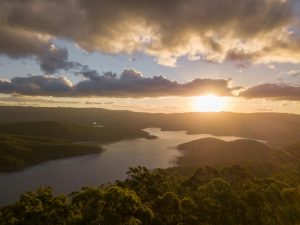
Exploring the Krishna River: A Journey Through Nature

Exciting Golden Triangle Trip in India: A Must-See Adventure
You may have missed.

Why Turkey Should Be Your Next Holiday Destination

Exploring the Seamless Journey from Hyderabad to Goa by Flight

Miles To Go Before I Sleep :-)
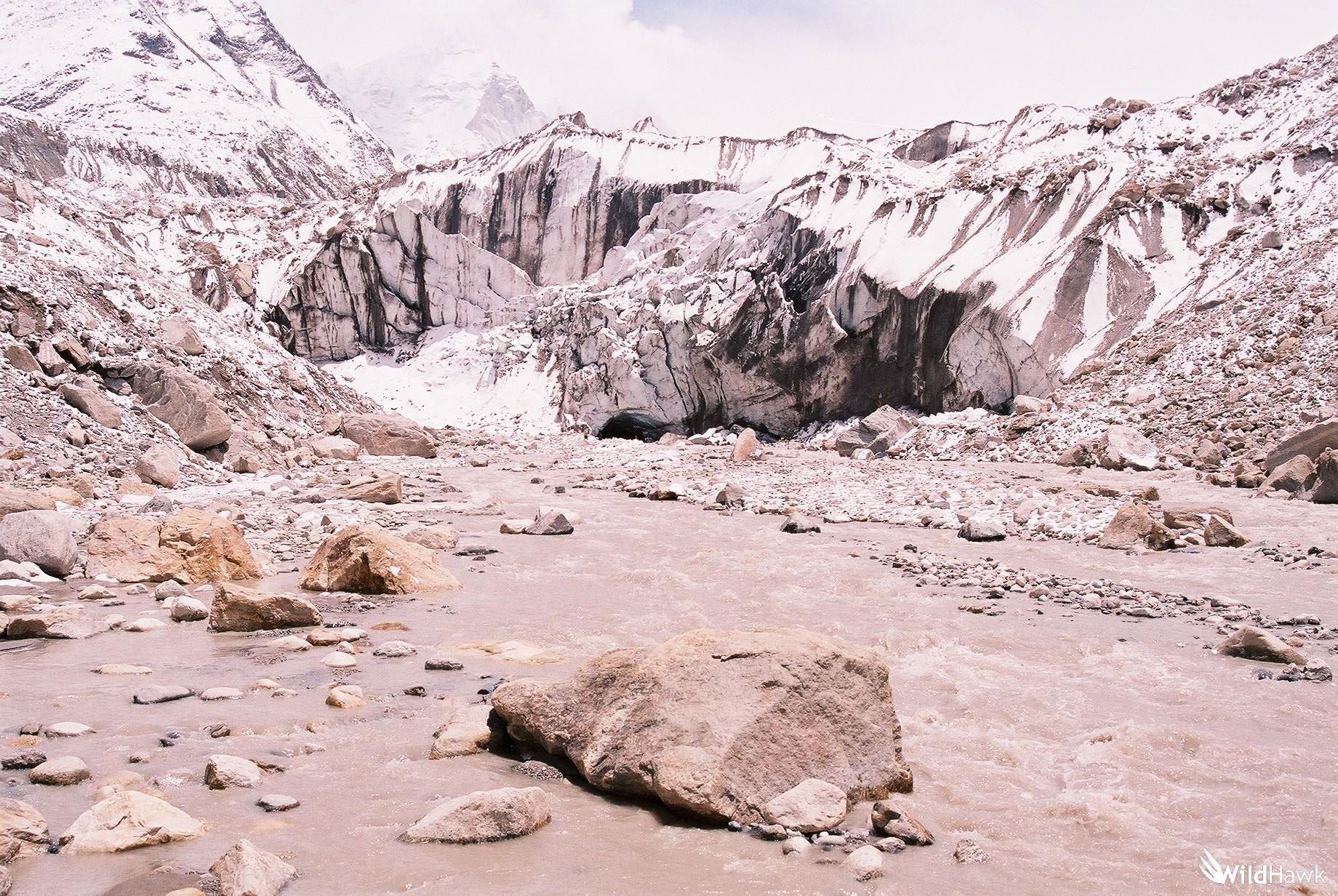
Gaumukh Tapovan Trek – A Complete Guide
A scintillating adventure – The Gaumukh Tapovan Trek
Gaumukh is the place, which is known as the terminus of the Gangotri glacier and it’s a source of the primary streams of Gangotri river. This beautiful place is located in Uttarkashi, in the state of Uttarakhand and is a very well known trekking place. This is a very historic and religious and many stories revolve around the name of this place, as it looks like the mouth of the Cow. It’s situated around 18 kms away from Gangotri, and a speedy Bhagirathi river flows through this place.
The scenic views are breathtaking with pieces of broken snow all around and the snow glaciers; it’s definitely one of those heavenly places. This is one of the holiest lands in Uttarakhand and has great mythological history, always bustling with devotees from all over India, to experience the serenity and purity of this place. This place is what is known as the birth of North Indian mythology due to the incarnation of river ganga, and so many stories surround this origination.
About the Gaumukh Tapovan Trek
The Gaumukh tapovan trek is one of those mesmerizing and beautiful places, that is going to give you a spiritual and sensational adventure and it takes you to the Gangotri glacier which is known to be the mouth of the holy Ganges River. The entire 24 km long expanse is a beautiful experience that you will never forget. It starts from the Gaumukh expanse and extends up to the Chaukhamba massif which is around Badrinath . Walk through glacial hues, from the start to the end, you will see the mesmerizing backdrop of Mount Shivling, and you will descend through The Tapovan meadows back to Gangotri.
This is trek is definitely a visual treat and perfect thrill for you, other than the Shivling range, there is Bhagirathi twin peak and Mount Meru. The best part about this trek is you get to witness, the magnificent river that was the reason of life for an entire civilization living there, originating from the Gaumukh snout and eventually meeting the Ocean; it’s an actual spiritual moment. Starting from the Gangotri glacier, the Bhagirathi river flows through Gaumukh and then becomes the river Ganga. Witnessing this beautiful amalgamation is the experience of a lifetime. There are intensely sacred theories surrounding the birth of this river and it is said to have been made to give new life to men, and it the realms of the river are held by Lord Shiva himself.
An Adventure that will Amaze You
The trek passes through larger than life mountain landscapes and gives you an opportunity to camp at the rugged heights, from where you will see the snow covered peaks very closely. The splendid sight of Bhagirathi peak, shining in the moonlight, and the alluring Shivling range from Tapovan, rising in all its glory, will leave you ecstatic. This trek is not an easy journey, but definitely worth the hustle.
The trek to Tapovan ahead of Gaumukh is another thrilling experience; Tapovan means the forest of spirituality. This place exhibits a deep love for nature and travel. This place is named after a sage who is still worshipped here. The place is filled with meadows, streams and flowering plants and it’s one of most amazing high altitude meadow of India. The high points here include the Amrit Ganga, that flows into the glaciers and also the place named Nandanvan, which is another trekking trail often taken up by trekkers here.
The trek to Gaumukh Tapovan is going to be a spiritual trip and a great dose of adventure. It’s going to be a dramatic trail to a place that can never have civilisation but has the most beautiful scenery and wilderness that you will see in the entire world. You need around seven days to soak in the entire beauty of this phenomenon trek. Brace yourself for a long hike, with lots of rough roads, and climate changes, and take up this beautiful journey, that you will remember.
Things to know about the adventure – tips and more
The first thing that you should know before heading on to this lovely adventure, is that you need to get permission from District Forest Officer to be allowed to take this trek, there are limited permits for each day, hence you should book this in advance. You should be well aware that this place has been damaged due to the floods in 2013, so it’s a landslide-prone zone always, hence you should take precautions for your safety. You will get to witness a few wild animals here, like the Bharals which are mountain antelopes, you should stay on the roads and not really venture too inside the jungles at night, to avoid any dangerous interaction with the animals. The only night halting stop after altitude of 10000 ft is Bhujbasa, which has facilities for staying and refreshing before you continue the trek.
And right after the halt, the trek leads you to Gaumukh snout, and eventually the majestic views of Mount Shivling. There are no horses allowed on this trail, so you should be ready to walk through the entire journey. And then begins the trek to Tapovan, this route has become difficult after the floods, you have to cross the glacier after Gaumukh and then reach Tapovan, which quite a risky trail nowadays. The tracks are not certain, you will most definitely have a guide, but it’s very important to take precautions, the climb can be very stiff at the end, it’s going to be a very tough and challenging experience.
How can one reach the Gaumukh Tapovan Trek ?
There are number of options available to travel to the base camp of Gangotri Glacier, you can take a flight to Jolly Grant Airport in Dehradun and then drive up to the base camp, or you can take a train to Dehradun, it’s even accessible by road, you can take buses or private vehicles from Dehradun to Gangotri Glacier.
What are the accommodation and other facilities for the Gaumukh Tapovan Trek ?
Since it’s a trek, most of your accommodation is going to be in camp tents, but there are guest houses and home stay options available at a few stops. You will get decent meals, and sanitary facilities, and there will always be a trained professional guide available to take you through this adventure.
Are there any restaurant or food facilities available at this place?
Not many eating options will available to you at this trek since it is a non-civilised territory. The guest houses at Bhajibusa have some basic meals available and you should pack a lot of dry snacks for this place.
What is the best time to go for th is Trek ?
You can visit this place either during Summer or Autumn that is May, June or September, and October. The weather is mild and pleasant in the day time during summers and the nights are relatively chill. And they say, the best time to go for trekking is during the onset of snowfall in September and October, the place looks even more picturesque, but you should do all the bookings in advance as there are very limited options for accommodation.
What are the essential things that one must carry for the Gaumukh Tapovan Trek ?
There is a list of things that you shouldn’t miss out on taking here because it’s a moderate level trek, listing a few most important ones are a wind jacket, woolen, and thermal clothes, cap, gloves, trekking shoes that are comfortable, raincoat, sunglasses, sunscreen, and personal medicines.
Frequently Asked Questions
1) how much in advance should one book the trek.
You should book the trek at least 2 months in advance, which will give a decent amount of time to prepare for the trek
2) Is there any minimum age requirement for this trek?
Since it is a moderate level trek anyone above the age of 10 years can take up this trek, but it is at your own risk
3) What is the minimum temperature at this place?
During May and June, the lowest temperature goes up to 2-degree Celsius, while during September and October it can go in minus.
4) How many hours does one trek in a day?
You will trek around 6-8 hours every day, to cover up to 10-15 km distance in a day.
5) Is it safe to drink stream water here?
Yes, it is safe to use stream water for drinking and cooking here.

Trek to the source of river Ganga
Gaumukh tapovan trek, via gangotri.
Sept & Oct
₹14999+ 5% GST
“not all those who wander are lost.”, haridwar to joshimath.
+ Rs. 2000 Transport
+ Rs. 3500 Backpack Offloading + Rs. 330 Outdoor Insurance
Difficulty Level - 4
uttarakhand 8 days - 46 km, batches: sept & oct 2023, up to 15% off in may-jun batches for a limited period ✨.
The Gaumukh Tapovan Trek is a popular trekking route in the Indian state of Uttarakhand. It takes you to the source of the River Ganges, known as Gaumukh, and the scenic meadows of Tapovan. Here's some information about the trek:
Location: The trek starts from Gangotri, a town located in th e Garhwal Himalayas of Uttarakhand, India. Gangotri is approximately 250 kilometers from the state capital, Dehradun.
Duration: The trek typically takes around 8-9 days to complete, including travel from Gangotri to Gangotri.
Difficulty Level: The Gaumukh Tapovan Trek is considered moderately complex. It involves steep ascents, rocky terrains, and altitude gain. Prior trekking experience and good physical fitness are recommended.
Highlights:
Gaumukh: Gaumukh is the snout of the Gangotri Glacier, which is the origin of the River Ganges. It is an important pilgrimage site and holds great religious significance for Hindus.
Tapovan: Tapovan is a stunning alpine meadow at an altitude of around 4,463 meters (14,640 feet). It offers breathtaking panoramic views of the surrounding peaks, including the mighty Shivling Peak.
Scenic Beauty: The trek offers mesmerizing views of snow-capped mountains, glaciers, and the gushing Bhagirathi River. You'll come across beautiful landscapes, waterfalls, and diverse flora and fauna throughout the journey.
Spiritual Significance: The trek is considered sacred by Hindus due to its association with the River Ganges. Many pilgrims undertake this trek to seek spiritual blessings and experience the pristine natural beauty.
Best Time to Trek: The ideal time for the Gaumukh Tapovan Trek is from May to October, during the summer and autumn seasons. The weather is relatively stable and the trails are more accessible during this period.
Equipment: Trekking gear such as sturdy hiking boots, warm clothing, a waterproof jacket, a backpack, a sleeping bag, and trekking poles are essential. It is also advisable to carry sufficient food, water, and personal medical supplies.
Gaumukh Tapovan Trek Itinerary
Gangotri (3,415M) to Chirbasa (3,600M) - 9 km
Welcome to Day 1 of the Gaumukh Tapovan Trek! This trek takes you through the mesmerizing landscapes of the Garhwal Himalayas in Uttarakhand, India. Get ready for an adventure-filled journey that will lead you to the source of the sacred River Ganges and provide breathtaking views of majestic peaks.
Your trek begins at Gangotri, a small town located at an altitude of 3,048 meters (10,000 feet). Gangotri is famous for its ancient temple dedicated to the River Ganges. From Gangotri, the trail gradually ascends through lush forests of pine and birch trees.
The first leg of your trek takes you to Chirbasa, situated at an elevation of approximately 3,580 meters (11,745 feet). It is a moderate walk that covers around 9 kilometers (5.6 miles) and takes about 4-5 hours to complete. Along the way, you'll catch glimpses of the Bhagirathi peaks and the stunning natural beauty that surrounds you.
Chirbasa serves as a perfect spot for acclimatization. You'll find a few tea stalls and basic guesthouses here. Take some time to relax, enjoy the serene surroundings, and prepare yourself for the next day's trek.
As you continue your journey, Day 1 ends at Chirbasa, and you can spend the evening exploring the area, interacting with fellow trekkers, and relishing a hot meal. Ensure you drink plenty of water and stay hydrated throughout the day to combat the effects of high altitude.
Remember to respect the environment and follow the principles of Leave No Trace. Pack out any waste you generate and be mindful of the fragile ecosystem you are entering.
Prepare your gear for the next day, as you will be heading towards Bhojbasa, which is situated at an altitude of approximately 3,800 meters (12,470 feet). This leg of the trek offers stunning views of the Bhagirathi peaks and the opportunity to witness the glacier-fed River Bhagirathi.
Wishing you a fantastic start to your Gaumukh Tapovan Trek! Enjoy the scenic beauty and the thrill of the mountains.
Day 2: Chirbasa (3,600M) to Bhojwasa (3,775M) - 5 km
Welcome to Day 2 of your Gaumukh Tapovan Trek! Today, you will continue your journey from Chirbasa to Bhojbasa, covering a distance of approximately 5 kilometers (3.1 miles). This leg of the trek will take you closer to the mighty Gangotri Glacier and offer breathtaking views of the surrounding peaks.
After a good night's rest in Chirbasa, wake up early in the morning to witness the stunning sunrise illuminating the mountains. Begin your trek by following the well-marked trail that winds through the picturesque landscape.
As you ascend, you'll notice the vegetation becoming sparser, and the terrain becoming rockier. The trail takes you alongside the River Bhagirathi, which flows from the Gangotri Glacier. The sight of the glacial river gushing down the valley is awe-inspiring.
After walking for about 2-3 hours, you'll reach the destination for the day—Bhojbasa. Situated at an altitude of approximately 3,775 meters (12,385 feet), Bhojbasa is a small settlement offering basic accommodation and a few tea stalls.
Bhojbasa provides an excellent vantage point to witness the massive Gangotri Glacier, the source of the River Ganges. The glacier, with its icy crevasses and massive ice formations, is a sight to behold. Take some time to soak in the beauty and grandeur of this natural wonder.
Spend the rest of the day exploring the surroundings, relaxing, and acclimatizing to the higher altitude. It is crucial to listen to your body and give it enough time to adjust to the changing altitude to avoid altitude sickness.
Remember to stay hydrated, drink plenty of water, and consume a nutritious diet. Take precautions against the sun as the higher altitudes can be harsh on the skin. Apply sunscreen, wear a hat, and protect yourself from the strong UV rays.
In the evening, enjoy a warm meal at one of the local tea stalls and immerse yourself in the serene ambiance of the mountains. The night sky at Bhojbasa is often adorned with a blanket of stars, offering a magical experience for stargazers.
Ensure you have a good night's sleep and recharge for the next day's trek, which will take you even closer to the mythical Gaumukh, the snout of the Gangotri Glacier.
Remember to respect the environment and follow the principles of responsible trekking. Leave no trace, carry back any waste, and be mindful of the fragile ecosystem you are traversing.
Wishing you an incredible journey as you continue towards Gaumukh on Day 3 of the Gaumukh Tapovan Trek!
Day 3: Bhojwasa (3,775M) to Tapovan (4,460M) via Gomukh (4,025M) - 14 km Trek
Welcome to Day 3 of your Gaumukh Tapovan Trek! Today's trek will take you from Bhojbasa to Tapovan, a high-altitude meadow situated at an elevation of approximately 4,460 meters (14,632 feet). Along the way, you will visit Gaumukh, the snout of the Gangotri Glacier and a significant pilgrimage site.
Start your day early, as you have a long and challenging trek ahead. From Bhojbasa, the trail gradually ascends towards Gaumukh. The initial section will take you through moraine and rocky terrain as you approach the glacier.
After walking for a few hours, you'll reach Gaumukh, which literally means "Cow's Mouth" in Hindi. It is named so because the glacier's terminus resembles a cow's snout. Gaumukh holds immense religious significance for Hindus and is considered the source of the sacred River Ganges.
Take some time to marvel at the impressive glacier and the stunning surroundings. The glacier's icy expanse, jagged peaks, and the sound of the flowing river create a surreal atmosphere.
Beyond Gaumukh, the trail continues to ascend towards Tapovan. This section of the trek involves negotiating some challenging terrain, including moraines, boulders, and steep inclines. The altitude also adds to the difficulty, so it's important to maintain a slow and steady pace, allowing your body to adjust to the thin air.
As you climb higher, you'll be rewarded with breathtaking panoramic views of snow-capped peaks, including Shivling, Meru, and Bhagirathi group of peaks. The serene beauty of the surrounding Himalayan landscape will leave you spellbound.
After a strenuous yet rewarding trek, you'll finally reach Tapovan, your destination for the day. Tapovan is a vast meadow nestled amidst towering mountains and offers a majestic view of the peaks. It is also renowned for its spiritual ambiance and is considered a meditative place by many yogis and sadhus.
Settle into your campsite at Tapovan, enjoy a warm meal, and soak in the tranquility of this remarkable place. Take some time to explore the surroundings, witness the vibrant colors of the alpine flowers, and capture the memories of this awe-inspiring location.
Ensure you stay hydrated, continue acclimatizing to the altitude, and listen to your body. It's essential to give yourself enough time to adjust and avoid any symptoms of altitude sickness.
At night, be prepared for a cold and starry sky. The clear mountain air and lack of light pollution make Tapovan an ideal spot for stargazing. Witness the twinkling constellations and perhaps even catch a glimpse of shooting stars.
Congratulations on reaching Tapovan and completing the challenging trek to Gaumukh! Take this opportunity to rest, recharge, and immerse yourself in the beauty of the Himalayas.
Day 4: Tapovan (4,460M) to Bhojwasa (3,775M) - 6 km
Welcome to Day 4 of your Gaumukh Tapovan Trek! Today, you will begin your descent from Tapovan back to Bhojbasa, retracing your steps through the magnificent Himalayan landscape.
After spending a peaceful night surrounded by the grandeur of Tapovan, wake up early to witness the sunrise painting the peaks with hues of gold. Take a moment to appreciate the serene beauty of the surroundings before starting your trek.
The trail descends gradually, offering you a different perspective of the mountains and glaciers you encountered on your way up. As you make your way back, cherish the memories of the stunning views and the sense of accomplishment that came with conquering the challenging terrain.
While descending, remember to maintain a steady pace and be cautious while traversing any rocky or uneven sections of the trail. Take breaks as needed to rest, hydrate, and capture the last glimpses of the mesmerizing landscapes.
After approximately 3-4 hours of trekking, you'll arrive back at Bhojbasa. This will be a welcome sight as you return to a familiar place and lower altitude. Take a moment to relax and reflect on the incredible journey you've undertaken over the past few days.
Spend the rest of the day at Bhojbasa, indulging in a well-deserved rest. Rejuvenate yourself by taking in the natural beauty around you and relishing a warm meal at one of the tea stalls. Use this time to bond with fellow trekkers and share stories of your adventures in the mountains.
In the evening, you can take a stroll around Bhojbasa, capturing any last moments of the scenic landscape before bidding farewell to this serene haven.
As you prepare for your final night on the trek, take the opportunity to express gratitude for the remarkable experiences and memories you've gathered throughout the journey. Make sure to get a good night's sleep, as tomorrow you will make your way back to Gangotri, concluding your Gaumukh Tapovan Trek.
Remember to continue practicing responsible trekking, leaving no trace of your presence in these pristine mountains. Preserve the beauty of the environment for future generations to enjoy.
Wishing you a peaceful and restful night at Bhojbasa, as you savor the final moments of your incredible trekking adventure!
Day 5: Bhojwasa (3,775M) to Gangotri (3,415M) - 14 km
Welcome to the final day of your Gaumukh Tapovan Trek! Today, you will make your way back from Bhojbasa to Gangotri, concluding your memorable adventure in the Garhwal Himalayas.
After a refreshing night's rest in Bhojbasa, wake up early and prepare for the final leg of your trek. Begin your descent from Bhojbasa, bidding farewell to the mesmerizing views and serene ambiance of the high-altitude meadow.
The trail back to Gangotri is approximately 14 kilometers (8.7 miles) long and will take around 6-7 hours to complete. As you descend, you'll retrace your steps through the scenic landscapes, crossing the rocky terrains and picturesque sections you encountered on your way up.
While descending, be cautious of any loose rocks or uneven surfaces along the trail. Take your time and maintain a steady pace, allowing yourself to enjoy the surroundings one last time. As you make your way down, you'll notice the gradual change in vegetation, with the forested sections becoming denser.
As you approach Gangotri, the sound of the River Bhagirathi will grow louder, welcoming you back to the town. The sight of the charming town nestled in the Himalayas will bring a sense of fulfillment and accomplishment.
Upon reaching Gangotri, take a moment to appreciate the significance of this sacred place. Visit the famous Gangotri Temple, dedicated to the River Ganges, and offer your prayers or pay your respects, soaking in the spiritual atmosphere.
Afterward, take some time to relax and unwind in Gangotri. Explore the town, interact with the locals, and perhaps indulge in some local cuisine to celebrate the successful completion of your trek.
Reflect on the incredible experiences and memories you've gathered over the past few days, cherishing the stunning vistas, challenging trails, and the sense of connection with nature. Take pride in your accomplishment, knowing that you have explored and experienced the breathtaking beauty of the Himalayas.
As you bid farewell to Gangotri, remember to respect the environment and local culture. Dispose of any waste responsibly and leave the town as pristine as you found it.
Congratulations on completing the Gaumukh Tapovan Trek! May the memories of this adventure stay with you forever, serving as a reminder of your strength, resilience, and the beauty of the natural world. Safe travels, and may you embark on many more incredible journeys in the future !
What's Included
Food as per menu on the trek (Starting Dinner on Day 1 till Packed Lunch on Day 5)
Exhaustive First Aid kit including Oxygen cylinder
Forest Permits/Camping Charges, if any (Upto the amount charged for Indian nationals)
Dome tents - on twin sharing basis, Sleeping bags, mats
Micro-spikes, Gaiters, Helmets, if required
Trek guide, cook, helpers, and porters for carrying common supplies
Mountaineering course certified Trek Leader with First Aid certification along with special rescue course from NIM, Uttarkashi
What's Not-Included
Portage of personal bags during the trek
Cost of any kind of Travel Insurance.
Any Expense of personal nature.
Any Expenses not specified in the inclusions list.
Essentials to carry
When embarking on the Gaumukh Tapovan Trek, it is important to pack the necessary gear and supplies to ensure a safe and comfortable journey in the high-altitude Himalayan region. Here is a list of essential items to carry:
1. Clothing: - Warm and waterproof jacket - Insulated down or synthetic jacket - Thermal base layers (tops and bottoms) - Fleece or softshell jacket - Trekking pants and/or convertible pants - T-shirts or trekking shirts - Waterproof and breathable pants - Warm hat or beanie - Gloves or mittens - Hiking socks (wool or synthetic blend) - Trekking boots or sturdy hiking shoes - Gaiters (optional, for added protection against snow or debris)
2. Equipment: - Backpack (30-40 liters) for carrying your personal belongings - Sleeping bag suitable for cold temperatures - A sleeping pad or mat for insulation and comfort - Trekking poles for stability and support - Headlamp or flashlight with extra batteries - Sunglasses with UV protection - Sun hat or cap - Water bottle or hydration bladder (1-2 liters capacity) - Personal first aid kit including essential medications, bandages, and blister treatment - Swiss army knife or multi-tool - Trekking map and compass or GPS device - Whistle for emergency signaling - Lightweight and quick-drying towel
3. Personal Care and Hygiene: - Sunscreen with a high SPF rating - Lip balm with UV protection - Insect repellent - Wet wipes or hand sanitizer - Toilet paper or tissue paper - Personal toiletries (toothbrush, toothpaste, soap, etc.)
4. Food and Snacks: - Energy bars or snacks for quick and convenient energy boosts - Electrolyte powder or tablets to replenish lost minerals during exertion
5. Miscellaneous: - Camera or smartphone for capturing the stunning landscapes - Portable power bank or extra batteries for electronic devices - Cash in small denominations for any purchases or emergencies
Remember to pack your belongings in a waterproof and lightweight manner, and only carry what is necessary to keep your backpack as light as possible. Additionally, check the weather forecast and consult with your trekking operator or guide for any specific gear or equipment recommendations.
It is important to note that this list is a general guideline, and you should adapt it based on your personal needs, preferences, and the specific requirements of the trek.
Here are some popular questions and their answers about the Gaumukh Tapovan Trek:
1. How long does the Gaumukh Tapovan Trek take?
The Gaumukh Tapovan Trek typically takes around 5 to 7 days to complete, depending on your pace and itinerary. This includes the trek from Gangotri to Gaumukh, Tapovan, and the return journey.
2. What is the best time to do the Gaumukh Tapovan Trek?
The best time to undertake the Gaumukh Tapovan Trek is during the summer months from May to June and September to October. These months offer favorable weather conditions with moderate temperatures and clear skies, making it ideal for trekking.
3. Is prior trekking experience necessary for the Gaumukh Tapovan Trek?
Prior trekking experience is not mandatory for the Gaumukh Tapovan Trek, but it is advisable to have a reasonable level of fitness and stamina. The trek involves moderate to difficult sections, and being physically prepared will enhance your experience.
4. What are the permits required for the Gaumukh Tapovan Trek?
To trek to Gaumukh and Tapovan, you will need to obtain permits from the Forest Department and the Gangotri National Park. It is essential to check the latest guidelines and obtain the necessary permits before starting your trek.
5. Are there any accommodation options available during the trek?
There are basic accommodation options available at certain stops along the trek route, such as Chirbasa and Bhojbasa. These accommodations usually offer dormitory-style rooms or tents for trekkers. It is recommended to carry your own sleeping bag for added comfort.
6. What are the highlights of the Gaumukh Tapovan Trek?
The Gaumukh Tapovan Trek offers several highlights, including the sacred Gaumukh Glacier, which is the source of the River Ganges. The trek also provides stunning views of peaks like Shivling, Meru, and the Bhagirathi group. Additionally, the serene meadows of Tapovan and the spiritual ambiance of Gangotri add to the trek's appeal.
7. How challenging is the Gaumukh Tapovan Trek?
The Gaumukh Tapovan Trek is considered moderately to difficult in terms of difficulty. The trail involves steep ascents and descents, rocky terrain, and the challenges of high altitude. It is recommended to have a good level of fitness, prior trekking experience, and proper acclimatization to tackle the trek comfortably.
8. Is it safe to trek to Gaumukh Tapovan?
With proper preparation, guidance, and adherence to safety precautions, the Gaumukh Tapovan Trek can be undertaken safely. It is important to trek with a knowledgeable guide or join an organized trekking group. Acclimatization, proper gear, staying hydrated, and following trekking guidelines are crucial for a safe and enjoyable experience.
Please note that the above information is a general guide, and it's always advisable to do thorough research and consult with experienced trekking operators or local authorities for the most up-to-date and accurate information before planning your Gaumukh Tapovan Trek.
You will receive an email containing a link allowing you to reset your password to a new preferred one.
Verification mail has been sent.
Please check your mail to verify your account.
Click Here to Login
- How To Reach
- Dates & Price

30°55'31.8"N 79°04'54.7"E
- Gaumukh Tapovan Trek

May-June, Sept-Oct
Gangotri, Uttarakhand
Pickup Point
Railway Station, Dehradun
Minimum Age
- Gaumukh forms the mouth of the Holy Ganga river as seen in its purest form.
- Witness the magnificence of Mt. Shivling, Mt. Meru, and the twin peaks of Mt. Bhagirathi.
- Experience spiritual reverence like never before!
Bringing passion, spirituality, and adrenaline in one single trek is a menacing combination, and the mesmerizing Gaumukh Tapovan trek promises much more than that! The trek cuts through Gaumukh, the source of the river Ganga which can be seen cascading down the snout of the Gangotri glacier. While numerous neighboring massifs like the Bhagirathi twin peaks, and Mt. Meru can be seen, the most ensnaring sight is the majestic Mt. Shivling which chaperones the entire trek, unfolding bit by bit every hour until it looms over you in stark entirety, rendering you dumbfounded. Another marvel in the form of the stunning meadow of Tapovan awaits you, perched right above Gaumukh.
Brief Itinerary
Detailed itinerary, day 1 : report to base camp - gangotri.
On day one, trekkers will be driven to Gangotri from Dehradun, which makes for a 10-12 hours drive. Shaded by lofty mountains and beautiful Deodar forests, Gangotri is also the base village for the Kedartal Trek. Rest overnight, and gear up for the trek beginning the following day to the source of river Ganga.
Day 2 : Trek from Gangotri to Chirbasa
Begin early in the morning by driving from Dharali to Gangotri. Start trekking towards Chirbasa, the trail to which snakes through a lush forest. In a matter of a few minutes, the mighty Sudarshan Parbat (21,345 ft.) greets you. Take trail proceeding towards the left side of the mountain, to the right of which the roaring Bhagirathi river can be seen. A little further up, you can see one of the first streams and waterfalls of the trek. Crossing a makeshift bridge and a few more streams will bring you mindblowing vistas of the valley. A few hours of trekking will land you at the Chirbasa campsite sitting beside the Bhagirathi river and affording great views of the Bhagirathi peaks. You will camp here overnight.
Day 3 : Trek from Chirbasa to Bhojbasa, Acclimatization Walk to Gaumukh
As you begin your trek from Chirbasa, other towering peaks loom out gracefully. You now embark on the Gaumukh trail. A few minutes later, the beautiful Chirbasa campsite can be seen below, after which the terrain seems rugged and broken in places. Soon, you will face the first ridge of the day. The twin Bhagirathi peaks appear closer as you trek further up the trail. It is not advisable to loiter much as there may be many falling rocks to watch out for. Once you reach Bhojbasa, you are gifted with the first magical glimpse of Mt. Shivling. Go on a short trek to Gaumukh, which takes about 2.5 hours to reach, and is flanked by Mt. Shivling on the right.
Day 4 : Trek from Bhojbasa to Tapovan via Gaumukh
Take the same trail to Gaumukh as the other day. The most challenging day of the trek, the trail from Gaumukh to Tapovan takes you through rugged glacial moraines and the stunning Gaumukh glacier. Making your way through the landslide-prone regions, and the glacial stream Akash-Ganga sends a rush of excitement through your body! A deadly combination of ice and rocks adds to the difficulty level, making it slightly slippery. The initial leg of the climb up to the top of the glacier is a stark ascent of about 100 meters. Soon, you must wade through the chilling Akash-Ganga, post which, a steep ascent of 1.5 hours will bring you to Tapovan. Pitch your tents here for the night.
Day 5 : Acclimatise and Explore Tapovan
An alpine meadow nestled right at the foot of Mt. Shivling, the mountain can be seen rising from base to summit in breathtaking entirety. Such a splendid view of mountains is something few treks can boast of. The section right beside Mt. Shivling is believed to have been used by sages for meditation, and a few wise men have even made it their abode. Another hour’s trek treats you with jaw-dropping views of yet another behemoth- Mt. Meru. Ensure that you return before 01:30 PM, since the weather conditions tend to change unexpectedly after that.
Day 6 : Trek from Tapovan to Chirbasa
Trekking back to Gaumukh demands about 4-5 hours of trekking, post which Bhojbasa is only an hour away. Take the same trail back to Chirbasa from there.
Day 7 : Trek from Chirbasa to Gangotri
The trek back from Chirbasa to Gangotri is quite smooth and can be traversed comfortably. The trail back follows the same route taken while ascending.
Day 8 : Drive to Dehradun
We can arrange a cab for you from the pickup point in Dehradun, you will be liable to pay for this. All the trekkers joining the trek can share the cab cost. For communications purposes, we will create a Whatsapp Group before the departure date of the trek and will share the details regarding the transportation. The drop at Dehradun after the trek will be arranged in a similar way.
How to reach Gaumukh Tapovan Trek Base Camp (Gangotri) :
Jolly Grant Airport is the nearest airport to Dehradun and is easily accessible, it is just 25 km away from the city. Daily flights from New Delhi are available to this airport. You will have to take a bus or a cab to reach Gangotri.
Dehradun railway station. Overnight trains that hail from Delhi are Nandadevi Express and Dehradun Express. People often prefer railways over airways because with trains you get to see the landscape in its full glory, it is also cheaper and you will definitely enjoy your way till Dehradun. You will have to take a bus or a cab to reach Gangotri.
Regular bus service is available from Delhi ISBT Kashmere Gate which plies government buses that are safe and you can rely on them more than the private buses. You will have to take a bus or a cab to reach Gangotri.
Latest Stories
Why trek with us .

Fixed Departures All
Get yourself fit, nutrition tips, things to take, health & safety.
- Accommodations at Trek: All accommodations on the trek will be on twin sharing basis in Tents or Homestays. Any accommodation in a hotel/guest house/hostel will be in a budget hotel.
- Mountain Guide: An experienced and certified mountain guide will accompany you for the trek. The team will have years of experience and well equipped for any emergency situation.
- Services of a Professional Trekking Team: A team of an experienced Cook, Camp Staff, Porters/Mules will accompany you for all the arrangements on the trek .
- Meals: All Meals on the Trek are included. We will serve Vegetarian Indian food on the trek which will be cooked by our high altitude chefs. It will be a five-course meal plan.
- Camping and Safety Equipment: All the camping equipment such as Tents, Sleeping bags, Toilet Tents, Dining Tent, Mattresses, and other things will be provided by us and we guarantee the quality. Safety Equipment including Medical kit, Oxygen Cylinder, Oximeter, Crampons & Gaiters(if required) will be provided by us. We recommend you to bring your own sleeping bags if possible.
- Trek Permits and Forest Camping Charges: Only for Indian Clients, All the applicable trekking permits, Camping Charges, Forest Entry Fee, etc will be paid by us. Foreigners have to pay these charges if not mentioned.
- A Life-Changing Experience: We assure you that by trekking in the Himalayas you will have a life-changing experience and we will do everything we can to provide you with the best services and make your venture in the wild an unforgettable one.
Note: Prior to booking any adventure with Trekmunk, it will be mandatory to sign the waiver form and get a medical certificate from a doctor in due time, without these, you will not be allowed to start the trek. All this will be done online without using any paper.
- GST and Other Taxes: The goods and services tax is not included in the price mentioned with the trek. They are subjected to change according to the government rules of India.
- Accommodation and Food in Dehradun: Food and stay in Dehradun and during transit are not included in the package. You can book your hotels or homestays in Dehradun, we can recommend a few good options.
- Flights and Transportation to Dehradun: Flights or other means of transport are not included in the package. Transportation from Dehradun to Gangotri and back Dehradun is not included in the package. We can arrange a cab for which you will be liable to pay.
- Personal Equipment: Your Rucksack, personal clothing, shoes, trek poles, and other personal trekking gear is not included in this package. You have to bring your own gear according to the weather and difficulty of the trek.
- Portage of Personal Bags(Offloading): We highly advise you to carry your own burden (your rucksack) but due to any reason, if you wish to not carry your rucksack, we can arrange for a porter/mule to carry it. For this service, you will be charged over and above the trek cost. The charges for offloading vary with every trek.
- Travel Insurance: Travel Insurance is not included in this package. We recommend you to have travel insurance before opting for such adventures. You can buy insurance from us while booking the trek, it is optional.
- Personal Expenses: Any personal expenses incurred (Laundry, Bottled Water, Beverages, Snacks, Orders at tea houses or dhabas, Tips for guides, Camera fees, etc) are not included in the package.
- Emergency Expenses: Any costs arising out of unforeseen circumstances such as accidents, bad weather, landslides, road conditions and any other circumstances beyond our control are not included in the package.
- Anything not mentioned in Inclusions of the package.
Cancellation Policy And More Information
Booking terms:, confirmation policy:.
Upon Booking, An invoice will be sent to your mail & within 12 to 24 hours the booking confirmation with additional details will be sent to your mail.
Cancellation Policy:
This image is only a brief visual representation of the policy.
Please read the detailed policy carefully by clicking on this text.
_1655191763393.jpg)
Refund Policy:
Any refund applicable will be processed within 10 to 15 business days as per the company policy.
Postpone/Transfer of a booked trek:
a) You can postpone your booked trek for a period of two months (61 days) but Trekmunk will charge a 20% processing fee. The last date for the postponement will be 15 days before the start of the trek. You can book any slot for the same trek in the next 2 months (61 days) which will totally depend on the availability. You will have to confirm your slot for your future trek 15 days prior to that trek. Failing to book the slot in 2 months (61 days) time, would be considered a cancellation with no refund of any kind. The 2 months (61 days) time frame will be from the start date of the initial trek you booked for. Postponing a booked trek can only be done once. If it is postponed 45 days before the departure date, we will not charge any fee.
b) You can transfer your booked slot for the trek to any fit person till 15 days before the trek. You just have to mail us the request and rest we will handle. The new person has to get all the mandatory documents duly signed for the trek and is bound with this booking contract. It is the participant's responsibility to read and agree to all these terms.
More Information:
1. We Trek for a Cause: For overall development of the areas we run our operations in, we donate Rs 100/- per booking from our profits which are used for the upliftment of the local people and conserving nature. We have named this initiative as - Trek for a Cause. For more details, follow: https://www.trekmunk.com/trek-for-a-cause
2. We are paperless: We are focusing on Sustainable Tourism and to do that we are trying all measures to convert our trek operations to be Eco-Friendly. Going Paperless is one step closer to our aim.
3. Single-Use Plastic: Trekmunk does not encourage the use of single-use plastic items. We are ensuring that our team is working together to reduce the problem and educate those around them. We will send you instructions on how to go plastic-free on your adventures.
4. Preparing for your Holiday: Getting some additional exercise makes a lot of sense to spend time before coming on a trekking adventure. The fitter you are, the more enjoyable you will find the experience. Hiking in the hill country is the best training but jogging, squash and swimming are also good for developing cardiovascular fitness and stamina. To read more on how to get fit, follow: https://www.trekmunk.com/get-fit-for-trek
5. Electricity Supply & Plug: You will get electricity supply till the starting point of the trek. If not Indian, We recommend you check if you require an adaptor for your electrical items at: http://www.worldstandards.eu/electricity/plugs-and-sockets/
6. Currency: The unit of currency in India is the Indian Rupees.
7. Health & Vaccinations:
Severe Allergies: If you have a severe allergy please inform the Trekmunk office before you travel. We will do all we can to help, but we cannot guarantee an allergy-free environment on trekmunk trips. You will need to carry your own treatment for the allergy with you, as 'adrenaline auto-injectors' are not carried as standard by our leaders and staff. You should inform your leader on the arrival of your allergy, and let them know where you keep your adrenaline pen.
Vaccinations: You should contact your doctor or travel clinic to check whether you require any specific vaccinations or other preventive measures. You should be up to date with routine courses and boosters as recommended e.g. diphtheria-tetanus-polio and measles-mumps-rubella, along with hepatitis A and typhoid. Malarial prophylaxis is not usually required for trips in the mountains, however, if you are visiting rural and remote low lying areas then they might be necessary.
8. Passport & Visas/Identity Proofs: If foreigner, Validity for 6 months, should have blank pages, and should be kept with yourself all the time.
9. Water: If you are on a trekking or cycling holiday, water is supplied to fill up your individual bottles. This will be boiled or filtered. Additionally, you should take purification tablets or a filter bottle (such as a LifeStraw, Sawyer Filter) to treat your water when in towns or where water is not supplied. We do not encourage the purchasing of single-use plastic bottles.
10. Altitude: This adventure involves going to a very high altitude. This is not something that you should worry about; the human body is quite capable of adapting to a very wide range of altitudes, but it is important that we follow some simple rules in order to acclimatize successfully. We will send you the information in your mailbox about Acute Mountain Sickness and trekking in high altitudes. On this trip, we carry bottled oxygen for use in emergencies.
11. Guidance on Tipping: Tipping is the accepted way of saying thank you for good service. Normally the guide and any other trek staff are given their tips at the end of the trek and this is best done as a group. The main guide will make sure that the tip is appropriately distributed among all the staff members on the trek.
12. Spending/Emergency Money: Approximately Rs. 8000-10000/- (in Indian Currency)should be carried for miscellaneous expenses including porter and trek crew tips, drinks, soft drinks, etc. We recommend that you carry your travel money in the form of cash as the availability of ATM is less in these remote areas. This can also serve as your emergency spending money.
13. Travel Insurance: It is recommended to have travel insurance for these kinds of adventures. When taking out insurance please ensure the policy you choose covers you for the activities and altitude included in your itinerary. We will ask for the Travel Insurance Details over a mail. Indians can buy insurance from us while booking the trek.
I had the best time of my life at Sandakhphu Phalut trek arranged by Trekmunk. Literally I felt like I was in heaven and I was soo very happy. I will recommend everyone to opt for Trekmunk. I was a solo woman traveler and was a bit worried, but things went very smoothly and I en ...
Traveling with these people is surely an insanely enthralling experience. This is my second backpacking trip with these people and the way I had imagined backpacking to be has been fulfilled by them and they have given me surely more. The best thing about travelling with these pe ...
No words for the bike trip from Srinagar to Leh. One should experience it to feel it and all this because of the management of Trekmunk especially Mohit and Harshit whose efforts even made the hardest of the ride exciting adventurous and above all safe. Although some hindrances w ...
I had the best time of my life at Sandakhphu Phalut trek arranged by Trekmunk. Literally I felt like I was in heaven and I was soo very happy. I will recommend everyone to opt for Trekmunk. I was a solo woman traveler and was a bit worried, but things went very smoothly and I enjoyed it a lot. I miss my fellow trekkers too. I am very satisfied with their arrangements.
Traveling with these people is surely an insanely enthralling experience. This is my second backpacking trip with these people and the way I had imagined backpacking to be has been fulfilled by them and they have given me surely more. The best thing about travelling with these people is that you understand the true meaning of travelling and experience it very closely. You are given great freedom but at the same time taking care of. You participate in the process of backpacking. You have a trip leader with you but he acts more like a friend as the days pass by! We attended the hornbill festival and did a wonderful trek to Dzukuo valley in Nagaland with the leadership of this group. You break the boundaries of yourself when you travel like a true traveller and that is possible with these people.
No words for the bike trip from Srinagar to Leh. One should experience it to feel it and all this because of the management of Trekmunk especially Mohit and Harshit whose efforts even made the hardest of the ride exciting adventurous and above all safe. Although some hindrances which are quite common like bike issues and medical problems arose with our co-riders, I liked the way these two guys handled it dexterously. I went with one of my best friends and came with a lot more and the trip turned out to be memories that can be cherished for a lifetime. Thanks, Team Trekmunk for giving me a wonderful experience. I can't wait to go on my next adventure with them.
We were a group of 12 friends and booked a trek to Kedartal with Trekmunk, it was an amazing experience..even though it was our first trek to the Himalayas and Kedartal being a difficult terrain trek we were guided excellently by the Trekmunk team. They served us nutritious food, took complete care of our safety and health and gave us the right advice to overcome AMS. Eagerly awaiting our next trek with them.
Our 7 days trip to Meghalaya was a truly memorable experience. Thank you Trekmunk for arranging such an adventurous backpacking trip and a special thanks to Mohit Goswami our trip leader for giving us an experience of what true travelling is. From hitchhiking to traversing the unknown places to eating delicious Momo's to climbing 3000 steps, we did it all in those 7 days which came to end so quickly and none of us wanted to go back home. Such an experience where you just pick up your rucksacks and walk down the roads of a traveller could have been only possible because of Trekmunk!

Related Blogs
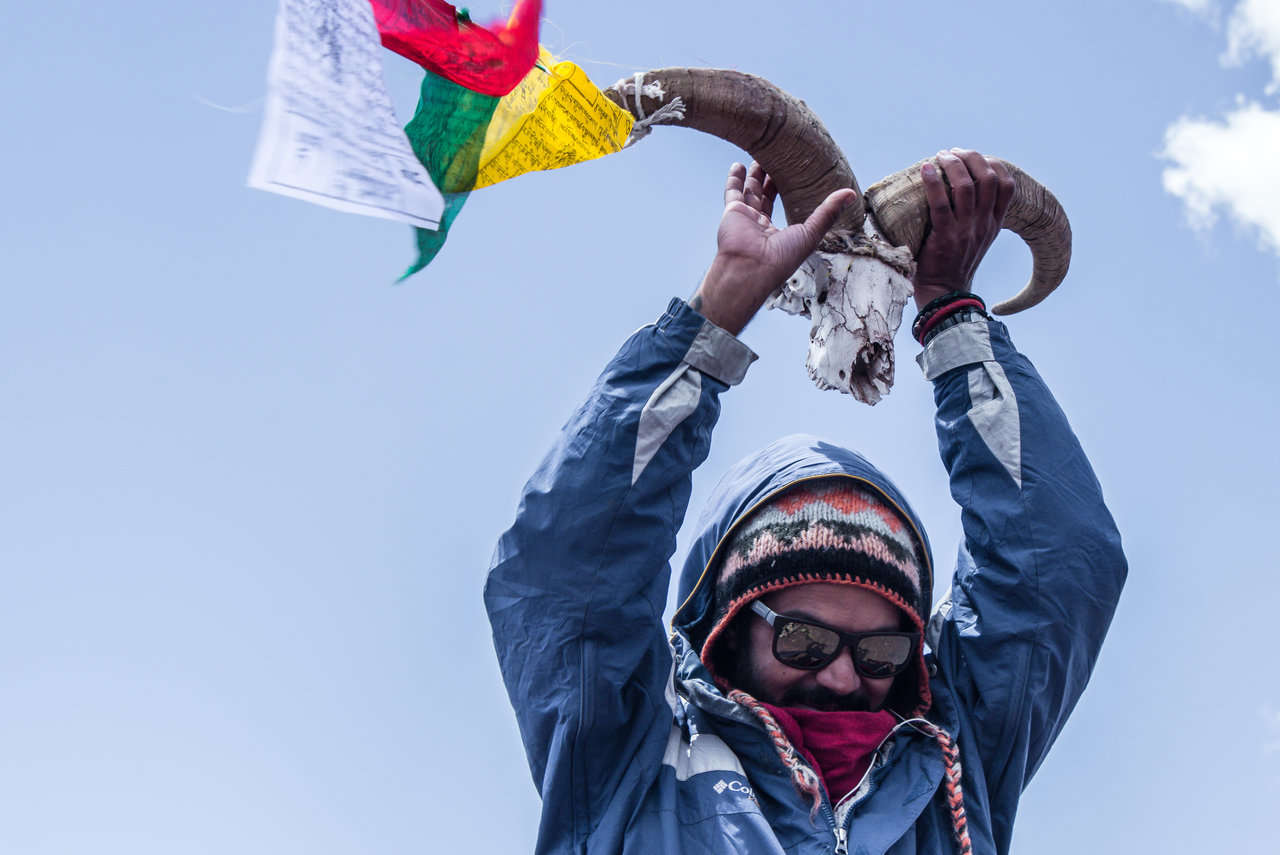
Related Tours
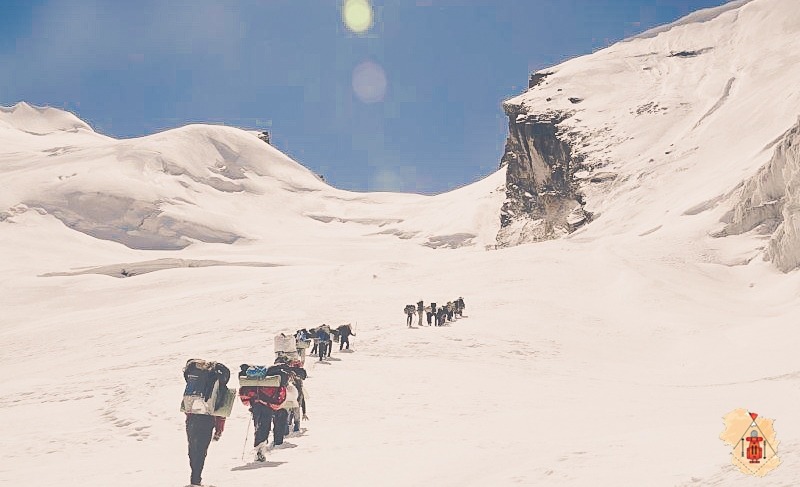
Auden's Col Trek
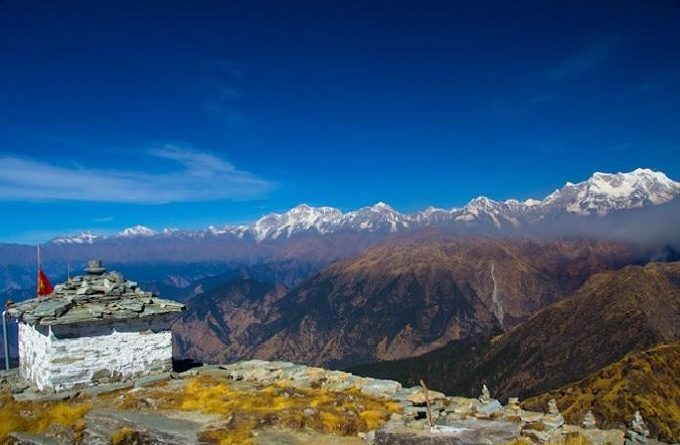
Deoriatal Chandrashila Trek
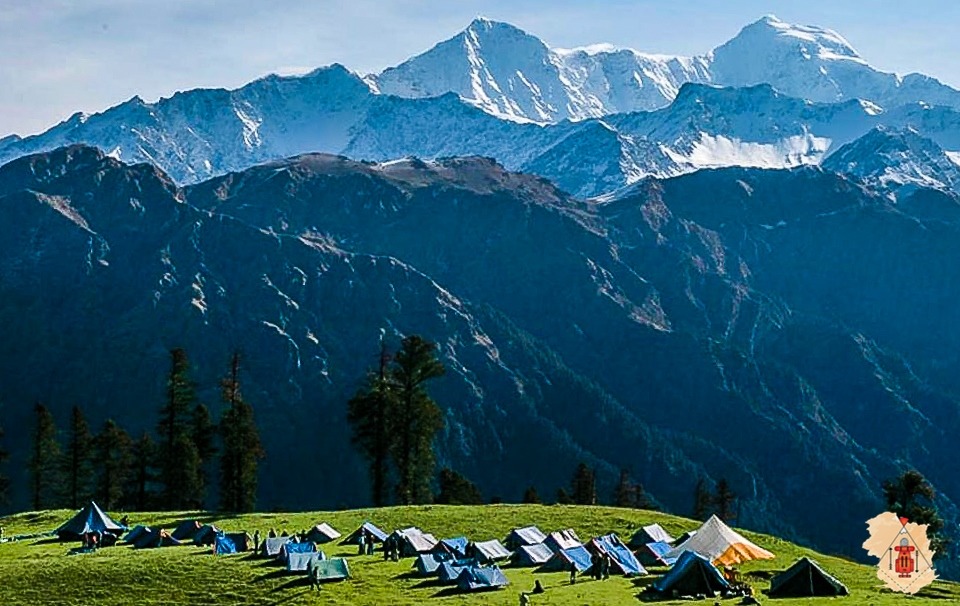
Dodital - Darwa Pass Trek
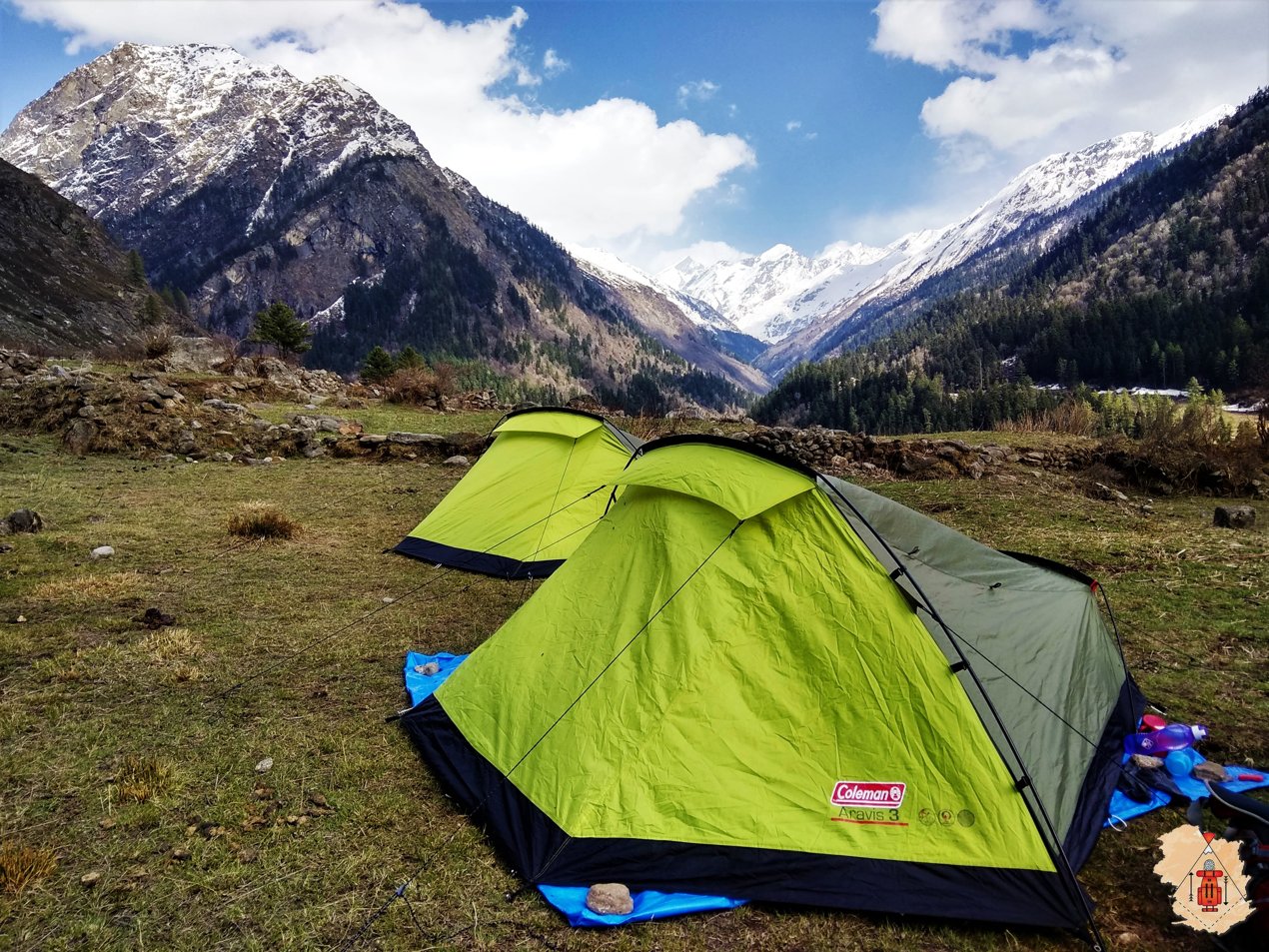
Har Ki Dun Trek
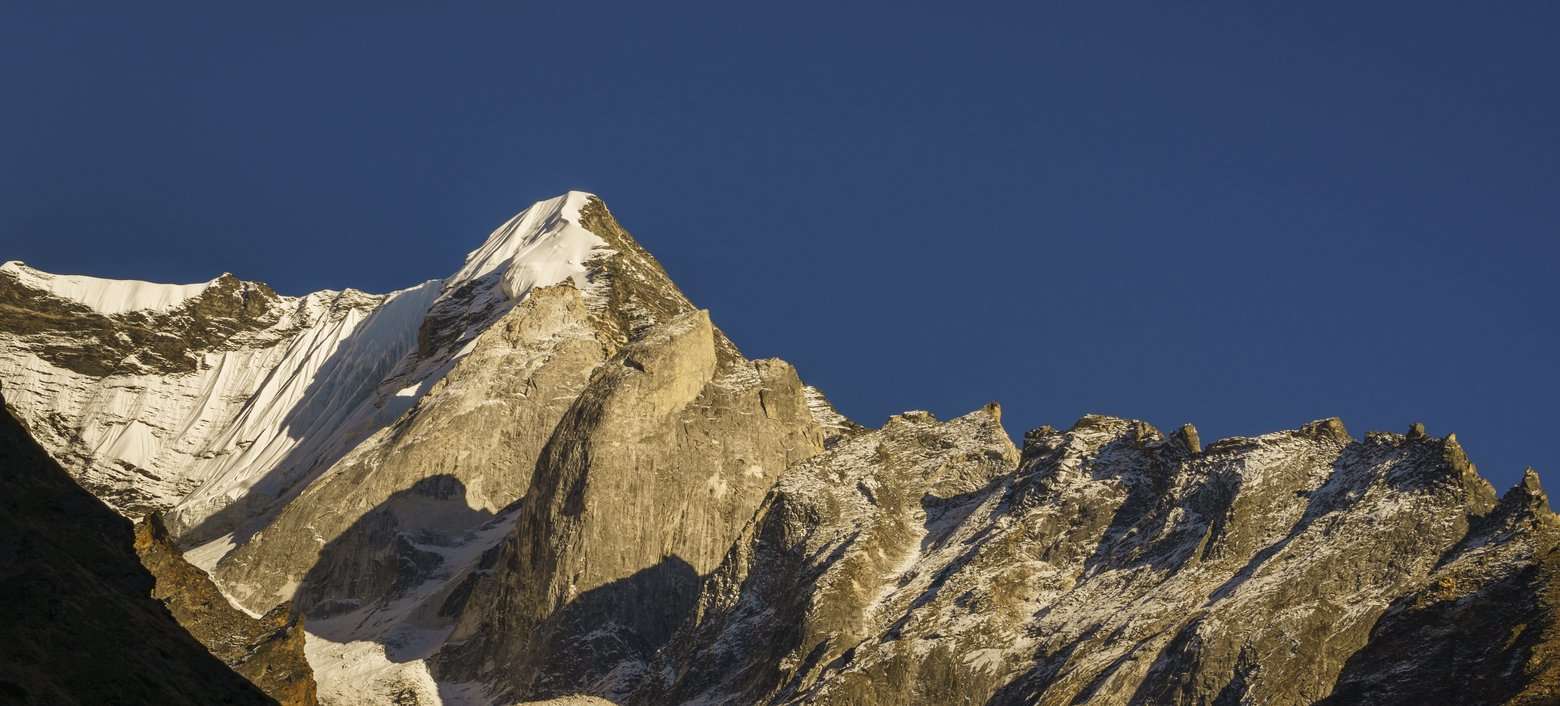
Kedartal Trek
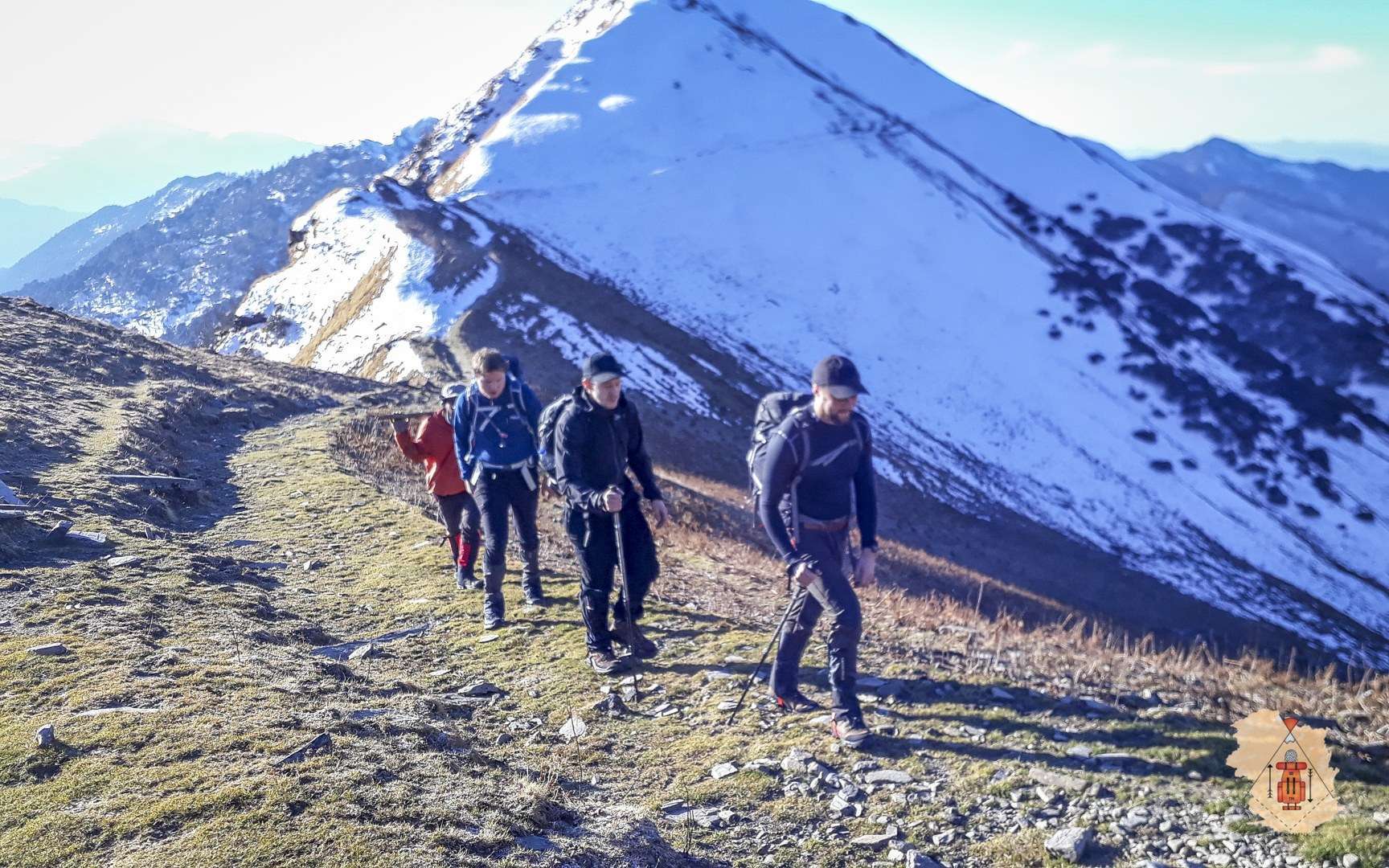
Kuari Pass Trek
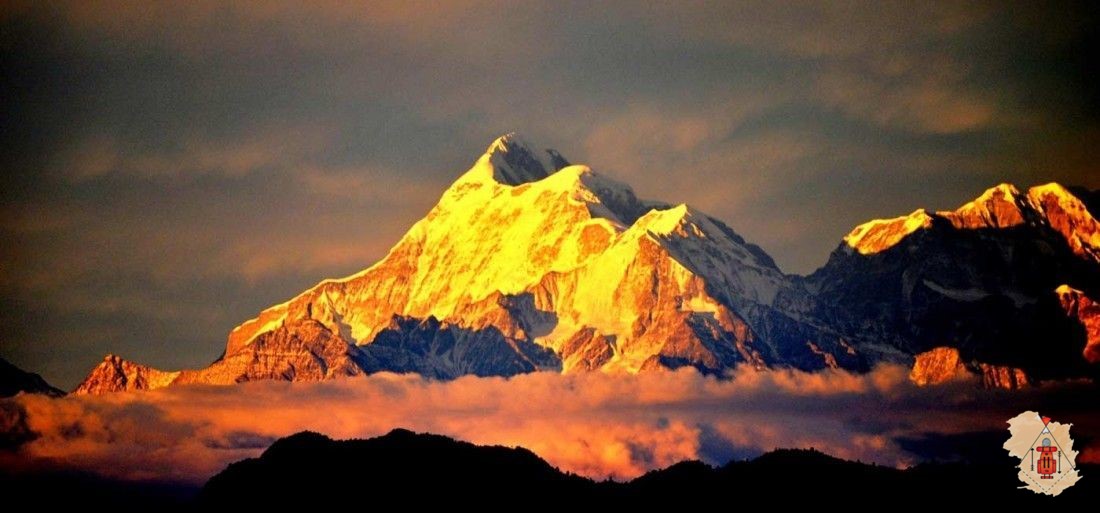
Nanda Devi Base Camp Trek
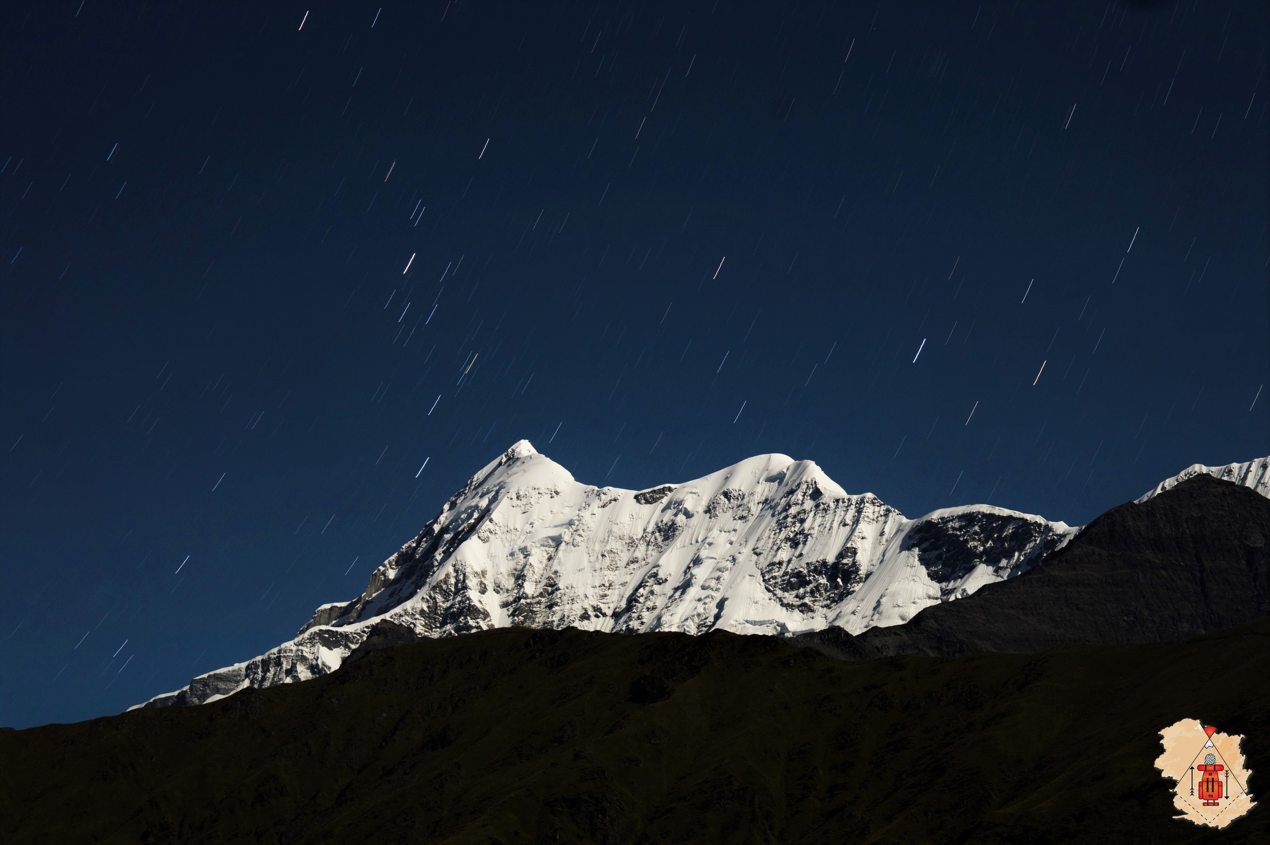
Roopkund Trek
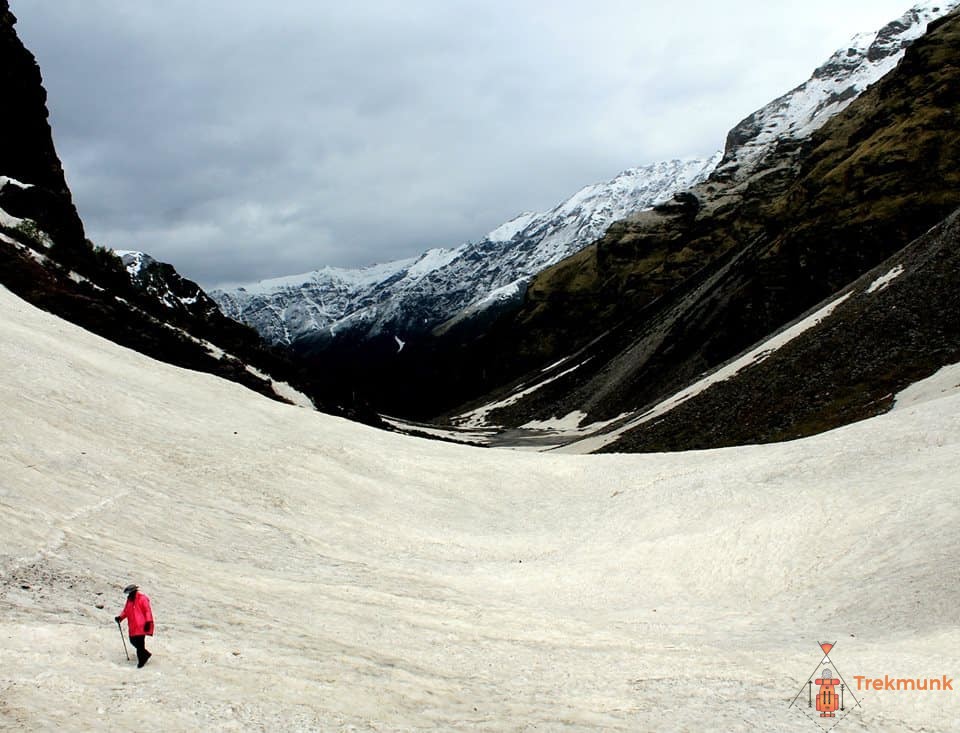
Rupin Pass Trek
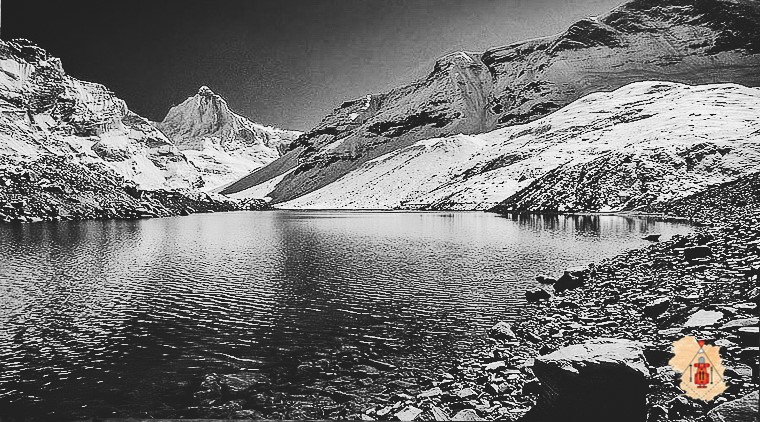
Satopanth Lake Trek
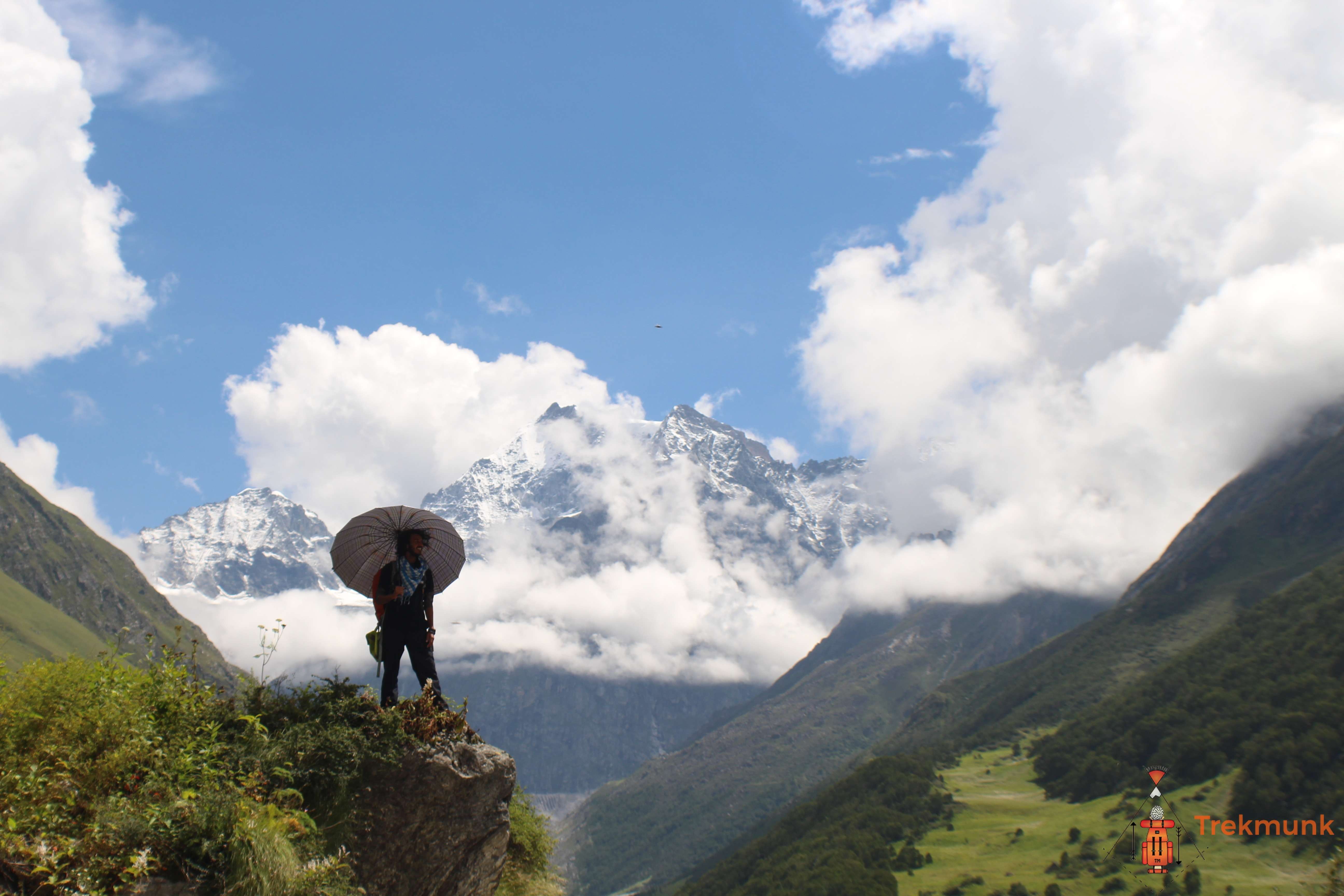
Valley of Flowers Trek

"Trekmunk is changing the indian trekking industry"
"10 Most Promising Adventure Sporting and Trekking Companies - 2020"

" Things you do for the Passion for Travel"
Hello there, How can we help you ?
Timing: 10 am to 6 pm IST (GMT +5:30)
Whats App Us

- Almora District
- Bageshwar District
- Chamoli District
- Champawat District
- Dehradun District
- Haridwar District
- Nainital District
- Pithoragarh District
- Pauri Garhwal District
- Rudraprayag District
- Tehri Garhwal District
Udham Singh Nagar
- Uttarkashi District
- Char Dham Yatra 2024
- Kartik Swami Temple
- Madhyamaheshwar Temple
- Kedarnath Dham
- Bansi Narayan Temple
- Bhavishya Badri Temple
- Narsingh Devta Temple
- Gopinath Temple
- Rudranath Temple
- Kalimath Temple
- Vishwanath Temple
- Kalinka Temple
- Kausani Hill Station
- Ranikhet Hill Station
- Kamal Tal Lake
- Sariyatal Lake
- Khurpatal Lake
- Chamba Hill Station
- Dhanaulti Hill Station
- Normal Trekking
- High Altitude Trekking
- Water Sports
- White water rafting
- Rajaji National Park
- Gangotri National Park
- Assan Barrage Bird Sanctuary
- Binsar Wild Life Sanctuary
- Jim Corbett National Park
- Nanda Devi National Park
- Valley of Flowers National Park
- Homestays in Uttarakhand
Use the form below to contact us directly.
Please complete all required fields.

Gaumukh Trek
Gaumukh is a sacred site located in the Uttarkashi district of Uttarakhand, India. It is the source of the holy river Ganges and is considered one of the holiest places for Hindus. The word "Gaumukh" means "cow's mouth" in Hindi, and the site is named after the glacier that resembles a cow's mouth.
Gaumukh is located at an altitude of 4,000 meters above sea level and is a popular trekking destination. The trek to Gaumukh is challenging and takes around 4-5 days to complete, depending on the route taken. Along the way, trekkers can enjoy breathtaking views of the Himalayan range and pass through dense forests, beautiful meadows, and quaint mountain villages.
Once at Gaumukh, visitors can take a dip in the icy-cold water of the river Ganges and offer prayers at the Gaumukh Temple, which is dedicated to Lord Shiva. The site is also popular among photographers and nature lovers, who come to witness the stunning beauty of the glacier and the surrounding landscape.
It is important to note that due to the fragile ecosystem of the region, visitors are required to obtain a permit from the forest department before embarking on the trek to Gaumukh. It is also advisable to take necessary precautions and carry appropriate gear, as the weather can be unpredictable and the terrain challenging.
Activities to do near Gaumukh Trek | Things to do near Gaumukh Trek
Here are some activities to do near the Gaumukh Trek:
- Trekking : Apart from the Gaumukh Trek, there are several other treks in the region that offer breathtaking views of the Himalayan range, including the Tapovan Trek, Nandanvan Trek, and the Gangotri-Kedarnath Trek.
- Camping : There are several camping sites near Gaumukh that offer stunning views of the surrounding landscape. Camping is a great way to experience the natural beauty of the region and to immerse oneself in the local culture.
- Wildlife spotting : The region is home to a wide variety of wildlife, including snow leopards, Himalayan tahr, musk deer, and several species of birds. Visitors can go on wildlife safaris and birdwatching tours to spot these animals in their natural habitat.
- Photography : The region is a photographer's paradise, with stunning landscapes, snow-capped peaks, and picturesque villages. Visitors can capture the beauty of the region through their lenses and take back memories that last a lifetime.
- Pilgrimage : The Gaumukh Temple, located at the source of the river Ganges, is a popular pilgrimage site among Hindus. Visitors can offer prayers at the temple and take a dip in the icy-cold water of the river.
Famous Tourist Attractions near Gaumukh Trek | Places to visit near Gaumukh Trek
Here are some famous tourist attractions near the Gaumukh Trek :
- Gangotri Temple : The Gangotri Temple is one of the most popular tourist attractions near the Gaumukh Trek. It is an ancient temple dedicated to the Goddess Ganga and is located in the town of Gangotri, at an altitude of 3,100 meters.
- Yamunotri Temple : The Yamunotri Temple is another popular pilgrimage site located near the Gaumukh Trek. It is an ancient temple dedicated to the Goddess Yamuna and is located at an altitude of 3,293 meters.
- Uttarkashi : Uttarkashi is a picturesque town located on the banks of the Bhagirathi River. It is known for its ancient temples, including the Vishwanath Temple and the Kuteti Devi Temple.
- Harsil : Harsil is a small village located on the banks of the Bhagirathi River. It is known for its scenic beauty and is a popular destination for nature lovers and adventure enthusiasts.
- Gangotri National Park : The Gangotri National Park is a protected area located near the Gaumukh Trek. It is home to a wide variety of wildlife, including snow leopards, Himalayan tahr, musk deer, and several species of birds. Visitors can go on wildlife safaris and birdwatching tours to explore the park.
- Tapovan : Tapovan is a high-altitude meadow located near Gaumukh in Uttarkashi district of Uttarakhand. The meadow is surrounded by towering peaks including Shivling, Meru, and Bhagirathi III, making it a popular destination among trekkers and mountaineers.
Tour Itinerary
Day wise itinerary to gaumukh trek | gaumukh trek full guide.
The Gaumukh trek is a challenging trek that takes around 8-9 days to complete, including travel time from Dehradun. Here is a day-wise itinerary for the Gaumukh trek from Dehradun:
Day 1: Dehradun to Gangotri (10-12 hours) Drive from Dehradun to Gangotri, a small town located at an altitude of 3,100 meters. On arrival, check into a hotel and rest for the day to acclimatize to the high altitude.
Day 2: Gangotri to Bhojbasa (14 km, 6-7 hours) Start early in the morning and trek from Gangotri to Bhojbasa, a trek of around 14 km that takes 6-7 hours. The trail passes through dense forests, beautiful meadows, and offers stunning views of the surrounding Himalayan range. Overnight stay at Bhojbasa.
Day 3: Bhojbasa to Gaumukh (4 km, 2-3 hours) Trek from Bhojbasa to Gaumukh, the source of the river Ganges. The trek is around 4 km and takes 2-3 hours. On arrival, spend some time exploring the site and offer prayers at the Gaumukh Temple. Overnight stay at Gaumukh.
Day 4: Gaumukh to Tapovan (5 km, 3-4 hours) Trek from Gaumukh to Tapovan, a trek of around 5 km that takes 3-4 hours. The trail passes through beautiful meadows and offers stunning views of the surrounding Himalayan range. Overnight stay at Tapovan.
Day 5: Explore Tapovan Spend the day exploring the scenic beauty of Tapovan and acclimatizing to the high altitude.
Day 6: Tapovan to Bhojbasa (9 km, 4-5 hours) Trek back from Tapovan to Bhojbasa, a trek of around 9 km that takes 4-5 hours. Overnight stay at Bhojbasa.
Day 7: Bhojbasa to Gangotri (14 km, 6-7 hours) Trek back from Bhojbasa to Gangotri, a trek of around 14 km that takes 6-7 hours. Overnight stay at Gangotri.
Day 8: Gangotri to Dehradun (10-12 hours) Drive back from Gangotri to Dehradun, a journey of around 10-12 hours, marking the end of the trek.
How to Reach
Location and how to reach gaumukh trek.
Location : Uttarkashi, Garhwal Region, Uttarakhand.
Nearest Railway Station to Gaumukh Trek : 265 km, Dehradun Railway Station.
Nearest Airport to Dodital Trek : 279km, Jolly Grant Airport, Dehradun.
Gangotri Town is from where Gaumukh Trek starts is well connected with major roads and several major cities.
Best Time to Visit
Best time to visit gaumukh trek | best time to explore gaumukhtrek.
The best time to visit Gaumukh is during the summer months from May to June and then from September to November , which are the post-monsoon months. During this time, the weather is pleasant, and the skies are clear, offering stunning views of the surrounding mountains.
It is advisable to avoid the monsoon season from July to August, as the region receives heavy rainfall, and the trekking routes become slippery and risky. Still if you are planning to visit during monsoon, be update with road and weather conditions.
The winter months from December to February are also not suitable for trekking due to heavy snowfall and extreme cold weather.
Inclusions & Exclusions
Inclusion
- During the trek, there will be places to stay in Camps or Tents (Camping)
- At Trek, all meals will be provided ( Healthy Food)
- At Camps, Bonfire will be provided according to weather conditions.
- For the Trek, there is fees for trekking permits and forest campsites.
- Trekking Supplies (Tents, Sleeping Bags, Ice Axes, Ropes, etc.)
- Expert Trek Leaders will there to Guide (Certified in basic/advanced mountaineering courses)
- A skilled trek crew (Guides, Chefs, Assistants, porters/mules) is available.
- Protective Gear (First Aid Kit, Medical Kit, Oxygen cylinders (if necessary), stretcher, etc.)
- Trek Certificate for Completion.
- Basic Survival Techniques in forest by using natural resources etc.
- GST (Service Tax)
- Offloading Fees for Backpacks (Rs.250 Per day/Per bag)
- Food on the way to Base and from Pick and Drop
- Offloading fees for backpacks (Rs. 250/day/bag)
- Anything not mentioned in Inclusion
- Any personal Expense
Cancellation Policy
At the time of booking, full payment is required.
For the Cancellation due to any reasons, Uttarakhand Guide must be notified of the same in writing at [email protected] . At the time we receive your written cancellation statement, refunds policies will be applicable according to following conditions:
Cancellation before 30 days from the start of Trip
10 % will be deducted from total
Cancellation between 21 to 30 Days from start of Trip
35 % will be deducted
Cancellation between 10 to 21 Days from start of Trip
50 % will be deducted
Cancellation less than 10 days from start of Trip
No amount will be refunded
Note: After the cancellation date, the refund will be handled within 10 working days.
Cancellation fees will be determined based on the total trip cost, and they may vary depending on the date of departure and the date of cancellation.
There will be no refunds:
- For any missed/unused tour services, including meals, owing to any reason.
- If the tour's services are changed, altered, revised, cancelled, or not used.
- If a customer cancels or is forced to cancel the tour due to changes in the itinerary or travel
- If the consumer is dissatisfied with any of the operator's services
Top Destinations

Uttarkashi, kashi of north is situated on the banks of river Bhagirathi at an altitude of 1158 m above sea level.
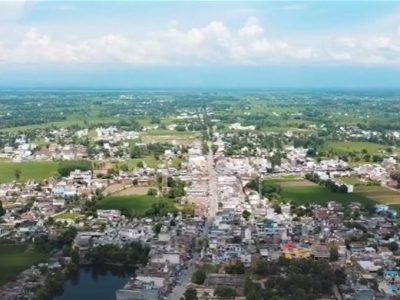
Udham Singh Nagar is a district located in the state of Uttarakhand in Kumaon Region, India. It was carved out of the Nainital district and came into existence on 30th September 1995.
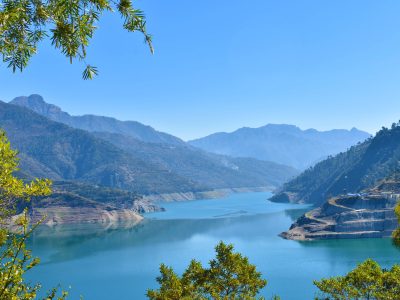
Tehri Garhwal
Tehri Garhwal District, located in the state of Uttarakhand, India, is a mesmerizing region renowned for its natural beauty, spiritual significance, and cultural heritage.
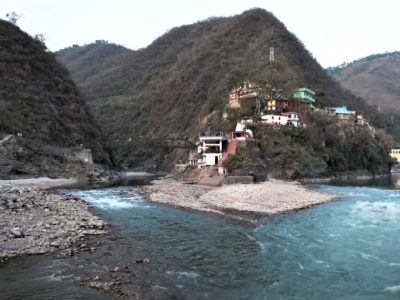
Rudraprayag
Rudraprayag is a picturesque town located in the Rudraprayag district of Uttarakhand, India. It holds significant religious and cultural importance as it is situated at the confluence of two sacred rivers, Alaknanda and Mandakini.

Pithoragarh
Nestled in the eastern reaches of the picturesque Kumaon region, Pithoragarh stands as a breathtaking district in the scenic state of Uttarakhand, India.
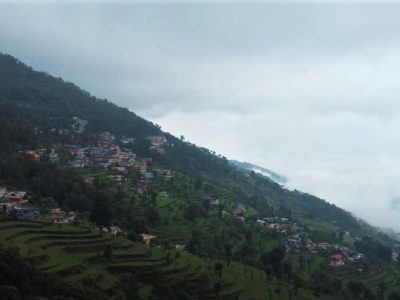
Pauri Garhwal
Pauri Garhwal District, situated in the breathtaking state of Uttarakhand, India, is a hidden gem that offers a soul-stirring experience for tourists seeking a blend of natural beauty, spiritual serenity, and cultural heritage.
Discover Uttarakhand
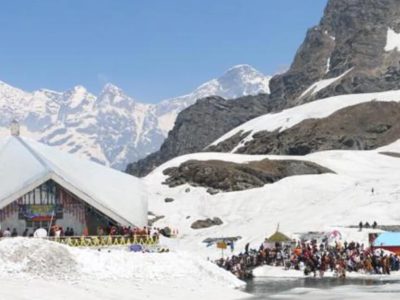
Pilgrim’s body recovered day after avalanche
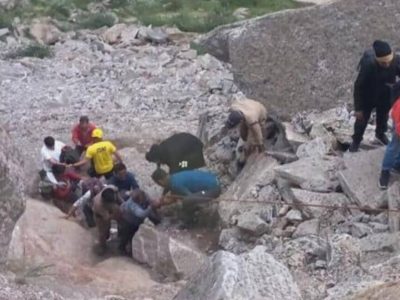
Over 180 Adi Kailash pilgrims rescued from landslide-hit road stretch
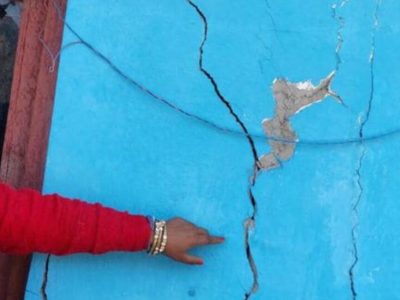
Monsoon sparks apprehensions of further geological instability in Joshimath
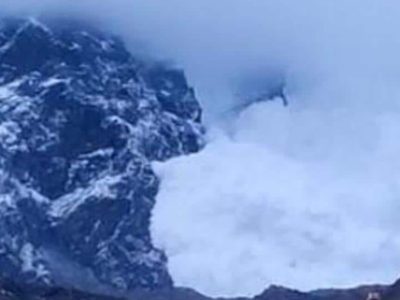
Massive avalanche hits mountains around Kedarnath Temple
Trending tourist places.
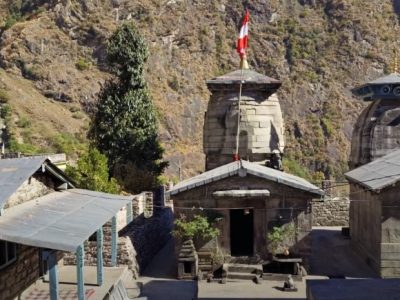
Yogdhyan Badri Temple – Chamoli, Uttarakhand
Yogdhyan Badri is one of the sacred Panch Badri temples located in the picturesque state of Uttarakhand, India. Situated amidst…
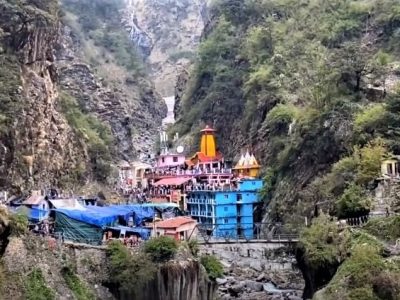
Yamunotri Dham Trek
Yamunotri Dham is one of the four sacred sites, collectively known as Chota Char Dham, which are located in the…
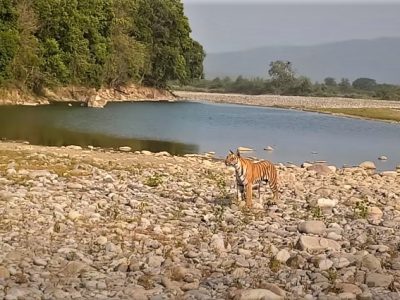
Wild Life Safari in Uttarakhand
The state is home to several national parks and wildlife sanctuaries, providing a chance to observe a wide range of…
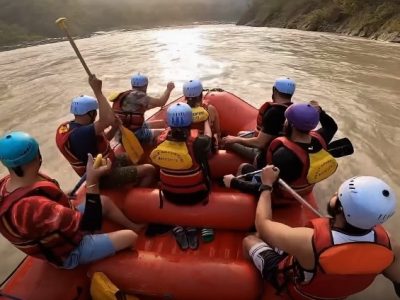
White Water Rafting
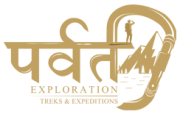
Level: Moderate
Gaumukh tapovan trek.
- Pre-monsoon
Fixed Departure:
Pre-Monsoon 2024 Dates
- 11,18 & 25 May 2024
- 1,8,15 & 22 June 2024
Send Your Requirement:
Brief description.
The Gaumukh Tapovan Trek, nestled in the Garhwal Himalayas, is a captivating journey that unfolds amidst breathtaking landscapes and spiritual significance. Commencing from Gangotri, the trail meanders along the Bhagirathi River, passing through dense forests and revealing awe-inspiring views of the Bhagirathi peaks. The trek reaches its pinnacle at Gaumukh, the sacred source of the Ganges River, offering a profound spiritual experience. Continuing further, the route leads to Tapovan, a mesmerizing meadow framed by the imposing Shivling, Meru, and Bhagirathi peaks. This alpine haven allows for exploration and reflection, with opportunities to climb nearby vantage points for panoramic views. As trekkers descend, they traverse back through Chirbasa and Bhojbasa, concluding the expedition back at Gangotri. The Gaumukh Tapovan Trek not only challenges adventurers physically but also presents an immersion into the pristine beauty and spiritual essence of the Garhwal Himalayas.
Highlights and Key Features
Technical detail, participant eligibility and health requirements for the trek.
Age Limit: Participants from 08 years and above are welcome to join the Trek.
Experience Level: First-timers are encouraged to apply, and while previous trekking experience is appreciated, it is not mandatory.
Physical Fitness: Participants should be capable of carrying a 12 kg Rucksack (backpack). Fitness is crucial, and climbers must possess sufficient stamina to cover a distance of 4 km in 32 minutes without experiencing undue stress.
Health Requirements: – Resting pulse rate: 60 to 90 beats per minute – Blood Pressure: Diastolic 75 – 85 mm Hg, Systolic 100 – 130 mm Hg – Resting respiratory rate: 12 to 20 breaths per minute – No history of liver and kidney issues – Absence of Diabetes Mellitus, Bronchial Asthma, Epilepsy, Heart problems, Hypertension, etc. – No existing health issues that might adversely impact the participant during the trek – BMI under 25 (Exceptions for individuals with heavy bone density and those regularly engaged in weightlifting exercises)
Pre-Existing Conditions: Participants with any pre-existing medical conditions or those currently on medication must declare it in the Self Declaration form.
Special Casual Leave for Government Employees: Parvat Exploration, a registered adventure tour operator, allows government employees to avail of Special Casual Leave (SCL) for up to 30 days in a calendar year, as per the rules of the Pay Commission. This benefit applies when participating in trekking or mountaineering expeditions organized by a registered adventure organization like Parvat Exploration.
Special Note for Junior Trekkers: For participants below 15 years, a parent or guardian must accompany them. Trekkers aged 15 to 18 can participate solo but must provide a signed disclaimer form from a parent or guardian.
Parvat Exploration ensures that participants meet the necessary health and fitness criteria, promoting a safe and enjoyable trekking experience in the breathtaking landscapes of the Uttarakhand Himalayas
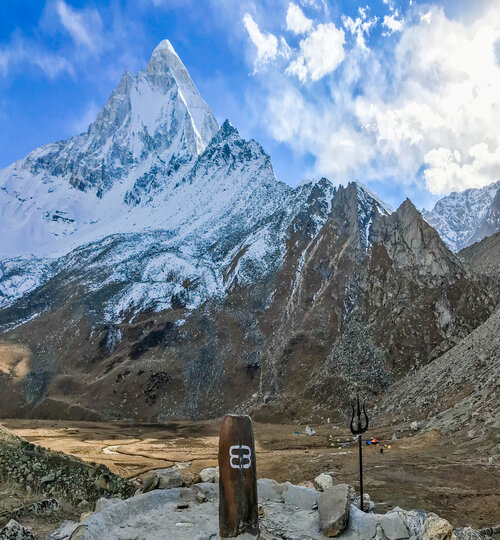
Day 1: Arrive in Gangotri (3065 M):
Begin your Gaumukh Tapovan Trek by departing from Dehradun early in the morning, embarking on a scenic drive to Gangotri that spans approximately 10-12 hours. Your journey commences as you arrive in the sacred town of Gangotri, nestled at an altitude of 3065 meters. Take in the spiritual ambiance and check into your accommodation. Spend the day acclimatizing to the altitude and exploring the revered Gangotri Temple. Meet your trekking guide for a briefing on the upcoming adventure. Enjoy a wholesome dinner and rest for the trek ahead.
Day 2: Gangotri to Bhojbasa (3785 M). via Chirbasa:
After breakfast, embark on your trek from Gangotri to Bhojwasa, The trail follows the gushing Bhagirathi River, surrounded by snow-capped peaks and lush greenery. Arrive at Bhojwasa, a scenic campsite situated at an elevation of 3785 meters. Set up camp, enjoy the panoramic views, and acclimatize to the higher altitude. Dinner will be served at the camp, and you’ll spend the night surrounded by the tranquility of the mountains.
Day 3: Bhojwasa to Tapovan(4452 m) via Gaumukh ( 4105 m):
Resume your trek towards the mesmerizing Tapovan, passing through the sacred Gaumukh, the source of the Ganges. The trail takes you through rugged terrains and offers stunning views of the surrounding peaks. Arrive at Tapovan, an enchanting high-altitude meadow at 4452 meters, surrounded by towering mountains. Set up camp and marvel at the breathtaking scenery. Dinner and overnight stay at Tapovan.
Day 4: Exploration Day at Tapovan : Today is dedicated to exploring the beauty of Tapovan and its surroundings. You have the option to hike to nearby viewpoints, witness the grandeur of Shivling Peak, and absorb the spiritual energy that permeates the area. Spend the day in contemplation or capture the stunning landscapes with your camera. Dinner and another night at Tapovan.
Day 5: Tapovan to Bhojwasa
Bid farewell to Tapovan as you descend back to Bhojwasa. The downhill trek offers a different perspective of the landscape, allowing you to appreciate the beauty of the region. Arrive at Bhojwasa, where you can relax and enjoy a well-deserved rest.Dinner and overnight stay at Bhojwasa.
Day 6: Bhojwasa to Gangotri:
Commence your trek back to Gangotri, retracing your steps through the scenic trail. Arrive in Gangotri by afternoon, where you can explore the town or visit the sacred Gangotri Temple once again. Check into your accommodation, rest, and savor the memories of your mountain adventure. Dinner and overnight stay in Gangotri.
Day 7: Depart from Gangotri to Dehradun:
On the final day, bid farewell to the holy town of Gangotri. Depart for Dehradun, reflecting on the spiritual and natural experiences encountered during your trek. The journey back provides scenic views as you travel through the mountains. Arrive in Dehradun, marking the end of your sacred journey. Depart with a heart full of memories and a sense of reverence for the majestic Himalayas.
Inclusion & Exclusion
- Accommodation in lodge on day 1 & 6 & camps on day 2,3,4&5 on triple sharing basis.
- Forest permits/camping charges,
- Delicious & nutritious vegetarian food ( meals: breakfast, lunch, snacks & dinner).
- Day 1 dinner to day 7 breakfast.
- Camping equipment (sleeping bag, mattress, 4-season tents,toilet tent& dining tent).
- Trek guide, cook, helpers, porters & services of a certified trek leader (BMC or AMC qualified).
- Transportation from Dehradun to Gangotri and back to Dehradun.
- Technical equipment like gaitors & spikes
- Safety equiptments: basic first aid , oxygen cylinder, ropes
- Meals during road journeys.
- Permit for Foreign Nationals.
- Carriage of Personal Bags during the trek.
- Any kind of Insurance.
- Any expense of personal nature.
- Rental of Personal Equipments.
- Any expense not specified in the inclusion list.
- Any evacuation cost or Medical treatment cost.
- Any extra costs incurred caused in the event of finishing the expedition early.
- Tips for local guides or porter.
- Any cost arising out of unforeseen circumstances such as bad weather, landslides, road condition and any other circumstances beyond our control.
Things to Carry
Essential Trekking Gear: 1. Rucksack bag with rain cover – Qty: 1 2. Day pack bag (recommended for treks with summit day) 3. Head torch with spare batteries – Qty: 1 4. UV protection sunglasses – Qty: 1 5. Water bottles: 2 bottles of 1 liter each Footwear: 6. Non-skid, deep-treaded, high-ankle trekking shoes – Qty: 1 7. Pair of lightweight slipper/sandals – Qty: 1 Clothing: 8. Quick-dry warm lower or track pants – Qty: 2 9. Full sleeves T-shirts/sweatshirts – 1 for every 2 days of trekking 10. Pair of thick woolen socks – 1 pair for every two days of trekking 11. Thermal body warmer upper & lower – Qty: 1 12. Undergarments – Qty: 1 for every day of trekking 13. Warm jacket closed at wrist & neck – Qty: 1 14. Full sleeves sweater – Qty: 1 15. Rainwear (jacket & pants) – Qty: 1 16. Pair of waterproof, warm gloves – Qty: 1 17. Woolen cap – Qty: 1 18. Sunshielding hat – Qty: 1 Toiletries: 19. Personal toiletries kit (small towel, toilet paper, paper soap, bar soap, toothbrush, toothpaste, cold cream, etc.) 20. Sunscreen lotion small pack – Qty: 1 21. Lip balm small pack – Qty: 1 Utensils: 22. Small size, lightweight & leak-proof lunch box – Qty: 1 23. Plate – Qty: 1 24. Spoon – Qty: 1 25. Tea/coffee (plastic) mug – Qty: 1 Miscellaneous: 26. Camera (optional) 27. Carry your medicines in plenty in case you have any specific ailment. Consult your doctor before joining the trek. 28. Dry fruits, nuts, chocolate bars (optional) Note: This comprehensive list covers essential items for a trek with Parvat Exploration. Adjustments can be made based on specific trek requirements and personal preferences. Participants are advised to double-check with Parvat Exploration for any trek-specific recommendations or variations in the list.
Parvat Exploration: Your Trusted Himalayan Guides
Embark on an unforgettable adventure with Parvat Exploration – where expertise meets passion. Here’s why choosing us for your trek is the key to an extraordinary Himalayan experience:
1. Highly Qualified Team, Seasoned in Indian Mountaineering : Join a team of seasoned mountaineers with a wealth of experience navigating the challenging terrains of the Indian Himalayas. Our expertise is your assurance of a trek that combines adventure with safety and knowledge. 2. Exclusive IMF Associate Membership: Trust your journey with the best, as three of our team members hold an esteemed position as associate members with the Indian Mountaineering Foundation (IMF). This exclusive membership is limited to only 100 individuals in India, highlighting the caliber and dedication of our team. 3. Local Expertise – Meet Team Parvat Exploration, a Himalayan Native : A proud local born and raised in Uttarakhand. The Himalayas are not just our workplace; they are our home. With Team Parvat Exploration as your guide, you’ll experience the mountains through the eyes of someone deeply connected to its culture, people, and nuances. 4. Accredited by ATOAI, IMF & Uttarakhand Tourism: Parvat Exploration proudly stands as an affiliated firm with the Adventure Tour Operators Association of India (ATOAI), the Indian Mountaineering Foundation (IMF), and Uttarakhand Tourism. Our triple accreditation underscores our commitment to responsible and high-quality trekking adventures. 5. Safety is Our Pledge: Your safety is our topmost priority. At Parvat Exploration, safety isn’t just a priority; it’s a fundamental principle that guides every aspect of our treks. Rest assured, you’re in capable hands as we navigate the trails with your well-being as our foremost concern. 6. World-Class Equipment: Equip yourself with the best, as we provide world-class gear. Our equipment is meticulously maintained and regularly updated to meet the highest industry standards, ensuring your comfort and safety throughout the trek. 7. Delicious and Nutritious Food with Local Delicacies: Savor the journey with our culinary delights. Our team takes pride in offering not just nourishing meals but also a variety of options, including delicious and nutritious local dishes. Immerse yourself in the rich flavors of the region as you trek through the breathtaking landscapes. 8. Expert Trek Leaders – AMC Qualified: Our trek leaders are not just leaders; they are minimum AMC qualified from recognized institutes. This ensures that you are guided by professionals who understand the nuances of mountain terrain and are well-prepared for any challenges that may arise. 9. Seasonal Specialization – All Year Adventure: Parvat Exploration specializes in mountaineering during the prime season and offers captivating winter treks. Whether you’re drawn to the thrill of summer ascents or the serene beauty of winter landscapes, we have the expertise to make your trek extraordinary, regardless of the season. Choose Parvat Exploration for a trek that transcends the ordinary. Your Himalayan adventure awaits, crafted with expertise, passion, and a commitment to making your journey truly exceptional.
Subscribe to our newsletter
Registered address.
150 Harbajwala, Dehradun, Uttarakhand: 248171
Garhwal Head Office
228 Ward No 05, Barkot, Uttarkashi, Uttarakhand: 249141
Kumaon Head Office
Matena, Near KMVN, Almora, Uttarakhand: 263601
- Privacy Policy
- Terms & Conditions
- Environmental Policy
- Cancellation Policy
Parvat Exploration
05ABCFP5491P1ZN
UTDB Cert. No.:
UTTR/ALMORA/13-2023/006463
+91 72176 50905
+91 94561 12947, +91 95281 25747, [email protected], affiliations.
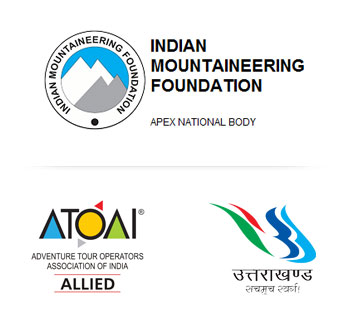
Copyright © 2023 Parvat Exploration. All rights reserved.
Website Developed by Veb Design Solutions
Start typing and press enter to search
India's Highly Recommended Trekking Company
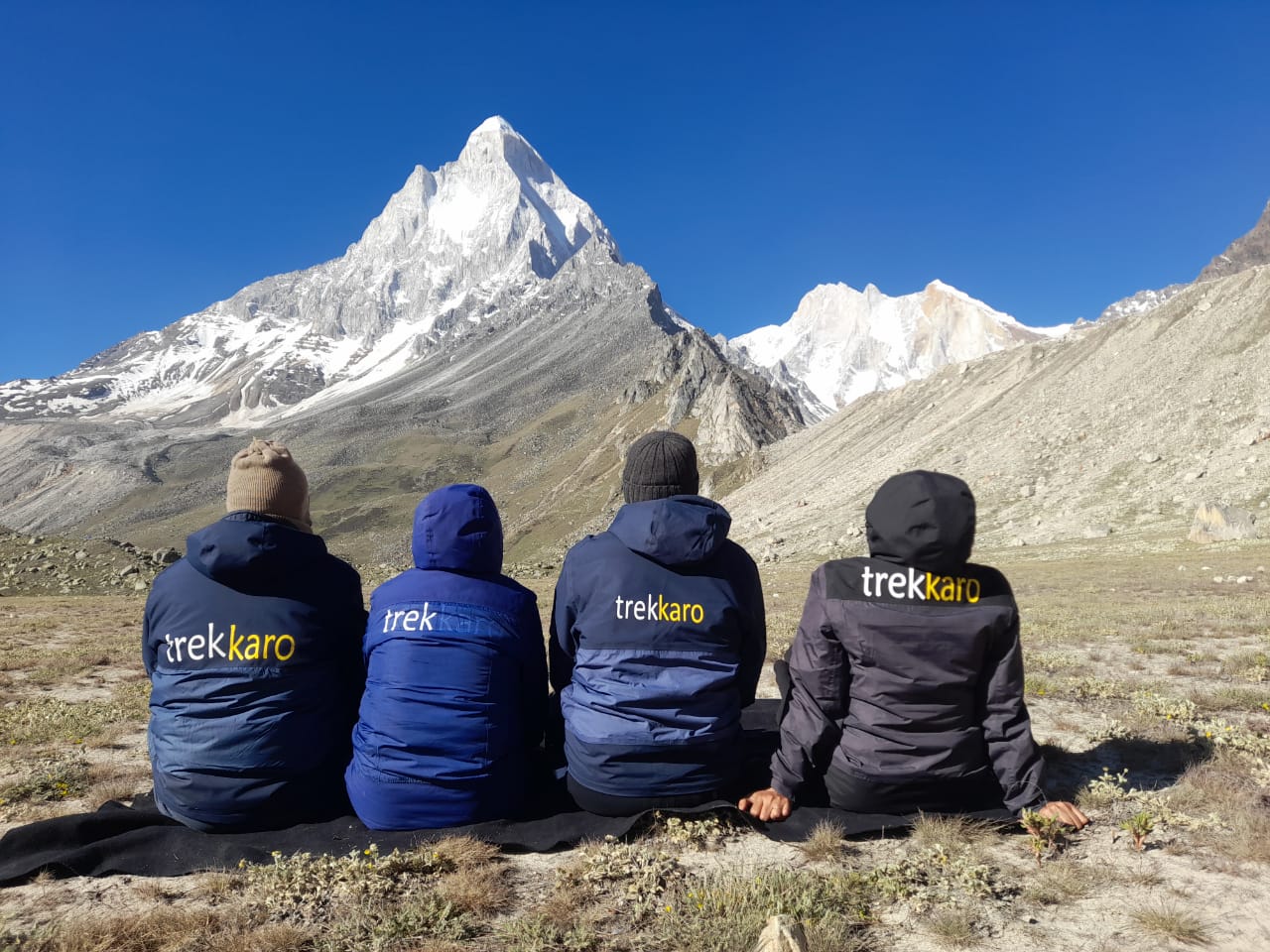
Gaumukh Tapovan Trek
₹20,085 (flat 40% off), ₹ 15,450, (gangotri to gangotri), service tax @ 5% (gst), + single tent occupancy: ₹ 2,000, + backpack offloading: ₹ 2,400, + ftg (100% refundable*): ₹ 3,000, batch availability.
- Overview & Itinerary
The word “Gaumukh" (Gau = Cow, Mukh = Mouth) literally means "Mouth of a Cow." According to legends, earlier the snout exactly looked like the "Mouth of a Cow." The word “Tapovan” (Tapo = Spiritual Practice, Van = Forest). Tapovan then translates to the forest of severities or spiritual practice.
Gaumukh is one of the primary headstreams of the Holy Ganges River which is situated at a height of 12,795 ft. in Uttarkashi District in the state of Uttrakhand. Gaumukh is 18 km from Gangotri Temple in the foothills of Bhagirathi. It is the snout of the Gangotri Glacier. The Bhagirathi River here is pretty speedy. Around the snout, nature presents a wild topography. There are many boulders scattered here and there with some pieces of broken snow, along with the hard clayey snow of the glacier. Little before Gaumukh, the majestic view of Mt. Shivling welcomes the trekkers. The trek to Tapovan, Nandanvan, Vasuki Tal, etc. starts from here. Tapovan is an area full of meadows, streams, and flowering plants, and meadows are considered one of the best high-altitude meadows in India. Tapovan is the base camp for several mountaineering expeditions including Shivling peak, Bhagirathi peak, etc.
Best time to visit: May-June and September-October. Expect hiking in the snow at the beginning of May. September and October are pleasant times to trek here. After October, it is generally not advisable to trek alone due to the extreme cold. After November, expect heavy snow in the area.
Trek Itinerary
The drive from Dehradun to Gangotri passes through the Uttarkashi, Mussoorie and the popular villages of Gorsali, Bhatwari, Harshil, and Dharali. Gangotri is the base camp for the Vasuki Tal trek. The shrine of Gangotri is surrounded by deodars and pines forest. Gangotri is one of the four pilgrimages in the Chota Char Dham circuit of Garhwal Himalayas and the source of river Ganga (the actual source being Gomukh) which is known as Bhagirathi here, 10-11 hours’ drive from Dehradun. Transport will be arranged at an additional cost from Dehradun Railway Station at 06:30 AM. Cost of Cab – Rs. 8,000/- per vehicle. After relaxing, we shall visit the Holy Gangotri Devi temple for prayers, roaming the local market, striking a conversation with a Sadhu, exploring the secret cave and learn a few words of the local language; it is appreciated and often results in getting more than the experience. Before having the delicious dinner, we will have a team introduction session and briefing about tomorrow's trek after dinner.
The very first day of the Gaumukh-Tapovan trek starts from Gangotri to Chirbasa, which takes about 5-6 hours to reach there. It is a beautiful trek with mountains surrounding you and Ganga flowing below. Around Chirbasa (Chir: Pine, basa: Residence), you get superb views of Manda peak, Bhrigu Parvat, Bhagirathi I, II and III. Overnight stay in tents.
Wake up to spectacular fluorescent views of sun rays on mountain peaks, and get ready to slog again. After 3 km of Chirbasa comes the dangerous Gila Pahar, the place well known for the landslides. Bhojbasa is the only night halting-place on the trek with buildings. Bhojbasa named after birch (Bhojpatra) forests in the area. It is presently totally denuded of the Bhoj Patra trees. Overnight stay in tents.
The trek from Bhojbasa to Khada Patthar is quite difficult. It is a fairly gradual ascent. The first 200 meters trail from Bhojbasa is slightly steep, and it merges to trail from Gangotri to Gaumukh. At Gaumukh: snout, where river Bhagirathi emerges from Gangotri glacier, starts its journey. It flows down the slopes of the mountain and merges with tributaries, and become Holy Ganges. This is the place where Hindus believe the Ganges take birth. From here the trek will start more difficult. The glacier is covered by moraine so you do not need any technical equipment, although a steadying trekking pole is definitely handy. Take the final leg up the steep rocky path to enter the Tapovan meadow and view the spectacular sight all around you. Tapovan is surrounded by Bhagirathi peaks on one side, and imposing Shivling peak and Meru peaks on the other. From here, Khada Patthar is 1 Km away. Overnight stay in tents.
Get up early to see the spectacular sight of the sunrise on the surrounding 6,000 meters peaks. You would be rewarded with amazing views of first rays of sun falling on Shivling, Kedar Dome and Kharcha Kund peaks. The theatre of nature here is vast and limitless. Imagine standing at a meadow just beneath the stone feet of Bhagirathi peaks, which also happen to be a plateau overlooking Gangotri glacier flowing to Gaumukh, and with meadows of Tapovan on the other side. And just above Tapovan is majestic Shivling peak with Meru peak on its right (toward North). And turn your neck a bit towards South West, you will get a glimpse of Kirti glacier, and then see the smooth peak of Kedar Dome hiding Kedar peaks behind it. Next to the Dome is intricate-looking Kharcha Kund peak. Turn your neck a bit left and you are seeing again the Gangotri glacier coming from somewhere far away. Today you will retrace your steps to Bhojbasa. Below the glacier, a steep descent is followed by the glacier’s rocky path and gradual descent to Bhojbasa. Overnight stay in tents.
Today is the final day of the Gaumukh-Tapovan Trek. The trek involves a gradual descent and easy walk which can be done rapidly. Get up comfortably and have breakfast, trek to Gangotri to witness the famous Ganga Aarti at the Holy Gangotri Devi Temple. This should not be missed. The original temple was constructed by the Nepalese General Amar Singh Thapa. Every year thousands of people visit this shrine from all around the world. A number of Dharamshalas and Ashrams are located on the other side of the river. It is believed that Raja Bhagirath used to worship Shiva on a slab of rock "Bhagirath Shila”, situated near the temple for salvation or Moksha of the souls of his 60,000 sons. Submerged in the river, there is a natural Shivling where, according to mythology, Goddess Ganga descended when Lord Shiva released the mighty river from the locks of his hair. Spend the entire day exploring this fascinating town. Relax in the peaceful surroundings of the gushing river. We would stay overnight.
Depart from Gangotri to Dehradun Railway Station early in the morning, preferably before 06:30 AM since the journey takes 10-11 hours. Expected to reach Dehradun by 07:00 PM. Transport will be arranged at an additional cost from Gangotri at 06:30 AM. Cost of the cab – Rs. 8,000 per vehicle.
How to reach
Jolly Grant airport is located 25 kilometers from the city, serving Dehradun. Daily flight from Delhi to Dehradun.
Take the train from Delhi to Dehradun overnight
• Nanda Devi Express(12205):- Departure:- 23:50; Arrival:- 05:40
• Dehradun Express(12687):- Departure:- 21:10; Arrival:- 05:00
Regular bus service is available from Delhi (ISBT Kashmere Gate) to Dehradun. We suggest that you take only government buses from the ISBT Kashmere Gate. Private buses run from outside ISBT Kashmere Gate and they are not trustable.
Usually, the buses left you in the Dehradun ISBT. From there you have to come to Dehradun railway station via Ola/Uber Cab/Auto Rickshaw/Shared Three Wheeler. There are few buses run by the Uttarakhand Government on a daily basis from Dehradun Railway Station to Gangotri. The timing of the bus: 05:30 AM. You would reach Gangotri by 06:00 PM.
Things to carry
- Basic Gears
- Accessories
- Mandatory Documents
• Backpack & Rain Cover (40-60 Litres)
• Trekking Shoes (included in FTG)
• Trekking Pole (included in FTG)
• LED Torch/Headlamp
• Two Water Bottle (one liter each)
• Basic Medications (or prescribed if any)
• Trekking Jacket (included in FTG)
• Three (Five in winter) Warm Layers
• Two trek pants (one Wear and one carry)
• Two collared t-shirts
• Thermals
• Sunglasses
• Sunscreen Lotion (SPF 50/70)
• Lip Balm (SPF 30)
• Sun cap
• Synthetic hand gloves
• Two pairs of Socks
• Raincoat/Ponchos
• Daypack (20 liters), if you opt to offload your backpack
• Toiletries
• Cutlery
• Plastic cover (for wet clothes)
• Original and photocopy of government photo identity card- (Passport, Aadhaar Card, Driving license, or voters ID)
Terms & Conditions
1- Free Trekking Gears: Shoes, Jacket(-10°C), and Pole.
2- Accommodation: Full-load camping arrangements on the mountain with a large mess and kitchen tent. Stay from Day 1 to Day 6 (Gangotri to Gangotri). In Gangotri, Stay will be in a Guest House/Camp/Home Stay on a sharing basis. You will camp on the trek (3 people per tent).
3- Meals: All meals during the trek starting with dinner on Day 1 till breakfast on Day 7. (Only Veg.) Tea/Coffee/Soups/Snacks will be served throughout.
4- Camping charges: All trekking permits and forest camping charges are included (if any).
5- Leaders & Guides: Trek leaders are assisted by certified and experienced local guides.
6- Trekking Equipment: High-quality tents, sleeping bags, ice axes, roped, microspikes, gaiters, etc. as required.
7- Safety Equipment: First aid, medical kit, oxygen cylinders, stretchers, etc. will be available at all the campsites to deal with emergencies.
1- Transport to and from the base camp: We arrange shared taxis for trekkers from Dehradun to Gangotri and drop you back from Gangotri. This will cost approx. Rs. 8,000/- one way per 5-6 seat vehicles. You will have to share this value with the other trekkers.
2- Food during transit to and from the base camp.
3- Backpack offloading charges: Rs. 2,400/- for the full trek + 5% GST. The backpack cannot weigh more than 9 kg. Suitcases/trolleys/duffel bags will not be allowed. Please note that charges will vary for the last-minute offloading in case you decide to offload your bag after reaching Gangotri.
4- Anything apart from inclusions.
Cancellation Policy
Cancellation requests are not taken over the phone.
In case you wish to cancel your trek please e-mail us at [email protected]
1- Cancellations up to 21 days prior to departure date - 70% refund
2- Between 21 days to 14 days prior to departure - 50% refund
3- Between 14 days to 10 days prior to departure- 30% refund
4- Less than 10 days of departure – No refund or you can transfer your trek (same batch date & same trek) to your dear one OR apply for TREKCASH Voucher 1 0 days before your trek date which comes with 2-year validity.
a) Change of trek batch date is dependent on the availability of seats in the batch.
b) In case of transferring a trek to your dear one, he/she should satisfy all the mandatory requirements laid down by Trekkaro.
c) Trekkaro holds the right to change/cancel the policies, without prior notice.
Refund Policy The applicable refund amount will be processed within 10 working days. If we have to cancel/suspend your trek before the date of departure or at the last moment due to a natural calamity/unforeseen circumstances (like rains, earthquake, landslides, strike, curfew, etc.), then you will get the TrekCash Voucher of the total fee you have paid to us and you can redeem it with 2 years on any trek but where this is of a higher price, you will be expected to pay the difference. The TrekCash voucher will be generated within 10 working days and sent to your email address by us.
Note: In the instance of exchanging a TrekCash Voucher for your dear one, he/she ought to fulfill all the obligatory necessities set around Trekkaro.
Trekkaro team will specifically ensure your safety with...
1. Daily oxygen saturation & pulse reading (if required in trek) We do treks which have a different environment than our daily life. We live in an environment where we less care about a healthy lifestyle. When it’s come to doing treks or surviving in a not-so-pure environment for more than a day our body should accept the changes. Oxygen saturation is the fraction of [oxygen]-saturated hemoglobin relative to total hemoglobin in the blood. So we ensure the specific balance of oxygen in your blood. Our team ensures the health condition by oxygen saturation and pulse reading before trekking so everyone should aware of their health.
2. Oxygen cylinders and medical kit When it comes to high-altitude trek the body doesn't get enough oxygen. It’s not always that you cannot survive in high-altitude treks but for a safer side if your body is not adjusted to the environment we are always ready with the oxygen cylinders. Our team member carries the portable oxygen cylinder and all the basic medicines on the trek. To prevent high altitude conditions - do more exercise, cycle, and swim. The more you practice it’ll easier for you.
3. Stretchers on every campsite Although we are physically and mentally ready for the environment there are chances of accidents or uncertain things. In those situations, we have stretchers at every campsite so, in an emergency, the porter will safely drop you at base camp where we can do further treatment.
4. High-Quality Trek Gear and Equipment Trekkaro is the only trekking company in the world which is providing Free Trekking Gear (FTG) at no charge/rent only for use during the treks. Expensive FTG includes Decathlon Quechua Trek 100 Shoes, Quechua SH 100/300 Jackets, Hiking Pole/Stick, Gaiters, and Crampons. Now, before registering for the trek, there is no need to think about the expensive trekking gear, and also, do not need to buy or rent expensive trekking gear to go on a trek.
Trekkaro team will ensure you with quality tents and sleeping bags where you can survive in extreme cold. We provide sleeping bags that can hold cold up to -5 to -20 degrees Celsius. It’s always warmer in tents so we ensure you with quality shelter. So even though we are ready for the storm you should tell us if anything bothers you regarding safety.
5. Radio (for communication between camps and guides) Our camps are a bit far from each other. But they connect through radio though the network is the issue in hills. Although you miss anything or the weather is not good or we need medical help from the base we can communicate through radios.
6. Technical team on all snowy slopes All the treks come up with an adventure. But safety is important in all trails and treks. Wherever we find risky slopes or areas we ensure the turn with the technical team. As we already mentioned earlier we have a well-trained team having knowledge of handling hustles in emergencies and even know how to take care of the trekkers.
Expectations
When you take an adventurous trek with us, then be assured that whatever we do is more than your expectations. In fact, our wish to excel goes beyond the point where your boots hit the trail – it begins the moment that you get in contact with us, and it never ends. There is nothing more satisfying than hearing from our trekkers that they’ve just had “another trip of a lifetime with Trekkaro ”.
Your Expectations
• Safety Of course, this is a non-negotiable. Safety is embedded in our business and it’s something that we take very seriously in all our treks. It's the primary reason we're very popular in just a year.
• Personalized Service, Care, and Attention to Detail For some organizations, this is, surprisingly, negotiable. But it isn’t for us. After safety, if we can do one thing right, every time, it’s to ensure that we sweat the small things.
• The Best Guides If you are already trekking with us, then you’d be forgiven for thinking our guides are superhuman. It doesn’t mean a feat to entertain, cook, guide, and facilitate, but our guides, handle it with grace, and all the while the attention is on you.
• The Best Itineraries It takes a lot of refinement to make a perfect trek, from dawn to dusk there are a lot of moving parts and the potential for things to go awry. For the last year, we’ve balanced on the tightrope of offering the right amount of activity, flexibility, and trek time. Whilst utilizing the best lodgings in the most unique places.
• Value We’re not in the business of making money and providing you with nothing. Our treks aren’t expensive, they represent excellent value for money, and for those seeking to maximize their time, there is no better way.
Our Expectations
It may come as a surprise, but the reality is that it is a two-way street (or trail), and you are ultimately responsible for the nature of the experience that you have with us. And not only that, but you also have an influence on the experience of others in your small group.
• Attitude This is your vacation, and the attitude that you bring will set the tone for your experience. We get that at times it’s difficult (we plan to challenge you) and we get that at times it’s a bit uncomfortable (this is not a cruise trip). All we ask you to keep an open mind, a big smile on your face, and readiness for the unexpected.
• Physical preparedness Our treks are designed for everyday people. You definitely don’t have to be an athlete, but to be fair to yourself and your group members, you do need to be ready. Worried about it? Do not stress it, our team is 100% dedicated to helping you pick the right trek, bring the right gear, and be physically and mentally prepared.
• Know who’s in charge As we’ve mentioned, you rightly expect when you join our trek to be in good, safe hands. For us to ensure the entire group’s safety, we suppose you, as our guest, to listen to your lead guide. They are the expert when it comes to decisions made on the trek.
How To Reach
Things to carry, brief description, gallery of this trek, people reviews, short itinerary.
The cab costs approx.. Rs. 8,000 per vehicle (5-6 Seaters) and Rs. 13,000 per Tempo Traveller (12 Seaters). You will reach Dehradun between 18:00 and 19:00 Hrs.
ATM point and Mobile connectivity
Bhatwari has the last ATM point before you reach Gangotri (Basecamp) if you need to withdraw money. Bhatwari is the last place before you reach Gangotri (Basecamp) where you’re likely to get a stable mobile signal (not Jio). This is about 3 hours before Gangotri, the base camp. Finish all your important phone calls here and inform anxious family members about limited phone connectivity.
Why trekkaro?
We’ve been the leaders in providing Free Trekking Gear (FTG) on treks for more than 5 years. How’d we get here? By redefining the way, everyone must trek. Check out how we’re creating the future of trekking around the globe.

Trekkaro is the world's only free trekking gear company, providing high-quality gear from the Decathlon brand to trekkers at no cost. Say goodbye to the hassle and expense of buying or renting gear for your next trek. Trekkaro offers everything from trek shoes to jackets rated for temperatures as low as -10 degrees, as well as poles, gaiters, and microspikes. Join Trekkaro today and experience the freedom of trekking without the burden of expensive gear.

Trekkaro offers free cancellation policies for all trekkers. If you need to cancel your trek for any reason, we provide a TrekCash Voucher that is equal to 100% of the amount you paid. This voucher has a 2-year validity, so you can use it towards any future trekking adventure with us. We want to make sure that our trekkers have the flexibility they need to plan their trips with confidence.

Trekkaro is the best trekking company in India, according to its impressive 4.9/5 rating on Facebook and 4.8/5 rating on Google. Customers rave about their experiences with Trekkaro, leaving glowing reviews and recommending the company to others. With such high ratings, it's clear that Trekkaro is a top choice for anyone looking to explore the beautiful landscapes of India through trekking.

We always help keep you safe from the moment you book to the moment you (reluctantly) head home.

No matter the trek difficulty, our treks balance well-planned itineraries with the flexibility to do your own thing and make the experience your own.

When you trek with us, you experience first-hand our commitment to making the trek a force for good in everything we do.
Beat the Heat - with the best summer destinations in Uttarakhand : Chopta - Nainital - Mussoorie - Kanatal - Dhanaulti - Chakrata - Auli - Kausani - Mukteshwar - Chaukori - Pangot
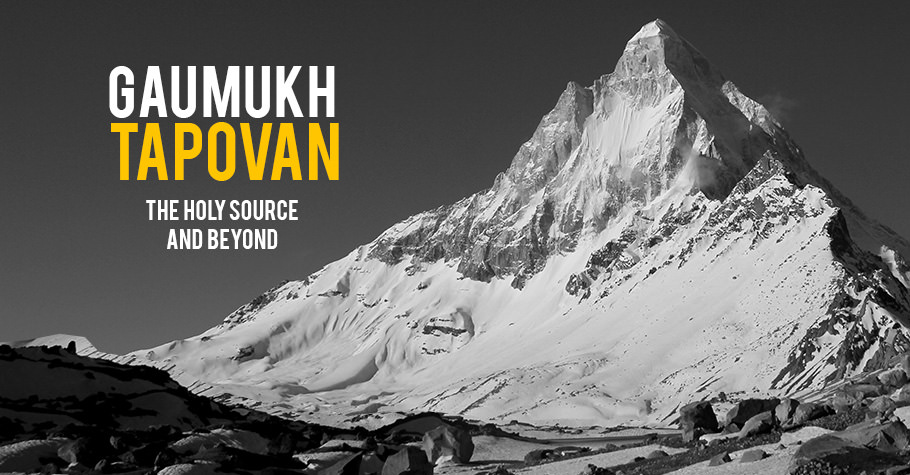
- Tapovan Trek
- Uttarakhand
- Uttarakhand Tourism
- 2 Tour Packages
- Send Enquiry
Tapovan - Meditational Place of the Ascetics
Tapovan is a naturally diverse area carpeted by the lush green grasslands that are considered to be the best high-altitude grasslands in India. It is perched at an elevation of 4463 metres about 14,640 feet above sea level and is situated near the famous Gangotri shrine . At the foot of Shivling peak, Tapovan is a seasonal home to several sadhus living in caves, huts etc.
In the past few years, Tapovan has emerged as a popular trekking destination and people from far-off places come to see the enchanting grasslands of Tapovan that are decorated with flowering plants.

Get Tapovan Trekking Guide, Itinerary, Best time, Tapovan Trek Tips
- Tapovan Trek Tour Packages

- Tour Packages
- How to Reach
Why you should come and explore Tapovan?
Tapovan is a Sanskrit word that comes from the two root words, ‘ Tapas ’ meaning severe meditation or penance and ' Vana ' meaning forest . Traditionally in India, the places where the great sages and ascetics engaged in spiritual awakening came to be known as Tapovan. The most well known Tapovan in India is the area above Gangotri glacier which is the primary source of the river Ganges in Uttarakhand.
Many people explore the area lying at the foot of Shivling Peak which serves as the seasonal home to the sage and hermits living in the caves and huts. Tapovan is also the base camp for several mountaineering expeditions to Shivling Peak, Bhagirathi Peak, and many others. You can also visit Nandanvan, a beauteous place near Tapovan which is a hub of many trekkers and pilgrims.
Note : In recent times, the retreat of the glacier has quickened extensively. Major steps have been taken by the government of Uttarakhand towards this severe problem. Now only 100 persons can trek to Gaumukh each day.
Tapovan Trek Travel Tips
- Inform someone in your family or friends about your trek and let them know when you will begin and end the trek. Make sure to travel in a group of two or more.
- It is wise to check with local authorities, tour guides or tour operators about the weather and road conditions, especially during monsoons, before you actually start your trek.
- If one is traveling on its own or group of friends, it is advisable to hire an experienced trekking guide to accompany you on your trek. These guides have much knowledge and expertise about the route.
Staying in Tapovan Trek
Situated at a staggering height of more than 4400 metres, Tapovan has been a spiritual retreat for the sages and seers for centuries and has recently become a popular trekking destination . Tents are the only suitable accommodation here as trekkers carry their own sleeping bags and tents which can be erected at any level ground there. Many trek operators provide tents and other camping equipments to the trekkers.
Tapovan Trek Food Guide
Being a remote and deserted region, trekkers usually carry snacks with themselves that they can purchase at lower altitudes, preferably before starting the trek. Guided treks usually have a cook who can prepare delicious meals using the ration taken along with. Packaged food is usually the best option when traveling to higher altitudes.
Tapovan Trekking Suggested Itinerary
Day 01: Dehradun - Uttarkashi - Gangotri (Drive- 258 km, Time - 10 hours) Early morning after having breakfast, drive to Uttarkashi from Dehradun . The road from Dehradun passes through Mussoorie Bypass Road offering scenic views whereas the road from Rishikesh goes through Chamba Hill Station . The massive Tehri Dam Lake also comes into view as you proceed towards Chilyanisaur.
The holy town of Uttarkashi is a popular place among the pilgrims heading to Gangotri. On reaching Uttarkashi, drive further to Gangotri. It takes another 4 hrs from Uttarkashi to reach Gangotri via Harsil . If you start from Dehradun/ Rishikesh at around 6 am then you will probably reach Uttarkashi by 12 Noon. Take another shared cab to Gangotri from Uttarkashi. Perform evening aarti at Gangotri Temple and obtain the permits to enter Gangotri National Park . Have dinner and overnight stay in Gangotri .
Day 02: Gangotri - Chirbasa (Trek- 9 km) Wake up to the glorious view of the sunrise and post breakfast start trekking across the Bhagirathi River on a relatively well-marked trail to Chirbasa. This relaxing trek goes through the forests and allows the trekkers to walk on the side of the mountain, giving shelter under its shade. On reaching Chirbasa , set your camps on the riverside, amidst the forested area and have an overnight stay.
Day 03: Chirbasa - Bhojwasa - Gaumukh (Trek- 9 km) Post breakfast start trekking towards the source of river Ganges. This swift trek will offer magnificent views of the Mount Shivling and the Bhagirathi peaks. Capture the unprecedented views from Bhojwasa and take some rest here. After trekking for a couple of kilometers, you will reach Gaumukh, the source of Ganga River. Relish the beauty of this place and pitch your tents for the night.
Day 04: Gaumukh - Tapovan - Chirbasa (Trek- 14 km) Start off early to make your way towards Gangotri Glacier. The swift 5 km trail will lead you to Tapovan. After traversing for a few kilometers, you will see a distant view of the lofty Himalayan peaks such as Mount Shivling (6,543 m), Mount Meru (6,630 m), Kedar Dome (6,808 m), Sudarshan (6,507 m) and Bhagirathi I, II and III. On coming closer to the view, you will come across the luscious golden meadows of Tapovan, from where you can have a panoramic view of these peaks. Walk barefoot on the smouldering grassland, relax and trek back to Chirbasa.
Day 05: Chirbasa - Gangotri - Uttarakashi (Trek- 9 km, Drive- 99 km)
After having nutritious breakfast, trek back to Gangotri and then drive to Uttarkashi. Check in at a hotel and have an overnight stay.
Day 06: Uttarkashi - Rishikesh (Drive- 176 km) Check out from the hotel and drive towards Rishikesh / Haridwar .
Topovan with Nandanvan Trek Itinerary
In addition to first day stay at Gangotri, there will be slight modification in the itinerary to include Nandanban as well in your Tapovan Trek. In this case you can camp at Tapovan for 2 days.
Day 02: Gangotri – Chirbasa - Bhojbasa ( Trek - 14 kms) First thing in the morning, visit the sacred shrine of Goddess Ganga - Gangotri Temple . You can buy necessary items from the market at Gangotri town. The trek starts from Gangotri itself. You need to show permits at Forest Check Post, 2kms from Gangotri. As you walk deep into the valley the vegetation also decreases. Continue trekking to reach Chirbasa, located 9 kms from Gangotri.
The route involves crossing small streams en route to Chirbasa . Chirbasa makes a good campsite and it is also the last point where you’ll see good vegetation. You can camp here if there are any signs of AMS or if you are tired. Chirbasa is situated at an altitude of 3, 580mts above sea level.
Bhojwasa is located 5kms ahead of Chirbasa. Bhagirathi Peaks are constantly visible during the trek. Bhojbasa is an open expanse of land in the valley, situated at an elevation of 3,800mts above sea level. There are few ashrams at Bhojwasa where pilgrims stay.
Day 03: Bhojbasa – Tapovan ( Trek – 10 kms) Tapovan can be reached by two routes. The first one is the classic route which goes via Gaumukh Glacier. Gaumukh Glacier is 5kms from Bhojwasa. After reaching Gaumukh Glacier you need to traverse the glacier and climb a rugged wall to reach Tapovan.
For accessing second route crossing Bhagirathi River from Bhojwasa itself is required. A long walk on moraine and small ridges for many kilometers will end up at Tapovan. Distant view of Gaumukh Glacier can be seen from this trail. Tapovan campsite is located at the foot of Mount Shivling (6,543mts). Tapovan is situated at 4400mts above sea level.
Day 04: Tapovan – Nandanvan ( Trek – 7 kms) Crossing the massive Gaumukh Glacier is required to reach Nandanvan from Tapovan. The trek starts with a steep descent from Tapovan to reach the glacier and ends with a steep climb of approximately 100mts to reach Nandanvan. Nandanvan (4450mts) is situated at the foot of Bhagirathi Peaks.
Day 05: Nandanvan – Gaumukh - Bhojwasa ( Trek – 12 kms) Trek down to Gaumukh Glacier. The snout of Gaumukh Glacier used to look like a cow’s face, but you won’t see any such resemblance now. This is the origin of Holy Ganges. Further trek down to reach Bhojbasa .
Day 06: Bhojbasa – Chirbasa – Gangotri ( Trek – 14 kms) Trek down to Gangotri. It will take around 5-6hrs to reach Gangotri from Bhojwasa.
Tapovan Trek Photo Gallery

- Tapovan Trek Travel Guide
- How to Reach Tapovan Trek
- Tapovan Trek Photos
What is Tapovan Trek famous for?
Tapovan Trek is famous among tourist as Trekking, High Altitude Trek, Trekking Expedition.
Tapovan Trek is recommended destination for Foreigners, Groups, Solo.
Tapovan Trek is popular destination for following activities/ interests - Adventure , Pilgrimage , Religious , Trekking .
Plan your Trip
Tapovan trek highlights.
- Full of meadows, streams and flowering plants
- One of the best high altitude meadows in India
- Mesmerizing Himalayan view along with cascading waterfalls , pine forests
- Sky full of stars is ideal for astro photography
Uttarakhand Travel Update
Char Dham yatra will start from 10 May 2024, Bookings Now Open! Check Char Dham Tour Packages - Hotels in Badrinath - Char Dham Yatra by Helicopter - Kedarnath Helicopter Booking Guide - Char Dham hotels
Char Dham Closing Dates: Gangotri , Yamunotri and Kedarnath dhams are closed now. Badrinath temple will be closed 19 Nov. Check out Char Dham Yatra tours : Char Dham News . Char Dham Registration is compulsory for visiting Char Dham Temples. Check Kedarnath Helicopter Ticket booking guide .
Traveling to Uttarakhand? Check out Uttarakhand Covid Stats , Uttarakhand Travel Guidelines and Uttarakhand Travel News
Char Dham Update: Gangotri , Yamunotri , Kedarnath and Badrinath are open for pilgrims. Check out Char Dham Yatra tours : Char Dham News . Char Dham Registration is compulsory for visiting Char Dham Temples. Check Kedarnath Helicopter Ticket booking guide .
Last Updated: 12 Apr 2024
Tapovan Trek overview
- Best time to visit Tapovan Trek Jun, Jul, Aug, Sep, Oct, Nov,
- Starts from Gangotri
- Trek Distance 41 kms / Entire Trek
- Trek grade Moderate
- Trek duration 5 days
- Altitude range 4430 mts
- Located in Uttarkashi, Garhwal
- Railway Station Dehradun Railway Station, 260 kms
- Nearest Airport Jolly Grant Airport, 270 kms
- Famous for Trekking, High Altitude Trek, Trekking Expedition
Travelling to Tapovan Trek in 2024?
Contact us for planning your Tapovan Trek tour with best travel packages of as per your requirements!
- Sacred Yatra
- Char Dham Tours
- Chopta Tourism
eUttaranchal
- Uttarakhand Tour Packages
- Uttarakhand Hotels
Customer Service
- Return, Cancellation & Refund
- Privacy Policy
- Terms of Use
Business Connect
- List your Package
- List your Hotel
- Send Feedback
Get Customized Tour Package
Username or E-Mail
Forget Password?
Do not have an account?
Already a member.

- Benog Tibba Trek
- Bhadraj Forest and Temple
- Pari Tibba Trek
- Chhaskhet Nature Walk
- George Everest Nature Walk
- Mussoorie Walking Tour
- Mussoorie Heritage Walk – Landour Cantt
- Mussoorie Heritage Walk – Old Landour Bazaar
- Mussoorie Heritage Walk – Kulri & Camel`s Back
- Day Treks Near Mussoorie
- Day Trips from Mussoorie
- Jogini Waterfall Trek
- Shimla Day Hikes
- Nag Tibba Trek
- Chandrashila Trek
- Chopta Tungnath Chandrashila Trek
- Deoria Tal Chandrashila Trek
- Hatu Peak Trek
- Dalhousie Trek
- Triund Trek
- Kheerganga Trek
Kasol to Grahan Village trek
- Kedarkantha Trek
- Har Ki Dun Trek
- Valley Of Flowers Trek
- Bali Pass Trek
- Dodital Trek
- Ruinsara Tal Trek
Sar Pass Trek
Buran ghati trek.
- Hampta Pass Trek
- Gulabi Kantha Trek
- Panwali Kantha Trek
- Roopkund Trek
Gangotri Gaumukh Tapovan Trek
- Gaumukh Tapovan Nandanvan Trek
- Yamunotri Saptarishi Kund Trek
- Nanda Devi Sanctuary Trek
- Bir Billing Trek
- Beas Kund Trek
- Bhrigu Lake Trek
- Jalori Pass Trek
- Janjehli Shikari Devi Trek
- Manimahesh Lake Trek
- Sangla Valley Trek
- Triund Indrahar Pass Trek
- Rupi Bhabha Wildlife Sanctuary Trek
- Kedarnath Yatra Package
- Char Dham Yatra Package
- Valley Of Flowers Trek Package
- Sar Pass Trek Package
- Kashmir Great Lakes Trek Package
- Srinagar Tour Package
- Kedarkantha Trek Package
- Nag Tibba Trek Package
- Chopta Chandrashila Trek Package
- Brahmatal Trek Package
- Dayara Bugyal Trek Package
- Kareri Lake Trek Package
- Kuari Pass Trek Package
- Kasol Kheerganga Trek Package
- TrailHikers Mountain Camps in Mussoorie
- Chauki Dhaulas Bike Trail
- Majhaun Bike Trail
- Purkal Rajpur Bike Trail
- George Everest Bike Trail
- Chhaskhet Bike Trail
- Mountain Quail Bike Trail
- Mountain Bike Tours
- Sainji Corn Village Tour
- Nag Tibba Village Stay In Uttarakhand
- Village Stays in India
- Best Treks Near Dehradun
- Day Hikes Near Mussoorie
- What To Expect On Nag Tibba Trek
- Best Things About Nag Tibba Trek
- Nag Tibba Trek Blog
Proceed Booking
Already a member.
Username or E-mail
Don't have an account? Create one.
Or continue as guest, adding item to wishlist requires an account, why book with us.
- Hassle free booking experience
- 24/7 Customer support
- Hand-picked tours & activities
- Trek insurance support
TrailHikers® | India's Premium Trekking & Adventure Tour Agency
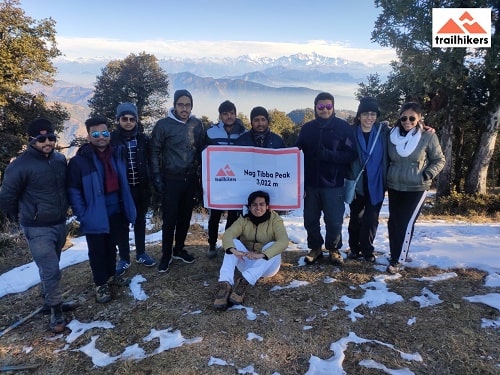
- 700+ Adventure tours
- Certified & experienced adventure team
- Premium trekking & camping services
- Highest safety standards with rescue & medical backup
Get A Call / WhatsApp
Our team will reach out to you on Call / WhatsApp within 12 hours !
- 12-15 persons
- Camping based trek
- Moderate-Tough
- Gangotri / Rishikesh
- Min Age: 15+
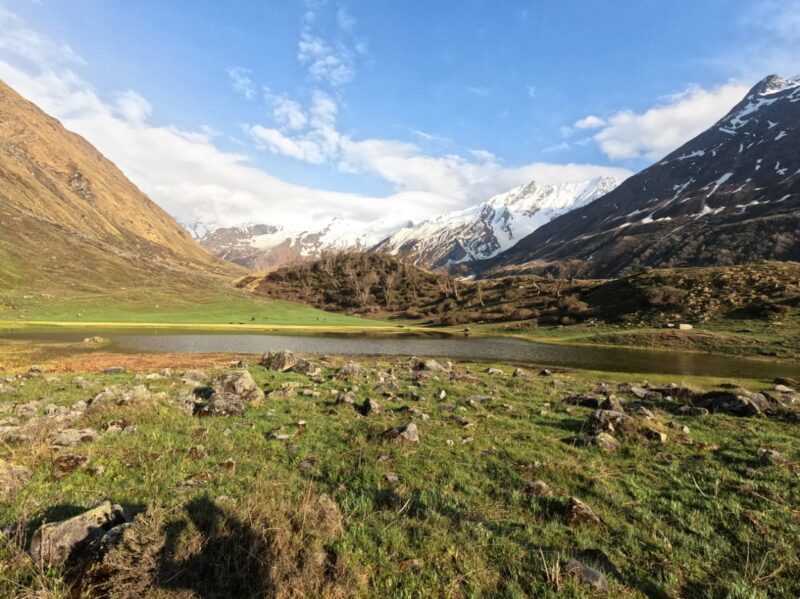
- ₹19,250 per person Rishikesh to Rishikesh
- Upcoming Batches Summer 2024
18 May – 25 May | 19 May – 26 May | 25 May – 01 Jun | 26 May – 02 Jun ( OPEN ) 08 Jun – 15 Jun | 09 Jun – 16 Jun | 15 Jun – 22 Jun | 16 Jun – 23 Jun ( OPEN )
Custom dates available for minimum group of 10 persons or above
Interested ? Lets plan your trip !
- Get Price Quote on WhatsApp +91-7895990850
Gaumukh Tapovan trek is an enchanting, adventurous & divine trek to the source of the Ganga the holiest of the rivers. Starting from Gangotri, the trek takes you to Gaumukh where you will see Ganga coming out of the rocky mountains. Gaumukh trek further ventures to Tapovan and scenic paradise Nandanvan.
The Ganga, the holiest of the rivers, revered by the Hindus over millennia, springs from an expanse of ice measuring 8 km by 24 km, the Gangotri Glacier. This is the source of the Bhagirathi, which joins with Alaknanda to form Ganga at Devprayag. From Devprayag, the river flows 2,480 km to the Bay of Bengal. At the very top of the Gangotri Glacier, like a crust of crunchy chocolate on a vanilla bar, is a 30 to 50 ft layer of mud and rock, the debris dragged down by the mountains by the inexorable flow of glacial ice. To the left, in the north, are the towering vertical faces of the Bhagirathi massifs.
Across the Bhagirathi, in the south, the scree slopes sweeps up into the distinctive pyramid of a Shivling, topped by its signature overhang. And, at eye-level, is the little entrance to an icy cavern, the mouth of the glacier – Gaumukh. Crafted in opaque ice of white and green, the glacier issues from its dark recesses the little trickle that has for millennia drawn to it the waters of a thousand streams and the faith of countless millions.
Starting Point
Gangotri (105 km / 3 hrs from Uttarkashi)
Nearest Roadhead
Nearest railhead.
Dehradun Railway Station
Nearest Airport
Jolly Grant near Dehradun
Price Inclusions
- all veg snacks & meals during trek (Day 1 Dinner to Day 7 Dinner)
- camp tent accommodation for 5 nights (2-3 per tent)
- camping equipment (tents, mats, sleeping bags etc.)
- lodge / guest house accommodation for 2 nights at Gangotri (triple/quad sharing)
- forest camping & trek permits (INDIANS ONLY)
- services of trek leaders, trek guides, cook, helpers
- transport from Rishikesh to Gangotri & vice versa (Ex Rishikesh package only)
Price Exclusions
- any kind of personal expense on food or medicines
- any kind of personal trekking gear (hiking shoes, poles, rucksack etc.)
- any kind of travel, lodging or medical cost incurred in case a trekker decides to drop out of the trek
- any kind of hotel or lodge stay
- porter charges apply in case a trekker is unable to carry his / her backpack & wants to offload it on mule / porter (₹ 500-600 per backpack per day)
- any thing which is not mentioned in the inclusions
Day 1 PICK UP FROM RISHIKESH & DRIVE TO GANGOTRI / DHARALI DISTANCE: 258 KM TIME: 10-11 HRS
Mode of journey – By taxi
Altitude – Gangotri –3415 Meter
Night stay – Overnight at Hotel/Similar
TrailHikers organizes transport for trekkers from Dehradun Railway Station in the morning which will leave for Gangotri around 6:00 am to 7:00 am.
Get in the vehicle from Dehradun and enjoy the picturesque journey along Bhagirathi River’s bank and forest stretches to reach Gangotri base camp. It is the base camp of Kedartal trek.
Dehradun is the capital of Uttarakhand and one of the most beautiful places in India.
The main attraction of this place is Rajpur road go through it and get a glimpse of Dehradun’s beauty.
Reach Mussoorie after an hour which is also known as “Queen of Hills”. People visit it heavily during vacations with their family and friends.
After half an hour, stop at Suwa kholi Have breakfast there and witness people from different parts of the world.
The break will be of a maximum of 1 hour. Ahead the peaks are visible and further you will come close. Further, you will cross the small Chinyali saur of Dharasu Reach Uttarkashi around 1:30 pm and take a break there for lunch.
After having to go through the picturesque zig-zag road to Gangotri via Harsil.
Freshen up and enjoy evening snacks in the open Garden with great views. You will be provided some details after which you can go for an evening walk but be at the hotel at Gangotri for dinner.
Day 2 GANGOTRI - CHIRBASA DISTANCE: 8 KM TIME: 3-4 HRS LEVEL: EASY
Before you set out on the Gaumukh Tapovan trek trail from Gangotri (3,046m), you might like to take in the sight of the kund or trough, where the Bhagirathi River crashes into a limestone basin polished into fluid sculpture. Popular custom decrees that you visit the Ganga shrine half a kilometre upstream before taking to the pilgrim trail that runs above the temple, and begins in the last stands of forest at the edge of the road into town. It is a well maintained path, hugging the river on its path from east to west. The forest thins rapidly, and one is soon in a landscape of brown and grey, relieved by the stream below, and the symmetrically framed views of the mountains in the front.
The traditional first stage of this walk is to Bhojbasa, 13 km away. But since the starting altitude is considerable, progress is slow, and if one in unsure of acclimatisation, it may be prudent to do the half-stage, to Chirbasa (3,350m) on Day 1, where a small group of chirs (pine) is a relief in an otherwise desolate landscape. On both sides of the trail, dhabas offer simple fare, as well as a carpeted platform to sleep on and an ample supply of quilts. If you want you to tent for the night, go down to the river, where there is charming camping place among groves of freshly planted silver birch. Ther is also a forest bungalow, too decrepit to offer any shelter, but with a water-point and flat grounds well suited to a cluster of three to four tents.
Day 3 CHIRBASA - BHOJBASA DISTANCE: 5 KM TIME: 2-3 HRS
Above Chirbasa, the valley widens, and offers views of snow-clad peaks in the south. It is a gentle walk to Bhojbasa (3,800m), running virtually due south-east along the river, the Bhagrathi peaks ever a beacon to the source of the river. Bhojbasa is the widest point in the upper valley, and camping here at night offers magnificent moonlit views of the Bhagirathi peaks. For those who don’t want to light up their stoves, there’s an excellent langar at Lal Baba’s Ashram, or more commercial fare at the GMVN establishment, which also offers solar lighting and hot baths.
Typically, pilgrims wil do Gangotri-Bhojbasa in one stage, tick off Gaumukh on the second and return to Bhojbasa for the night, completing the return walk to Gangotri on the third. But, a bit more mindful of acclimatisation when with mixed groups, trailhikers prefer to do it in easy stages ; get in some sun and sand on the riverside, and make sure everybody is in good shape for the haul up to Tapovan.
Did You Know
– Its essential to acclimatize one day at Gangotri for Gaumukh Tapovan trek
– Himalayan blue goat “Bharal” is found at altitude of 3,000 m & above
Bharal primarily eats leaves of small shrubs & trees growing on the steep edges of the mountains
A similar mountain goat named “Ghural” which is brown in colour is found in Benog Hill region of Mussoorie
Day 4 BHOJBASA - GAUMUKH - TAPOVAN DISTANCE: 9 KM TIME: 4-5HRS LEVEL: EASY-TOUGH
The first four kilometres upstream from Bhojbasa are surprisingly flat, and though the valley narrows, the path runs smoothly above the river, and is fringed by a grassy meadow. With about a kilometre to go, the terrain turns rocky, and one has to pick one’s way through the rocks and boulders, down to a sandy beach sheltered by enormous piles of granite. Incidently, the beach is a great place to camp. Scour the water’s edge for shards of ice, or follow the broken path along the river’s edge to the very foot of Gaumukh (3,969m), and look up at the Shivling Peak (6543m) almost vertically above. In autumn, the water is a shallow stream of grey-blue, and you could wade out to the middle. In summer, it is a more substantial stream of muddy brown, and one is well advised to keep to the banks.
As one approaches the glacier, the path becomes a bit tentative, and if one wants to make the trip to Tapovan (4,463m), it is best to leave Gaumukh before noon. Despite the shifting nature if the route, the orientation is quite clear, and little piles of stone on the higher rocks regularly marks the trail. Climb up to the northern side of the glacier (the right bank), till you gain its surface. Turning south, cross the glacier towards the slopes on the opposite side of the valley. Snaking through rocks and debris that are its surface, it is hard to remember that one is actually on a major glacier. Once you have reached the southern (left) bank of the river valley, the path is more clearly marked – a steep climb of almost a thousand feet to the meadows at the base of Shivling Peak. This is Tapovan, an exquisitely watered spot from which the fabled peak of Shivling appears to sweep up in a wave of scree, granite and snow.
It is an idyllic camping spot; alternatively, a couple of babas have establishments where you can spread your sleeping bag for the night. trailhikers also uses this camping site for its treks !
Day 5 REST DAY EXPLORATION AT THE BASE OF SHIVLING PEAK
Today’s aim is acclimatization and relaxation.
Post breakfast, move upwards to the Himalayan Tapovan at an altitude of 4500 m.
Tapovan lies below Mt. Shivling peaks and has beautiful lakes, explore the area and head to Neel Taal to get clear views of Mt. Meru.
Reach there in two hours and return before lunch. Relax and retire for the night.
Day 6 TAPOVAN - BHOJBASA DISTANCE: 9 KM TIME: 5-6 HRS LEVEL: MODERATE - EASY
It’s time to trace the trail back. It’s downhill all the way till Gaumukh and the next 4 km almost flat. If you’re feeling fit, walk another 5 km till Chirbasa, to spend a night exloring the banks of the Ganga. If you manage to reach Chirbasa, the next day will be easy as from here, it is a short hop of under 2 hrs to Gangotri, allowing plenty of time for a drive to Uttarkashi, and the dubious charms of civilisation.
Day 7 BHOJBASA - GANGOTRI DISTANCE: 13 KM TIME: 5-6 HRS LEVEL: EASY
From Bhojbasa, start early so that you are in Gangotri by noon and then reach Uttarkashi by late evening !
– The best time to do Gaumukh Tapovan trek is May to mid July
Trek Options
Crossing the glacier again, one can press on to Nandanvan (4,400m) – though only 4 km, it is a path strewn boulders and not so heavily trafficked. You would be well advised to retain a guide for the journey, or for the expedition to Vasuki Tal (6km) at the base of the Vasuki Peak (6792m).
Getting Ready : Trekkers can also undertake a short weekend trek like Nag Tibba (15-20 days before) to prepare for a high altitude trek like Gaumukh-Tapovan. Read about Nag Tibba
Getting There
FROM UTTARKASHI to Gangotri, it’s 105 km/3 hrs by car or 4 hrs by bus. Buses available daily during season, between 5 am and 1 pm
Haridwar to Uttarkashi via Bhaldiana is 173 km/6 hrs by taxi or 8 hrs by direct buses, which run between 4 and 7 am. Haridwar is well connected to Delhi (203km/5-7hrs) by buses and trains.
RETURN: Take the same route back from Gangotri to Haridwar (276 km) via Uttarkashi. Taxi 11hrs/Buses 12 hrs operate between 5am and 1pm from Gangotri. If you miss the direct Gangotri-Haridwar bus (between 5 and 6am), get your connection from Uttarkashi.
TIP: Opt for direct/ chartered buses as local buses are overcrowded and halt frequently en route.
Day 8 DRIVE FROM GANGOTRI / DHARALI TO RISHIKESH DISTANCE: 258 KM TIME: 11-12 HRS
Today – It is your last breakfast on this trek with the TrailHikers team.
Bid adieu to your trekking team after some beautiful photos, we will bid you all a goodbye from Gangotri and Tapovan trek.
Enjoy the scenic drive from Gangotri onwards to reach Dehradun 6 to 7 pm.
Is it necessary to hire a guide on this trek ?
Yes, it is absolutely essential to take a guide for this trek whether you are trekking solo or in a group.
What is the best season for this trek ?
The best season for Gaumukh Tapovan trek is from July to mid October.
Is this trek suitable for kids ?
It is ideally recommended for 15+ age. Gaumukh Tapovan is a high altitude trek which is not suitable for children below 15 years.
Is this trail safe for women & solo travelers ?
Yes, in fact all the Himalayan trails are quite safe for women & solo travelers. People of the region are very warm, caring & hospitable in nature.
What type of accommodation is available during this trek ?
Camping tent accommodation (2-3 per tent).
Do we have to give tip money to guides / porters ?
Guides & porters in the region will never demand any tip money from you. They just need their daily wages paid by the trek operator. However, it is always encouraging if one can give a little tip to them if they provide good services.
Which currency is accepted during transit or in nearby villages on this trek ?
Indian currency is accepted
Related Tours
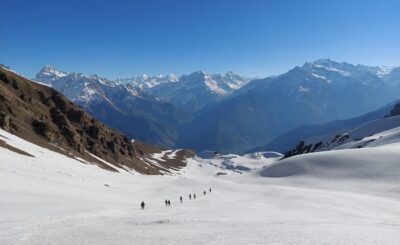
A heavenly trail to Gaumukh Tapovan trek gave us a mesmerizing experience of a lifetime. Superb services of food, camping & trekking organised by TrailHikers team. Thank you guys !

- Group Tours Calendar
- Planning, Sightseeing & Routes
- Preparing for Ladakh Trip
- Stay, Eat, Permits & Others
- Taxis, Self-Drives & Bike Rentals
- Public Transport & Budget Travel
- Preparing for Spiti Valley Trip

Gaumukh Travel Guide – The Birthplace of Bhagirathi River
Are you planning to travel to Gaumukh in the upcoming season? This comprehensive Gaumukh Travel Guide will help you in planning a memorable trip.
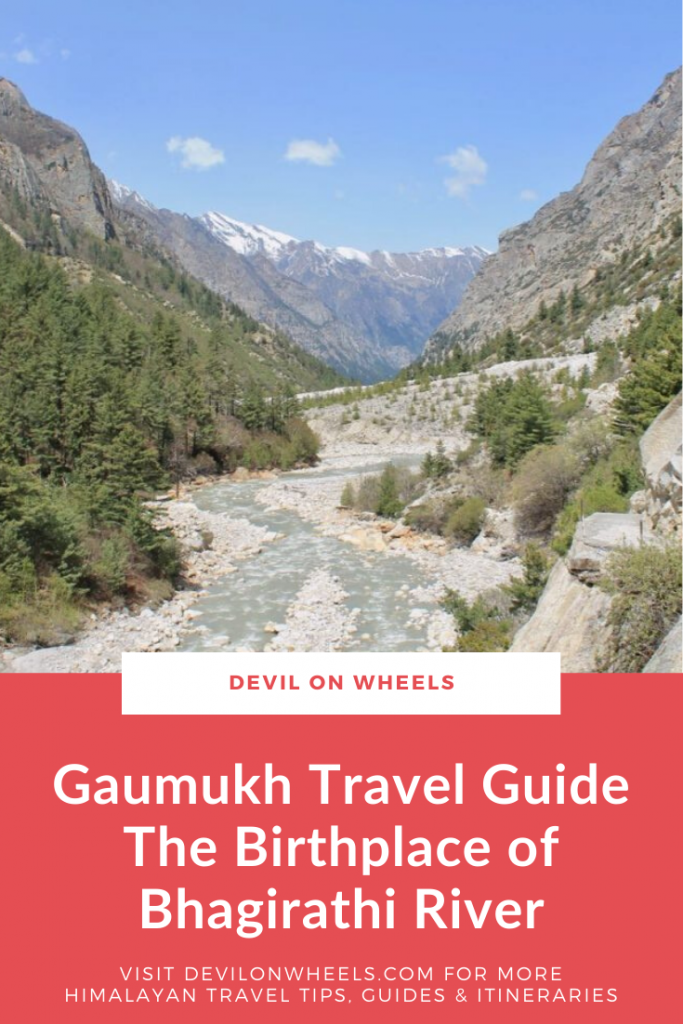
Gomukh or Gaumukh is the endpoint (or if you view from another angle, the starting point 😉) of the Gangotri Glacier, from where the Bhagirathi river has its birth. The Bhagirathi is one of the main streams that later merge into the Alaknanda river at Devprayag in Uttarakhand . It gives rise to the river we all call by the name Ganga or Ganges.
Gaumukh literally means “cow’s face”, essentially depicting the shape of the snout. However, the snout is no longer in that shape now.
Let's quickly dive into the details:
Trek to Gaumukh Travel Guide
Gomukh is located inside the Gangotri National Park and is accessible only by foot (trek). The starting point of the trek is from Gangotri, so one has to reach Gangotri first. The entire route from Gangotri to Gaumukh is filled with natural beauty. The Bhagirathi river will keep you company until the end.
That apart, one can see many snow-clad mountains, including the Bhagirathi group and Mount Shivling and a host of other peaks. For those into wildlife, you can spot ‘Bharals’ or the blue sheep on the route. And then you have vegetation that gets sparse as you ascend, giving you a feeling of being in Ladakh .
In today’s article, I am going to share with you the details about making a trip to Gaumukh and finish this comprehensive Gaumukh Travel Guide with my next part that will talk about the remaining sections of the Gaumukh trek.
Hence, this two-part series of articles will help you know all about traveling to Gangotri and doing the trek to Gaumukh from Gangotri .
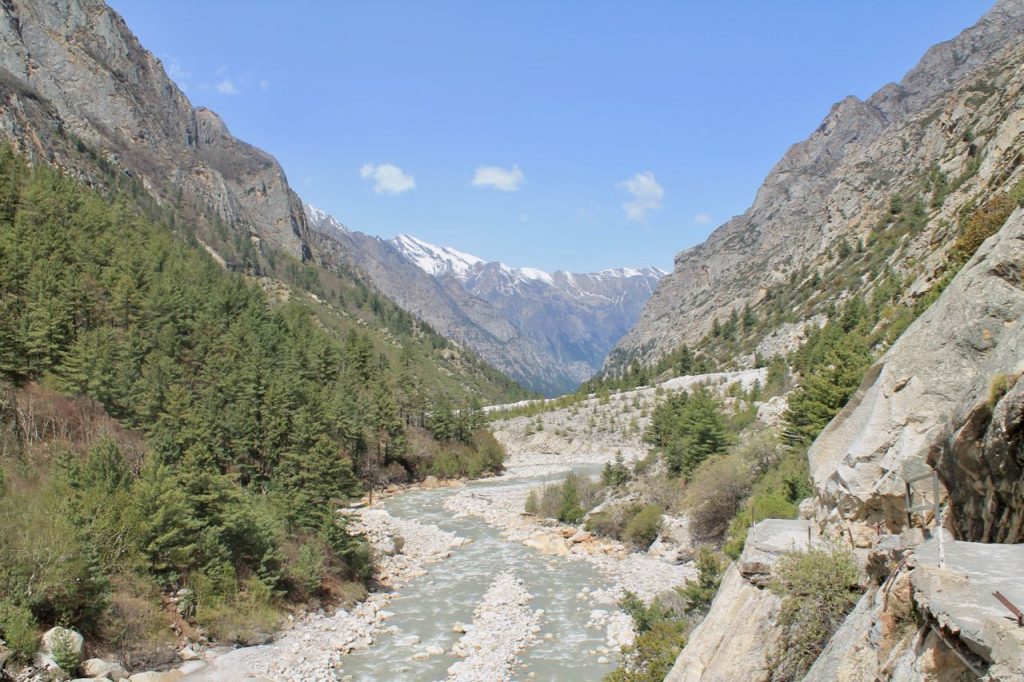
The Background – Myth Surrounding The Gaumukh & The Ganga
Gaumukh is recognized as the birth of the river Ganga – both mythologically and also by geographers. The river at Gaumukh is called Bhagirathi, and when there are multiple rivers like the Alakananda or Mandakini, which could also be considered as the source of Ganga, it is the Bhagirathi that everyone considers as the birth of Ganga.
Seems like there is a mythological angle to all these stories.
“ The ancestors of King Bhagiratha were performing an Ashwamedha Yagya and Lord Indra, due to his jealousy, hid the horse. In search of the horse, the ancestors reached a place where sage Kapila was meditating, thereby disturbing his penance. In a fit of rage, the sage reduced his ancestors to the ashes. .”
“ The ancestors would reach the ‘Pitru Loka’ only if the ashes were immersed in the Ganga, and so lord Bagiratha performed severe penance to get Ganga to the earth, by pleasing Lord Shiva, on whose head Ganga was residing. Lord Shiva , pleased with his penance, agreed to let Ganga to earth through his matted hair – and she reached earth first at Gaumukh.”
“ Bagiratha then led her to the place where the ashes were, so she could flow over it and Bagiratha’s ancestors could then reach the ‘Pitru Loka’ by washing away of their sins. “
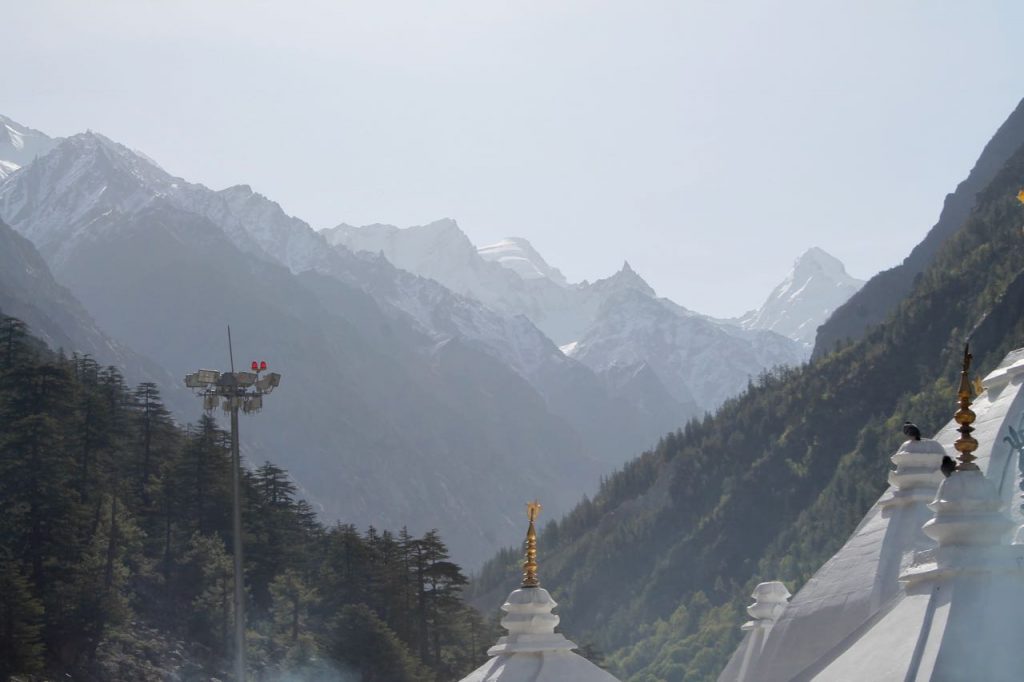
Since it was Bagiratha who brought Ganga to the earth, the river is called Bhagirathi. Note that only after the confluence of Alakananda with Bhagirathi at Devprayag, the river is called the Ganga, which we know about as great rivers of India.
Dheeraj Sharma
Location & Altitude of Gaumukh
Gaumukh is located in the Uttarkashi district of Garhwal, Uttarakhand. Gaumukh is around 18 KMs from Gangotri and about 45 km from Harsil . Gaumukh is located at an altitude of 4000 Mtrs (13120 feet), and the base point Gangotri is at about 3415m (11200 ft). Gangotri Dham is one of the Char Dhams of Uttarakhand, and I will share detailed travel guides for both Harsil and Gangotri in the next few articles.
Best Time to Visit Gaumukh
During winters, due to a large amount of snow, it would not be possible to reach Gaumukh, and even the entry into the national park may be prohibited. The best season to travel or trek to Gaumukh is from May to October. This season also coincides with the Char Dham yatra season as well.
![gaumukh trek guide How to prepare for cold weather motorcycle ride in Ladakh or Spiti Valley? [13 Important Tips]](https://discoverwithdheeraj.com/yt_vid_thumbs/ladakh/83.png)
You can pull off the trek to Gaumukh in the shoulder months too but not with much ease. However, from July to mid-August, due to the monsoons and heavy rainfall, it really wouldn’t make sense to make a trip or trek to Gaumukh. May-June and Sep-Oct are the best months for traveling or trekking to Gaumukh.
You should always carry your own water bottle and refill it as many times as you need water. It will not only keep you hydrated always, but you will also help in saving the Himalayas from plastic garbage. Remember, every tiny step counts and your step in this direction can help save the Himalayas too !! 🙂 🙂
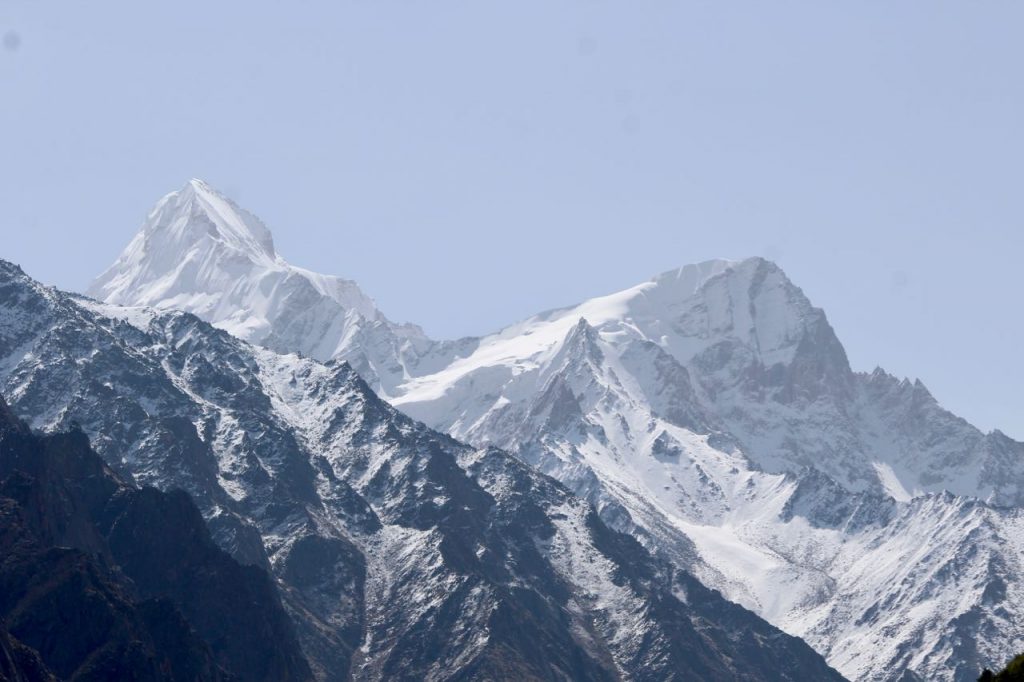
How to Reach Gaumukh or Travel to Gaumukh
You can reach up to Gaumukh by trekking only, but I will cover how you can first reach up to Gangotri and then further plan your remaining journey to Gaumukh.
Traveling to Gaumukh by Road
If driving from Delhi, one can take the route via Meerut – Roorkee – Haridwar – Rishikesh – Narendranagar – Chamba – Dharasu Bend – Uttarkashi – Gangnani – Harsil – Gangotri . The total distance would be around 480 km from Delhi, approx. 250 km from Rishikesh and approx. 90 km from Uttarkashi.
One can also take the route from Delhi via Saharanpur – Dehradun – Mussoorie – Suwakholi – Dharasu Bend and then on to Uttarkashi – Gangnani – Harsil and Gangotri . The distance from Delhi is almost the same with a difference of about 10-15 km. On this route, Gangotri is about 225 km from Dehradun.
Trip Suggestion : Check out these offbeat places in Uttarakhand if you are planning a trip to some less touristy places.
Traveling to Gaumukh By Public transport
If you are traveling to Gangotri or Gaumukh by public transport in a bus or shared cabs, you can take the following two routes:
1. Haridwar and Rishikesh Starting Point
From Haridwar and Rishikesh, two direct buses run to Gangotri, but only during the yatra season. The buses leave early mornings only. The bus from Haridwar leaves by 5:30 am. The buses from Rishikesh leaves around 5:30 am, and 7:30 am.
Seats in the Rishikesh bus tend to get filled fast, and you can reserve at the counter the previous day. It takes about 6 hrs to reach Uttarkashi from Rishikesh. Please call on 0135-2430344 to check the timings and availability of the buses to Gangotri.
In case you don’t get the direct bus, there are also buses from Haridwar & Rishikesh that go to Uttarkashi. One can reach Uttarkashi and take another bus to Gangotri or take a shared cab. The shared cab costs Rs 200 per person and takes about 4 hours from Uttarkashi.
The bus timings from Uttarkashi to Gangotri are- 530 am, 7.00 am, 12.30 pm, 1.30 pm, 2.00 pm, and 2.30 pm. However, please verify the timings with the counter in the bus stand, as they tend to change randomly, at their whims and fancies.
2. Dehradun Starting Point
2. One can also get to Dehradun, and from Rispana Bridge, there is a shared-taxi stand. From here, shared taxis ply to Uttarkashi, take about 6 hours, and cost Rs 300 per head. Taxis will leave only when the entire ten seats get filled up :D.
After reaching Uttarkashi, you can again take a bus or shared cabs as mentioned above in the article. Please call on +91-9012133450 / +91-9412917697 (Doon Garhwal Tracker Jeep Commander Malik Kalyan Sanchalan Samiti) for further details on it.
Trip Suggestion : Check out our travel guide to Mana Village if you are planning a trip to offbeat place Uttarakhand.
Traveling to Gaumukh by Air and Railway
The nearest airport is the Jolly Grant in Dehradun and from there you can either reach Rishikesh or Dehradun and follow the route mentioned above. You can also reach Haridwar / Rishikesh or Dehradun by train, and from there follow the route mentioned above in the article.

How to Apply Permits for Gaumukh Trek
You need to take a permit from District Forest Officer, Uttarkashi (DFO), to trek to Gaumukh. Only 150 people are allowed to go to Gaumukh per day. The permit is a simple process; you just have to fill a form giving your name and address, give copies of your Voter ID or Aadhar card and pay the fee of Rs 150 per person (for foreign citizens, it is Rs 600 per person).
One can get the permit on any working day during normal hours from DM office in Uttarkashi and as said, getting a permit for Gaumukh is a trivial process mostly.
Permits are also available at the forest office at the beginning of Gangotri, just after the arch on the left side. The timings for this office are 8.00 am to 10.00 am and 5 pm to 7 pm every day. This office is open on Sunday also, and hence, you can get the permit to Gaumukh on Sundays too :).
Pro Tip: If you are doing a self drive to Gangotri, then make sure to read the article 40 Must Have Things to Carry on a Self Drive Trip to the Himalayas .
Applying Gaumukh Trek Permits Online
The permits for Gaumukh trek are also available online, and you can use the link Gangotri National Park Permits – Gaumukh. You can file the permit online and upload copies of the documents. Please note that you do not need to select any tour operator if you are traveling to Gaumukh only when the Gangotri temple is open.
Otherwise in offseason or trekking beyond Gaumukh, then you need to mention the tour operator name. You can pay the fee online for the permit, or else you can pay cash also at the counter where you have to show your permit during the trek.
The Process of Permit
After filling the application, you will get an email stating that your permit is approved, subject to the production of original documents at the office. You have to take the print out of the online page and show the same at Uttarkashi DM office. Make sure you don’t land in Uttarkashi on a Saturday / Sunday when the office is closed.
In our case, we were in Uttarkashi on a Sunday when the office was closed. So we were told to show this at the Gangotri office. When we showed it on Monday morning in the Gangotri office, they just asked us to proceed and said print out was sufficient. However, please don’t take chances – in case they refuse to let you in with just the printout, you have to trek back 3 KMs to Gangotri to get the permit.
Trip Suggestion : If you are a beginner in trekking then consider checking this list of easy treks in Uttarakhand .
Also, based on the plastic you are carrying, you will be required to make a fee deposit at the counter where your permit is checked, which will be refunded to you when you return, provided you have brought back the plastic trash with you, such a nice initiative or at least an attempt at it.

Mobile Connectivity
In Gangotri, you will have both Airtel and BSNL mobiles (both prepaid and postpaid) working. You will have signals working for about 1 KM after you cross Gangotri. Beyond that, there are no mobile signals at all. Even at Bhojbasa, there is no mobile connectivity, including BSNL. Hence, enjoy nature while being disconnected from the rest of the world in the lap of the Himalayas.
Some other Tips or Suggestions
- Please bring all your waste material back from Gaumukh trek and be a responsible traveler. I hope you read the DoW tips on Responsible Travel in the Himalayas .
- Normal sports shoes are enough to do this trek, but ankle-high hiking shoes or trekking shoes always help in protecting your ankles from twists or injuries. In the case of snow, you should prefer trekking shoes with snow gaiters.
- Always carry at least one light woolen jacket or light woolens even if you are planning a trip to Gaumukh in summers. Temperature can easily vary, so always better to be prepared well.
- You should check out the Discover with Dheeraj 12 Must-Have Things to Carry on Hiking or Trekking Trips

Gaumukh is a popular destination for trekking and hiking enthusiasts. Even though the base Gangotri is one of the Char Dhams and lakhs of visitors flock here every season, not everyone treks up to Gaumukh or beyond.
The trail to Gaumukh is well laid out, and it is not madness out there on the trail, unlike Kedarnath were on the trail to Kedarnath, with so many people visiting it, its complete madness, and you hardly have space to walk.
You will surely get to spend some quality time alone on your trek to Gaumukh as you are surrounded by the Himalayas all around, and you can feel very peaceful. Commercialization has not hit the trail primarily due to the permit regime, and hence, it is one of the best places to hike or trek if you have just started trekking in the Himalayas.
In the end…
Do you still have any questions or suggestions or need any help in planning your trek to Gaumukh? If yes, please feel free to post them either in the comments section of this article below. You can also take guidance from many travel experts in our DwD Community Forums and discuss your upcoming travel plans for Gaumukh and Gangotri 🙂
Have a travel question?? You can subscribe to my YouTube channel and leave a comment to ask your travel questions on traveling to the Himalayas.

If you like the article, please feel free to share it with any of your family or friends who are planning a trip to Gaumukh or Gangotri. In the next article of this two-part series, I am going to talk about details of the Gaumukh trek, where to stay on Gaumukh trek and if you need guides or porters for your trek to Gaumukh.
All picture credits go to Pankaj Kumar and Chethan Prasad and who was kind enough to share these pictures with us in DoW Travel Community Facebook group . Do you want to feature your images in our articles too?? Feel free to join our Facebook group and share your lovely pictures to get featured in DoW articles.
- X (Twitter)
Vinod is a key member, moderator and the stalwart of Discover with Dheeraj team. He is a passionate traveler, and if it is to the Himalayas, his passion increases multifold. An okay-ish photographer, Vinod likes to pen down his travel tales to reminiscence his trips. By qualification, Vinod is a company secretary and a lawyer.
Related Posts
Garhwal in uttarakhand – most common itinerary [day by day plans], harsil – gangotri trip | most common itineraries [day-by-day plans], mukteshwar in uttarakhand – the most complete travel guide.
Comments section gets closed in 90 days. To ask your travel questions, you can follow my YouTube Channel for a faster reply or for a much slower reply follow me on Instagram . :)
Hello Vinod
We are group of 4 friends would like to visit tapavan at 3rd week of May 2019 Do you know any local guide / porter from Gangotri who can help us Agency are charging lot beyond our budget we would like to stay in Tapavan With my limited knowledge I think we definitely need guide who will help cross after gamukh
Hi Vinod, I applied for gaumukh trek permit online and took the printout of the application. However,I didn’t receive any email saying approved. The only email I received is an info email saying “application submitted successfully”.
Does it suffice if the prinout is shown?? Please help.
Hi Bharathi, When did you submit your application? Usually the approval email comes after about a week.. Print out was sufficient when we went earlier this year. If you don’t get the email and are going via Uttarkashi, do drop into the office to get it confirmed..
Type above and press Enter to search. Press Esc to cancel.
Privacy Overview
Ad blocker enabled.
Char Dham Yatra
Chardham yatra travel guide 2023, gaumukh travel guide (char dham).
Gaumukh is also known as Gangotri Glacier and called Gomukh as well. Gangotri Glacier is located in Uttarkashi District, Uttarakhand, India in a region bordering China. This glacier, source of the Ganges, is one of the largest in the Himalayas with an estimated volume of over 27 cubic kilometers.
Around the Gaumukh glacier are the peaks of the Gangotri Group, including several peaks notable for extremely challenging climbing routes, such as Shivling, Thalay Sagar, Meru, and Bhagirathi III. It flows roughly northwest, originating in a cirque below Chaukhamba, the highest peak of the group.
Gaumukh is situated at a distance of 19 Kms from Gangotri. It is very windy there and as it is situated at a height of approx. 3900-4000 meters from sea level, oxygen in the air is deficient.
One has to walk/trek all through, one can also hire a horse ride up to Bhojwasa (14 Kms from Gangotri). However, the last 5 km is a beautiful trekking route, and needs must be covered on foot. The road is okay but strewn with boulders and there are challenges on the way. One needs to cross 4-5 water streams on the way. There are very narrow log-bridges over these streams, barely five inches in width and one has to be very careful when crossing these. There are two landslide-prone zones on the way where stones/boulders come down all the time.
Important Information For Gaumukh Trek
Only 150 people are allowed to visit Gaumukh per day. There is forest gate at approx. 1.5KM from Gangotri, it opens at 6.00AM, where one needs to show the travel permission and pay Rs.150/- per person. No plastic bags, bottles etc. are allowed to be taken beyond this point. (One can carry these items after making a security deposit, deposited in this gate office).
Some Tips For The Gaumukh Trek
- Carry some Chocolates (or other calorie-rich food items) along with other food, water and juices.
- It will be helpful if one walks 4-5 kms everyday for 3-4 weeks prior to this trip.
- Do not return to the base (Gangotri) on the same day. Stay at Bhojwasa (the only place one can stay in the whole route). Otherwise it will be very hectic.
- Take your usual medicines with you, apart from those that may be required in high altitudes.
- Trek with proper shoes.
- Carry Photo Identity Cards and photocopies of the same as that will be required for permission from the forest department.
Mythology / Importance Of Gaumukh
The terminus of the Gangotri Glacier is said to resemble a cow’s mouth, and the place is called Gomukh or Gaumukh (gou, cow + mukh, face). Gaumukh, which is about 18 km from the town of Gangotri, is the precise source of the Bhagirathi river, an important tributary of the Ganges. Gomukh is situated near the base of Shivling; in between lies the Tapovan meadow.
The Gangotri glacier is a traditional Hindu pilgrimage site. Devout Hindus consider bathing in the icy waters near Gangotri town to be a holy ritual, and many make the trek to Gomukh and Tapovan.
Places To Visit In Gaumukh
- Badrinath Temple :- It is one the most popular temple in Uttarakhand. This holy temple comes under the Chota char dham circuit and also in Char Dham circuit.
- Joshimath :- It is one of the four maths which is discovered by Adi Shankracharya in 8th century. It is a city with lots of religious importance in Uttarakhand state of India.
- Auli Artificial Lake :- It is one of the worlds highest Artificial or Man made lake. This beautiful lake has helped in extending the Skii season in Auli.
- Gorson Bugyal :- It is situated at a height of 3056 mts above the sea level. It is just a 3 km trek away from the Auli. It is covered by the snow in winter season.
- Kedarnath :– It is one of the most popular temples in Uttarakhand. It comes under the Chota Chardham circuit. Pilgrims have to trek 16 km to visit this holy temple.
- Harsil :- Harsil is a small town with a very scenic beauty and it is one of important place to halt during Gangotri Yatra. The landscape in Harsil is dotted with many small temples that you can visit during your trip to the place.
- Uttarkashi :- Uttarkashi means Kashi of the north, is a holy town in Uttarakhand, India. It is the district headquarter of Uttarkashi district. Uttarkashi is situated on the banks of river Bhagirathi at an altitude of 1352 m above sea level.
- Barkot :- It is a small town located 40 kms from Dharasu and is beautifully landscaped all around. Ranging from the apple orchards to the great Himalayan ranges and the snow peaks of Bandarpuch, this destination paints a picture irresistible for a travel enthusiast.
- Dharasu :- It can be visited if you going from Yamunotri (Barkot) to either Uttarkashi, Gangotri or Tehri during your Char Dham Yatra.
- Gangotri :- The revered shrine of Gangotri, situated at an altitude of 3,200 mts. about sea-level amidst sylvan surroundings, constitutes one of the most important pilgrimages for the devout Hindu.
Char Dham Distance Chart From Gaumukh
Many pilgrimages and foreign travellers do the trek of Gaumukh (Glacier) from Gangotri during their Char Dham Yatra .
Gaumukh – Yamunotri Distance: – 222 kms Time: – 8 hrs Route :– Gaumukh – Gangotri -Chinyalisaur – Dharasu Band – Barkot – Jankichatti – Yamunotri
Gaumukh – Gangotri Distance :– 20 kms Time:– 4 hrs Route: – Gaumukh – Gangotri
Gaumukh – Kedarnath Distance: – 380 kms Time :– 16 hrs Route :- Gaumukh – Gangotri – Srinagar – Rudraprayag – Augustmuni – Guptkashi – Gaurikund – Kedarnath
Gaumukh – Badrinath Distance:– 440 kms Time:- 14 hrs Route: – Gaumukh – Gangotri – Srinagar – Rudraprayag – Karnaprayag – Nandprayag – Pipalkoti – Joshimath – Govindghat – Pandukeshwar – Hanuman Chatti – Badrinath
Top 5 Places To Stay In Gaumukh
Normally travellers are not allowed to stay in Gaumukh or Tapovan, if you get the permission then you can arrange camps or tents from Gangotri or Uttarkashi.
1) Dev Darshan It is located in Gangotri which offers 3 accommodation with private balconies. It has all the essential facilities. Address: – Gangotri National Highway 108, Uttarkashi 249194 India.
2) Prakriti The Retreat This beautiful retreat offers its guest the beautiful and perfect view of the river from its rooms. You can explore many popular places while staying in this retreat. Address:- Gangotri National Highway, 81st KM Milestone(Near Harsil), Dharali, Distt Uttarkashi
3) Harsil Cottage This cottage is situated on the banks of a river. It offers its guest nature in its purest form. It provides luxuriou rooms with attached bathroom and tasty food served. Address: – The Harsil Retreat, Harsil, Uttarkashi, Uttarakhand.
4) Mountain Village Stay It is situated at an apple orchard at Harsil, Uttarakhand. This hotel offer all the necessary facilities like 24 hour front desk, airport transfer, room service etc. Address :- Dharali Heights, Village Dharali Harsil, Uttarakhand.
5) The Char Dham Camp It is a beautiful place to stay for pilgrims doing Chardham yatra. The sacred Bhagirathi river adds more beauty to this beautiful place. The camps provided comfy beds with all the basic amenities. Address :- Kalp Kedar Mandir,Village Dharali, P.O. Harsil, Gangotri , 249335.
How To Reach Gaumukh
Gaumukh well connected by motorable roads but the place does not have any airports and railway stations. You can easily travel here by using public transport as well as by driving your own vehicle.
Route 1:- Delhi – Gaumukh via Haridwar
By Road: – Gaumukh is well connected by motorable roads from Delhi. There are many regular buses available for traveling to Gaumukh from Delhi via Haridwar. You can also drive your car to travel Gaumukh.
Gaumukh does not have any railway station & its own airport. Tourists can reach Haridwar via train then hire taxi, cab or local bus to reach Gaumukh. It will take approximately 10 hours to reach Gaumukh.
Route 2:- Delhi – Gaumukh via Dehradun
By Road: – Gaumukh is well connected by motorable roads from Delhi. There are many regular buses available for traveling to Gaumukh from Delhi via Dehradun. You can also drive your car to travel Gaumukh.
Gaumukh does not have any railway station & its own airport. Tourists can reach Dehradun via train or air then hire taxi, cab or local bus to reach Gaumukh. It will take approximately 11 hours to reach Gaumukh.
Post Comments/Questions on “ Gaumukh ”
XHTML: You can use these tags: <a href="" title=""> <abbr title=""> <acronym title=""> <b> <blockquote cite=""> <cite> <code> <del datetime=""> <em> <i> <q cite=""> <s> <strike> <strong>
Gaumukh Tapovan Trek 2024 | Cost, Itinerary, Tips
Region: Uttarakhand
Base Camp: Gangotri
Grade: Moderate
Distance: 46 km
Min Age: 16 Years+
Best Season: Summer and Autumn
Trek Description
If you have ever wondered about a trek beyond adventure, Gaumukh Tapovan is a perfect destination. It is one of the most revered places in India, that offers you both adventure and spirituality. Located in the Uttarkashi district of Uttarakhand , Gaumukh Tapovan trek starts from Gangotri town and later ends in the same town. It takes around 6 nights and 7 days of total time to complete this journey successfully. During this timeframe, you will already be hiking to an altitude of 14,150 feet covering around 46 kilometers in distance.
Gangotri serves as the base camp for not only Tapovan Trek but also several other treks and expeditions. You can have an enjoyable journey visiting the famous Ganga Temple here and also the changes in landscapes and the beauty they come with.
The Gaumukh Tapovan Trek takes you through the remote trail surrounded by the dense Deodar and Pine trees in Chirbasa and rugged terrain in the Bhojbasa areas. Exploring the local natural wonders, you will walk through the remote terrain before reaching Bhojbasa, where you can camp overnight. Bhojbasa was named after the dense forest of Bhojpatra ( Himalayan Birch ) found in the region. It is also a perfect site for sightseeing the Bhagirathi peaks. During the trek, you will find blue sheep grazing over the cliffs and valleys.
Despite all these, Gaumukh Tapovan trek is also challenging, requiring trekkers to walk through loose rocks and steep landscapes. However, the views of Mount Shivling, Bhagirathi massif, Sudarshan, Meru, Kedar Dome, Gangotri Glacier and Chaturangi Glacier make this trek worthy.
While the Gaumukh Tapovan trek is physically demanding, it also weaves in spiritual and cultural elements. This adventure isn’t just about conquering nature’s challenges; it’s also an experience that blends physical exertion with spiritual enrichment.
Drive Distance : 245 km
Drive Time : 9-10 hours
Altitude : 10,300 ft
The journey to Gaumukh Tapovan starts from Dehradun , where you can reach the spot via flight, bus, or train. From Dehradun, you will begin your journey to Gangotri, passing through the major landmarks such as Landour , Moriana Top , Uttarkashi , and Harsil .
In Uttarkashi, take time to purchase any necessary items. Remember, this is the last town where you will have multiple ATM services, so it is recommended to withdraw the essential cash from here.
Past Uttarkashi, we will cross Khedi Waterfall at Maneri, Jhala , Harsil , Dharali , and Bhaironghati .
Gangotri is a town where you can dive deep into the spiritual values. There is a Ganga Maiya Temple, where you can get insights into local Hindu religion and its significance.
Apart from that, Gangotri features numerous shops, restaurants, and hotels. So your stay here will be worthwhile for sure.
By the time you reach Gangotri, you will already be 3,415 meters above sea level. At such high altitudes, it is challenging to adapt due to low oxygen in the air and air pressure. As a result, trekkers might suffer from altitude related illnesses like AMS (Acute Mountain Sickness).
To avoid the dangers of altitude sickness, we will acclimate at Gangotri on the second day. We will start our day with a morning visit to Ganga Maiya Temple and explore the ancient cultural significance reflected in the architecture and sculpture.
Also, we will visit the nearby places, such as Surya Kunda , Pandava Gufa , and Ganga Ghats .
Most importantly, we will take rest to retain energy for the remaining trek. It is very important to have enough sleep, take proper diet, and hydrate yourself for proper acclimatization.
Trek Distance : 15 km
Trek Time : 6-8 hours
Altitude Gain : 2,650 ft
Altitude : 12,480 ft
Today, we will begin our journey early in the morning after a warm breakfast. After a few kilometers, we will reach the forest checkpoint and Ram Mandir. Take a few minutes to rest as your trek leader generates the final trek permit for all the trekkers. Take a group photo here and leave for your journey ahead.
From Check Point , we must walk another 7 kilometers to reach Chirbasa . The remote trail stretches through the conifer forest , which offers opportunity to encounter the flora and fauna in the region.
Before reaching Chirbasa we will come across a rock with spinkling water. The water from this sprinkler is full of minerals and really pure. Fill your water bottle here.
A lot trekkers ask us why we don’t camp at Chirbasa. The reason for this is the Chirbasa campsite is small and cramped, and you won’t get a proper camping experience here. Chirbasa also doesn’t have views as Bhojpbasa campsite. That’s why we give our trekkers a much needed acclimatization day and take them directly to Bhojbasa so that they can enjoy the view of Bhagirathi and the whole valley.
Once you cross Chirbasa, the valley opens up, and Bhagirathi peaks comes into view. On the trail, you will walk with pilgrims, fellow trekkers, porters, and Mules.
We will continue our hike towards Bhojbasa and cross multiple wooden bridges. Also, there comes a landslide area, where your balanced steps are a must. By evening, we will finally reach Bhojbasa, named after Bhojpatra. In ancient times, the leaves of Bhojpatra were used to write documents, state order, and religious texts.
Trek Distance : 8 km
Trek Time : 7-8 hours
Altitude Gain : 1,876 ft
Altitude : 14,150 ft
On the fourth day of this trek, we will head towards Tapovan from Bhojbasa, which is around 8 kilometers away. We must cross Bhagirathi River via Trolley before reaching today’s destination. It can take 1-2 hours for the entire batch to cross the river along with the team.
After that, we will pass through the pastureland rich in green shrubs and grass, where we can see Blue Sheep herds grazing. Gradually, we will find the landscape transforming into barren and rocky terrain.
Have lunch in between so that you can have the proper energy to climb Tapovan. You may not find water sources, so carrying 2 liters of water with you is advisable.
Along the trail, you will also see Akash Ganga flowing downwards from Tapovan and merging with Bhagirathi at Gaumukh below. During May and June, Akash Ganga has more water as compared to Autumn season. In some sections, you may even need to cross the stream. In that case, walk with attention and safety, and remove your shoes if needed.
The landscape is steep and challenging, so a gradual ascent is recommended. The trail leads us to Tapovan finally, which is a perfect place to view Gangotri Glacier, Bhagirathi Peaks, and Aakash Ganga. Similarly, the views of Mount Shivling and Meru Peak will welcome you with wide arms.
Visit Moni baba ashram if interested. From Moni baba Ashram walk ahead and from here, you will get to see the whole Gangotri Glacier , Chaturangi Glacier , Nandanvan , and Kedardome .
You will surprised to know that Tapovan is also famous for Astrophotography and Stargazing . At night enjoy the clear view of the whole Milky Way galaxy . Just make sure to wear gloves, and winter clothes to avoid chills.
Trek Time : 6-7 hours
Altitude Loss : 1,850 ft
Today is one of the exciting days of the Gaumukh Tapovan Trek. We will start our day with a sunrise view over Shivling , Bhagirathi , and Meru Peak. Then, we will prepare ourselves for a descent towards Bhojbasa, which takes around 6 to 7 hours.
After around 1 hour of descent, we will reach Gaumukh , the snout of Gangotri glacier. We will spend an hour or two here with fellow trekkers and pilgrims and then keep up on retracing towards Bhojbasa.
We will then spend another few hours hiking downhill before finally reaching Bhojbasa, today’s destination. The views of the Bhagirathi peaks will still be offering us the enjoyable vibe here.
Trek Distance : 14 km
Altitude Loss : 2,750 ft
Day 6 is the day to return to Gangotri, the base camp of Gaumukh Tapovan. We will follow the same trail on a 6 to 7 hours long trek. The trail stretches through several wooden bridges and forest areas which will be exciting to pass by.
By noon we will reach Gangotri and check in to our hotel. Today, we will have enough rest and wrap up the Gaumukh Tapovan Trek. During the evening you have the option to attend the aarti ceremony and do some shopping.
After breakfast we will start our road journey to Dehradun. We will drive through the scenic road passing through Landour, Moriana Top, Uttarkashi, and Harsil.
We will reach Dehradun by evening.
Note | Return Journey : Plan your return journey after 9 PM. Sometimes due to traffic, we can get late, that’s why it’s advisable to have your return tickets booked after 9 PM.
What’s Included and Excluded?
Price inclusion.
- 3 Nights stay in Gangotri
- 2 Nights camping in Bhojbasa and 1 Night camping in Tapovan
- Meals from Day 1 dinner to Day 7 breakfast
- All the required forest and camping permits
- Sleeping bags, Mattresses and Tent
- Helmet, Ecobag and First aid kit with oxygen cylinder
- Certified Trek Leader
- Trek completion certificate
Price Exclusion
- Travel Insurance
- Meals during the transportation
- 5% GST is not included
- Any expenses or items not mentioned in the inclusion section are not covered
- For backpack offloading additional fee of INR 2000 will be charged
- Any expenses arising from emergencies during the trek
- Transportation from Dehradun to the base camp and back to Dehradun
- Any personal expenses
Things to Carry
- 45-60 Ltr Bag Pack With Rain Cover & Comfortable Straps
- Hot & Cold Water Bottle Like Borosil & Milton
- Energy Bar, Dry Fruits & ORS
- Personal Medical Kit
- 2/3 Full Sleeves (Non-Cotton)
- 1 Full Fleece T-Shirt
- 1 Fleece Jacket (Woollen Or Sweater)
- 1 Down Feather/Hollofil Jacket
- 1 Waterproof Jacket/Poncho
- 1 Pair Thermal Inners (Upper And Lower)
- 2 Trek Pants (Avoid Shorts & Denim Pants)
- 1 Pair of Waterproof Gloves
- 1 Pair of Woollen Gloves
- Woollen Cap
- 4 Pairs Of Cotton Socks
- 1 Pair Of Woollen Socks
- 1 Pairs Of Sunglasses (U/V Protected)
- 1 Neck Gaiters (Buff)
- 1 Waterproof & High Ankle Trekking Shoes
- 1 Pair Of Floaters
- Hand Sanitizer & Sunscreen Lotion
- Toothbrush And Toothpaste
- Toilet Paper And Wet Wipes
- Quick Dry Towel
- Lip Balm & Antibacterial Powder
- Moisturizer
How To Reach Gangotri
If you choose to reach Dehradun by flight, it is the easiest and quickest medium. However, the air flight does not take you directly to Dehradun, but to Jolly Grant Airport, the nearest airport from the city. It is located approximately 25 kilometers from the city center, where several domestic airlines operate regular flights to and from Dehradun. Upon landing at the airport, you can hire a taxi, vikram, or take bus to Dehradun.
It is recommended to book your tickets a month or two before your departure date. Last minute flight booking is usually higher than regular price.
If direct flights to Dehradun seem to be pricey, then it will be wise to take flights to Delhi as they are more affordable. From Delhi, you can reach Dehradun via state bus like UTC, or HRTC or use apps like Abhibus or Redbus. Railways and shared taxis are also good options.
Traveling by train is another great option to reach Dehradun. You can reach there within a short period as it is well-connected to major cities by train. The Dehradun Railway Station serves as the primary railway station while you can also always choose Haridwar Railway Station. You can book tickets on various trains connecting Dehradun to places like Delhi, Mumbai, Kolkata, and more.
You can also travel via road to Dehradun from your hometown. Dehradun is connected by National Highways from/to the major cities like Delhi, Kolkata, and Chadigarh. So it will not be a problem in getting a transportation to Dehradun; however, it might not be as quick as air flight.
Nevertheless, you can still enjoy the beautiful views of the Himalayan foothills during your ride.
Gangotri, the starting point for Gaumukh Tapovan, is approximately 237.1 kilometers from Dehradun. To reach there, you can hire a private taxi or take a bus from Dehradun, which takes around 7 hours.
Buses to Uttarkashi leave early in the morning from Dehradun Hill Station and Prade Ground. The bus ticket usually costs 350 – 400 rs. And shared taxi charges from 400-500 which can be booked in Rispana pul and Prade ground. To reach Uttarkashi by 12 PM, you must board the bus early in the morning around 5 am. Taxis from Uttarkashi bus stand to Gangotri leave till 2 Pm during the summer season and 12 pm in the autumn season.
Once you reach Uttarkashi, you can get a shared taxi to Gangotri, which charges 300- 400 RS and can be found at the Uttarkashi taxi stand.
We also arrange transportation services for our trekkers, with the pick up point being Prince Chowk, Dehradun and pick up time between 6 am and 7 am. An add on of INR 2500 will be charged from trekkers.
Note | Transportation Service : We also arrange transportation services for our trekkers, with the pickup point being Prince Chowk, Dehradun and pick-up time between 6 am and 7 am. An add on of INR 2,500 will be charged from trekkers.
Difficulty Level of Gaumukh Tapovan Trek
The difficulty level of the Gaumukh Tapovan Trek is moderate. It can be completed in 7 days; 2 days for travel from Dehradun to Gangotri and Gangotri to Dehradun, 1 acclimatization day, and a total of 4 days of trekking. Similarly, you will travel approximately 46 km as you reach the maximum altitude of 14,150 ft above sea level.
Yes, this trek has a moderate difficulty but it does not mean that you don’t have to prepare. You must be very careful in packing your trekking gears, physical and mental health, and acclimatization. You will go through the remote trail that features a rockfall section, steep ascend, and changes of altitude sickness. That’s why it’s important to come prepared.
The trail from Gangotri to Bhojbasa is around 14 km with gradual ascend and altitude gain of 2,650 ft . Trekkers usually take 6-8 hours to cover this distance depending on their physical fitness.
Between Gangotri to Cheerbasa is good. After Cheerbasa, there are some rockfall sections that you have to be careful about.
The next difficult section is the ascend of Tapovan. Boulder, rocks, gravel and steepness make it a bit challenging. Be careful here and avoid moving any rocks with your footsteps. Trekkers take around 2 hours to complete this ascend.
The most important thing is that you walk for 6 to 7 hours for 4 days, which will be physically exhausting. So, to complete this trek you need endurance and physical strength which you can train your body before starting this trek.
Best Time for Gaumukh Tapovan
Preparing for the Gaumukh Tapovan Trek must be done properly, and choosing the best time to go for this trek falls under it. Considering this topic, the best time depends on what trekkers expect from this journey. Some might like to travel during the winter while some in other seasons. But there are several parameters that indicate the ideal time for taking on this journey.
Summer Season:
Summer season, starting from May, is the season when the weather is most stable. With temperatures being moderate during this timeframe, most trekkers prefer trekking during this time. The clear skies, mild temperature, minimal rainfall, and clear vision are some of the advantages of the summer season.
Temperature during this time ranges from 17 degrees Celsius to 1 degrees Celsius.
In June mid week or end week you may also get to see new born Lambs of Bharal or Blue sheep.
This is also the time when gates of Ganga Temple opens up. You will get to see lot of pilgrims in this season and trail will have more people as compared to Autumn season.
Autumn Season:
Autumn starts from the month of September and remains till October. The weather and climate patterns are somehow similar to the Spring season. Moderate temperature, clear skies and views are the major features of this timeframe.
Autumn starts after the end of the monsoon, so you can still enjoy the views of the greenery around the Tapovan region. Average temperature during this time ranges from 15 degrees Celsius to -3 degrees Celsius. Sky remains clear and sunny offering perfect views of Bhagirathi Massif and Shivling.
Can I Go For A Winter Trek to Gaumukh Tapovan?
Off-season trek to Gaumukh cannot be done since the Gangotri National Park remains closed during the winter season. This is because the high altitude locations in Tapovan areas get freezed due to extremely low temperatures. Average temperature ranges from -2 degrees celsius to -15 degree celsius.
More Info of Gaumukh Tapovan
Gangotri temple & mukhba village.
Gangotri Temple is dedicated to the Hindu Goddess, Ganga. People believe that Goddess Ganga descended from heaven after Bhagirathi Ji earned the blessings from Lord Shiva from his intense meditation.
The Goddess Ganga temple witnesses a grand procession that starts from Mukhba village. Mukhba is located above Harshil.
The temple itself has a deep-rooted historical connection, as it was renovated by Amar Singh Thapa, an army general during the Gorkha rule.
Bhagirath Rock (Shila)
One of the most notable landmarks is Bhagirath Shila, which lies at the footstep of the Gangotri Temple. People believe that it is the same place where King Bhagirath earned blessings from Lord Shiva from his deep meditation after which he sent Goddess Ganga from heaven.
To this time, Bhagirath Shila stands as a symbol of his devotion and connection between humans and the holy Ganga River.
Pandav Gufa:
Pandav Gufa (Cave) is another popular landmark in this region. It is situated a few kilometers away from Surya Kunda, along the left bank of the Bhagirathi River. It is also known as Patangana or Pandava Gufa as Hindu myths suggest that it is the same place where Pandavas arrived during their ‘Banabaas’ journey.
Also, it is believed that the place is where Pandavas performed a Dev Yagya, seeking redemption for the sin of cow-killing. Their journey continued from here, leading them to the sacred destination of Kedarnath, tracing the banks of the Rudraganga.
Gaumukh Tapovan is located inside naturally enriched place, Gangotri National Park . It lies in Uttarkashi District and covers about 2,390 km2 (920 sq mi) in distance. The national park is home to several wildlife and plant species. From endangered species to the most common ones, this place shelters a wide range of flora and fauna.
Talking about green vegetation, you can find Himalayan birch trees, deodar , blue pine , and juniper inside the National Park.
The national park is also home to Bharals (Himalayan blue sheep), Himalayan bears , and Himalayan Griffon . Similarly, white leopards, also known as snow leopards, can be rarely encountered in this part. It is one of the most rare animal species in the world with only between 4,000 and 6,500 existing in the world currently.
While on this adventure, you can explore other beautiful destinations such as Harshil Valley , Nelang Valley , Uttarkashi , Gangotri Base Camp , Kedartal , and Suryakund .
Map of Trail
During the Gaumukh Tapovan Trek, trekkers will cover a distance of 46 kilometers. Similarly, the altitude ranges from 10,300 feet in Gangotri to 14,150 feet in Tapovan.
The best time to do the Gaumukh Tapovan trek is Summer (May to June) and Autumn (September to November). During these months, the weather and climate patterns are stable with less chance of rain and snowfall.
The maximum altitude you reach during the Gaumukh Tapovan Trek is 14,150 feet above sea level.
Yes, you need a special entry permit for the Gaumukh Tapovan trek as it lies within the protected area of Gangotri National Park. The permit office above the bus stand at Gangotri, or from the District magistrate’s office in Uttarkashi offers this license.
Of course, you can always trek solo if you are a professional trekker. However, we recommend to trek with a group as it can help in saving your budget and also help to assure your safety.
Yes, every campsite is equipped with dry pit toilets. But you must carry your own toilet paper for your convenience.
Uttarkashi has ATMs where you can withdraw cash. However, cash availability can be limited, so it’s wise to make last-minute cash withdrawals in Dehradun before starting the trek.
Charging your gadgets might be always challenging during the trek. During Gaumukh Tapovan Trek, the last charging point you will get is at Gangotri. So it is recommended to carry spare batteries for cameras and a power bank with a capacity of more than 20,000 mAh to ensure you have enough power for the entire trek.
Yes, Gaumukh Tapovan Trek takes you to the altitude of 14,150 feet above sea level. So altitude sickness is always a concern. It’s essential to ascend gradually, stay hydrated, and recognize the symptoms of altitude sickness, such as headache, nausea, and dizziness.
Pure vegetarian food will be served with dishes like Rice, Dal, Roti, Vegetables, Parantha etc. If you are a Jain or have any special food requests then do let us know. Note : Only vegetarian food will be served.
In Gangotri, network is available via networks like Jio, Airtel and BSNL. After Gangotri no network is available. Our team member will be using Walkie Talkies for communication.
For foreign nationals, INR 5,000 will be charged extra. The reason for this is National Park charges more for foreign national permits.
As a foreign national you can make your payment via PayPal or Card.
Camera is allowed and you will have to pay a fee of INR 500 per day. Drone are not allowed in National Park.
Stay will be provided on a Triple/Quad sharing basis. In case you want single or double occupancy then additional cost will need to be paid. INR 6,000 for single occupancy and INR 4,000 per person if you are a couple/friend.
Aadhaar card, Declaration form, and Travel Insurance. If you are a teen then a parent’s declaration will be needed. If you are 60+ then a medical certificate will be required. And if you are a foreign national then your Passport will be needed for issuing permits.
Click on book now, enter the details like full name, city etc, and pay the amount. In between if you face any problem, reach out to us at +91 80896 93825 .
Customer Reviews
Priyanka Pareek
“I recently completed a solo trip to the Goumukh Tapovan trek with Himalayan Dream Treks, and I must say, the entire trek experience was incredible. From booking to completing one of my dream treks, every step was seamless. The travel arrangements, food, accommodations, and support—everything was perfect. A huge thanks to the Himalayan Dream Treks team (especially Soby Negi & Biru Bhai) for making it possible. HDT will be my go-to company for all future treks. Here’s my message to everyone reading this review—give it a try, and you’ll echo my words! Thanks again, Soby, for everything. Kudos! Keep up the great work!”
(October 2023)
Mukul M Mandpe
“Only one word for the Gangotri Gaumukh yatra trek – Amazing! Everything about it was amazing and the Himalayan dream treks was a major reason behind it. Our guide Sobi Negi ji was the best guide one could ask for with the best knowledge of the places we visited and about the mountains. Looking forward for more yatras and treks in the mountains”
Dibyendu Das
“My friends and I completed the Gaumukh Trek in May 2023. We were among the very few groups that chose to undertake this trek in May. I am truly thankful to “Himalayan Dream Treks,” especially to Soby, Viru, Mahesh Viya, Sangeeta Ji, and the entire team for all the arrangements. Looking forward to joining another trek with the team in the future. Himalayan Dream Treks has excellent management. 👍👍🤗”
Riya Sannal
“Incredible experience with Himalayan Dream Trekkers. We recently completed the Gomukh Trek with this group, and it was an amazing experience altogether. Our stay at Eshavasyam Ashram, camping in the snow, and enjoying hot and tasty food were on another level. They took great care of us, and providing Sangita as our guide was a bonus. She is awesome! We look forward to doing many more treks in the future with you guys. Keep up the excellent work!”
(September 2023)
“If you wish to have an adventurous experience and at the same time being relaxed throughout the trip than Himalayan Dream Trekkers should be the only choice. They have the best souls in their team, who will take care of you like their own. Any terrain or trek to be considered then I would strongly recommend Himalayan Dream Trekkers. They are the best in the Business. Thanks to – Soby, Mahesh ji, Rana ji, Sangeeta, Manoj ji and all the porters.”
“Thank you for organizing the trek @himalayandreamtreks. It was my first multi day trek and was an incredible experience. Will definitely go again sometime in future with them. The mighty mount Shiva we covered as part of gaumukh tapovan trek was awesome, and with this team assisting us the entire stint was even more amazing.”
/ Per Person
5% GST & + 2,500 INR Transportation Cost
Cancellation Policy
Terms & Conditions
Available Dates
May 4, 11, 18 and 25
June 1, 18, 15 and 22
September 7, 14, 21 and 28
October 1, 5, 8, 12, 19 and 26
Similar Treks To Consider
Kedartal trek, har ki dun trek, leave a comment cancel reply.
Save my name, email, and website in this browser for the next time I comment.
+ 2,500 INR Transportation Cost
Subscribe to our newsletter
Get news and discounts straight to your inbox
We are Associated With
Himalayan Dream Treks
Himalayan Dream Treks is a mission-driven outdoor adventure company. The aim is to make destinations that aren’t always found on standard maps available to people who enjoy visiting new locations.
Important Links
Why Choose Us?
Advance Payment
Cancellation Policy & Refund
Privacy Policy
Terms & Condition
Career At HDT
Contact Details
+91-80896 93825
+91-94565 46051
[email protected]
Office Address
Dehradun Office :
10 B, Mothorowala Rd, Dharampur, Ajabpur Kalan, Dehradun, India, Uttarakhand, 248001
© All rights reserved 2024 Himalayan Dream Treks
(To the Himalayas and Beyond)
Gokeys India – Travel In Himalayas
Best Travel Agency in Haridwar
Gaumukh Trekking Guide and Details | Gaumukh Tapovan Trek
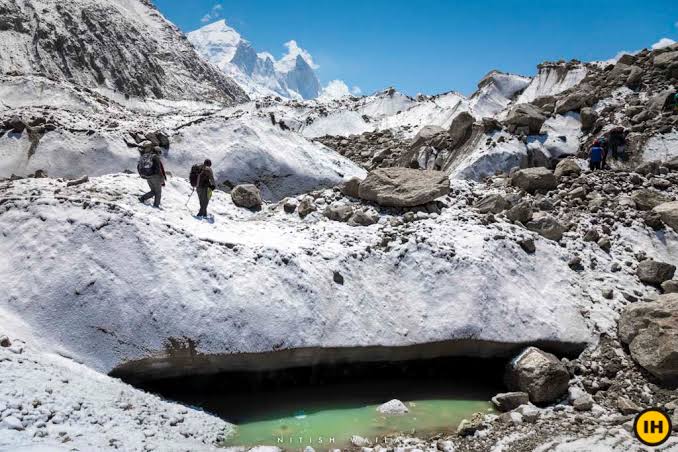
Gaumukh Trekking is one of the famous trekking destinations in India also a sacred place nearby Gangotri Dham . Gaumukh is known as the origin of holy river Ganga. It is about 19 Km trekking distance from the Gangotri Dham. You can plan a trip to Gaumukh Trek i f you are adventure and nature lover and want to see a glacier and how the river parts from the snow glacier.
Gaumukh Trek is a 5-6 Days trek from Gangotri Dham and it is a moderate level trekking. The trek starts from Gangotri Dham. You can pay tribute at the temple of Maa Ganga and start journey to Gaumukh from there.
There is steps near Gangotri temple and you can start you trek to Gaumukh from there. Here in this article I will share the Gaumukh Trip details , Trekking route and where to stay while this trek as well how to reach Gangotri and other details with you.
You should know the details if you are planning your trekking trip to Gaumukh because it’s not an easy trek and you need to take permission while entering to Gangotri National Park zone.

Read here: – How to Get Gaumukh Trekking Permit Online or Offline.
Gaumukh Trekking Itinerary Details
Here’s an itinerary for your trip to Gaumukh and details of day wise to complete the trip.
Day 1:- Haridwar-Uttarakashi
One Day 1 you can take a cab from Haridwar or Rishikesh and leave for Uttarkashi town. It is town as well district in the Uttarakhand state with many attractions and places to visit. Haridwar to Uttarkashi is approx. 250 Km can be covered by roads transports which take around 7-8 Hours. You can make your first stop at Uttarkashi and visit the Kashi Viswanath temple here.
Day 2:- Uttarkashi-Gangotri Dham
After Breakfast at morning leave for Gangotri Dham in route you can visit the amazing hill station Harsil which offers various Snowcapped mountain views and garden of apple. You can stay there for a while and proceed to Gangotri Dham the temple of Goddess Ganga. Pray at Gangotri Dham and spend some time there. You can also stay for overnight there.
Day 3:- Gangotri-Chirbasa-Bhojbasa
Now your trekking to Gaumukh started from here. This is a 14 Km trek one side to Reach Bhojbasa. Show your permit at Gangotri National Park and start your journey towards the Gaumukh. You will trek with surrounding of green grass and forest. After 9 Km you will reach to Chirbasa, you can enjoy the beautiful nature here and also stay here for a night in camp if you are tired. Else you can start trek towards the Bhojbasa which is around 5 Km from here.
The Chirbasa is located at the height of 3580 Meters above from sea level and Bhojbasa is located at the elevation of 3800 meters.
Day 4:- Bhojbasa- Gaumukh Glacier
Gaumukh is located at the distance of 5 Km from Bhojbasa which takes around 2-3 Hours to reach. You can trek to Gaumukh from Bhojbasa and then amaze with great views of glacier here and you can do some good photography of nature here. Visit the origin of river Ganga and enjoy the nature here. After Visit Gaumukh return to Bhojbasa or you can start your trek towards to Tapovan from Gaumukh itself.
Day 5:- Tapovan-Nandanvan
You need to cross Bhagirathi River to reach Tapovan and then crossing to Gaumukh Glacier to reach Nandanvan from Tapovan its around 7 Km trekking route to reach Nandanvan from Tapovan. You can camp here and stay for overnight.
Day 6:- Nandanvan-Gaumukh-Bhojbasa
Now it’s time to return back to the Bhojbasa after trekking to the hill of Himalayas. You can trek down around 12 Km to reach Bhojbasa. It’s a moderate level trekking so keep rest during your trip to get energy yourself. After reaching Bhojbasa camp here for overnight.
Day 7:- Bhojbasa –Gangotri
Trek back of 14 Km to Gangotri Dham. After reaching there you can stay in a Lodge or Hotel nearby the temple and also take Darshan at Temple again.
Day 8:- Gangotri-Rishikesh
On the last day of your trip you can reach back to Rishikesh and conclude your trip.
How to Get Gaumukh Trekking Permission directly from Gangotri
To getting permission of Gaumukh Trek you need to visit the DFO office at Uttarkashi or directly visit the Gangotri National park office near Gangotri Dham. You can show you documents here and get the permission to Gaumukh trekking from there.
You need to get permission one day before to start trek to Gaumukh because same day permission is not allowed. So make your plan accordingly.
Best Time to Visit Gaumukh
First of all avoid the monsoon season because of slippery route and heavy rain falls in the Hills of Uttarakhand. You can do the Gaumukh Trekking during May to June and Sept to Oct. The Trek start after the Gangotri Temple opens to devotees and tourist. During winter the trek is closed due to heavy snow falls.
Where to Stay near Gaumukh?
Stay is not allowed in the Gaumukh because of the freezing temperature and environmental reason. You can stay at the Bhojbasa and there is a GMVN (Garhwal Mondal Vikash Nigam) accommodation is available. So you can stay there but you need to do advance booking because of high rush during the trekking season.
Where to eat in Gaumukh Trip?
Well, there are no restaurants or Dhabas near Gaumukh, so you need to bring you own food while visiting the Gaumukh. In Bhojbasa you will get food at the GMVN Lodge. So we suggest you to keep some dry fruits and quick food with you.
Some Tips for Gaumukh Trip
- Keep Warm clothes with you because you will be in the very cold zone. As well you can take sleeping bags and camping items with you.
- Solo travelling is not advisable, so make a group for this trekking.
- If you want to know about places and peaks nearby the Gaumukh you should take experience guide with you
- Keep Dry fruits and quick made meals with you.
- Keep packaged water with you
- Avoid trekking during rainy season because of land sliding and cloud burst in the hills
So these are the details of Gaumukh Trekking trip and Tapovan Trek from Gaumukh . Feel free to comment here about your queries regarding this trip.
You can book a trip from Gokeys and get the best deal.
You may also like...
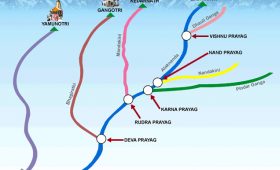
Panch Prayag Uttarakhand| Panch Prayag Tour & Route Map
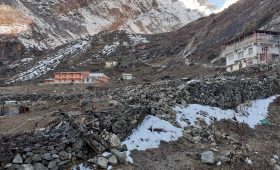
Mana Village: The First Indian Village on the Border
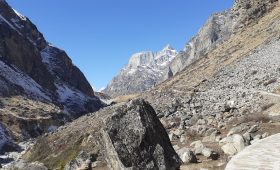
Vasudhara Falls – Travel Guide
(1) comment.
[…] Gangotri Temple which is one of the four sacred sites of the Char Dham Yatra. It is also known for Gaumukh from where Holy river Ganga […]
Leave a Reply Cancel reply
Your email address will not be published. Required fields are marked *
Save my name, email, and website in this browser for the next time I comment.

- Cultural Trips
- Wildlife Expeditions
- Destinations
- Outdoor Programs
- Discover trekking
- Health and fitness
- Experiential learning
- Trekking tips
- Outdoor skills
- Trekking gear
Best Time to Visit Gaumukh Tapovan Trek
The best time to visit Gaumukh Tapovan is from May to June and September to November.
Gaumukh Tapovan, the holy trekking trail famous for spirituality and adventure, is a classic Himalayan trek best accessed during the summer and autumn. May to June in summer and September to October in autumn are the best times to visit the Gaumukh Tapovan trek in Uttarakhand. The trekking conditions are favourable and the Gaumukh Tapovan offers dynamic landscapes during these months.
Avoid Gaumukh Tapovan trek during the harsh winter months and monsoon season in July and August.
Here is a detailed season-wise guide to the Gaumukh Tapovan Trek. Know more about the best time to visit Gaumukh Tapovan and plan your trip according to your interests and preferences.
Gaumukh Tapovan in Summer (Mid-May to June)
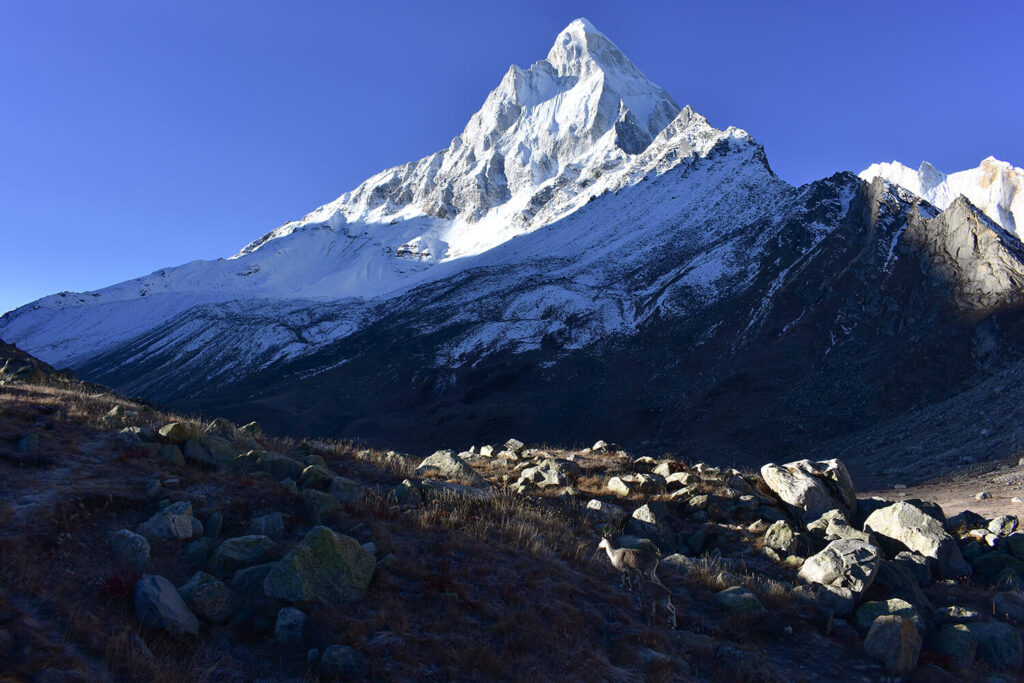
Summer is the busiest time for both devotees undertaking the Chardham Yatra to Gaumukh and for trekkers traversing this route. May to June, the summer months are the best time to do the picturesque and thrilling Gaumukh Tapovan Trek in Uttarakhand.
Gaumukh Tapovan in May
Pick early summer, from May to mid-May, to see snow on the trails. You will find residual winter snow in May. By late May, the snow on the trail recedes, welcoming summer colours. This melting snow and pre-monsoon rains add to the volume of the Bhagirathi River and flow fiercely. Scattered vegetation starts turning green. Thus, Gaumukh presents a mix of both snow and greenery if you trek to Gaumukh in May.
Gaumukh Tapovan in June
The trail up to Gaumukh is bustling with pilgrims in June. June is the best time to visit Gaumukh Tapovan for lush green meadows and clear views of the big mountains. The unpredictable nature of the mountains could cause some bouts of precipitation in June. Come prepared with rain gear in the summer months.
Gaumukh Tapovan in Monsoon (July & August)
In July, the rains start pouring continuously. There is a high risk of landslides and rockfalls, making the trail very dangerous to cross.
However, the rains do not deter the devout who continue their pilgrimage throughout July and August till Gaumukh. The trail after Gaumukh to Tapovan is riskier during the monsoon months of July and August.
Gaumukh Tapovan in Autumn (mid-September to mid-October)
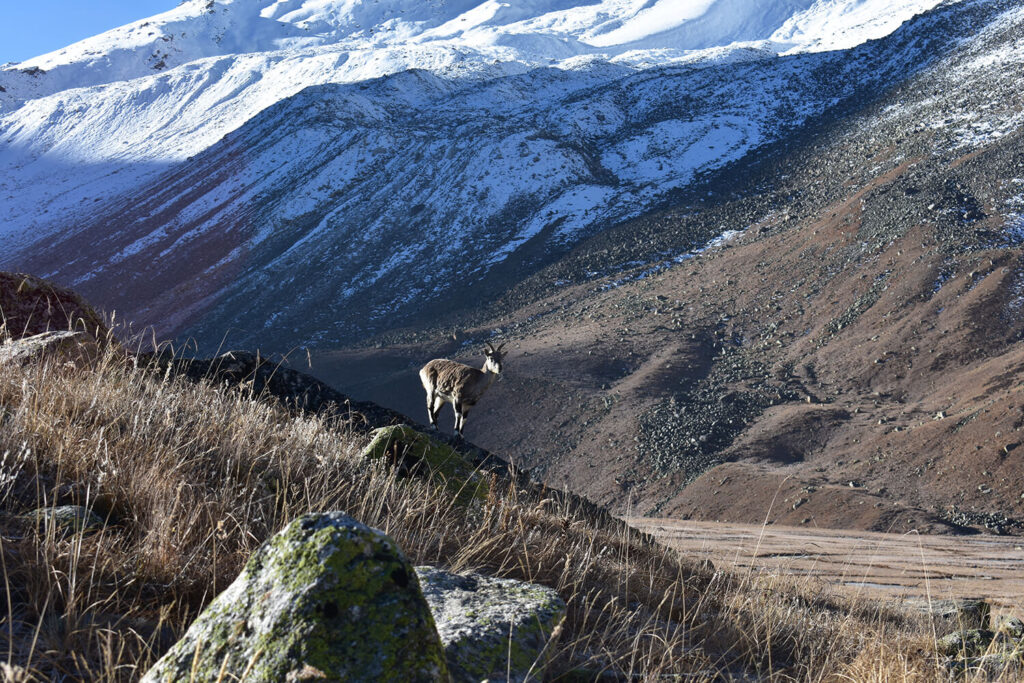
Although autumn’s trekking window is much shorter than summer – being only 4-5 weeks long – this is the best time of the year to do the Gaumukh Tapovan trek. The colours that come with autumn transform the previously green-only scenery into flamboyant brown, yellow, orange and maroon.
Gaumukh Tapovan in September
The towering mountains appear crisp and sharp if you trek to Gaumukh in September. September is also the best month to capture the mighty Himalayan peaks.
With winter right around the corner, the glaciers freeze, reducing the amount and flow of water. Due to this phenomenon, the Bhagirathi changes colour into a deeper blue, and its flow is gentle, unlike the roaring currents of the summer.
Gaumukh Tapovan in October
The scenery changes completely in October. Autumn colours deepen by October. Pre-winter snowfall can be expected in October at higher campsites. After November, the snowfall intensifies, and trekking conditions become dangerous again until next summer.
Pick the autumn months of September to October to enjoy an empty trail. Very few pilgrims visit Gaumukh in October.
Gaumukh Tapovan in Winter (December to February)
There is heavy snowfall in Gaumukh in winter. Under no conditions can a trek take place during this time. Gangotri becomes a ghost town and opens only at the end of March. As the snow gradually melts, the trails become visible and accessible for the next trekking season.
Gaumukh Tapovan in December
Higher campsites of Gaumukh Tapovan receive snowfall by December. Although the lower reaches remain accessible, it becomes challenging to navigate the trail.
Gaumukh Tapovan in January
Gaumukh Tapovan remains shrouded in white after heavy snowfall in January. It snows regularly in January. It can be challenging to hike on the snow-covered Gaumukh trek route, especially since Gangotri, the starting point, receives snowfall as early as January.
Gaumukh Tapovan in February
By February, the lower regions receive fresh spells of snowfall, enveloping the entire landscape in shades of white. An extensive amount of snow on the trail restricts trekkers from trekking to Gaumukh.
Gaumukh Tapovan Highlights
Gaumukh Tapovan Trek takes you closer to the gigantic glacier of Gaumukh, one of the largest glaciers in the Himalayas. The Gaumukh Glacier spreads around 30 km in length and is 4 km wide. The snout of Gaumukh is as gigantic as the glacier. To witness a glacier this big from a close distance is a rare experience.
Gaumukh Tapovan trek rewards you with the grandeur of Mt. Shivling. Along with Mt. Shivling, the trek offers clear views of Mt. Meru and the Bhagirathi sisters.
The trail takes you to Gaumukh glacier, where Bhagirathi originates and later becomes the holy river of Ganga. Tapovan is an occasional home to hermits seeking spiritual awakening.
Gangotri temple is another spiritual stop on this trek. The history of Gangotri dates back to the 18th century. The locals will share their exciting anecdotes from Mahabharata as you visit the Pandava Gufaa , a place where the Pandavas are believed to have rested.
The Gaumukh Tapovan trek is moderately difficult. Beginners can also attempt the trek with a fair amount of preparedness. The trek covers around 46 km and scales a maximum altitude of 15748 ft. in a week. You traverse the holy Gaumukh trail and witness the unforgettable amalgamation of history, spirituality, and mind-boggling landscapes.
Stunning backdrops, iconic sunrises and sunsets entice trekkers to embark on Gaumukh Tapovan trek. The trek starts and ends at the holy town of Gangotri.
Leave a Reply Cancel Reply
Save my name, email, and website in this browser for the next time I comment.
Related Tours
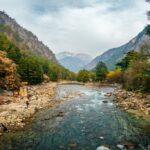
Kheerganga Trek

Dodital Darwa Top Trek
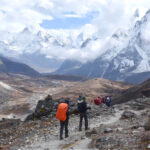
Everest Base Camp Trek – 10 Days
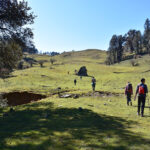
Dayara Bugyal – 4D/3N Trek
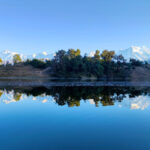
Deoriatal – Rohini Bugyal Trek
Screen Rant
Star trek: discovery movie & “crossover opportunities” discussed by sonequa martin-green.
Sonequa Martin-Green gives an update about the possible future of Star Trek: Discovery after the series ends with season 5.
- Sonequa Martin-Green hints at potential crossovers and movie opportunities for characters like Captain Michael Burnham.
- Season 5 of Star Trek: Discovery wasn't meant to be the end, and the cast found out it would be the final season after filming.
- While Discovery is concluding, fans may see familiar faces in Paramount+ movies or in the Starfleet Academy series.
Star Trek: Discovery series lead and producer Sonequa Martin-Green discusses the potential for crossovers and a movie after the show ends with season 5. Star Trek: Discovery season 5 wasn't produced to end the series, and the cast and crew found out after filming wrapped that season 5 would be the final season on Paramount+. But while Star Trek: Discovery i s coming to a close, there are possibilities for characters like Captain Michael Burnham to return in Paramount+'s streaming Star Trek m ovies or in S tar Trek: Starfleet Academy , which is set in Discovery 's 32nd-century timeframe.
In an interview with TrekMovie delving into Star Trek: Discovery season 5, episode 4 , "Face the Strange," Sonequa Martin-Green was asked what she knows about Paramount's developing plans for Star Trek movies. While Martin-Green doesn't have any specific info to share, she confirmed that Star Trek: Discovery movie opportunities and crossover opportunities with Star Trek: Starfleet Academy have been discussed. Read her quote below:
No, I wish I did. I wish I did! We talk about movie opportunities a lot. We talk about possible crossover opportunities. It’s tough because where we ended up was further beyond where any Trek is gone. I think we ended in 3191. So there’s very little we can do in terms of just not breaking too many rules because when we jumped to the future, that was our last shot. But I think that there are some crossover opportunities coming up with maybe Starfleet Academy . It would be a lot of fun to do a movie. I haven’t heard anything about it, but it could be a lot of fun.
Star Trek: Discovery Season 5 Returning Cast & New Character Guide
Can star trek: discovery get a movie or crossover after season 5, discovery season 5 likely won't be the last we see of burnham and her crew..
Star Trek: Discovery ' s most likely future is to have some familiar faces appear in Star Trek: Starfleet Academy. Confirmed to be set in Discovery 's 32nd century, Starfleet Academy was set up in Star Trek: Discovery season 4, and Lt. Sylvia Tilly (Mary Wiseman) is pulling double duty as an Academy instructor and serving on the USS Discovery in Discovery season 5. While T illy has not been confirmed to be part of Starfleet Academy 's cast , it would be logical to believe that Sylvia would be part of the show.
Captain Burnham, Ambassador Saru, Commander Rayner, and Ensign Adira Tal would also be logical candidates for Star Trek: Starfleet Academy guest appearances.
Any Paramount+ streaming movie continuation for Star Trek: Discovery would likely be dependent on how well Star Trek: Section 31 starring Academy Award-winner Michelle Yeoh performs on the streamer. Section 31 has a sequel possibility, and that could include a guest spot by Captain Burnham or other Star Trek: Discovery characters. A Star Trek: Discovery reunion movie might be too early to predict with season 5 still underway, but fan demand could reunite Burnham's USS Discovery crew in their own Star Trek streaming movie on Paramount+. To quote Burnham's adoptive brother, Spock (Leonard Nimoy), "There are always possibilities."
Source: TrekMovie.com
New episodes of Star Trek: Discovery season 5 stream Thursdays on Paramount+

IMAGES
VIDEO
COMMENTS
There are four major points on the route; Gangotri, Chirbasa, Bhojbasa, and Gaumukh. The route will look something like this. Gangotri - (9 kms) - Chirbasa - (5 kms) - Bhojbasa - (4 kms) - Gaumukh = 18 Kms. The difficulty level of the trek can be called moderate but it does get a bit challenging and steep at some points.
Gaumukh Trek is a 46 km trek hiked over 6 days (8 days including the drive to and from the trek,) in the Greater Himalayas. It lies in the state of Uttarakhand and begins and ends at the pilgrim town of Gangotri. The trail snakes through the Greater Himalayas within the confines of Gangotri National Park.
The permits for Gaumukh trek are valid for only two days. Hence one has to return to Gangotri on the second day. The return path from Gaumukh to Bhojbasa is again not that simple - it would take around 2 hrs to reach Bhojbasa. From Bhojbasa to Gangotri, one can comfortably make it in 3 ½ to 4 hours. Details of Guide & Porters for the Trek to ...
Let the trekking begin! While the trek wasn't a killer, it certainly wasn't that easy for the average person. The Gangotri to Gaumukh trek distance is approximately 21 km/ 13 miles. Though the path is well-marked, slippery rock-leaden footpaths and many a' incline definitely make a trekking pole useful to have.
Short Itinerary Gangotri Gaumukh Trek. Day 1- Pickup to you from Dehradun - Drive to Gangotri - 258 km) (0/10 Hours) (3415 Meter) Overnight stay Hotel. Mode of journey - By Tempo Traveller 13+D. Day 2 - Trek from Gangotri to Chirbasa camp (09 km) (5/6 Hours) (3580 Meter ) Overnight stay Camp. Mode of journey - On foot.
An eight-day itinerary interspersing myth, spirituality, and sensational adventure, the Gaumukh Tapovan Trek takes you around the Gangotri glacier to the site traditionally believed to be the mouth of the holy river Ganga. The Gangotri glacier expanse is nearly 24 km long and 6 to 8 km wide, beginning from Gaumukh and extending as far as the ...
The trek route of Gaumukh is of moderate difficulty, it is advised to prepare for the trek by running, cycling and swimming which help improve cardiovascular stamina. Having an experienced trekking guide with you on your trek is a wise decision as he/she would know the route well and will help you keep on track.
The Gaumukh Tapovan trek is a Moderate level 5 Day Trek that takes you through the Gangotri National Park and lands you at the origin of the Ganga River, at Gaumukh. The trek includes long steep climbs, boulder crossing and at points just hiking on steep ascents.
The Gaumukh Trek is a challenging and rewarding trek that takes you deep into the heart of the Indian Himalayas. The trek starts from the town of Gangotri and takes you on a journey through beautiful meadows, dense forests, rocky terrain, and high-altitude glaciers. ... Guide and permits: The Gaumukh Tapovan Trek is a protected area, and you ...
The Gaumukh Tapovan Trek is a hiking trail situated in the Garhwal Himalayas of Uttarakhand, India. It takes hikers through scenery, high altitude meadows and towering mountains providing a Himalayan experience. The main attractions of the trek include reaching Gaumukh, the tip of the Gangotri Glacier and Tapovan, a meadow surrounded by peaks.
A scintillating adventure - The Gaumukh Tapovan Trek. Gaumukh is the place, which is known as the terminus of the Gangotri glacier and it's a source of the primary streams of Gangotri river. This beautiful place is located in Uttarkashi, in the state of Uttarakhand and is a very well known trekking place. This is a very historic and religious and many stories revolve around the name of ...
Day 3: Bhojwasa (3,775M) to Tapovan (4,460M) via Gomukh (4,025M) - 14 km Trek. . Welcome to Day 3 of your Gaumukh Tapovan Trek! Today's trek will take you from Bhojbasa to Tapovan, a high-altitude meadow situated at an elevation of approximately 4,460 meters (14,632 feet).
Time Taken : 10-12 hours. Altitude : 10,001 ft. Distance : 250 km. Day 2 : Trek from Gangotri to Chirbasa. Day 3 : Trek from Chirbasa to Bhojbasa, Acclimatization Walk to Gaumukh. Day 4 : Trek from Bhojbasa to Tapovan via Gaumukh. Day 5 : Acclimatise and Explore Tapovan. Day 6 : Trek from Tapovan to Chirbasa.
Gaumukh is located at an altitude of 4,000 meters above sea level and is a popular trekking destination. The trek to Gaumukh is challenging and takes around 4-5 days to complete, depending on the route taken. Along the way, trekkers can enjoy breathtaking views of the Himalayan range and pass through dense forests, beautiful meadows, and quaint ...
Meet your trekking guide for a briefing on the upcoming adventure. Enjoy a wholesome dinner and rest for the trek ahead. Day 2: Gangotri to Bhojbasa (3785 M). via Chirbasa: After breakfast, embark on your trek from Gangotri to Bhojwasa, The trail follows the gushing Bhagirathi River, surrounded by snow-capped peaks and lush greenery.
Gaumukh-Tapovan trek is one of the most thrilling and gratifying trek in India. This trek is a complete blend of spiritual, adventure and natural spectrum. ... then you'd be forgiven for thinking our guides are superhuman. It doesn't mean a feat to entertain, cook, guide, and facilitate, but our guides, handle it with grace, and all the ...
Day 04: Tapovan - Nandanvan (Trek - 7 kms) Crossing the massive Gaumukh Glacier is required to reach Nandanvan from Tapovan. The trek starts with a steep descent from Tapovan to reach the glacier and ends with a steep climb of approximately 100mts to reach Nandanvan. Nandanvan (4450mts) is situated at the foot of Bhagirathi Peaks.
Get Price Quote on WhatsApp +91-7895990850. Gaumukh Tapovan trek is an enchanting, adventurous & divine trek to the source of the Ganga the holiest of the rivers. Starting from Gangotri, the trek takes you to Gaumukh where you will see Ganga coming out of the rocky mountains. Gaumukh trek further ventures to Tapovan and scenic paradise Nandanvan.
Trek to Gaumukh Travel Guide. Gomukh is located inside the Gangotri National Park and is accessible only by foot (trek). The starting point of the trek is from Gangotri, so one has to reach Gangotri first. The entire route from Gangotri to Gaumukh is filled with natural beauty. The Bhagirathi river will keep you company until the end.
Many pilgrimages and foreign travellers do the trek of Gaumukh (Glacier) from Gangotri during their Char Dham Yatra. Gaumukh - Yamunotri. Distance: - 222 kms. Time: - 8 hrs. Route :- Gaumukh - Gangotri -Chinyalisaur - Dharasu Band - Barkot - Jankichatti - Yamunotri. Gaumukh - Gangotri. Distance :- 20 kms. Time:- 4 hrs.
Drive Distance: 245 km. Drive Time: 9-10 hours. Altitude: 10,300 ft. The journey to Gaumukh Tapovan starts from Dehradun, where you can reach the spot via flight, bus, or train.From Dehradun, you will begin your journey to Gangotri, passing through the major landmarks such as Landour, Moriana Top, Uttarkashi, and Harsil.. In Uttarkashi, take time to purchase any necessary items.
Gaumukh is known as the origin of holy river Ganga. It is about 19 Km trekking distance from the Gangotri Dham. You can plan a trip to Gaumukh Trek i f you are adventure and nature lover and want to see a glacier and how the river parts from the snow glacier. Gaumukh Trek is a 5-6 Days trek from Gangotri Dham and it is a moderate level trekking.
The Gaumukh Tapovan trek is moderately difficult. Beginners can also attempt the trek with a fair amount of preparedness. The trek covers around 46 km and scales a maximum altitude of 15748 ft. in a week. You traverse the holy Gaumukh trail and witness the unforgettable amalgamation of history, spirituality, and mind-boggling landscapes.
36 likes, 3 comments - trekgoindia.in on April 22, 2024: "Bookings Open for Our Summer Treks 1 Har Ki Dun Trek 2 Buran Ghati Trek 3 Ali Bedni Trek 4 Rupin Pass Trek 5 Bali Pass Trek 6 Gaumukh Ta...". TrekgoIndia | Bookings Open for Our Summer Treks 1 Har Ki Dun Trek 2 Buran Ghati Trek 3 Ali Bedni Trek 4 Rupin Pass Trek 5 Bali Pass Trek 6 ...
Star Trek: Discovery series lead and producer Sonequa Martin-Green discusses the potential for crossovers and a movie after the show ends with season 5.Star Trek: Discovery season 5 wasn't produced to end the series, and the cast and crew found out after filming wrapped that season 5 would be the final season on Paramount+.But while Star Trek: Discovery is coming to a close, there are ...